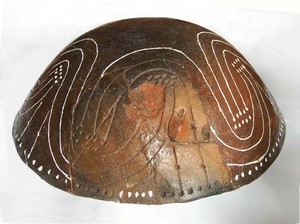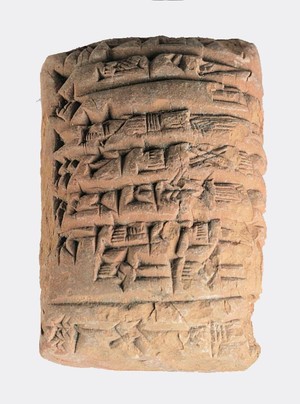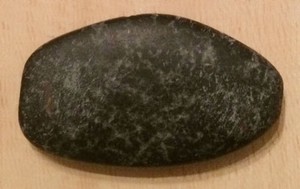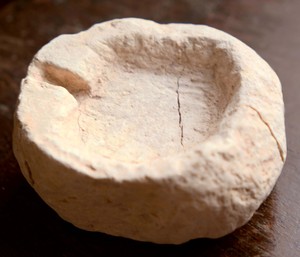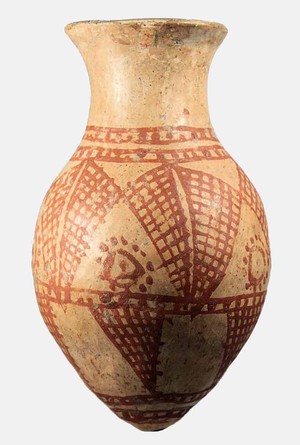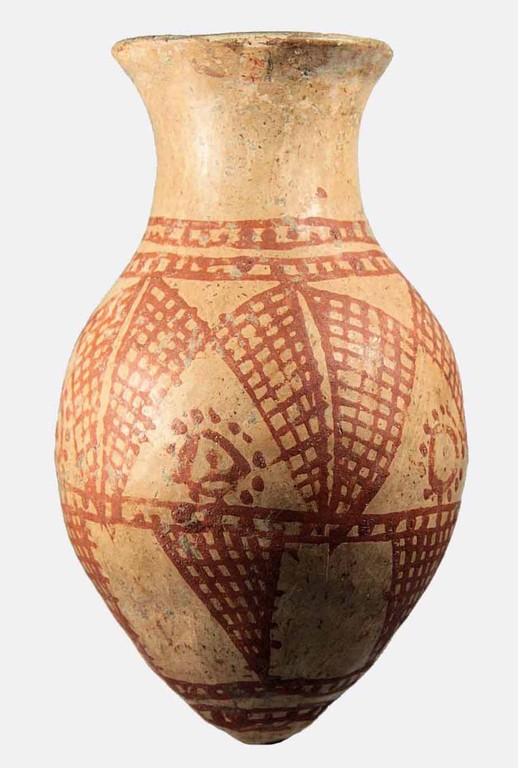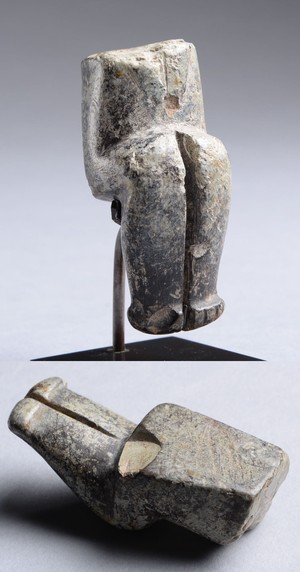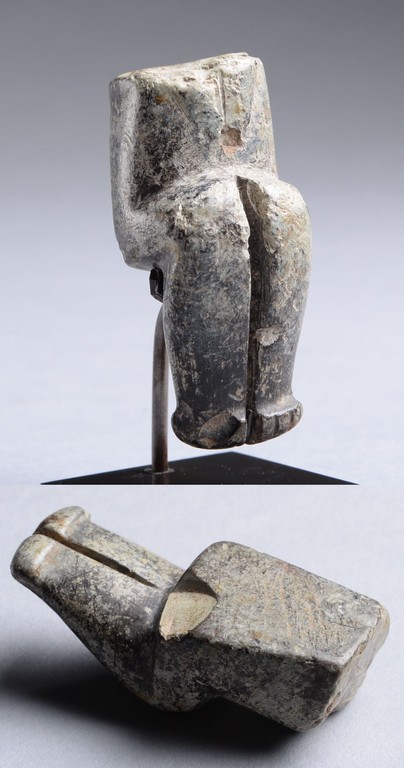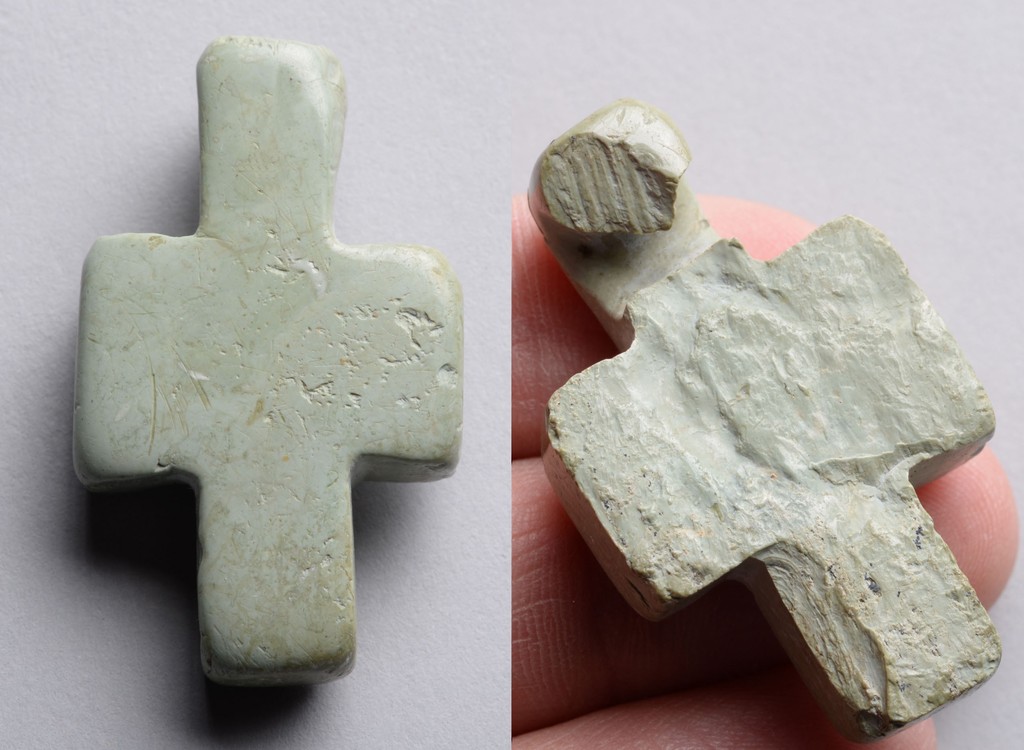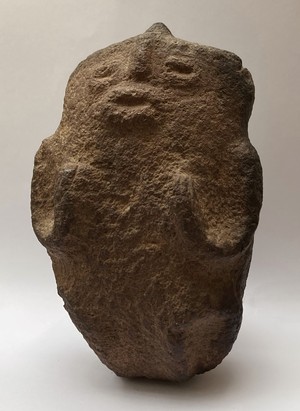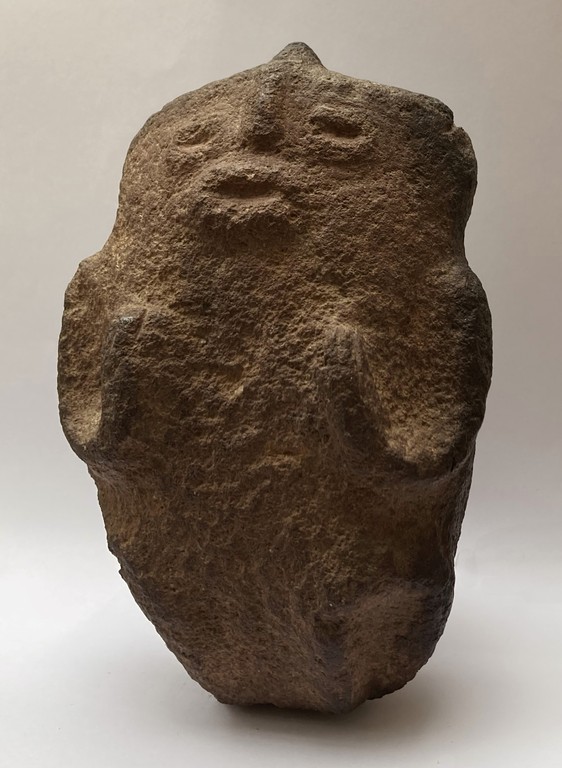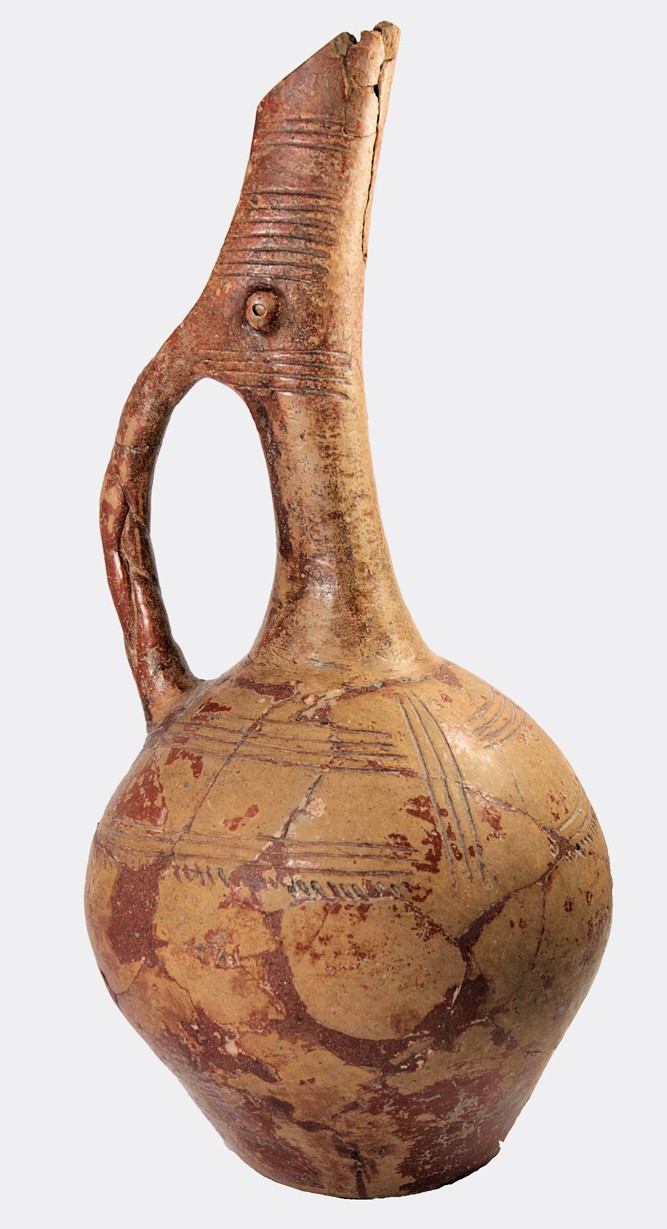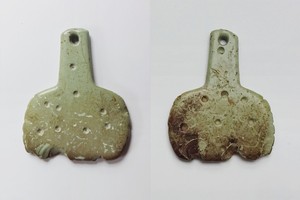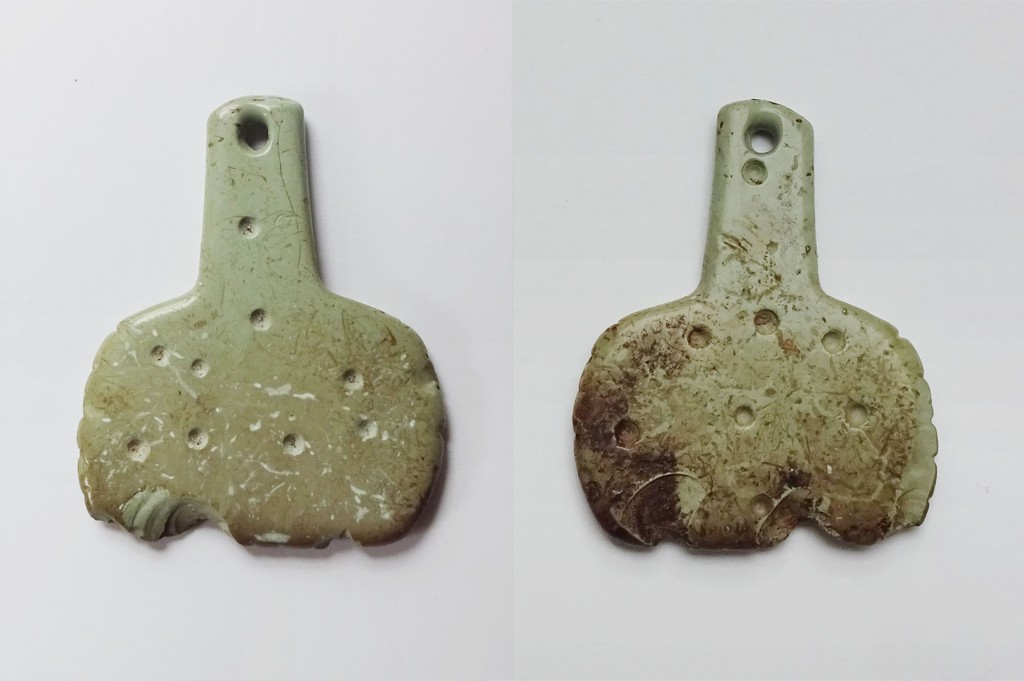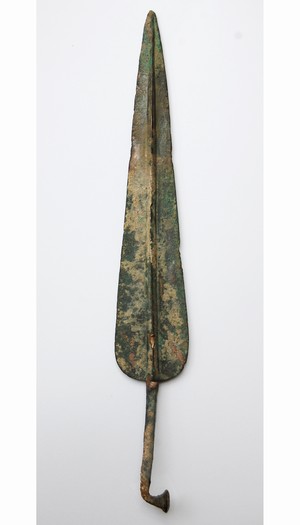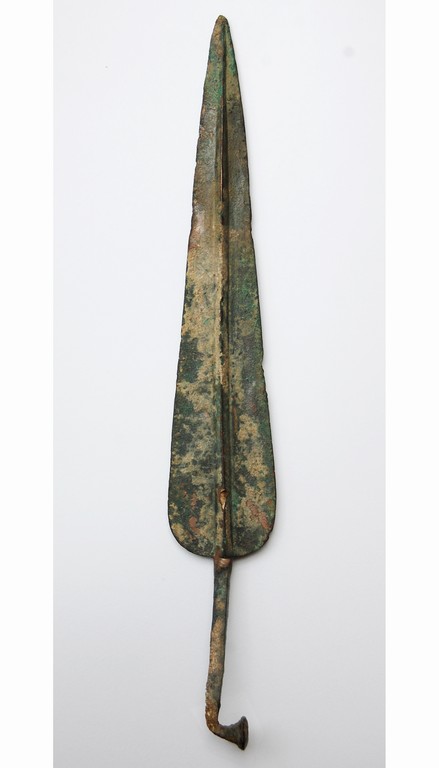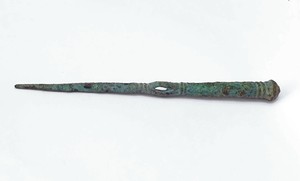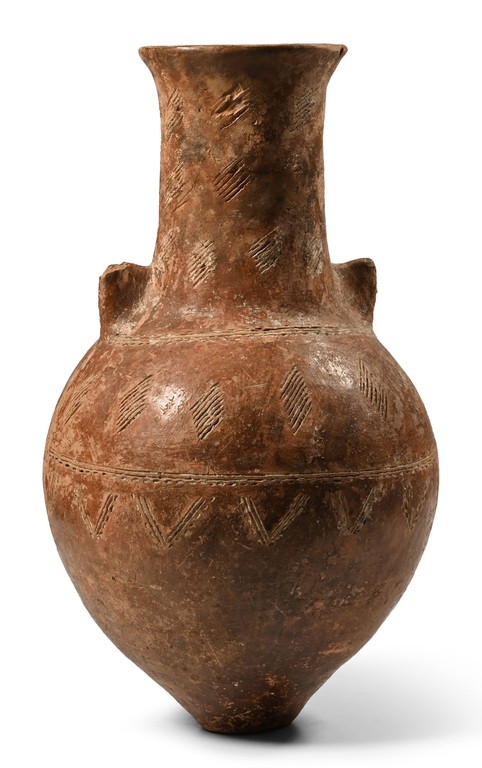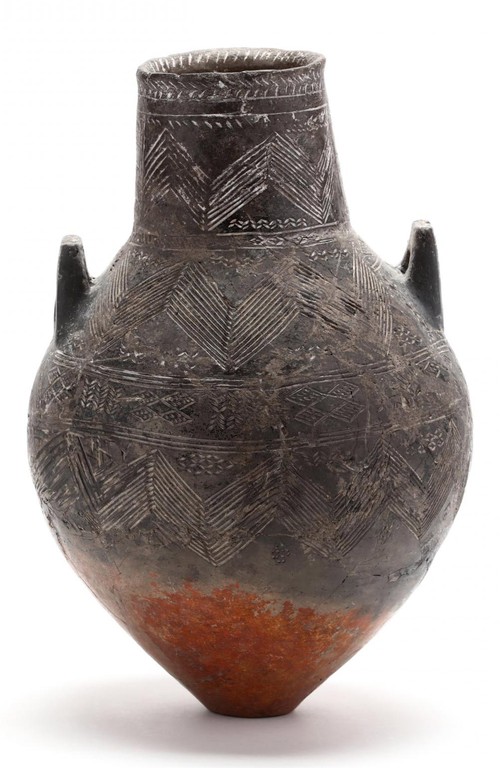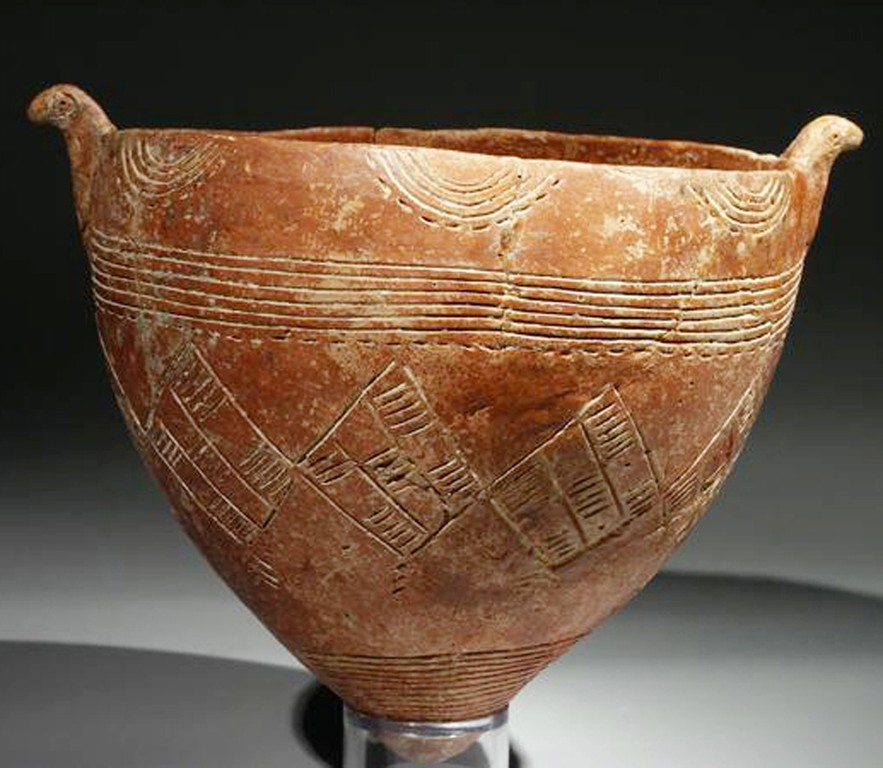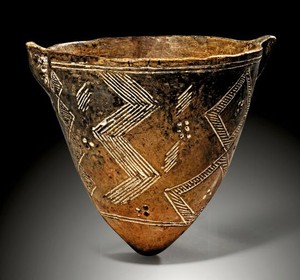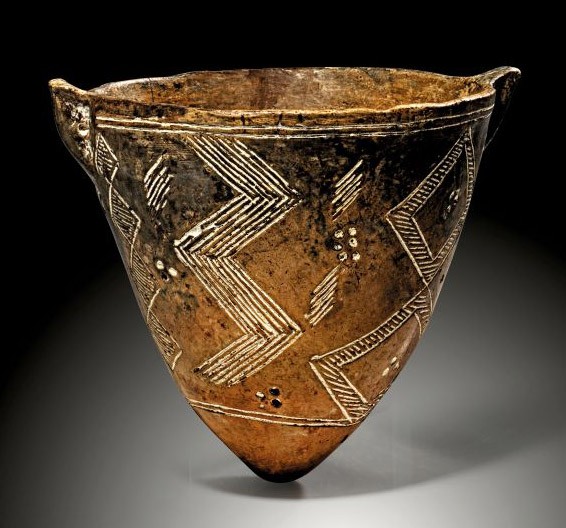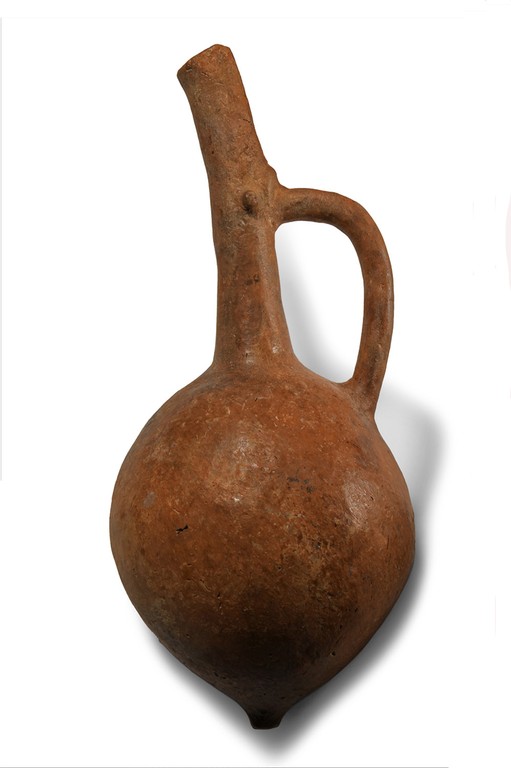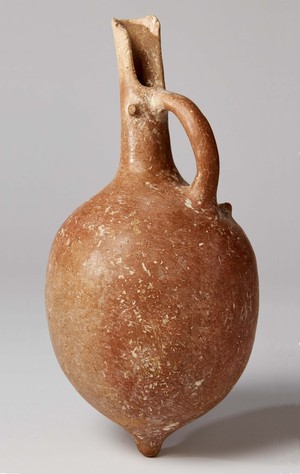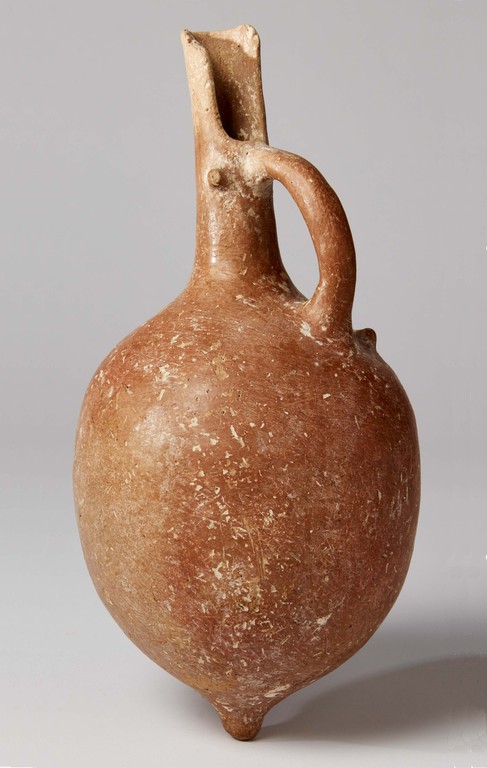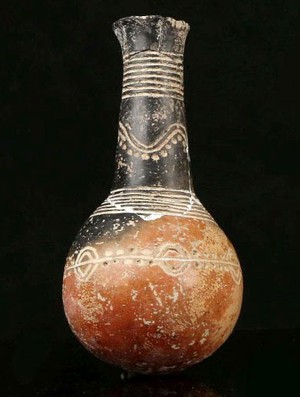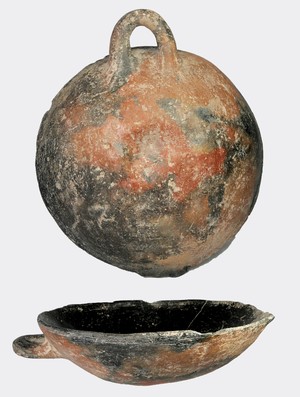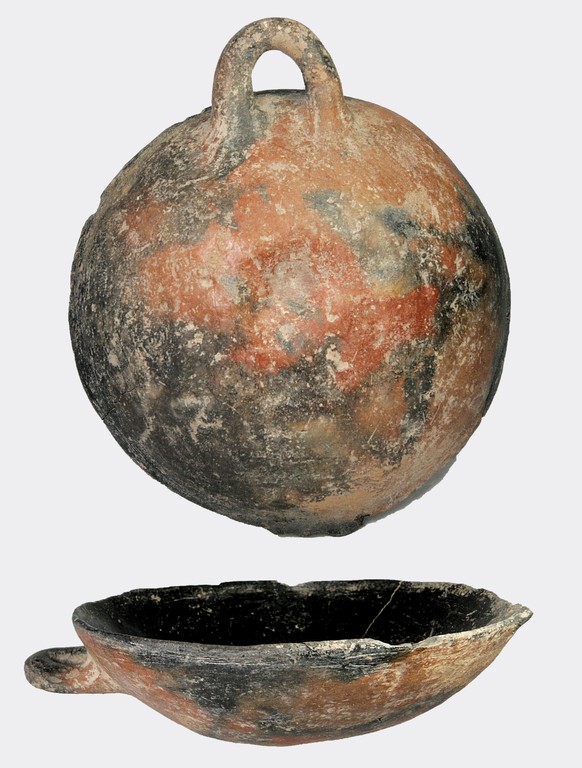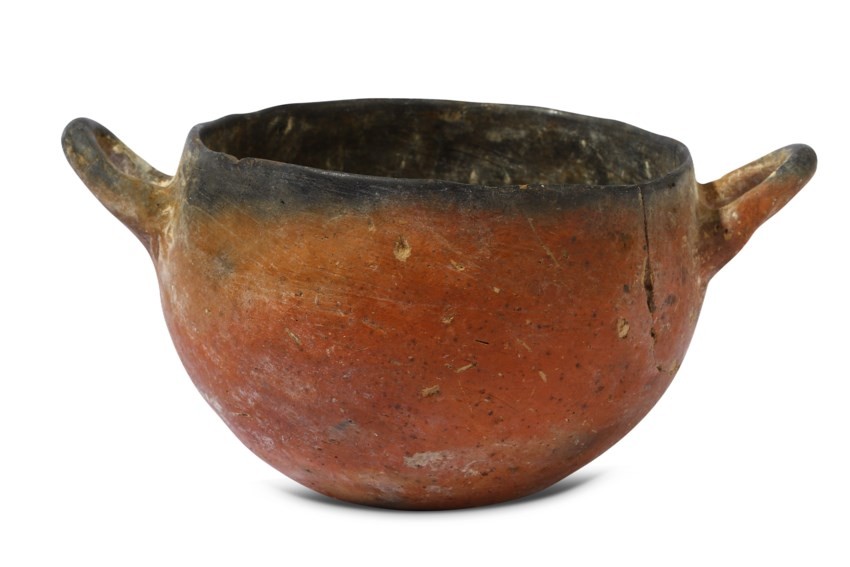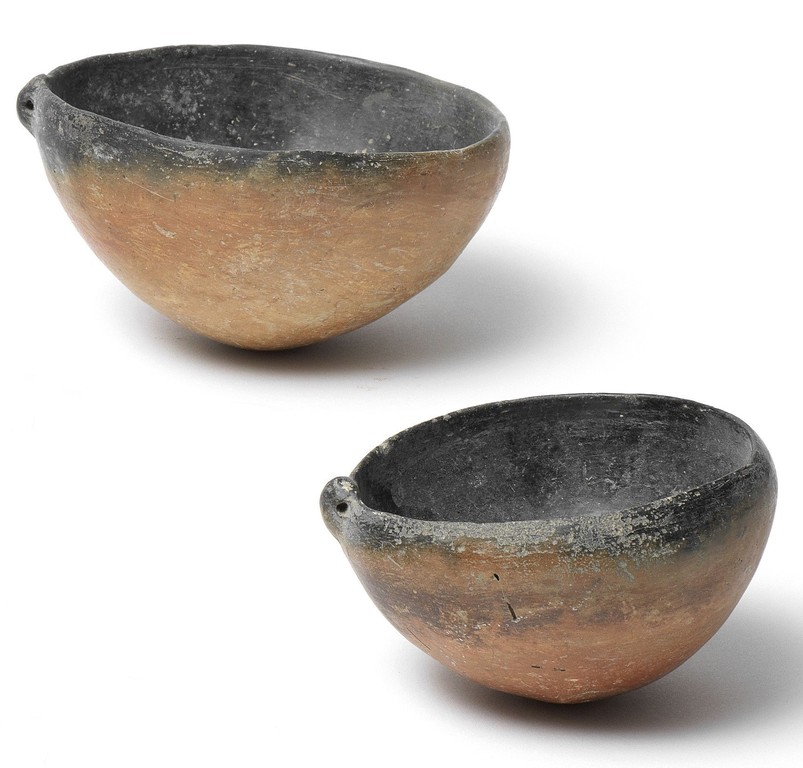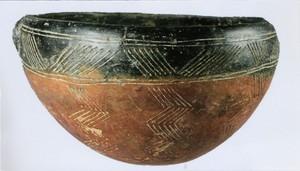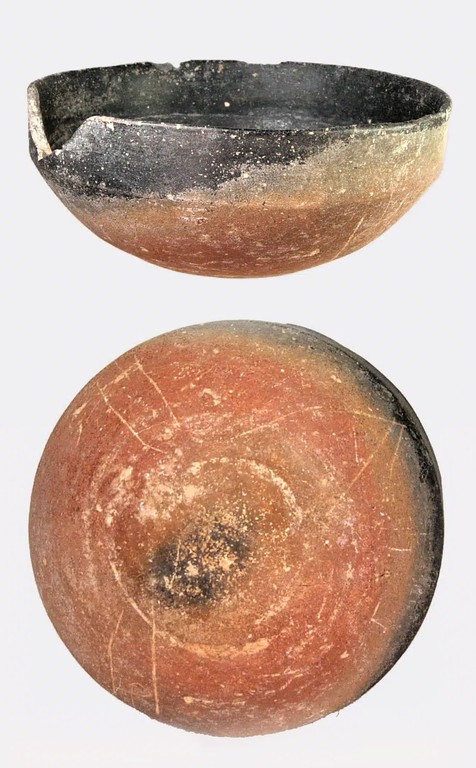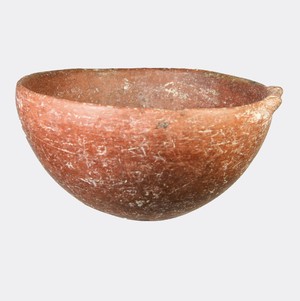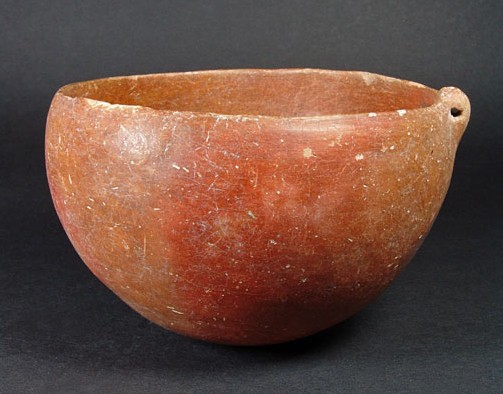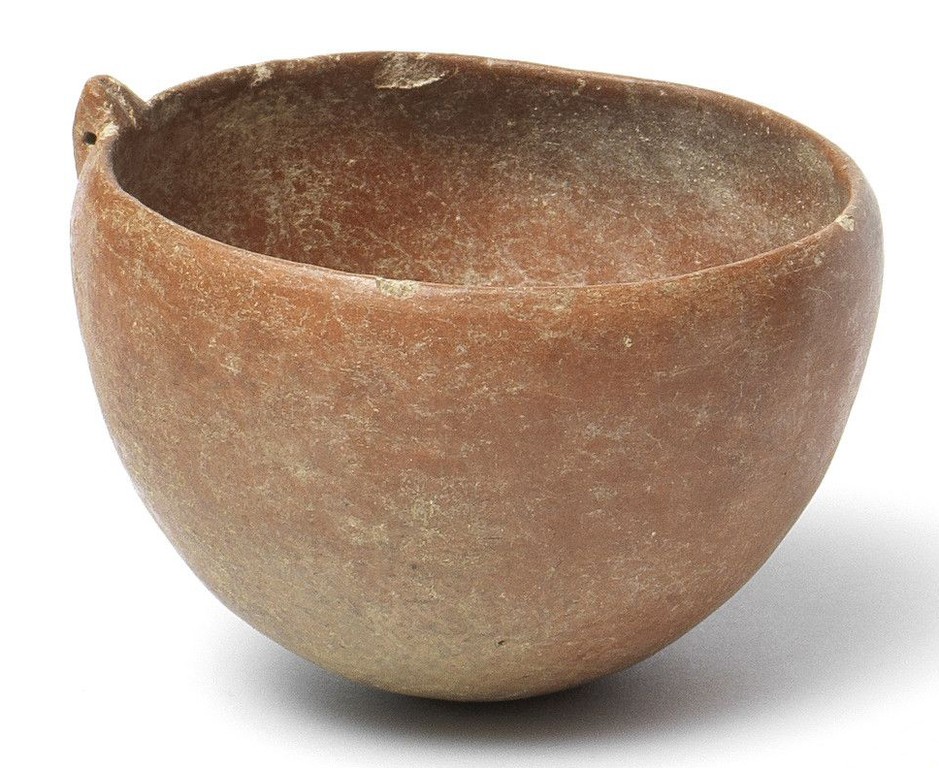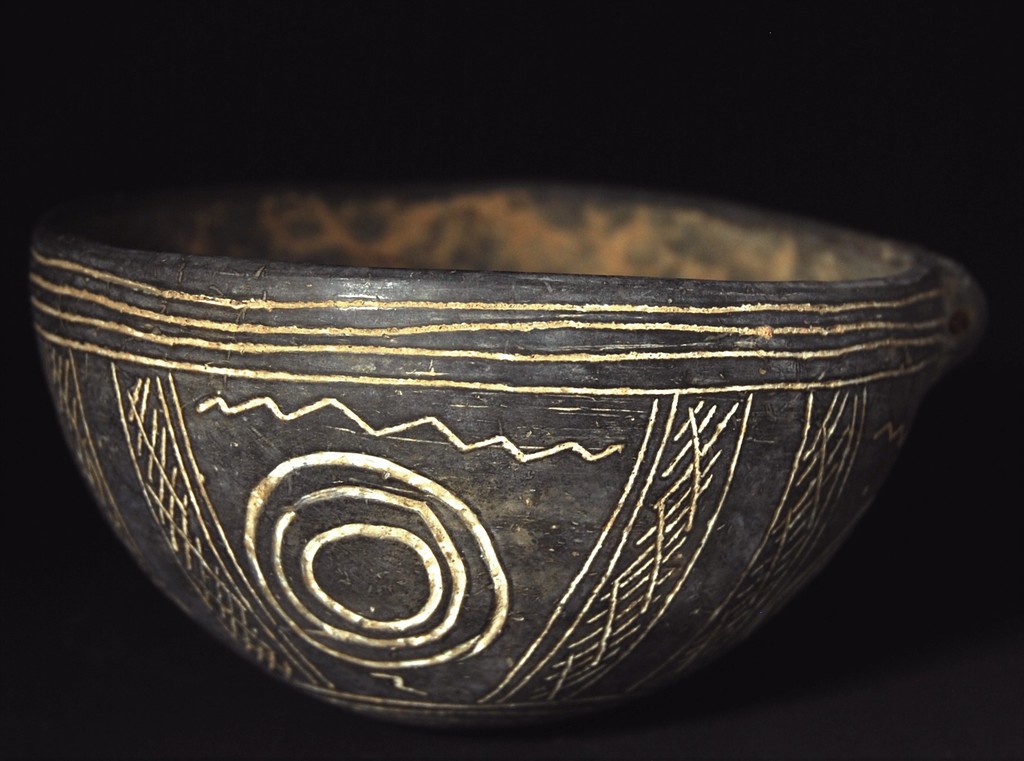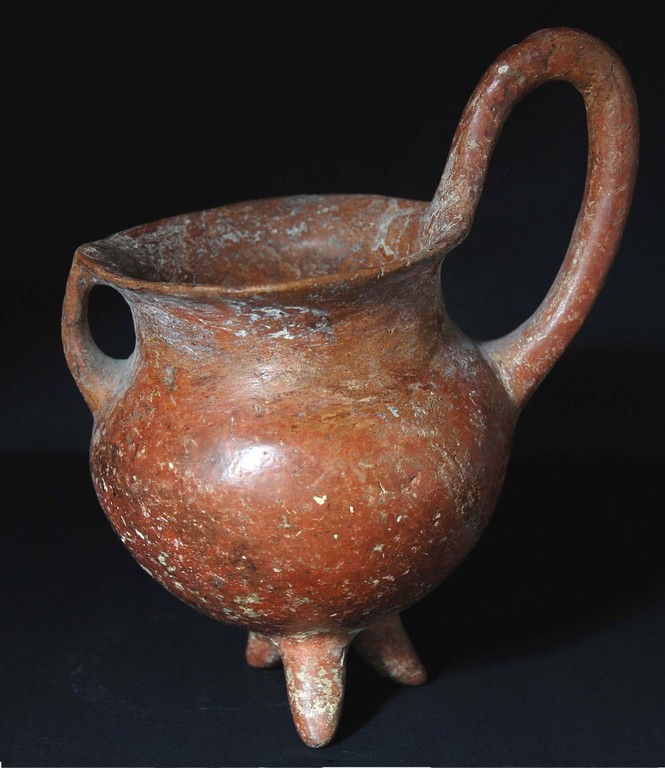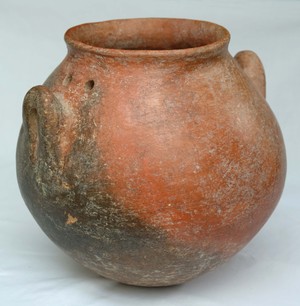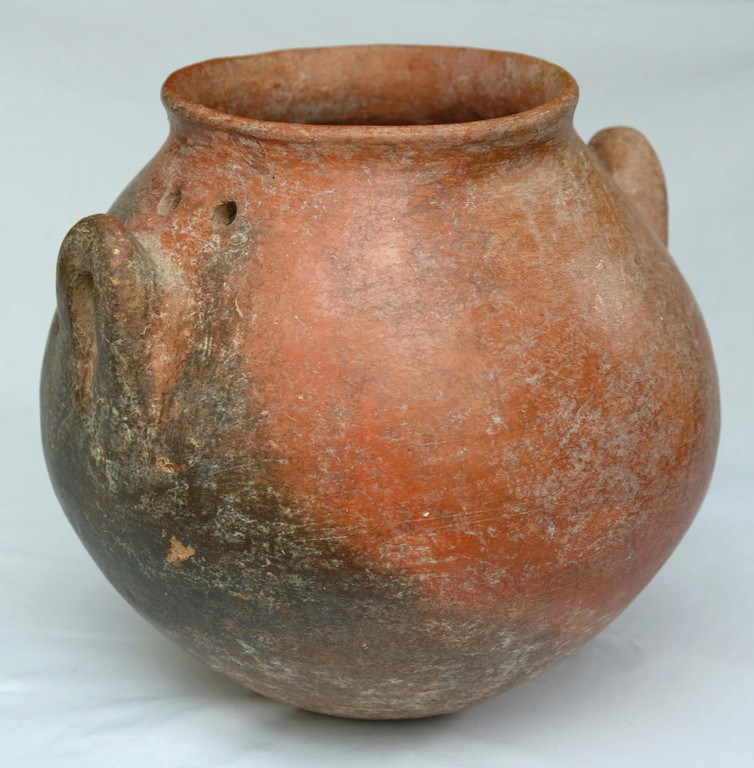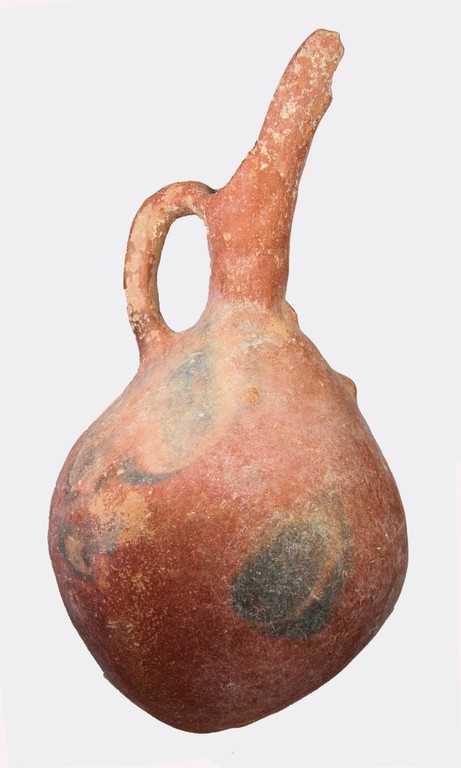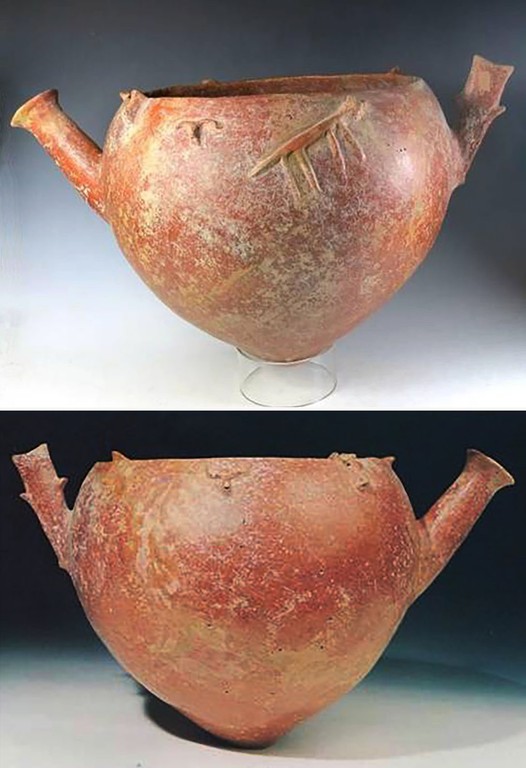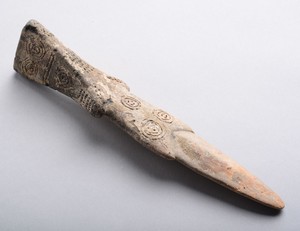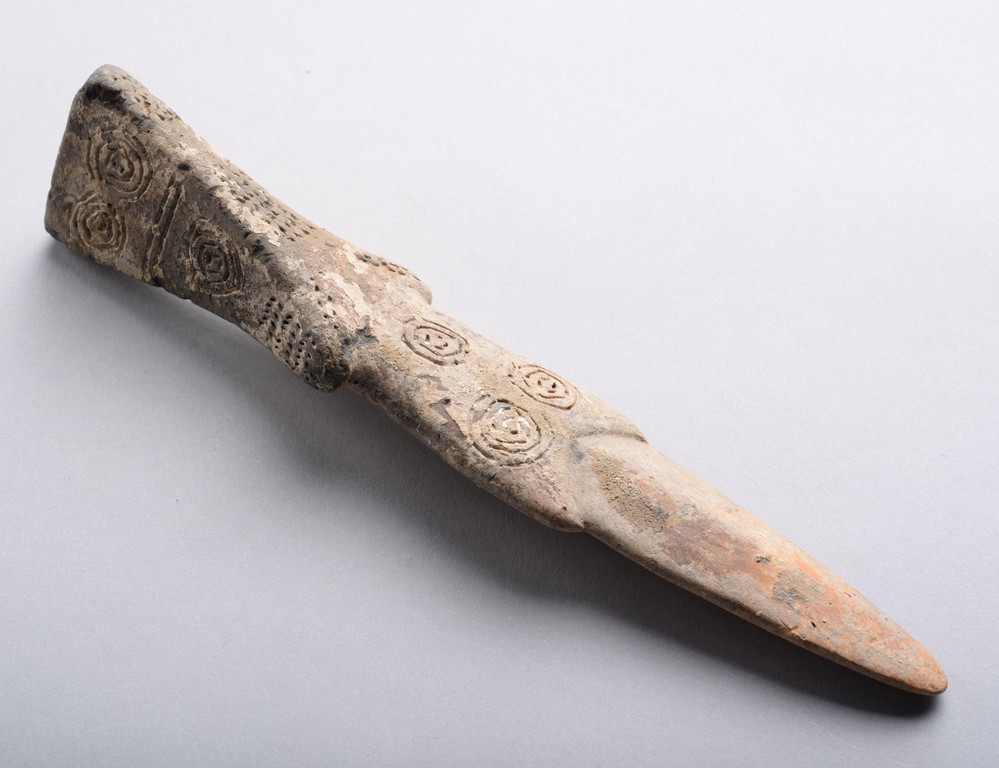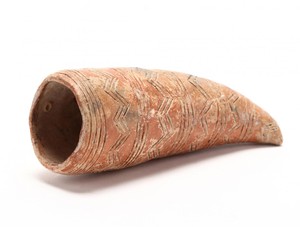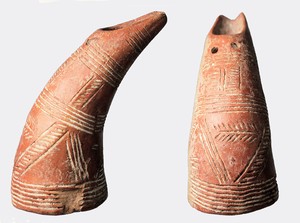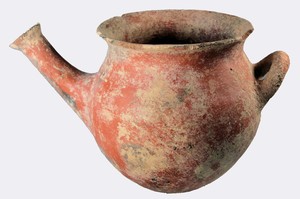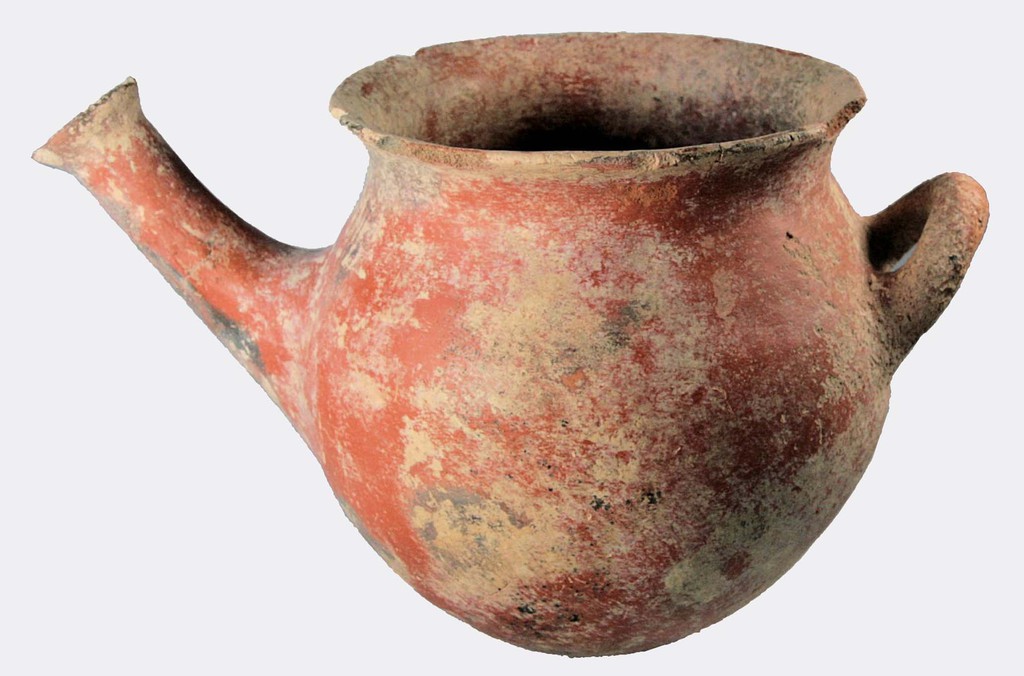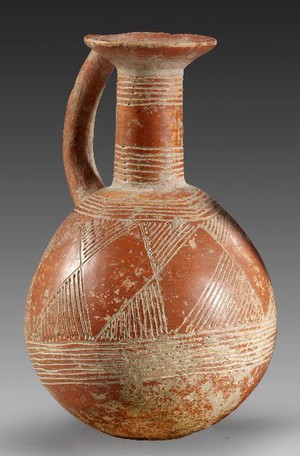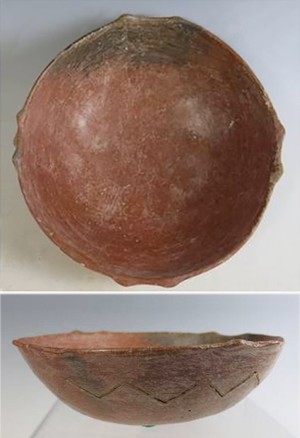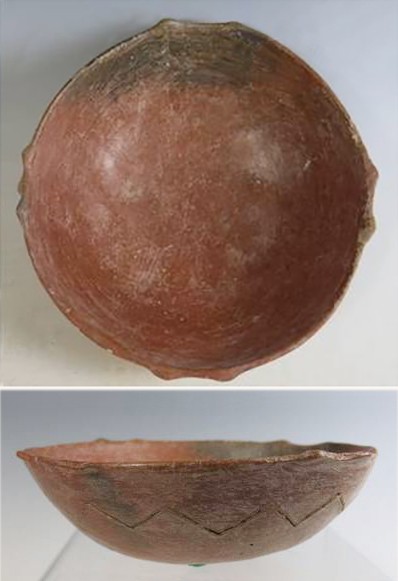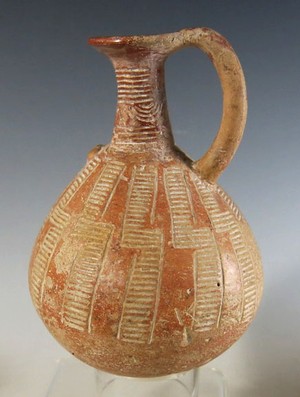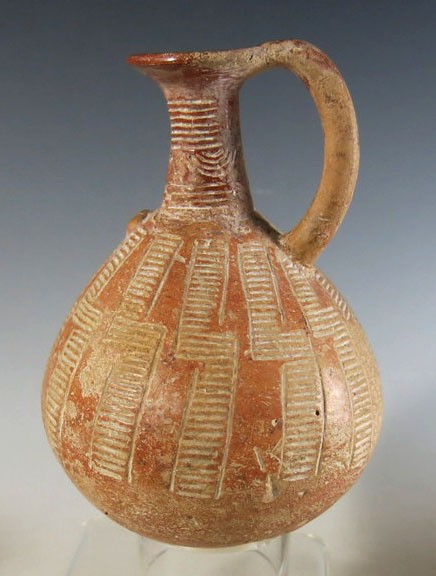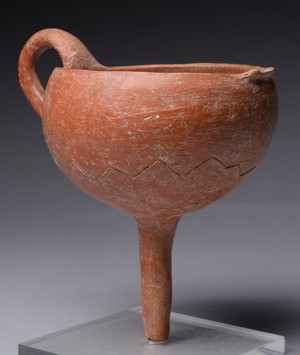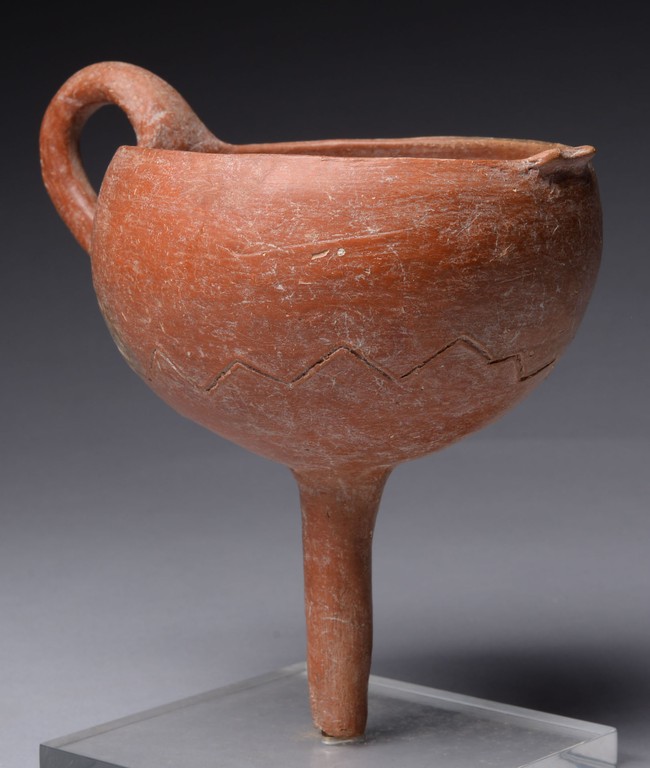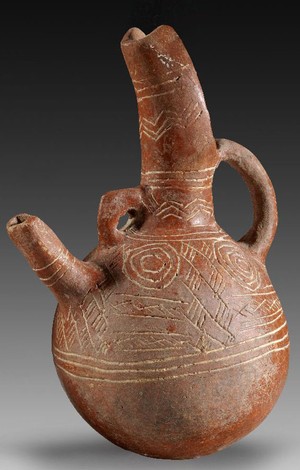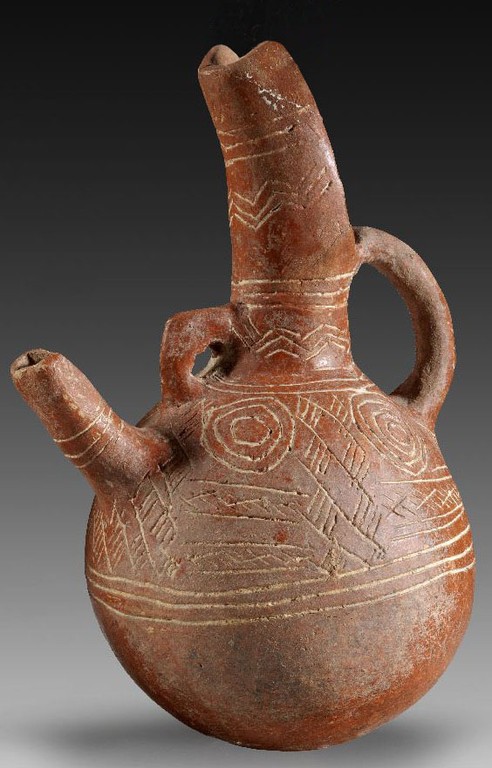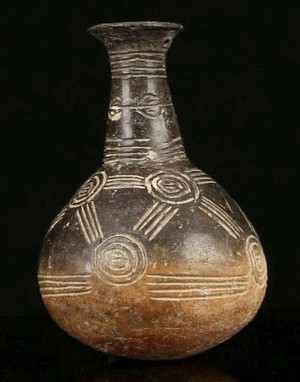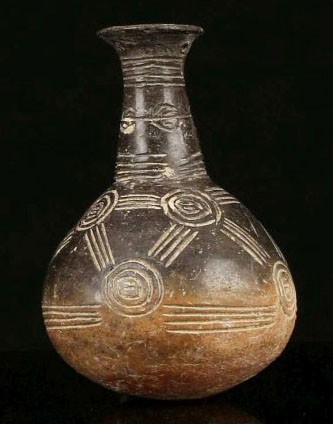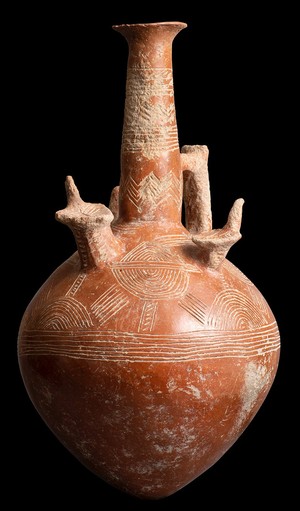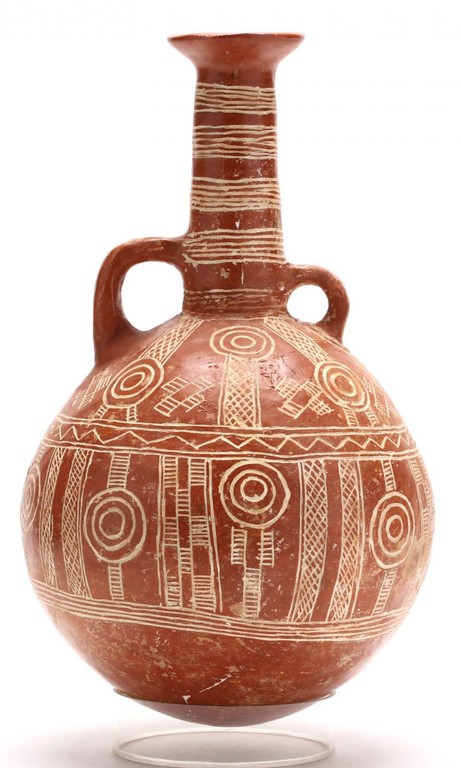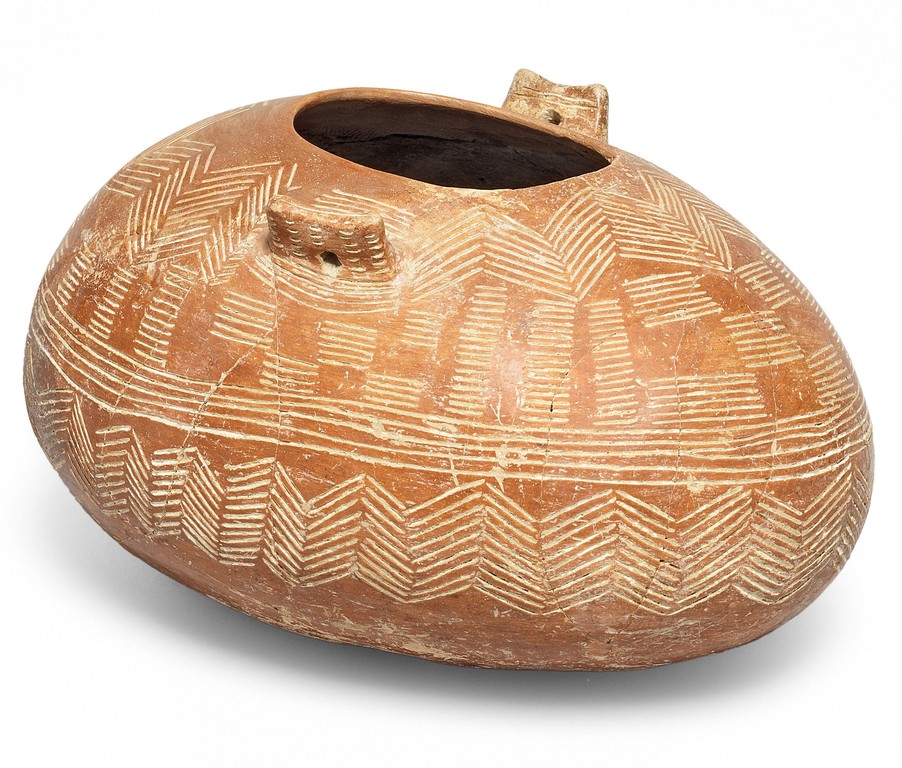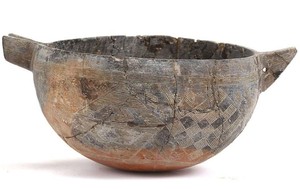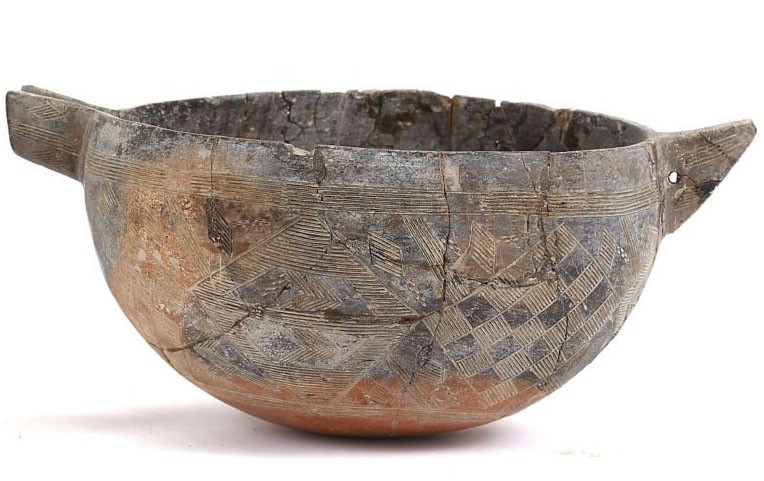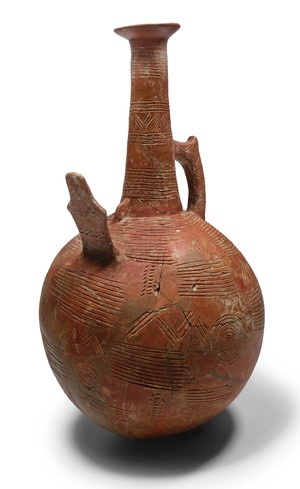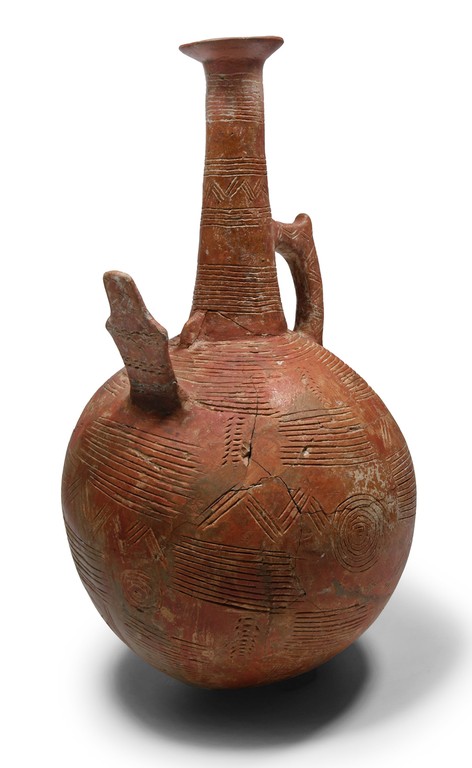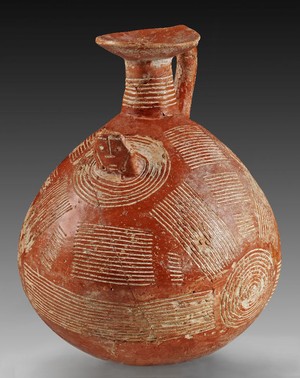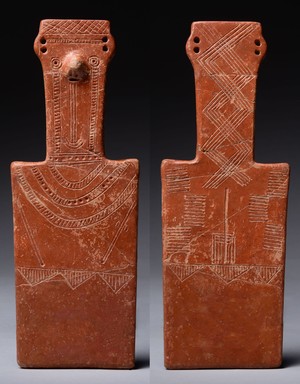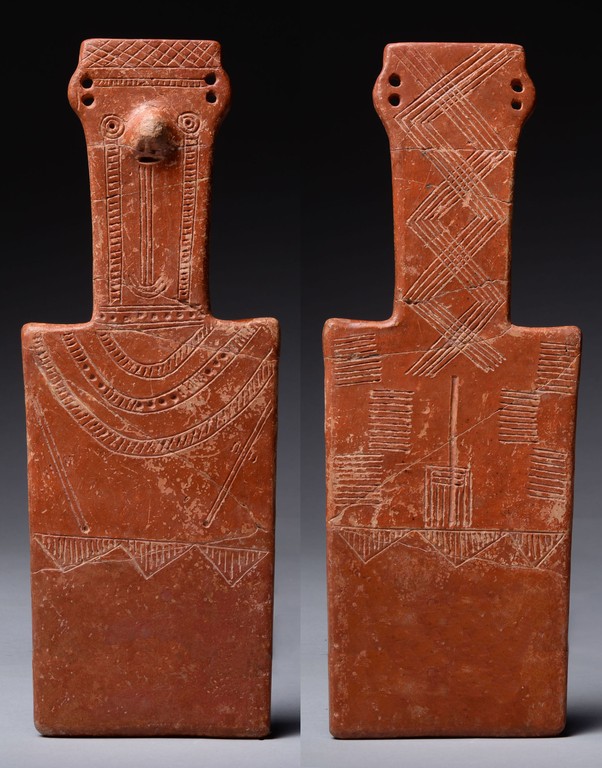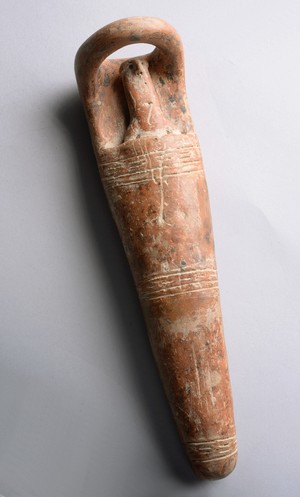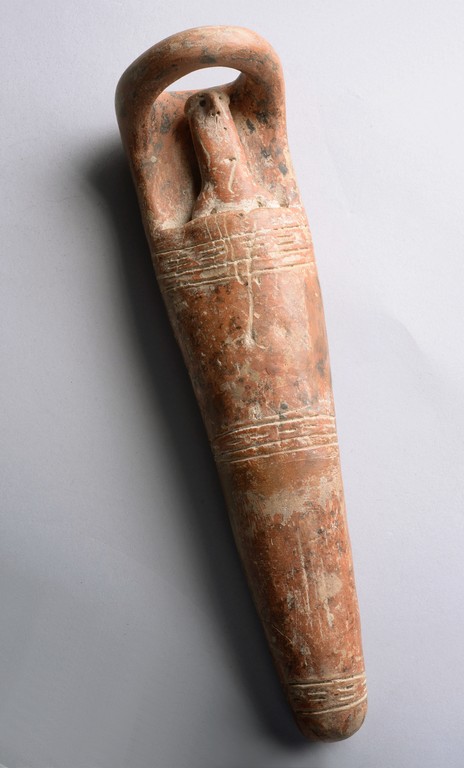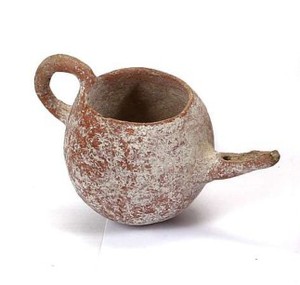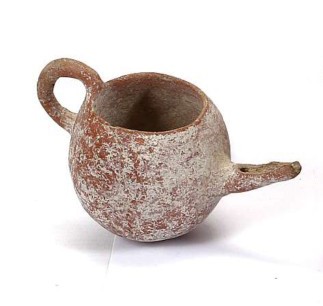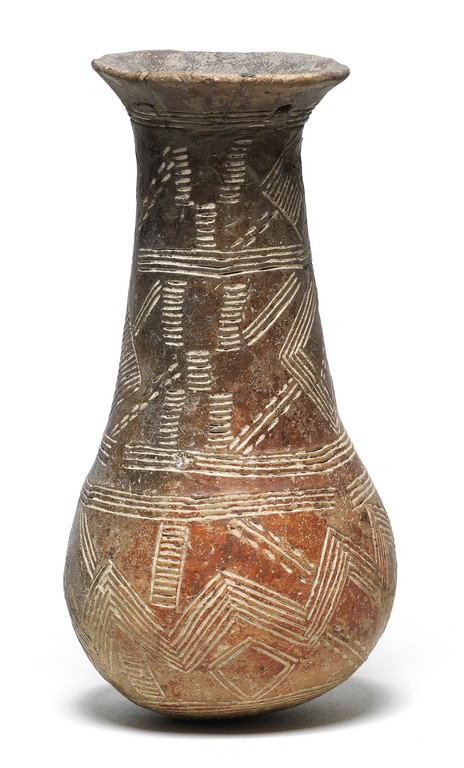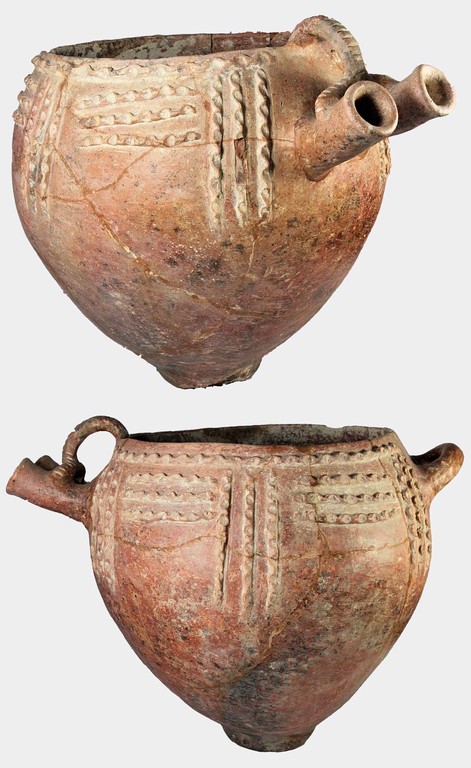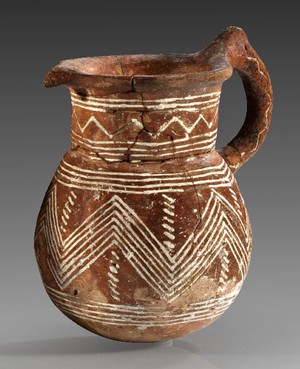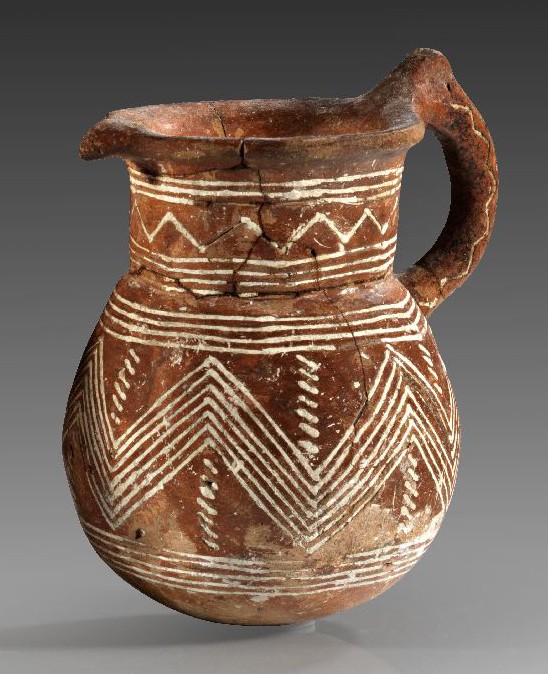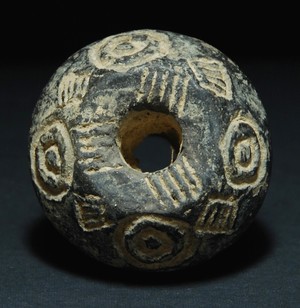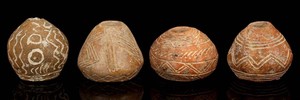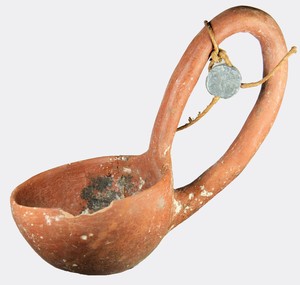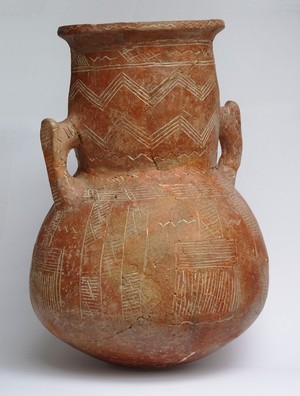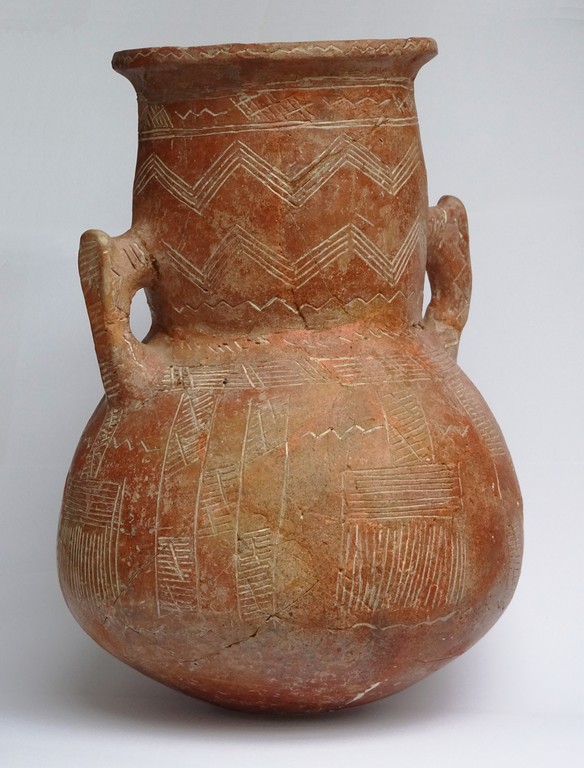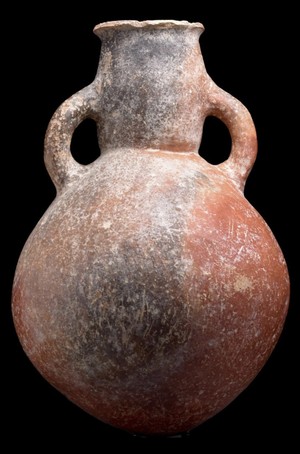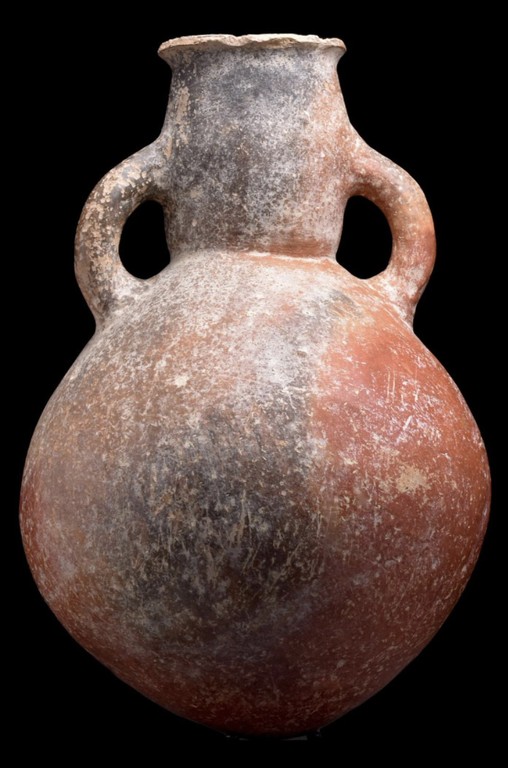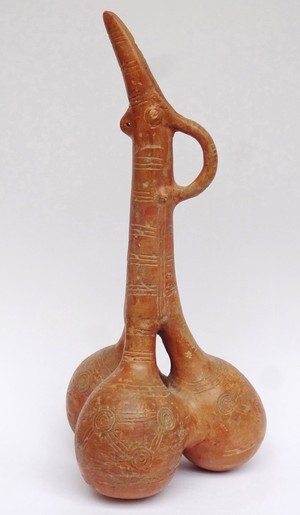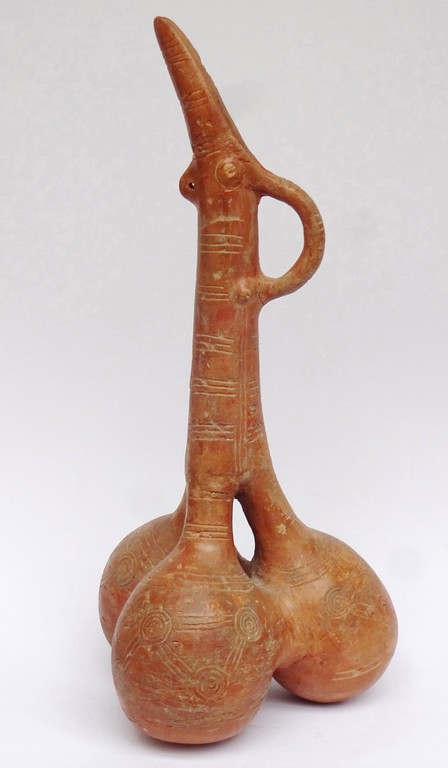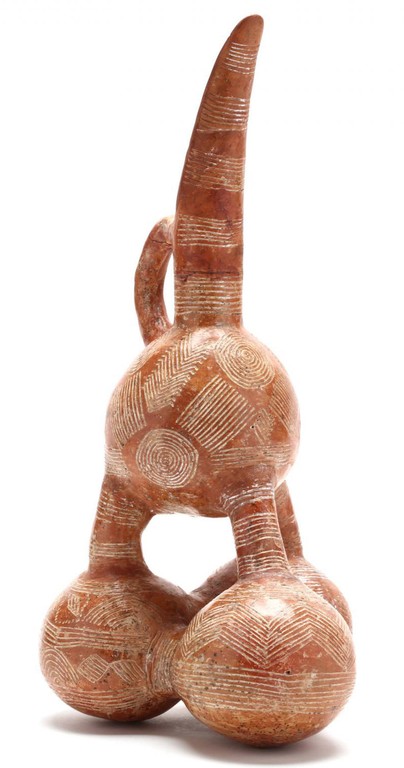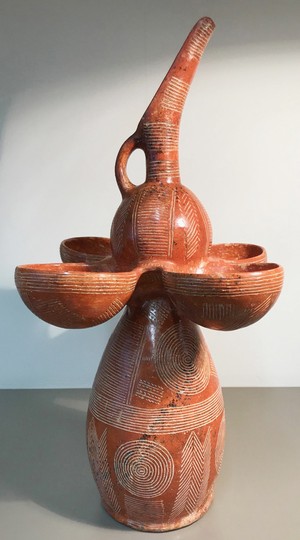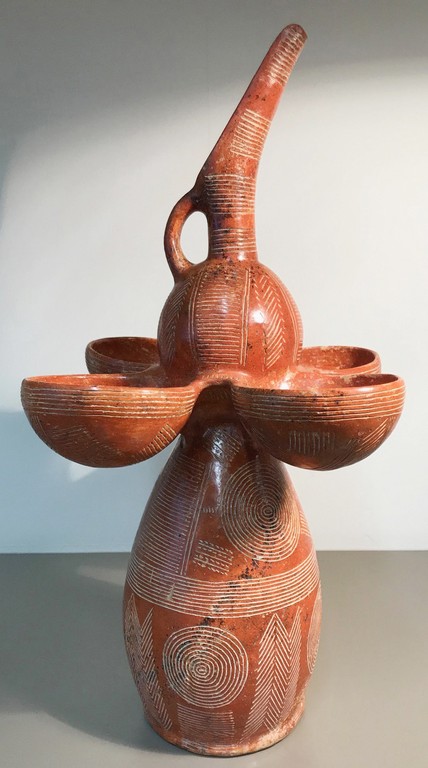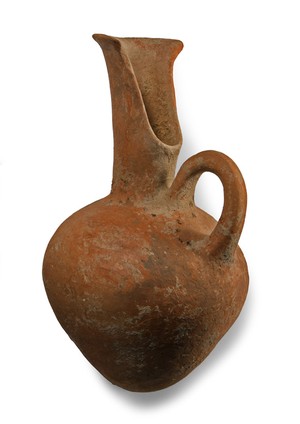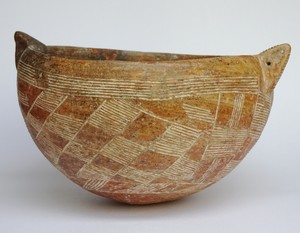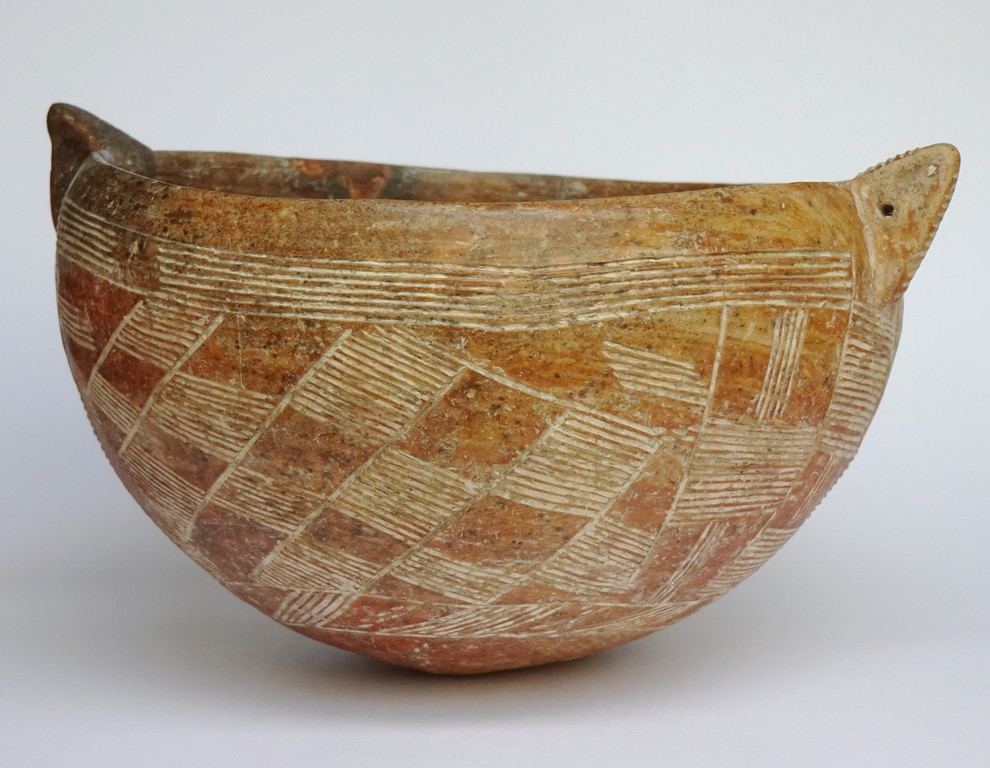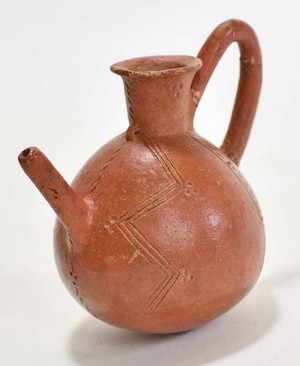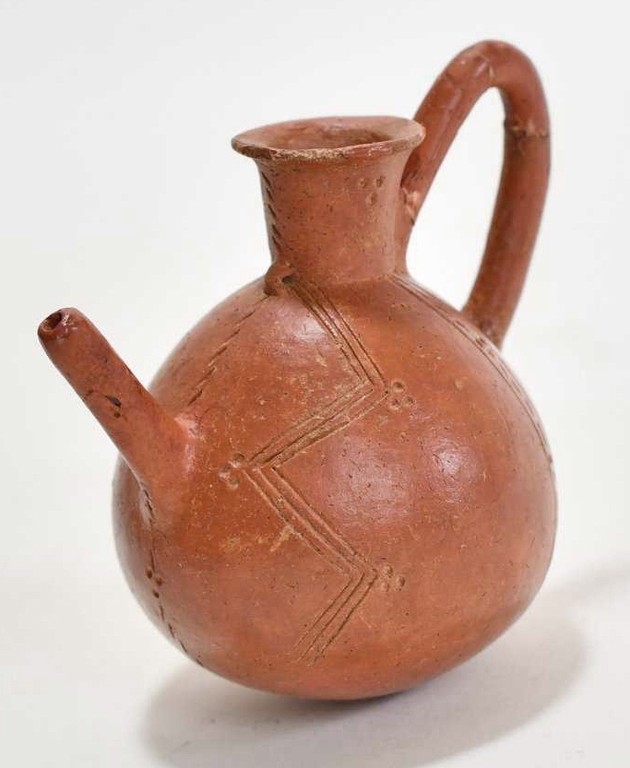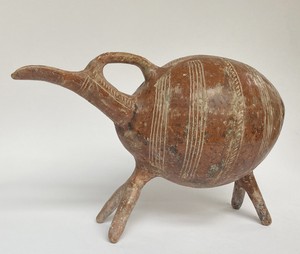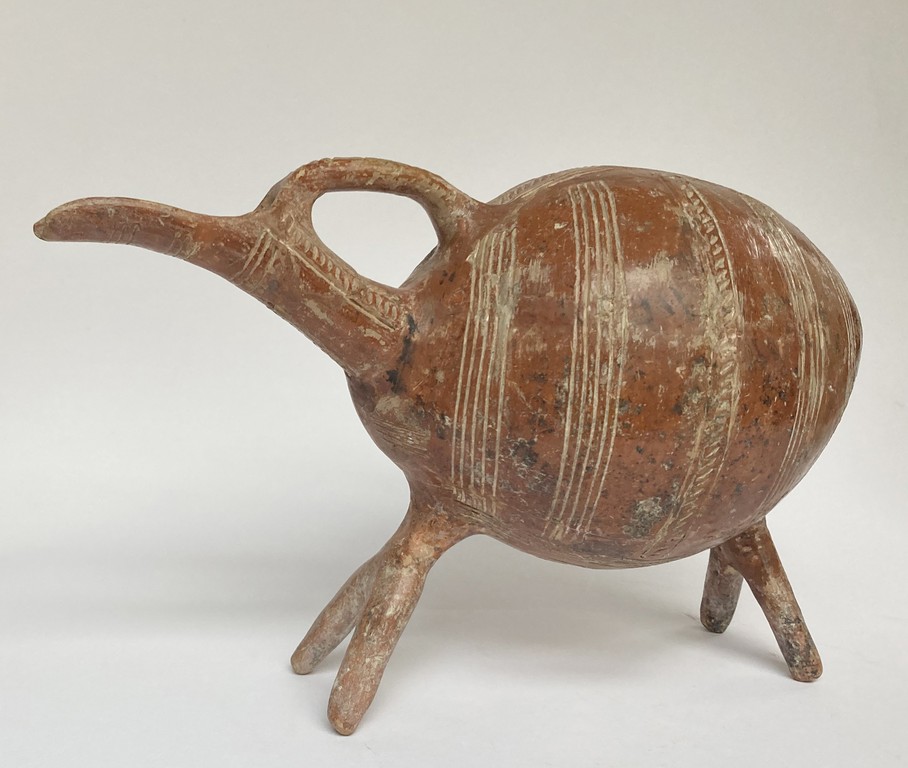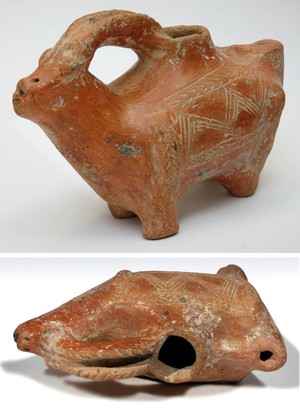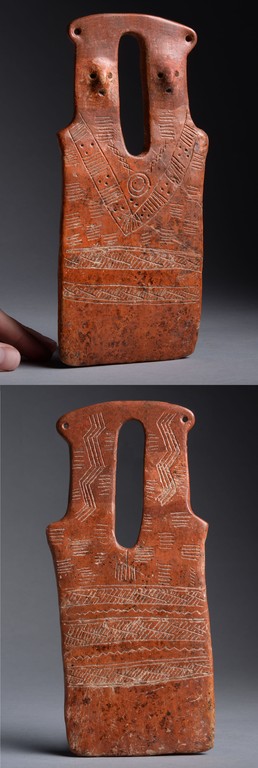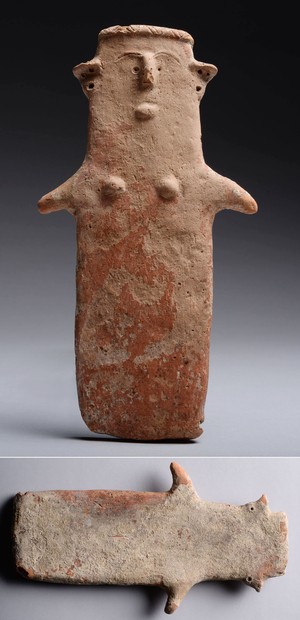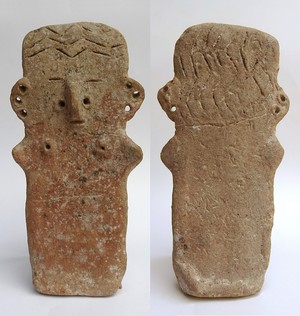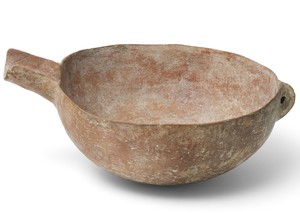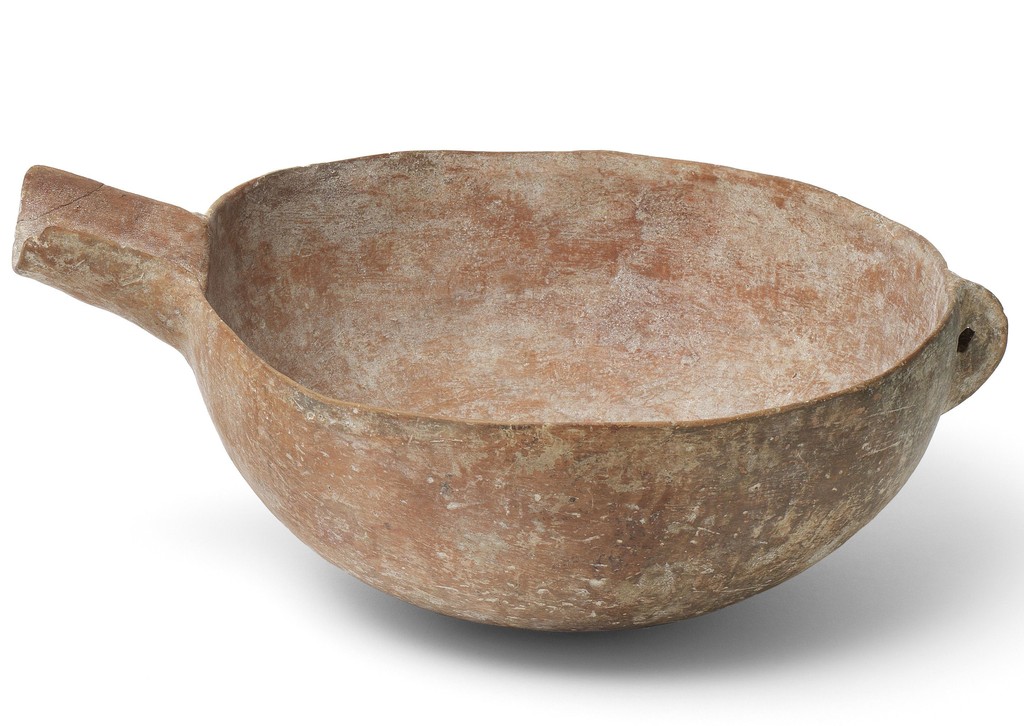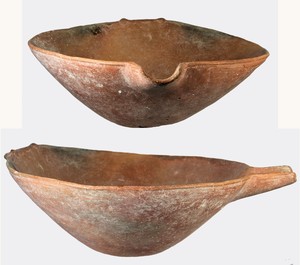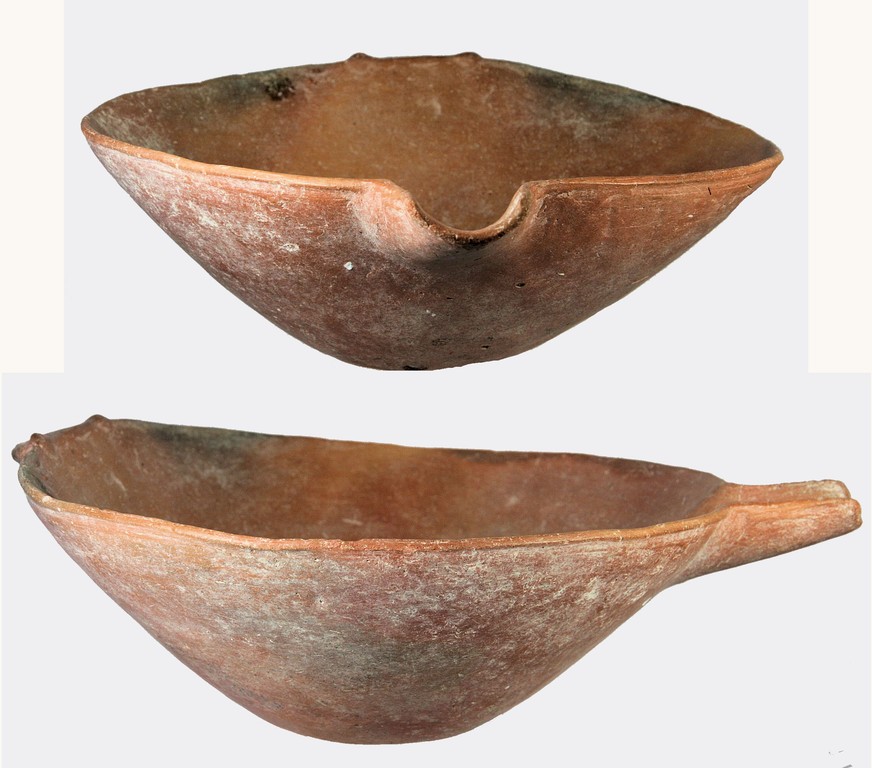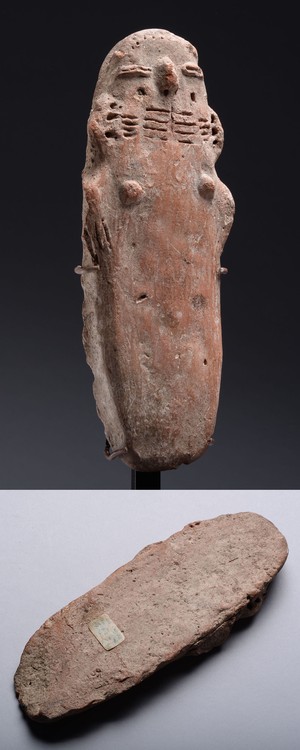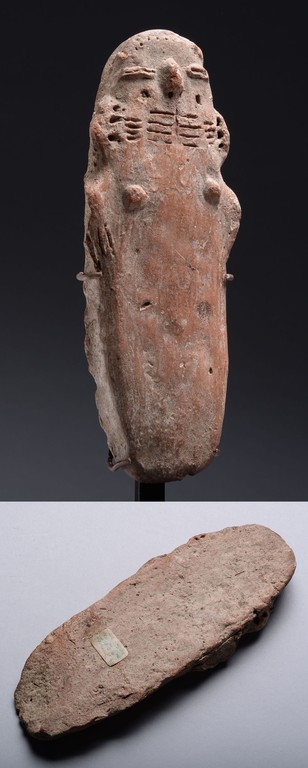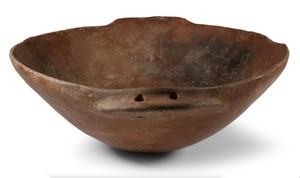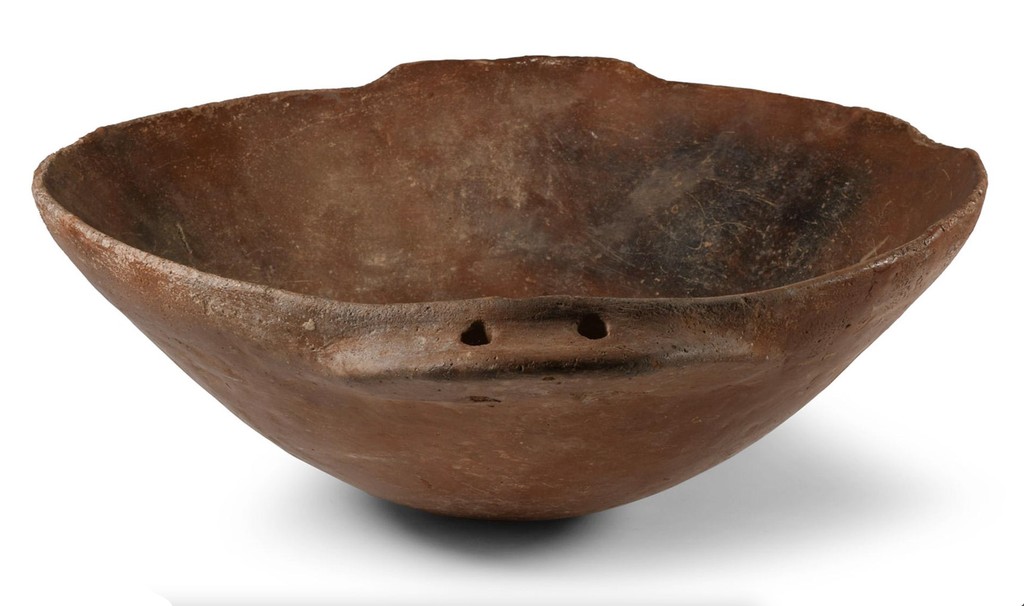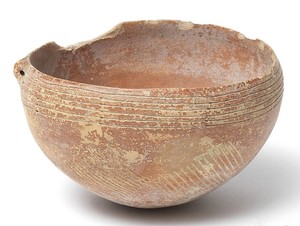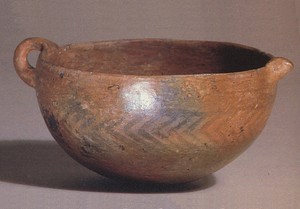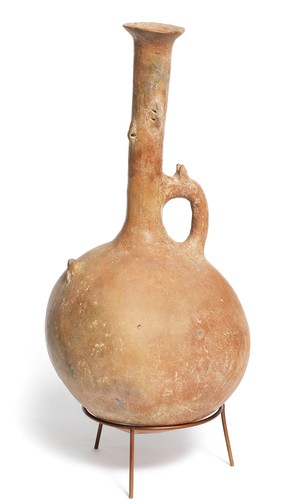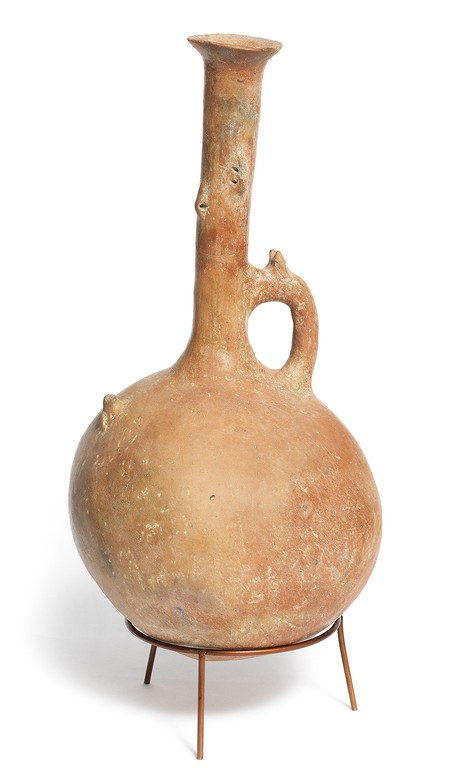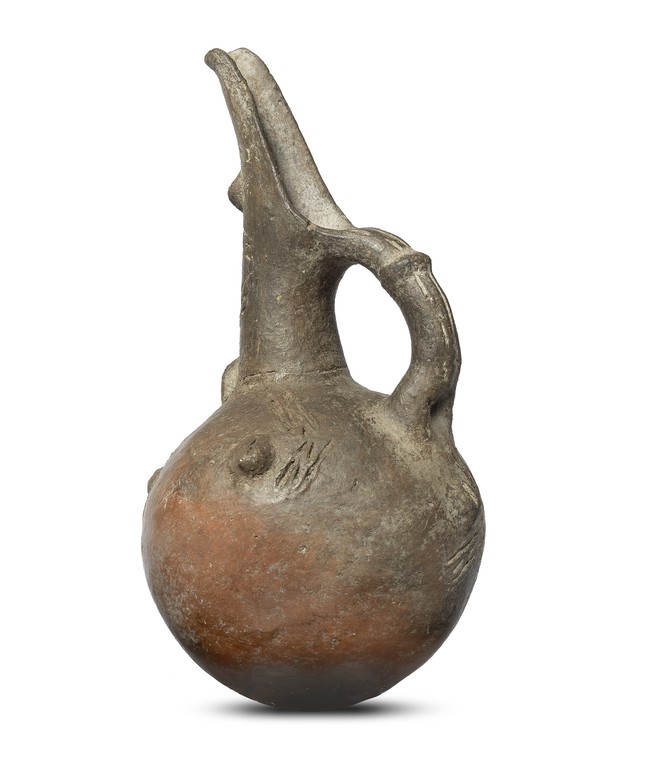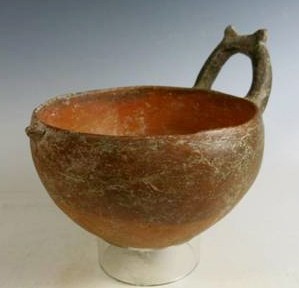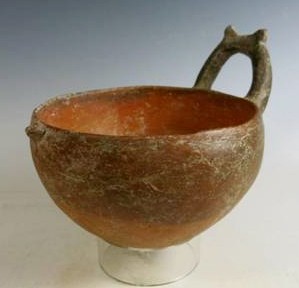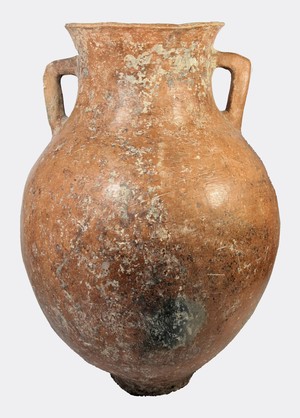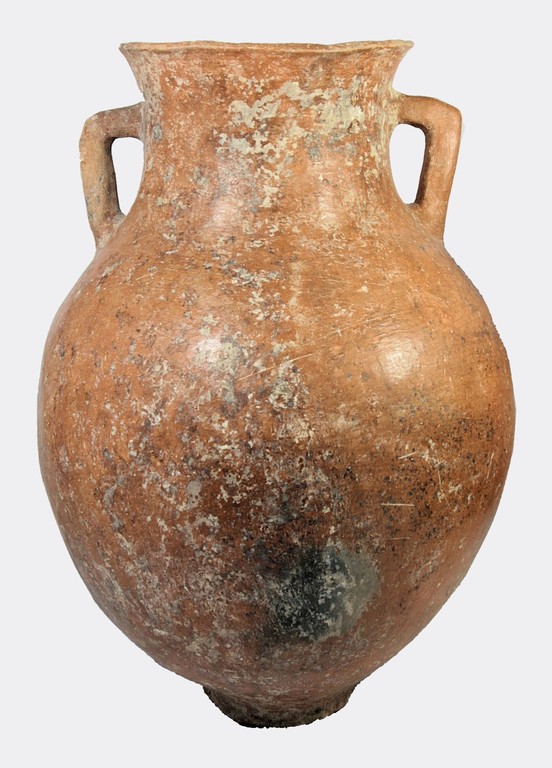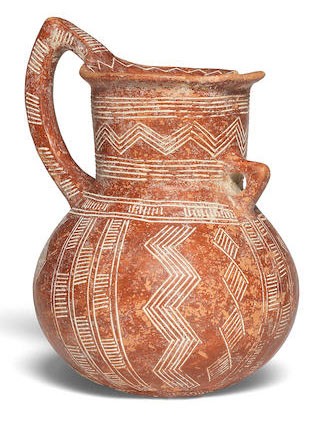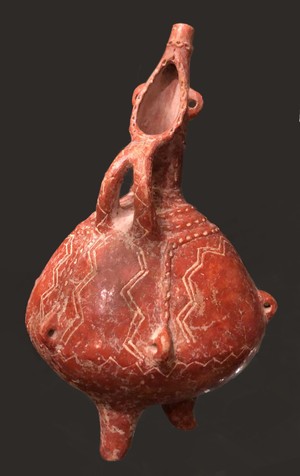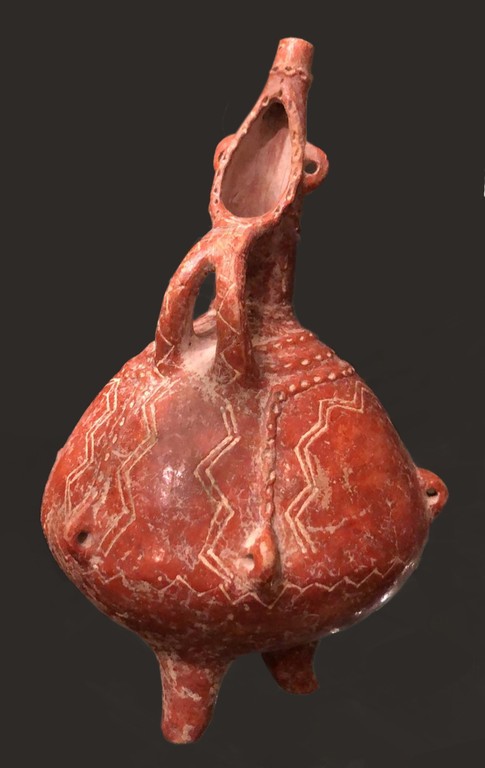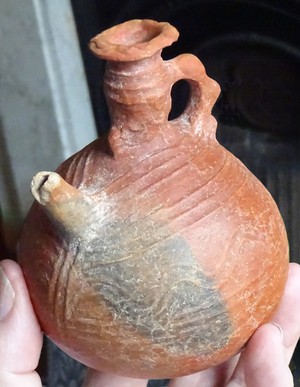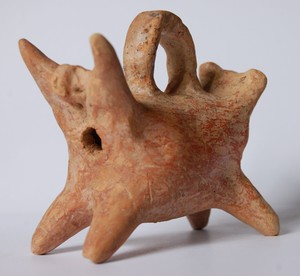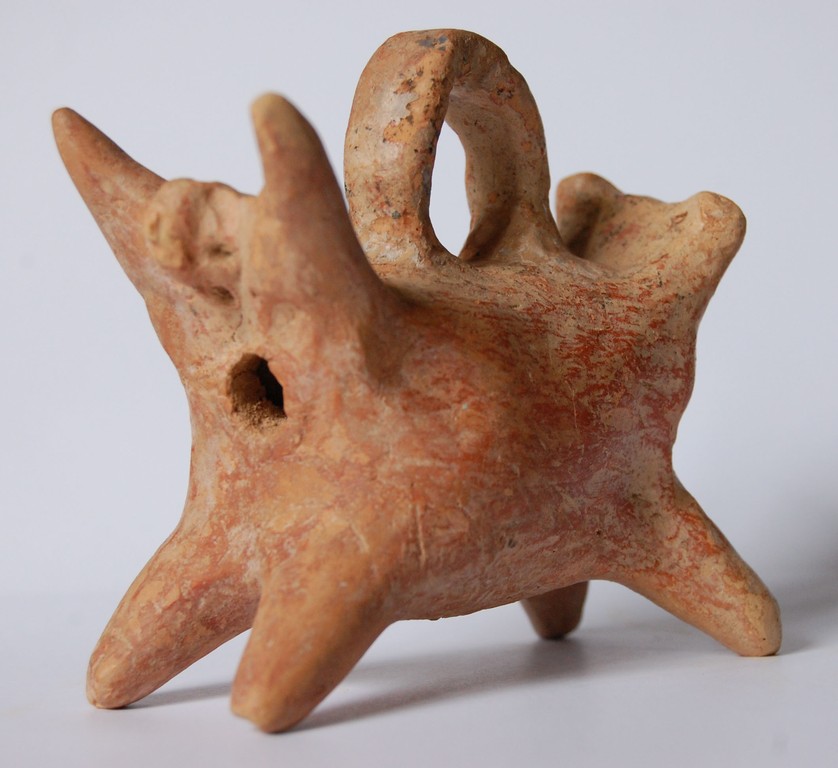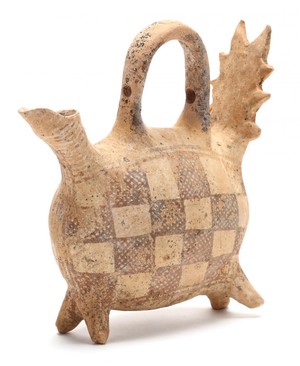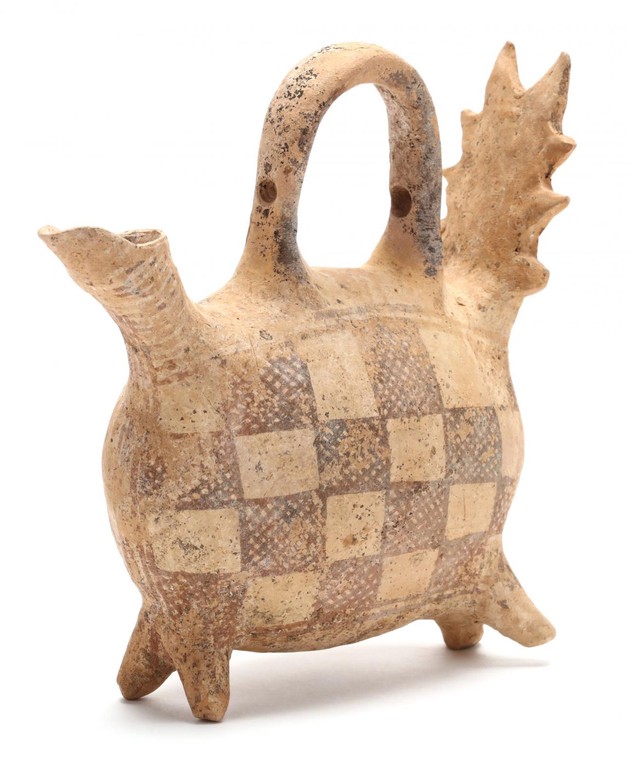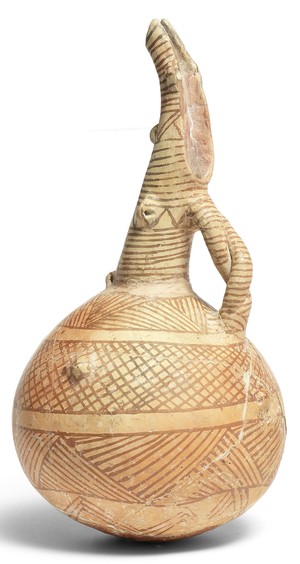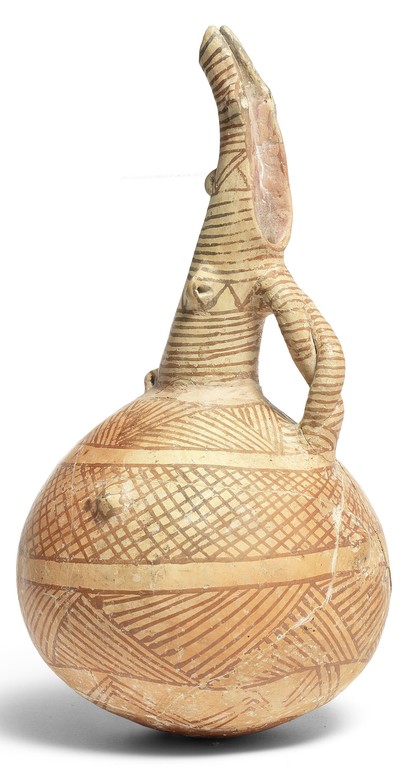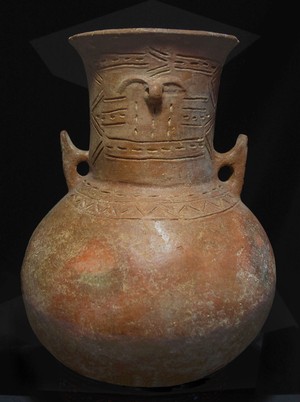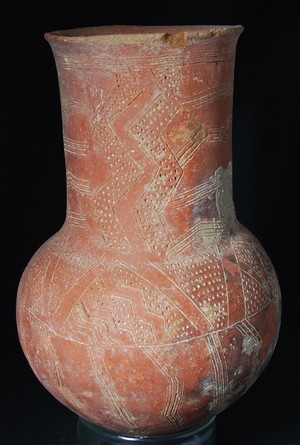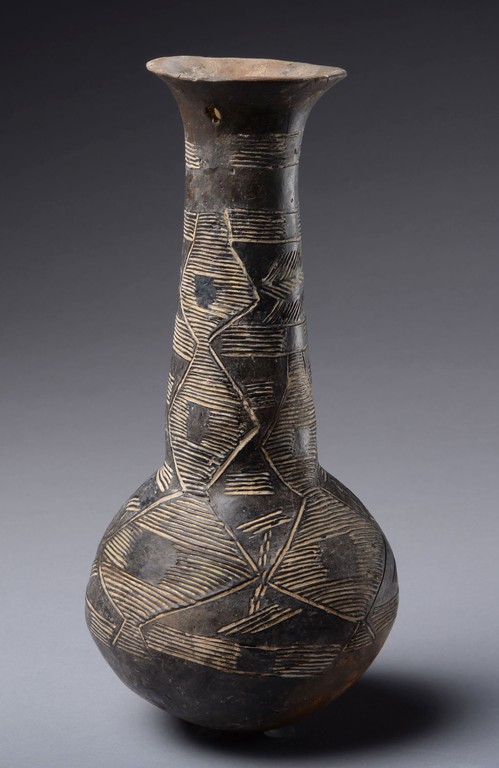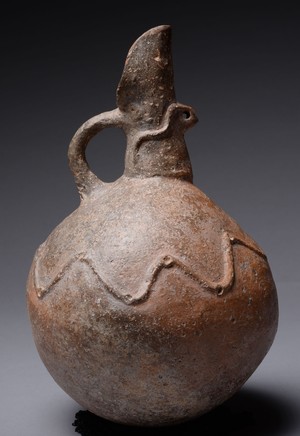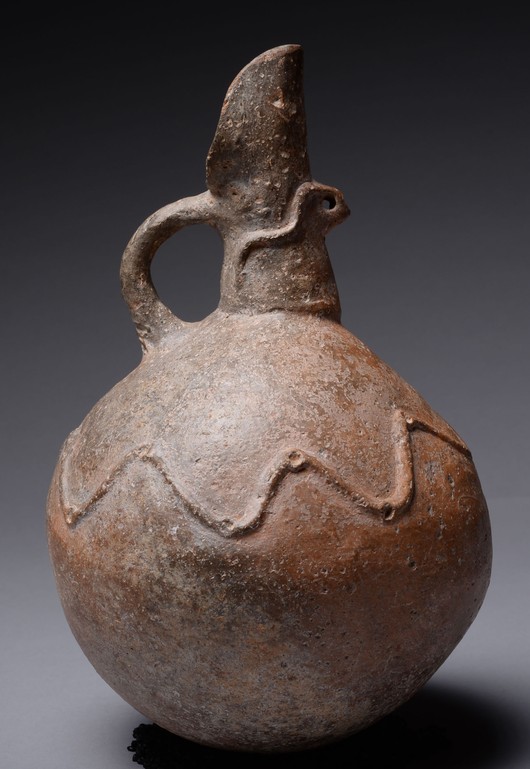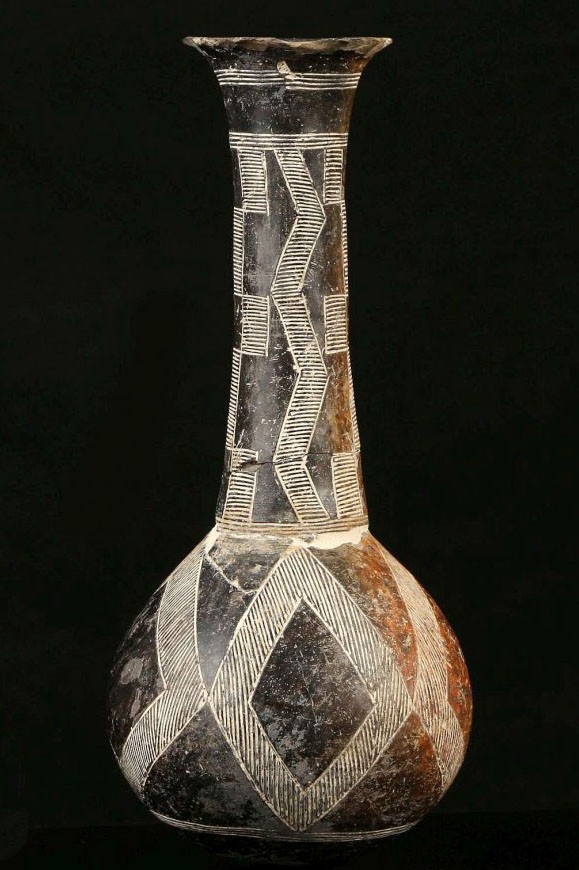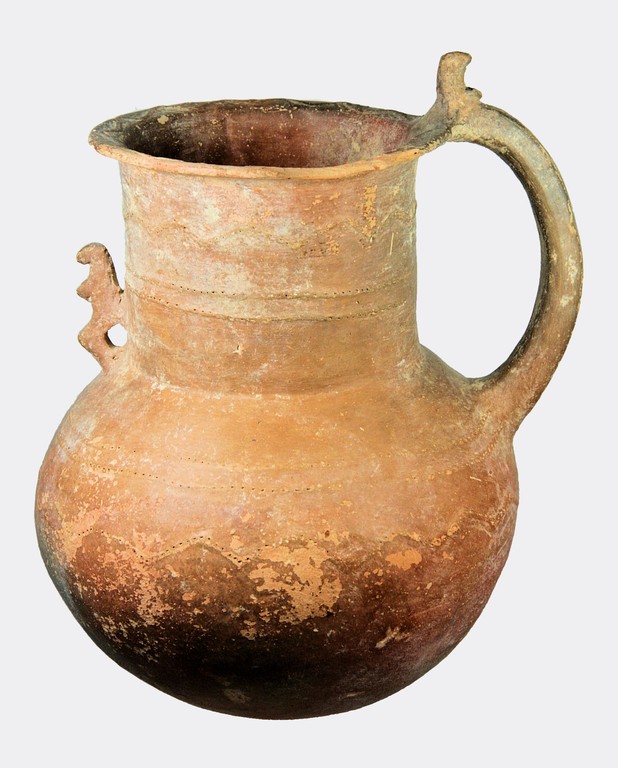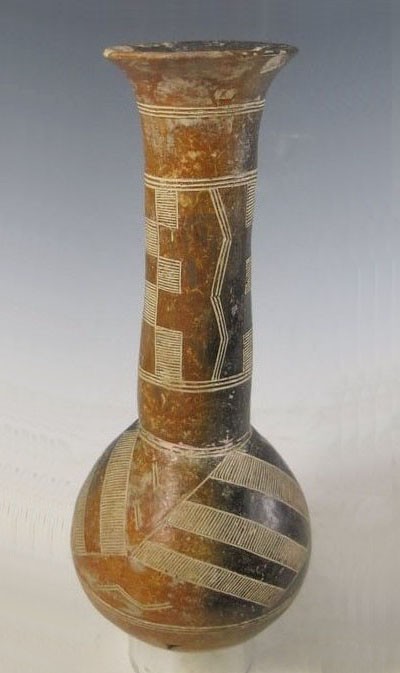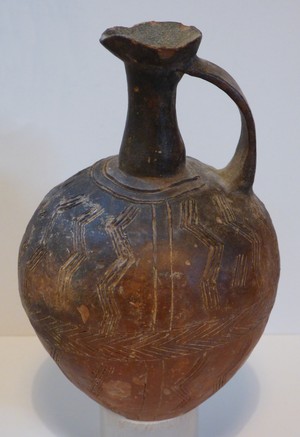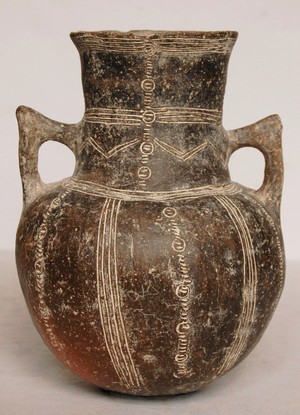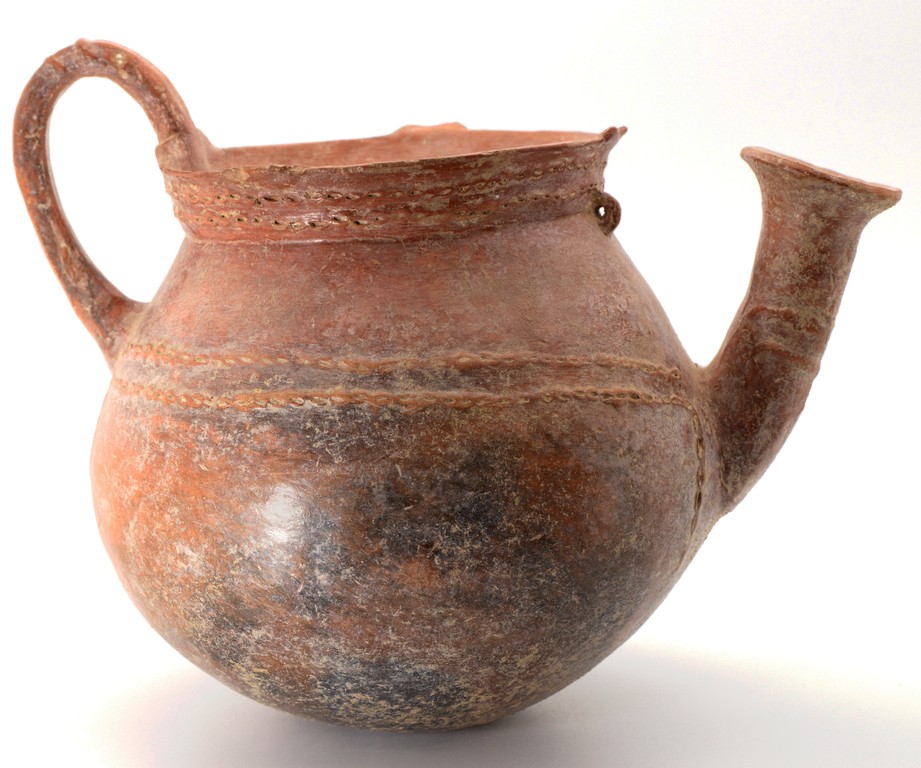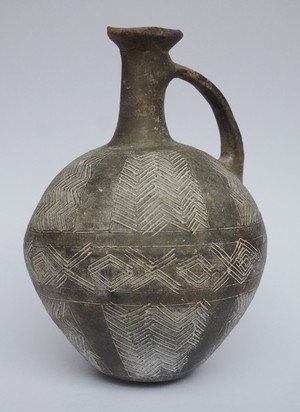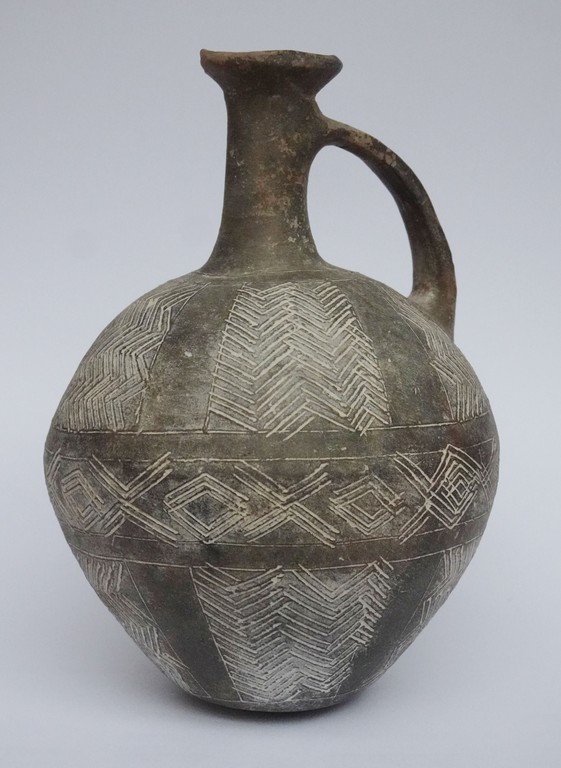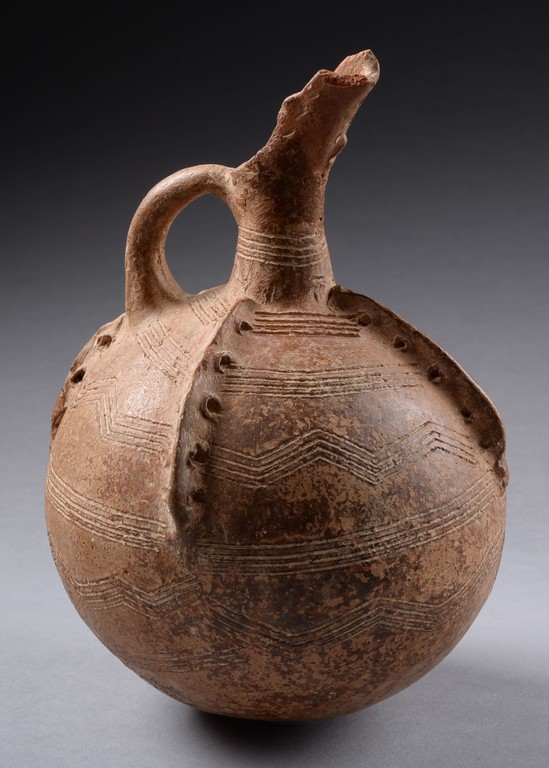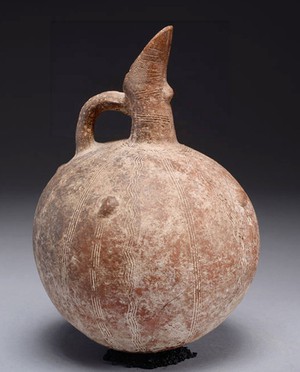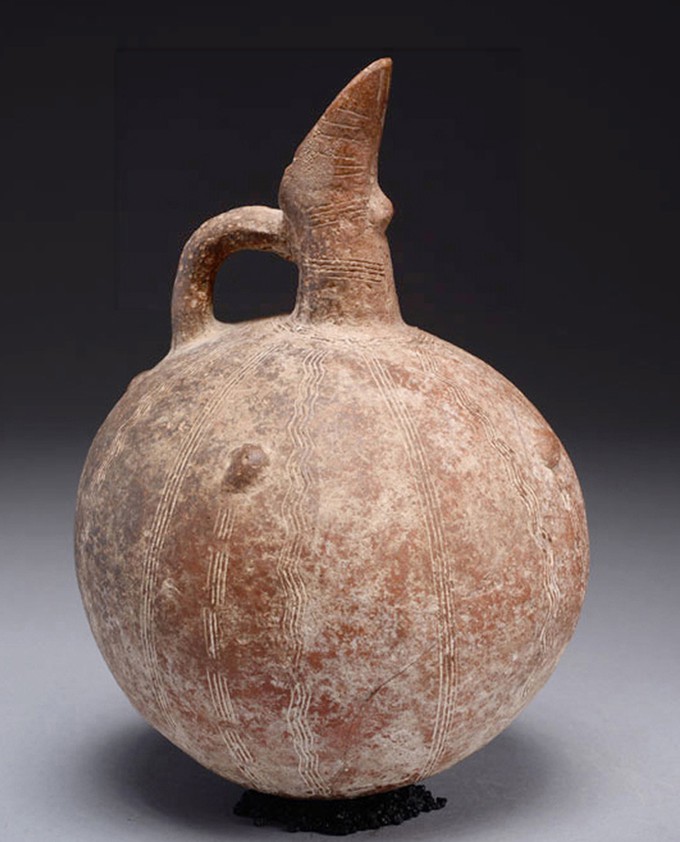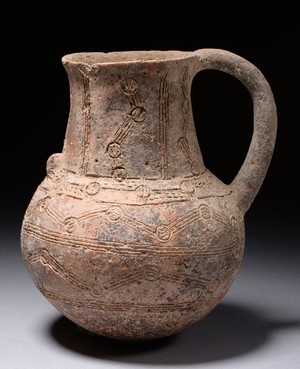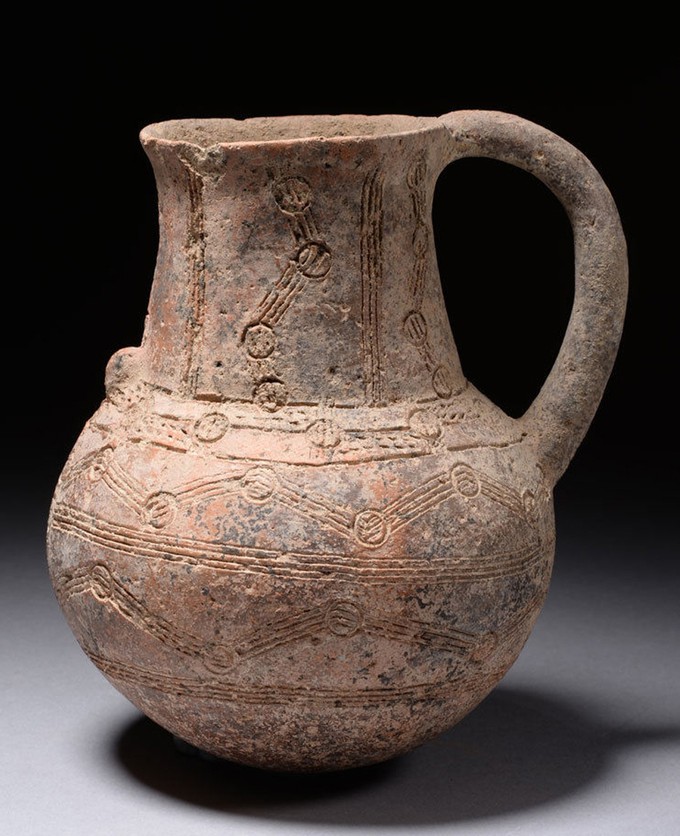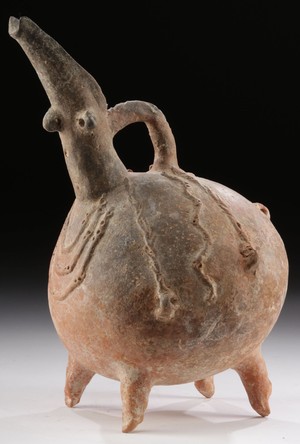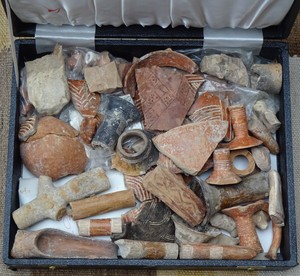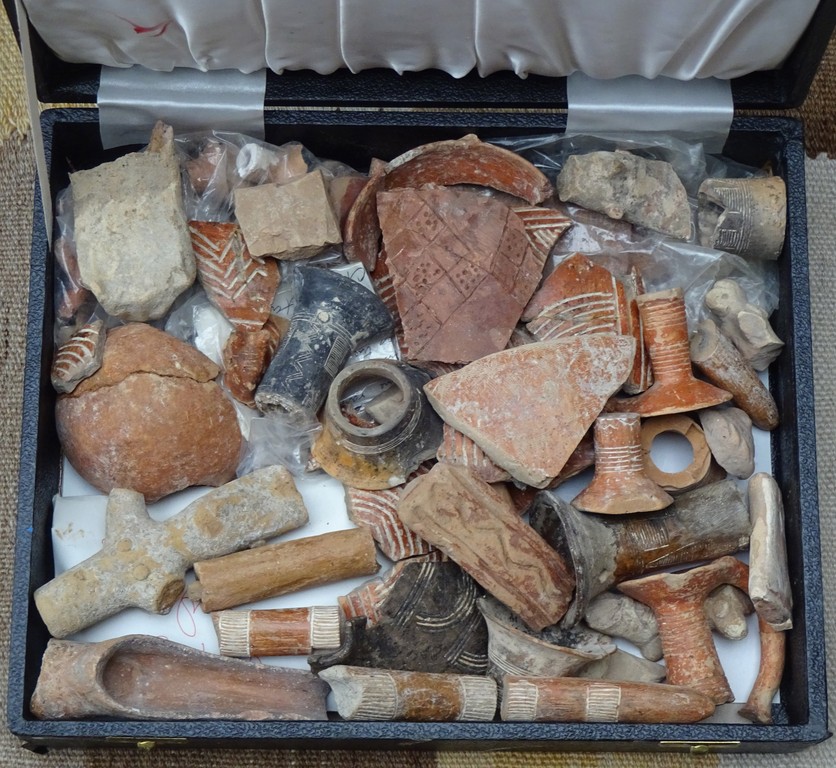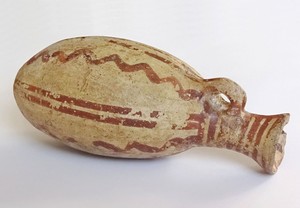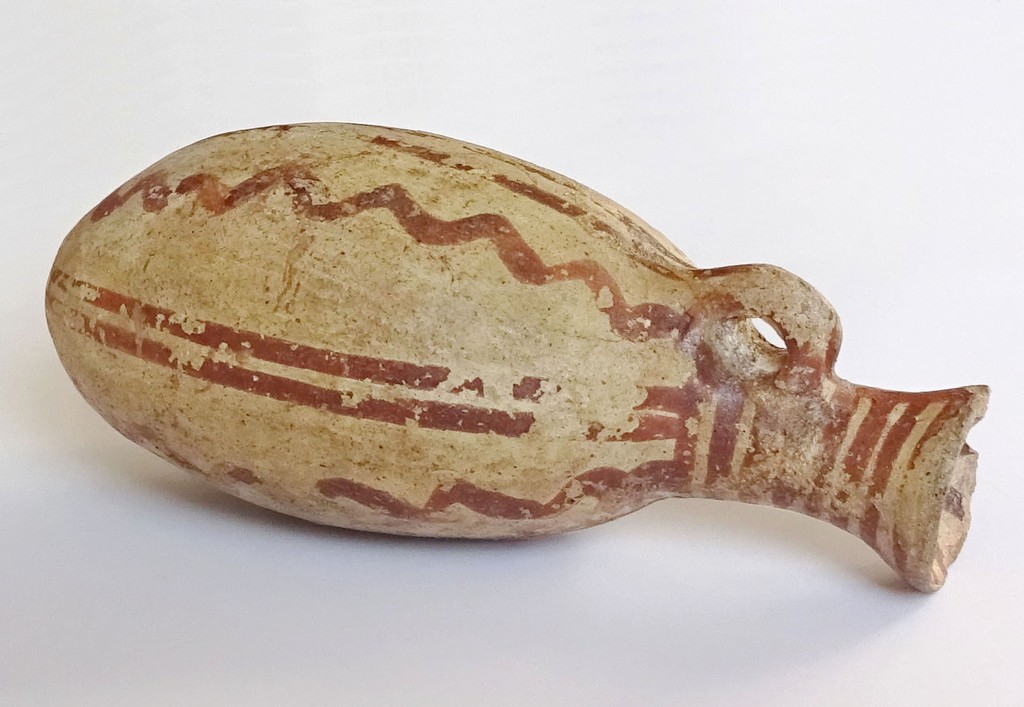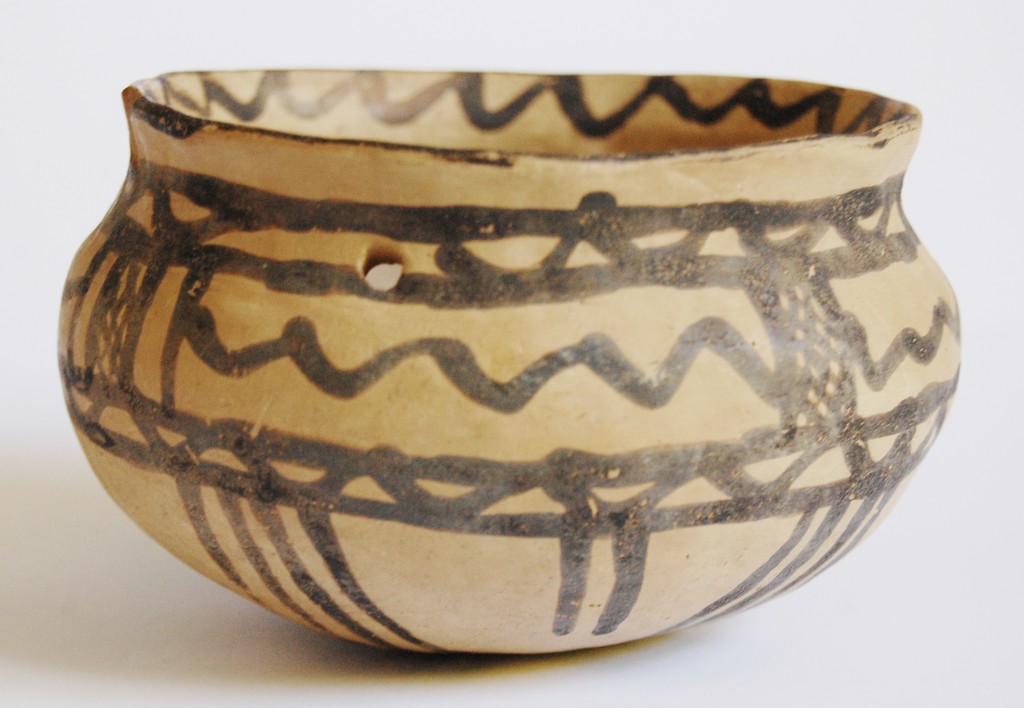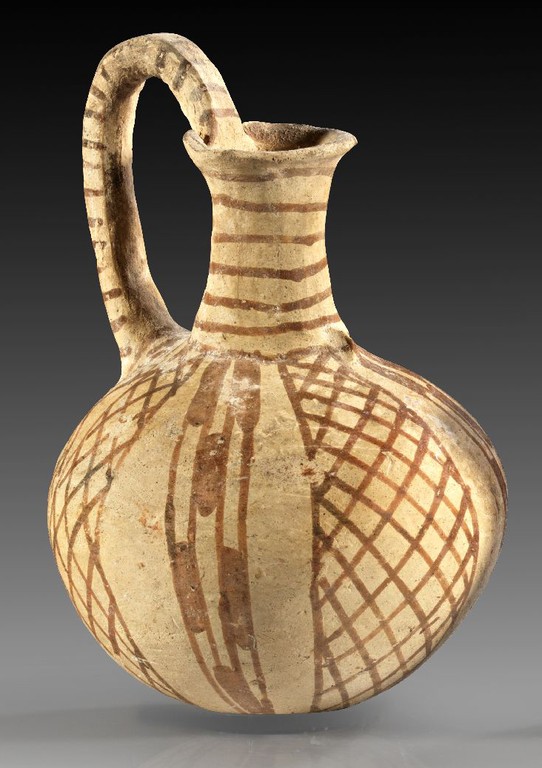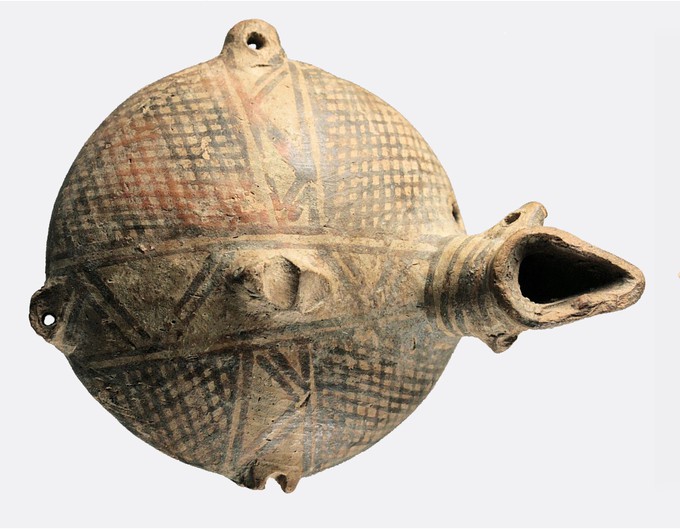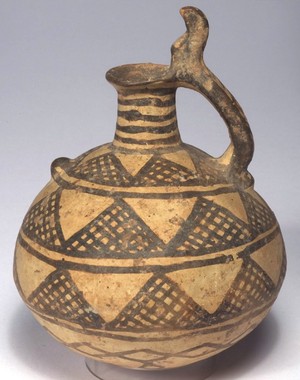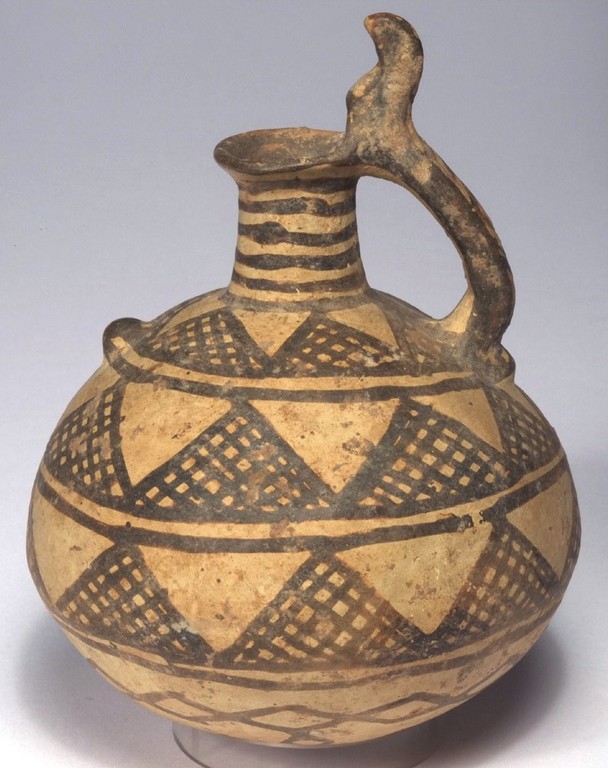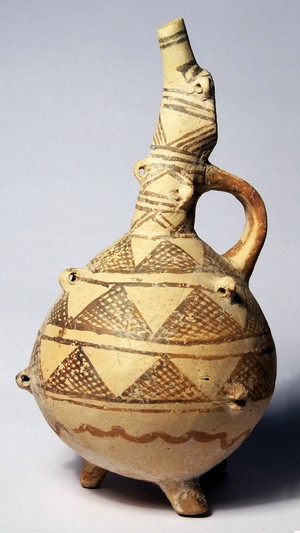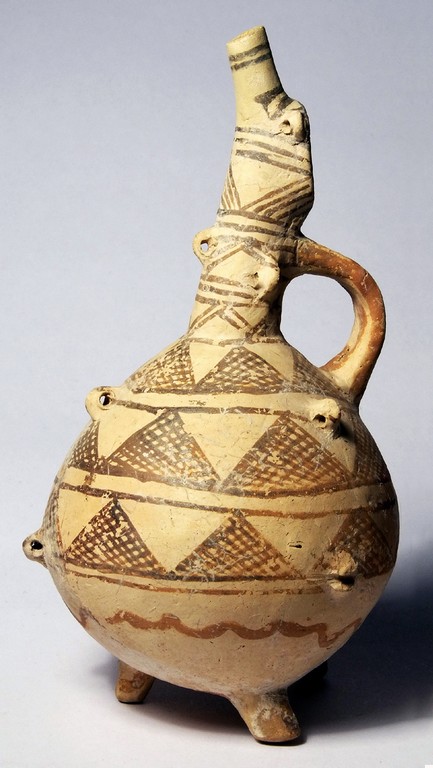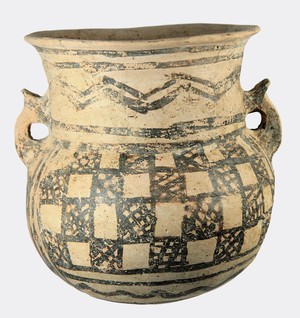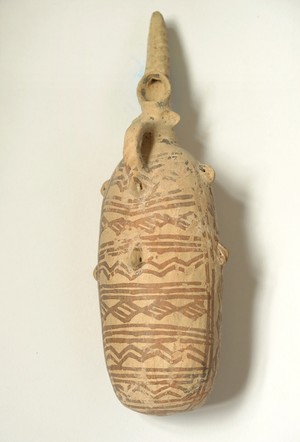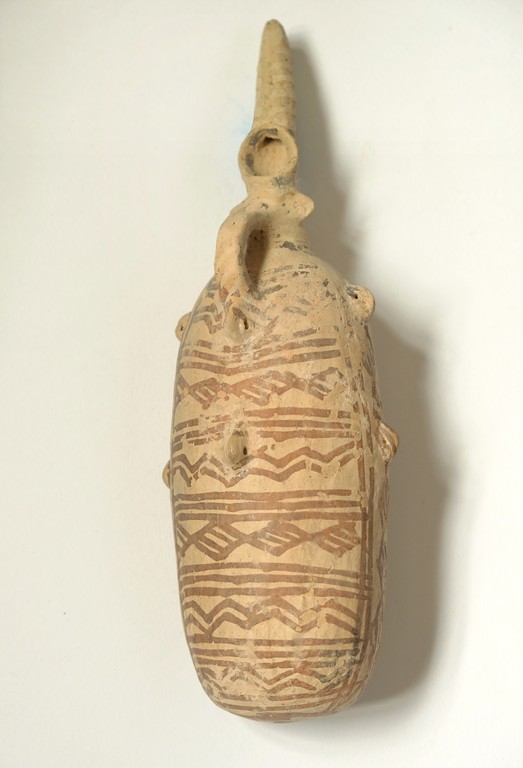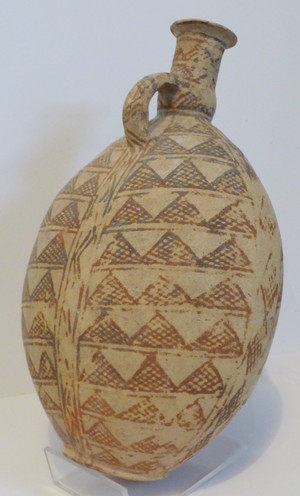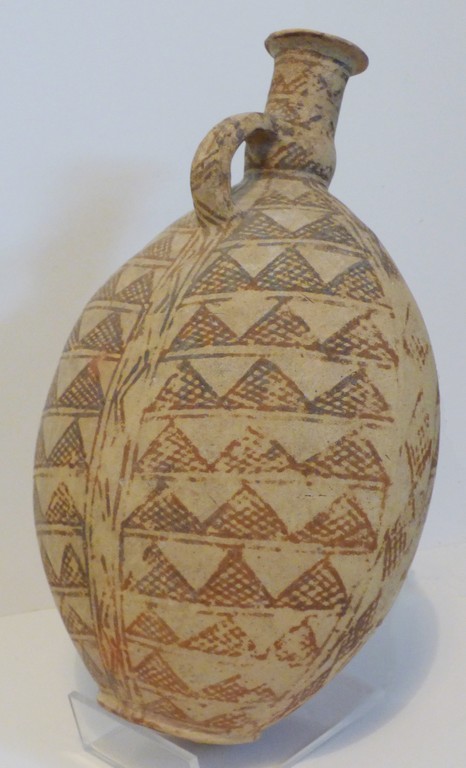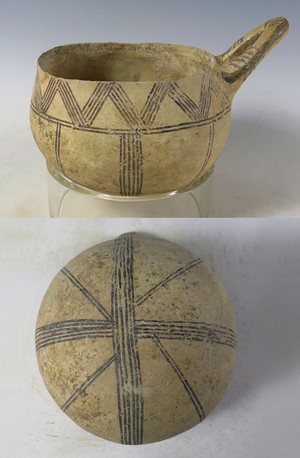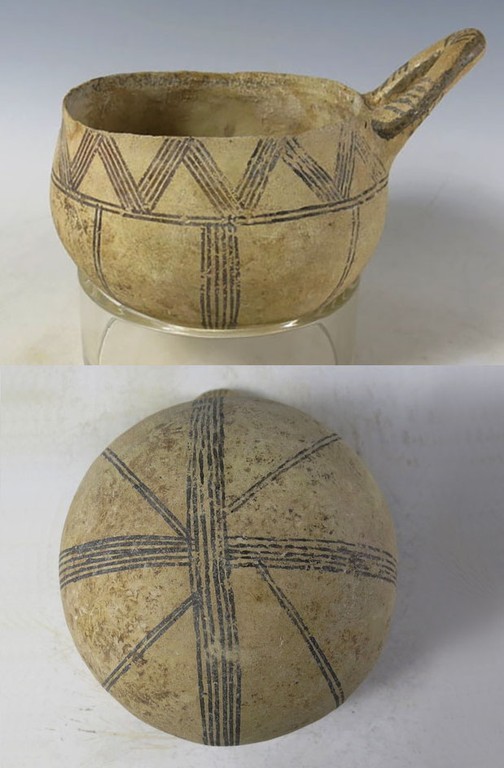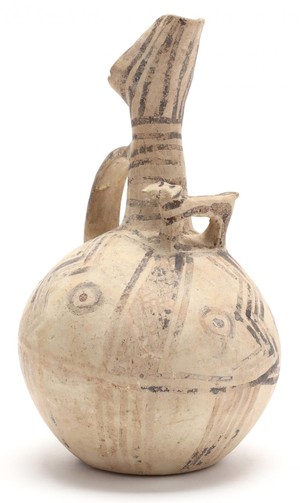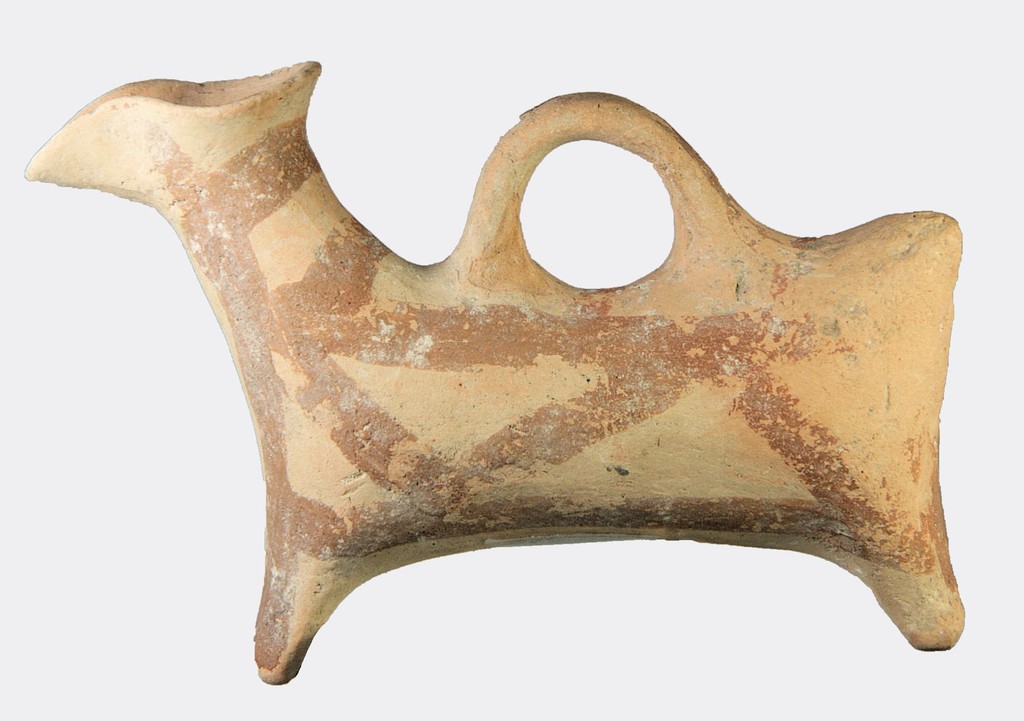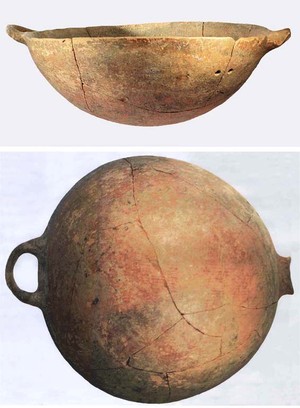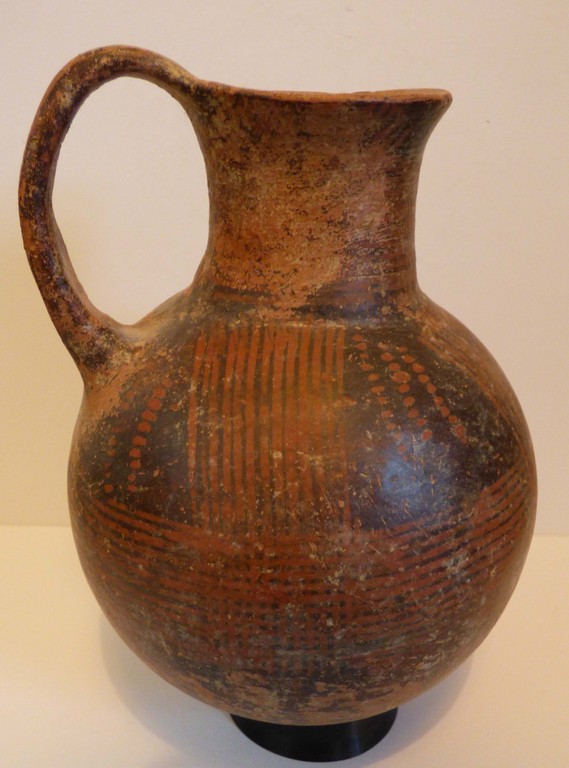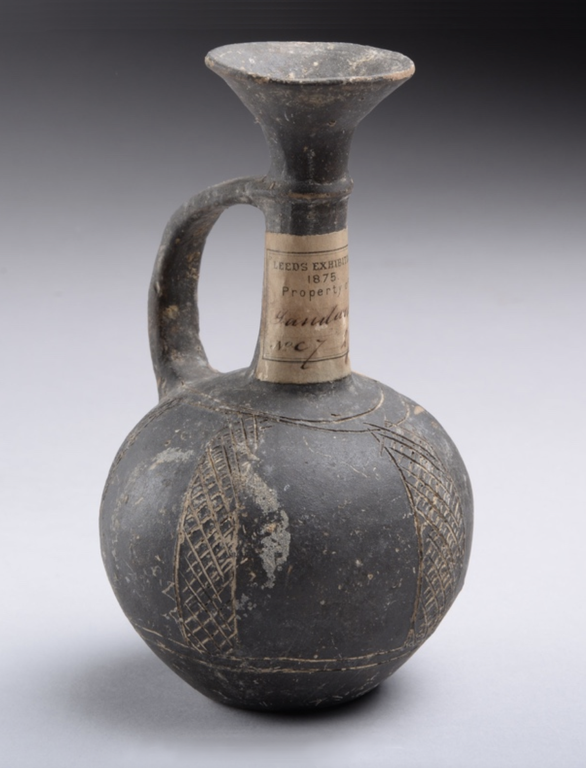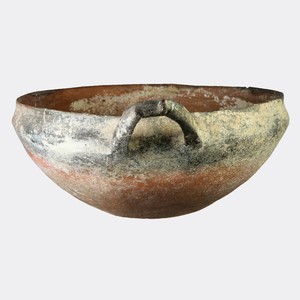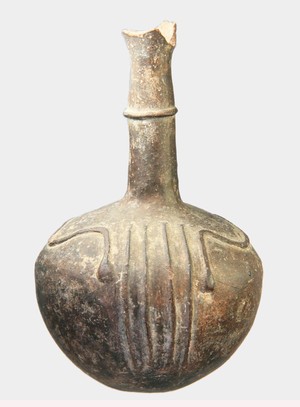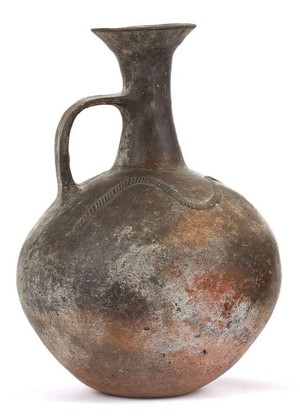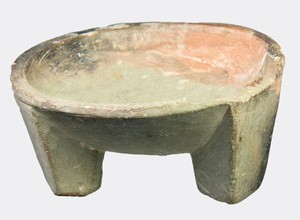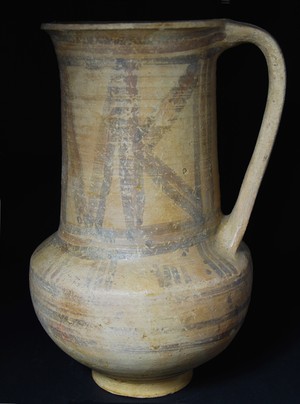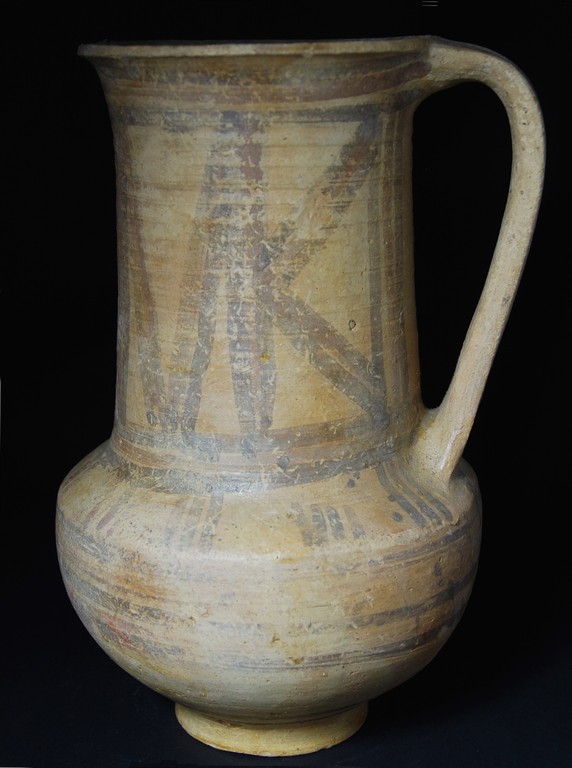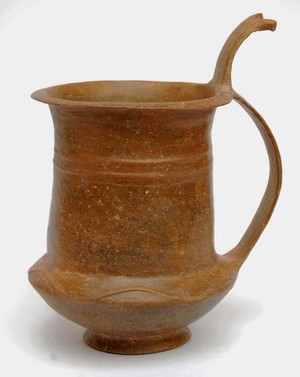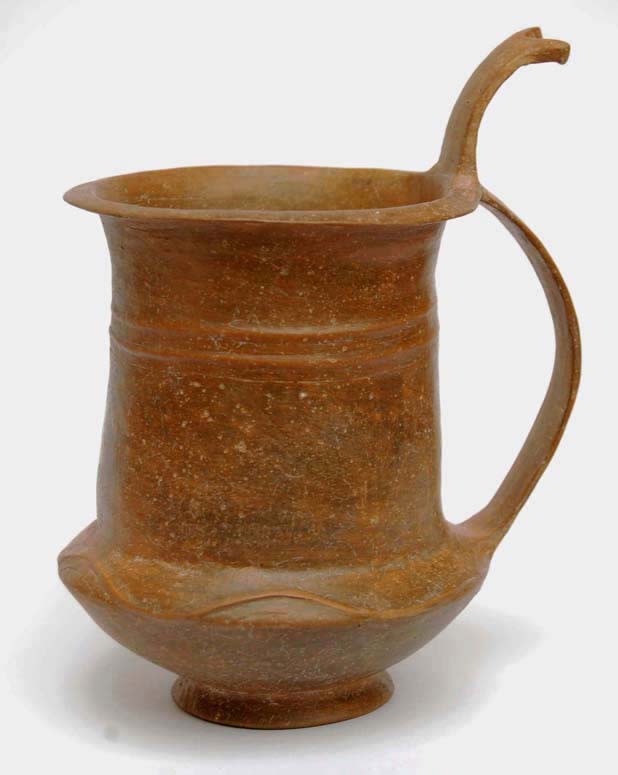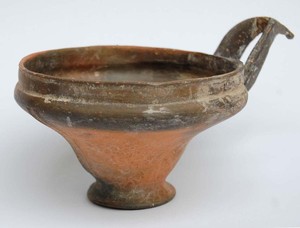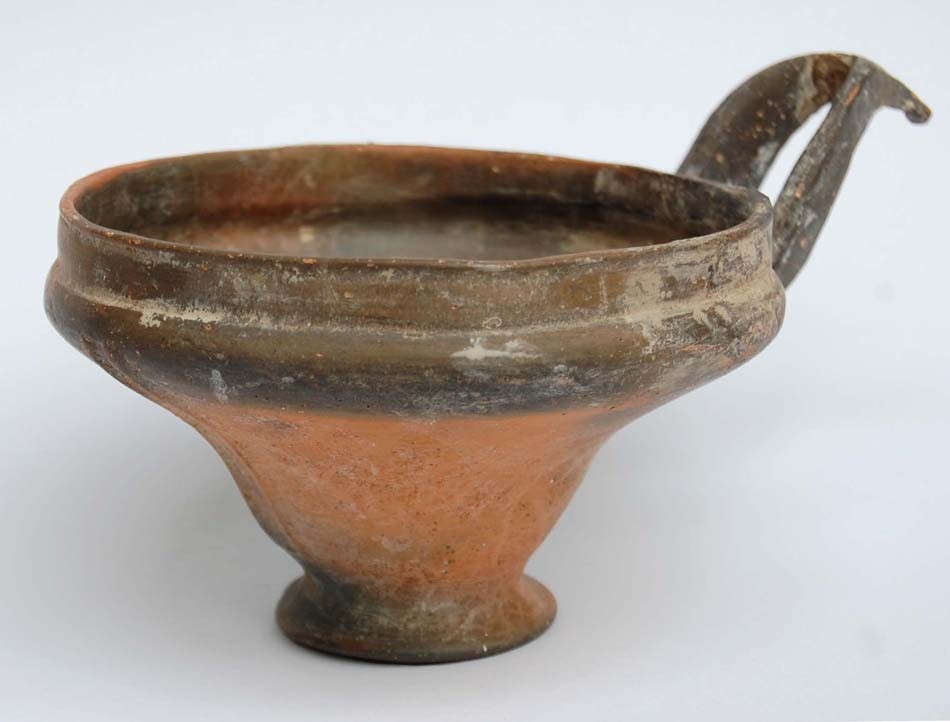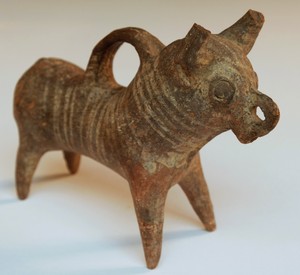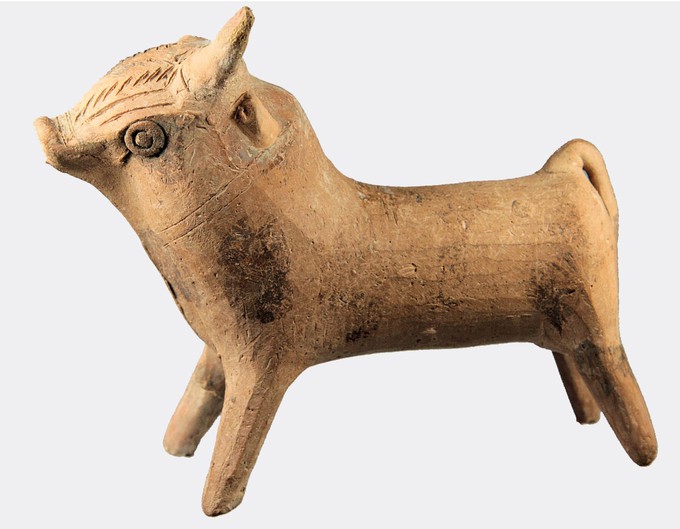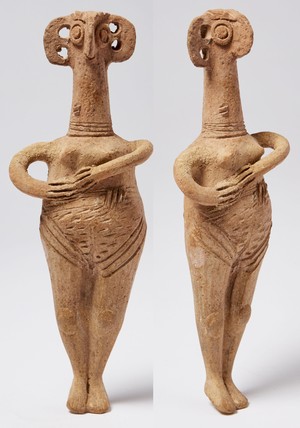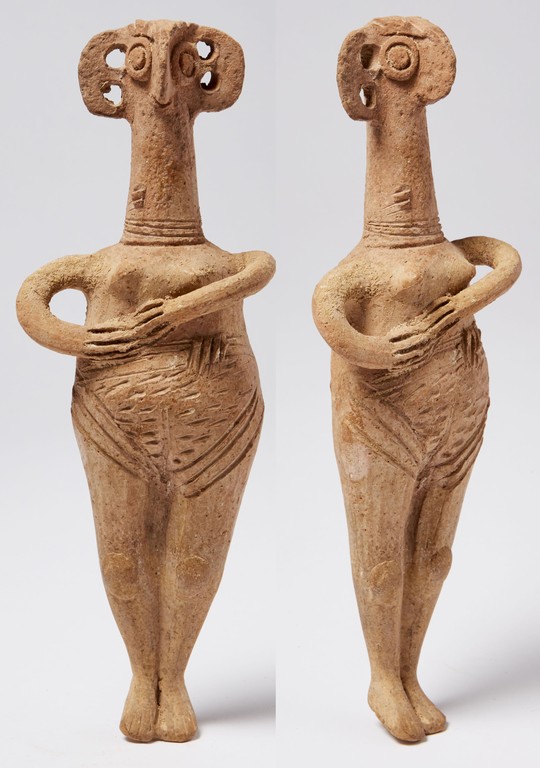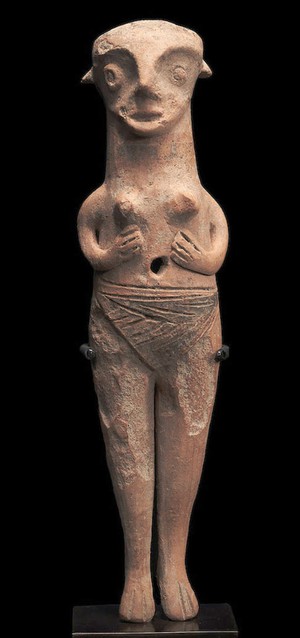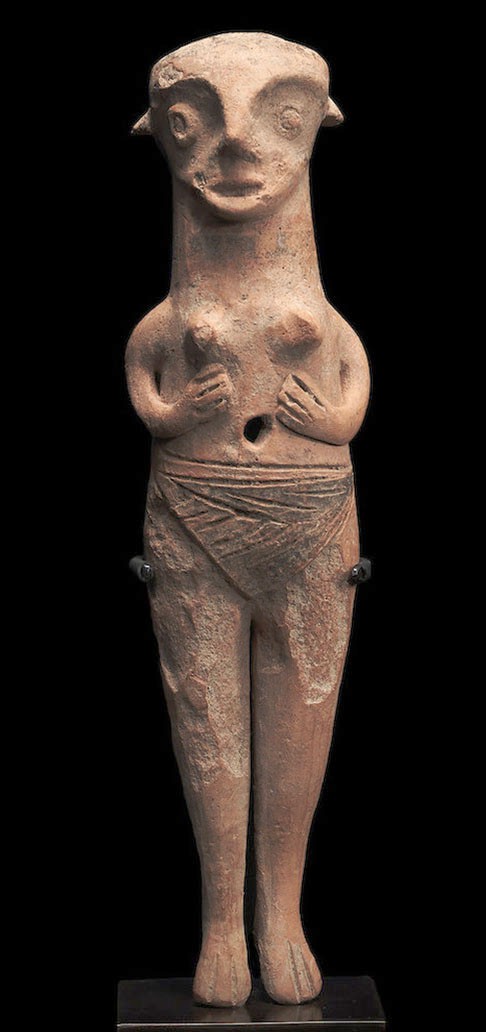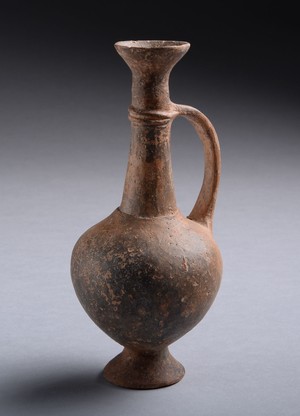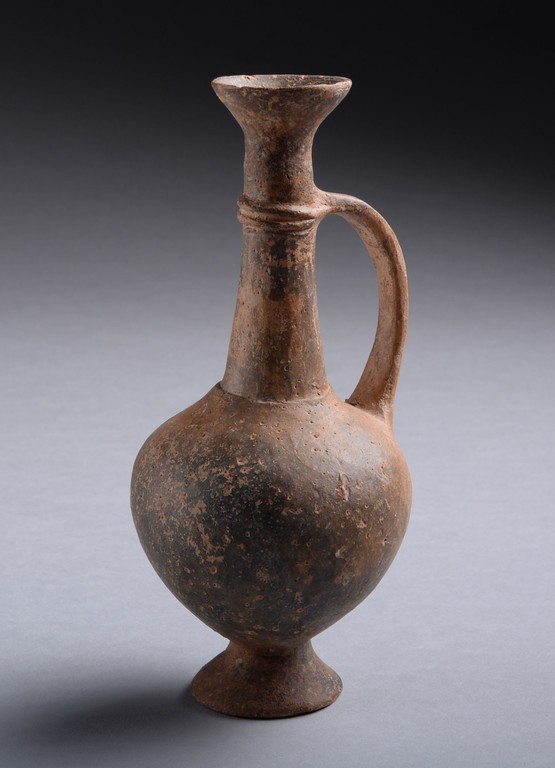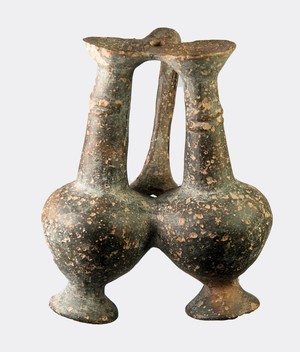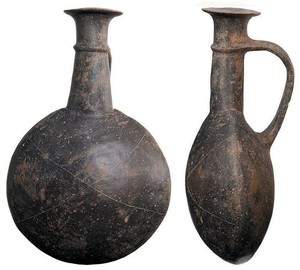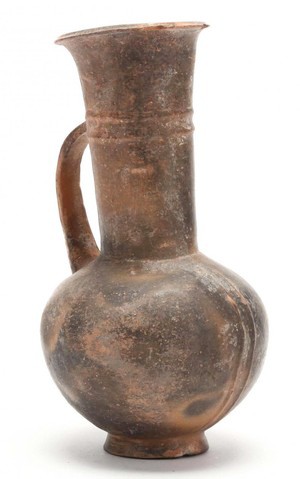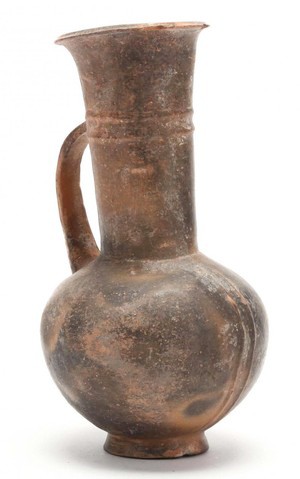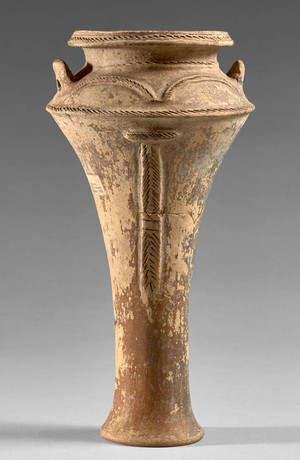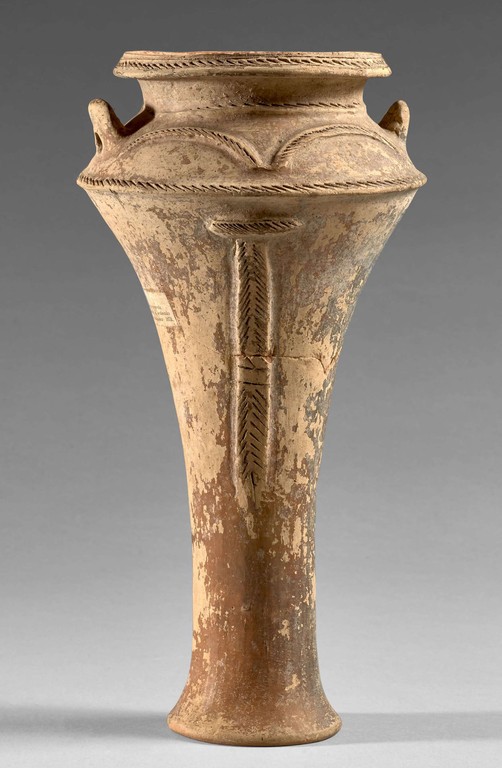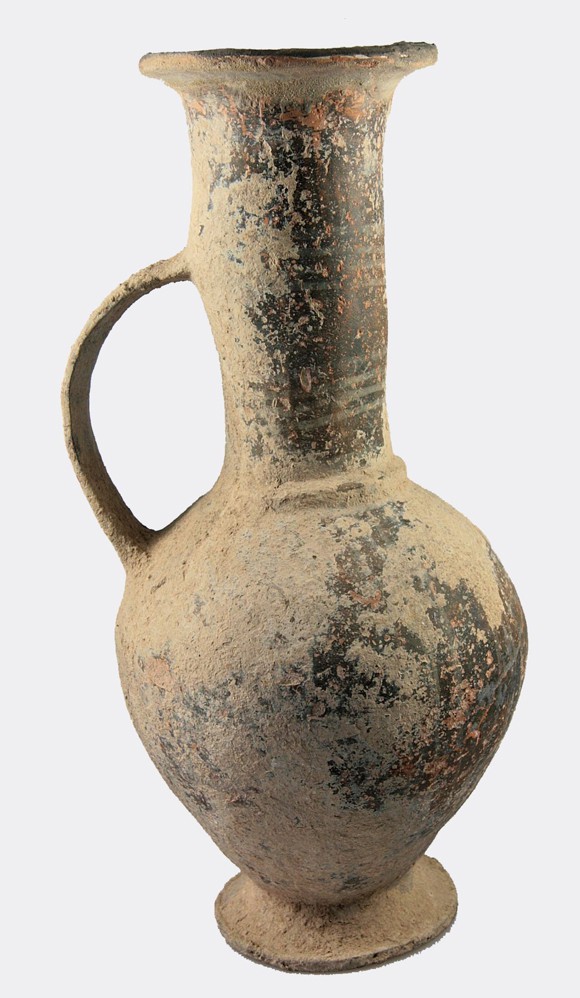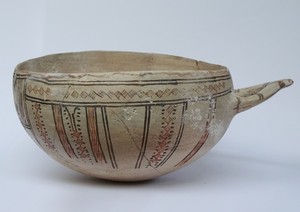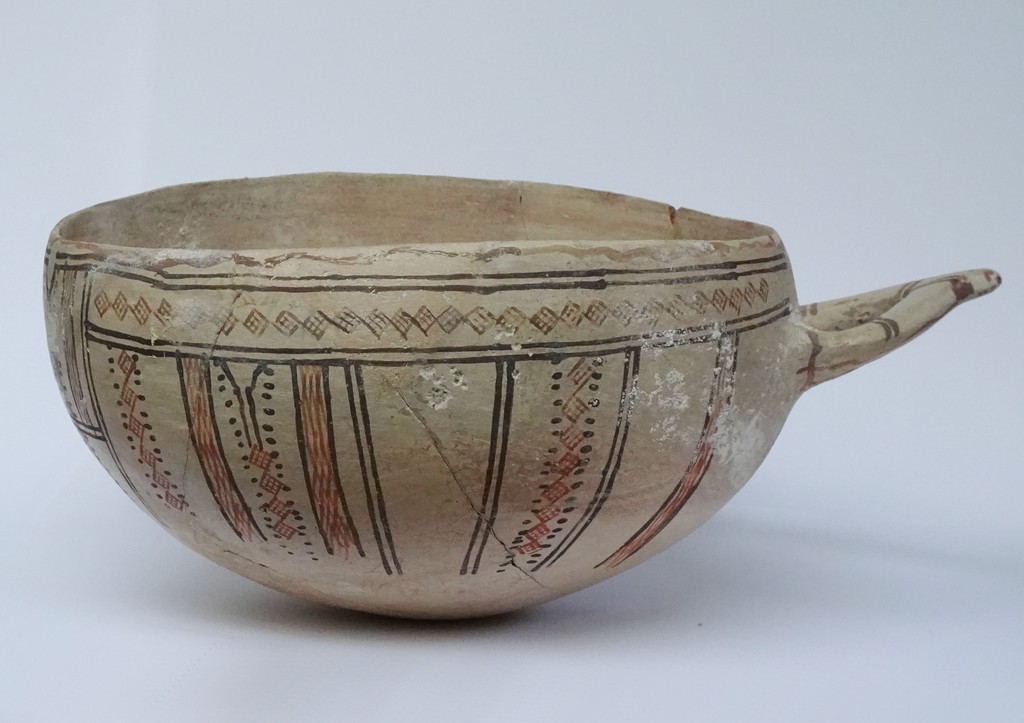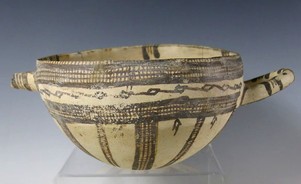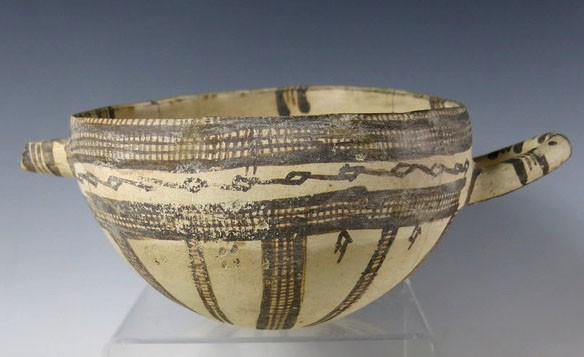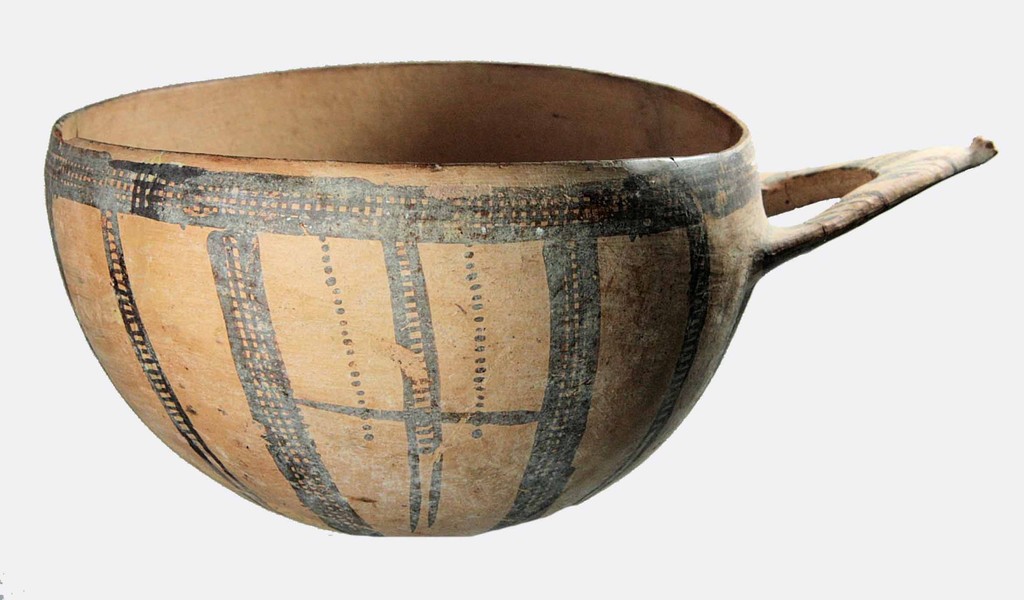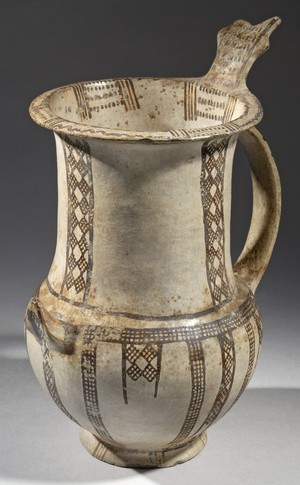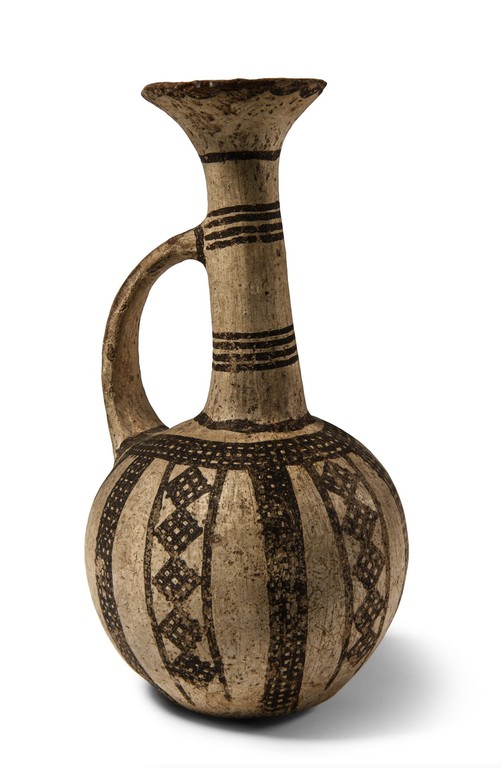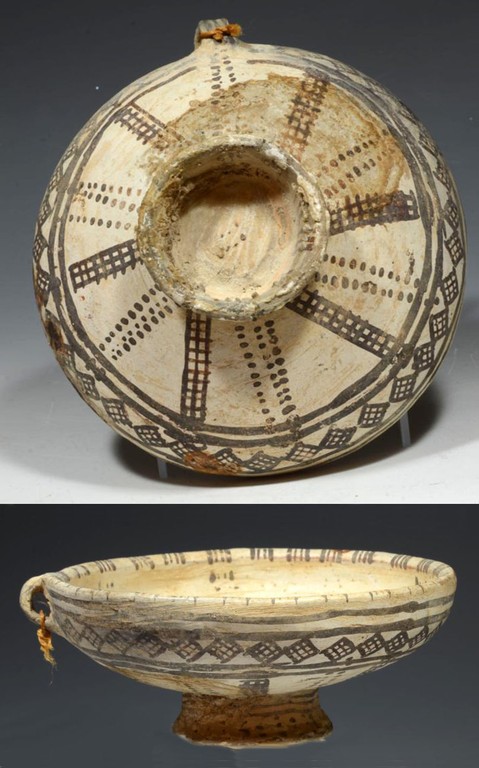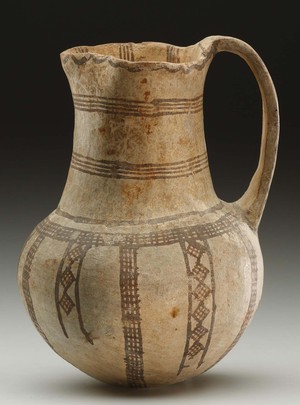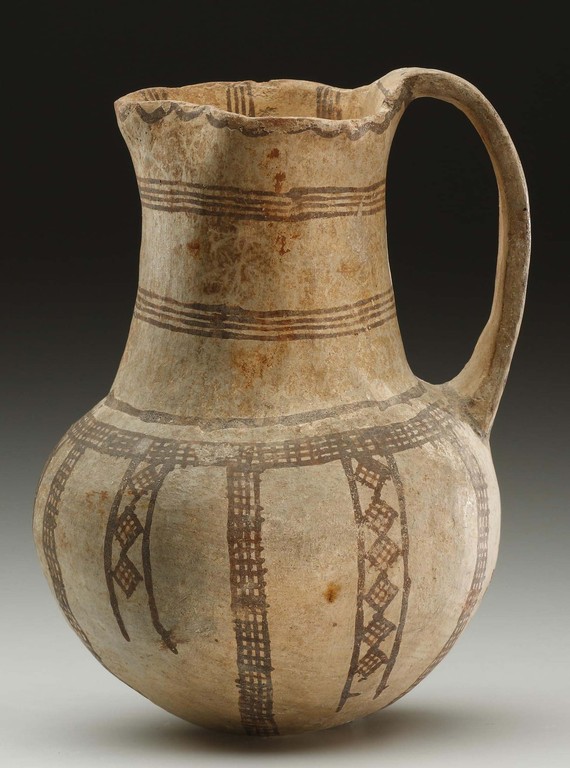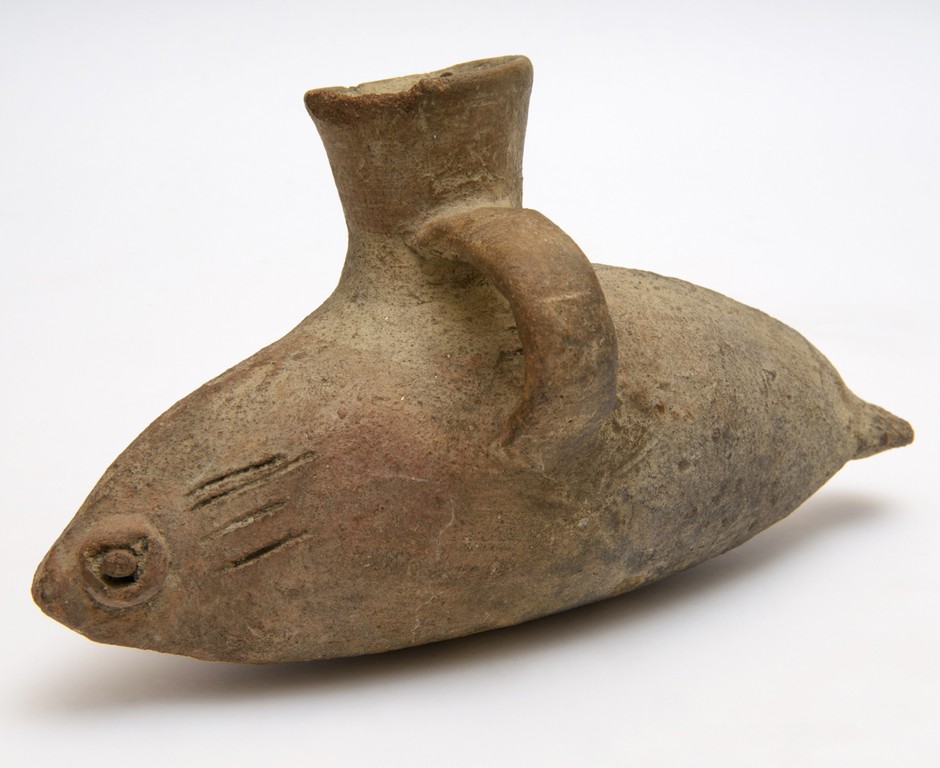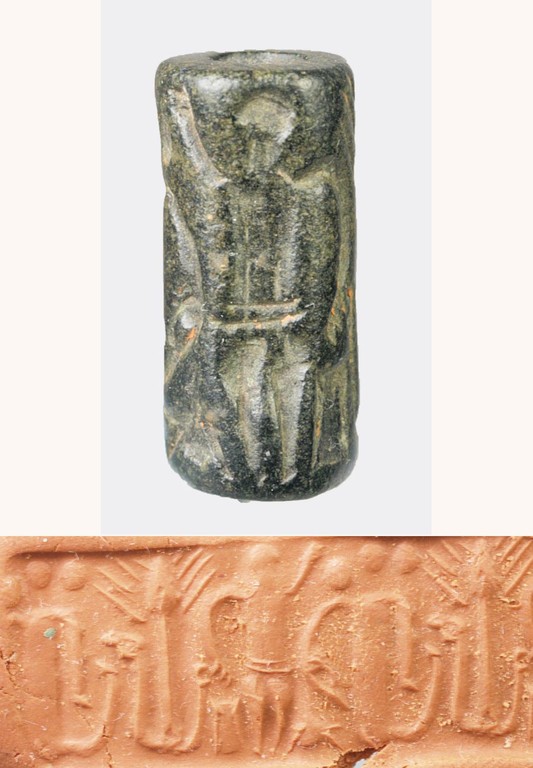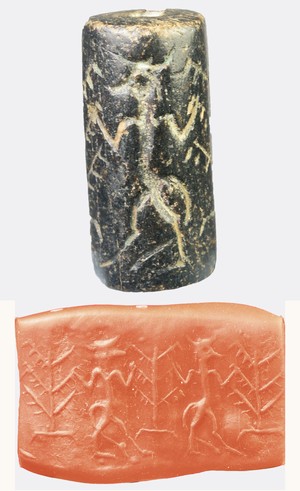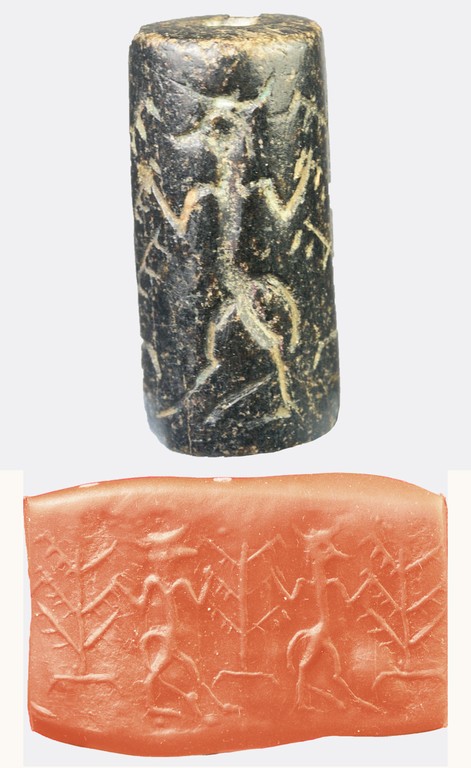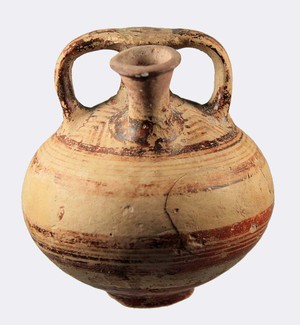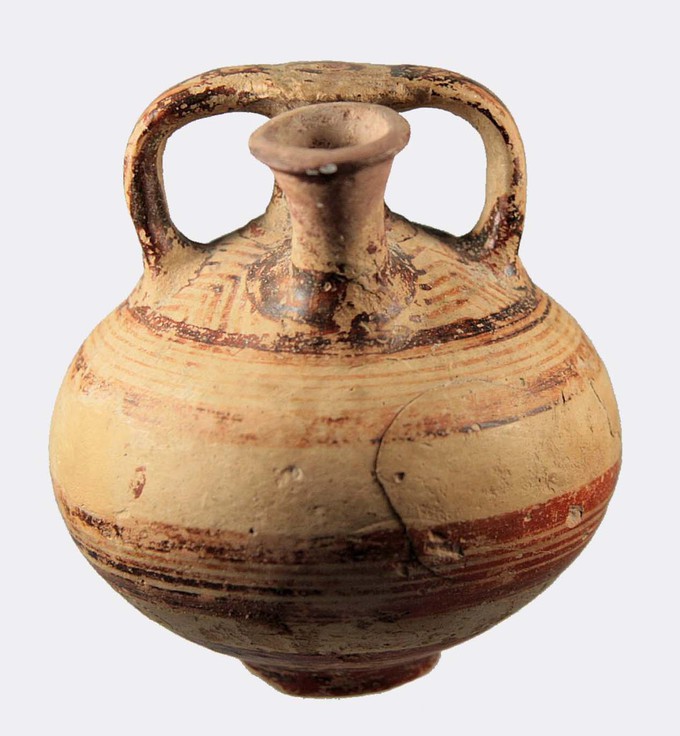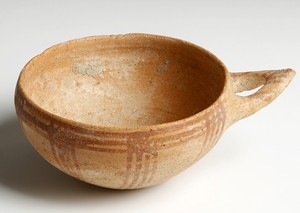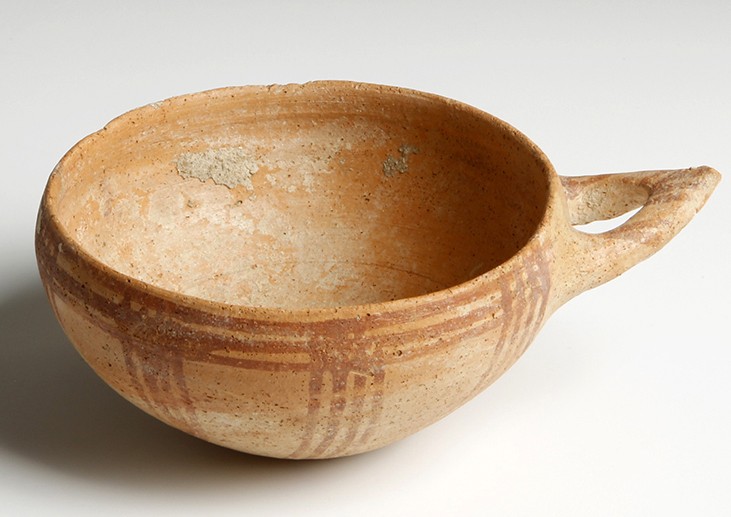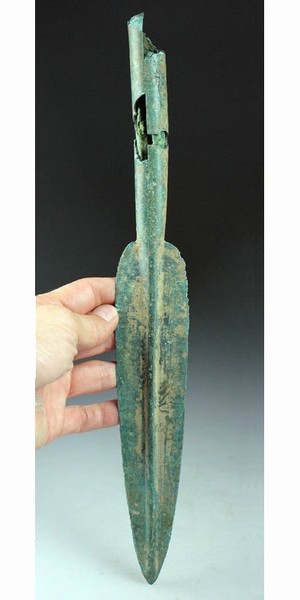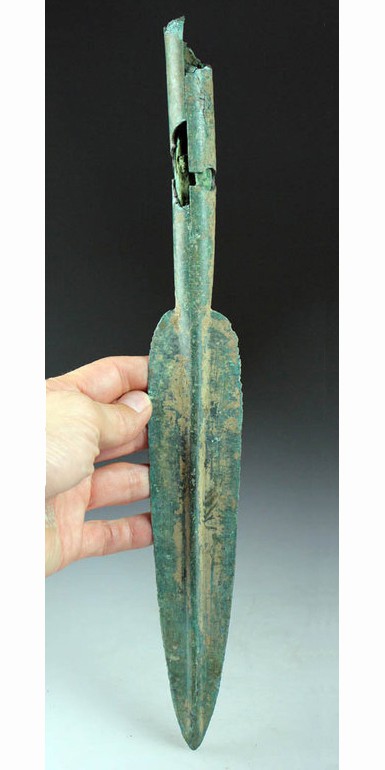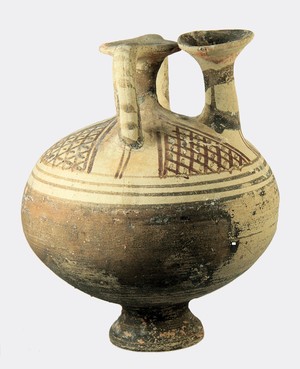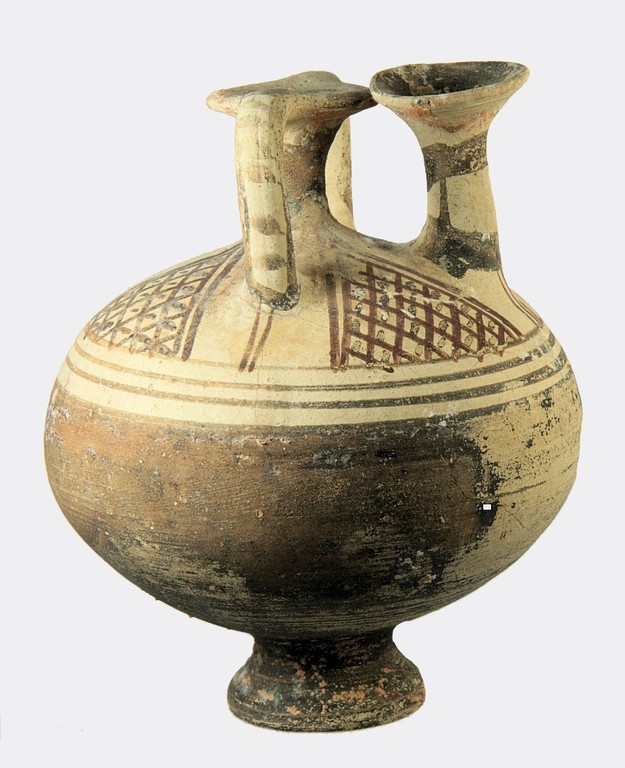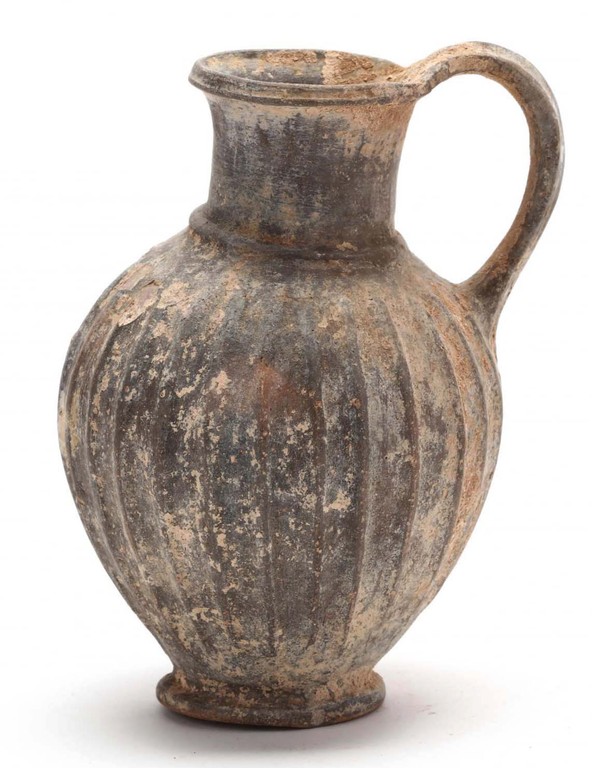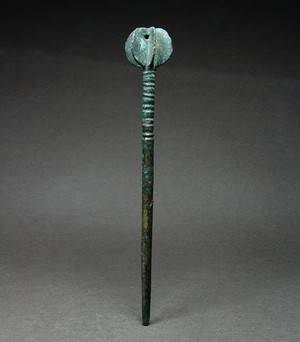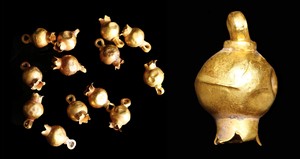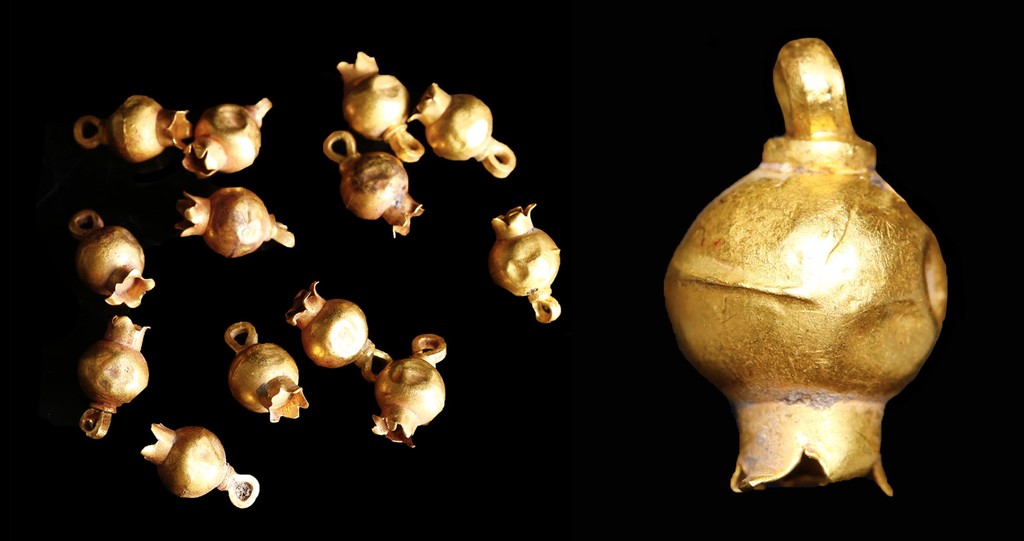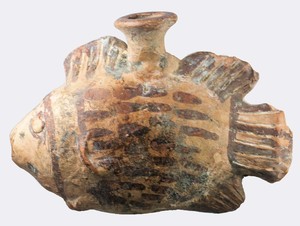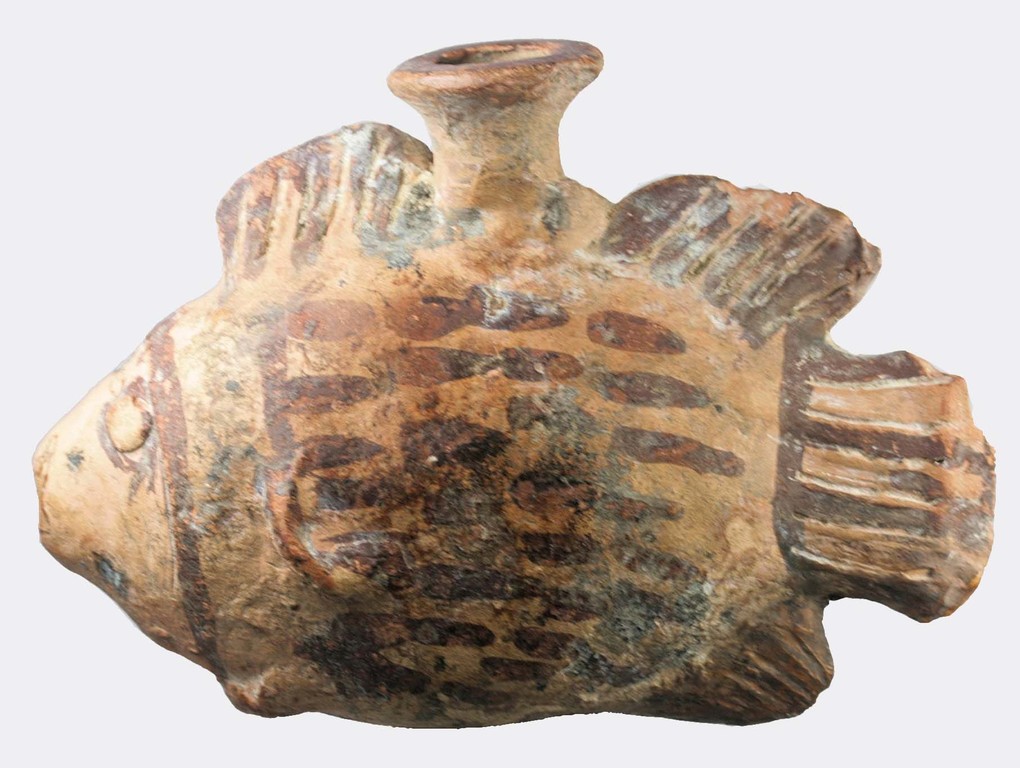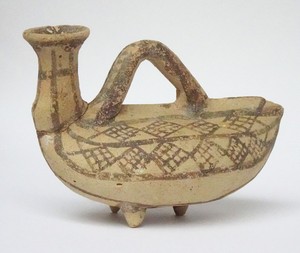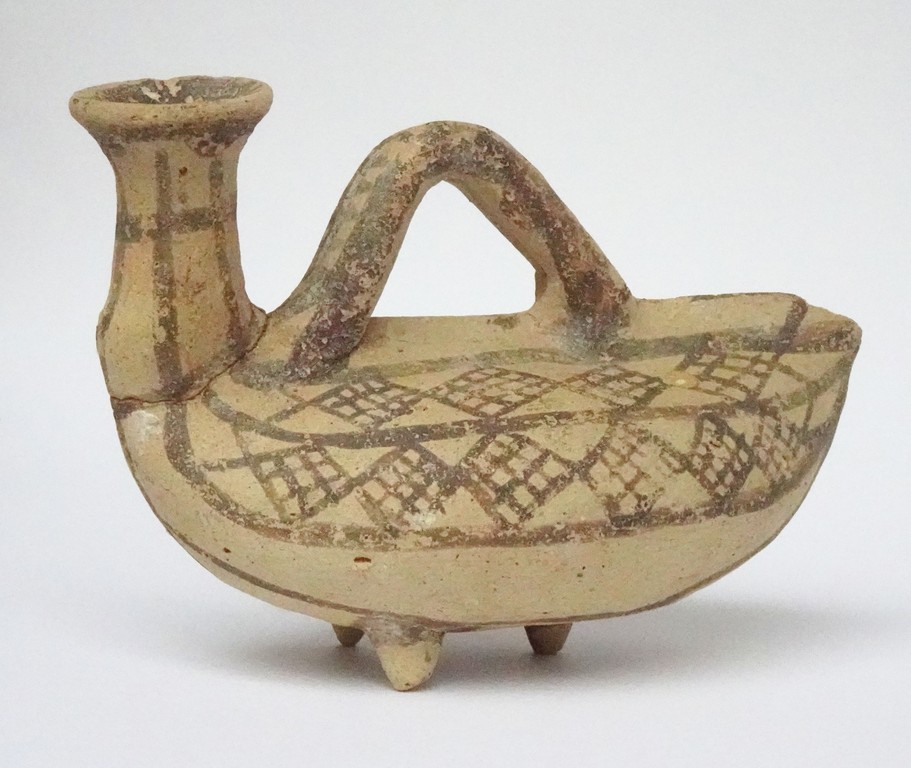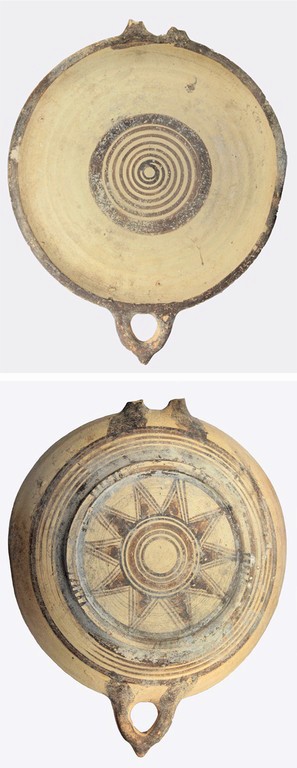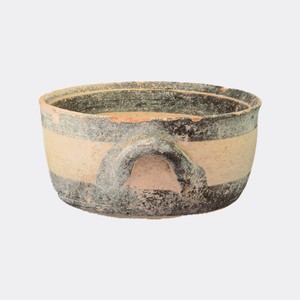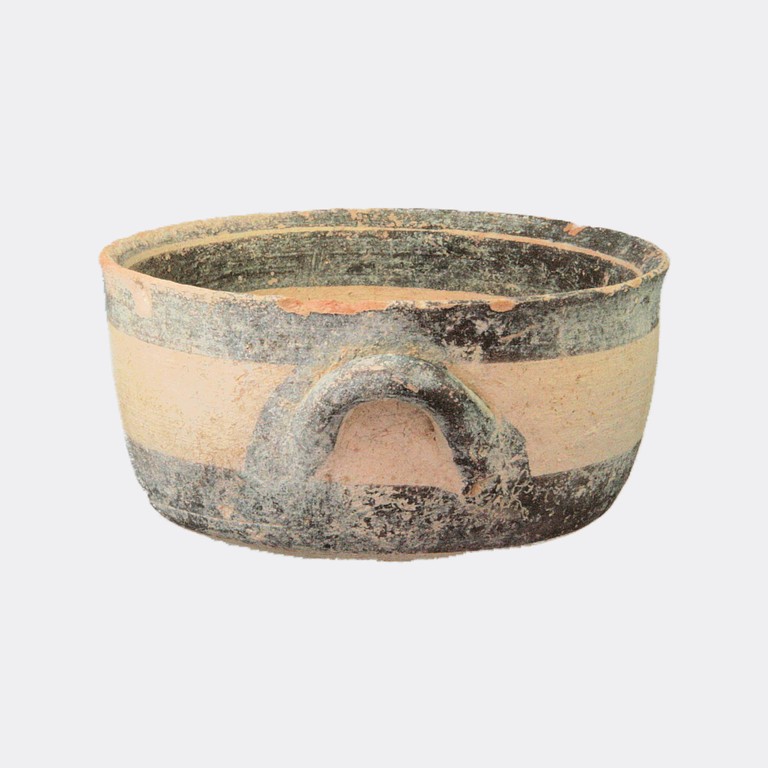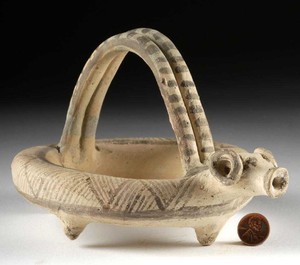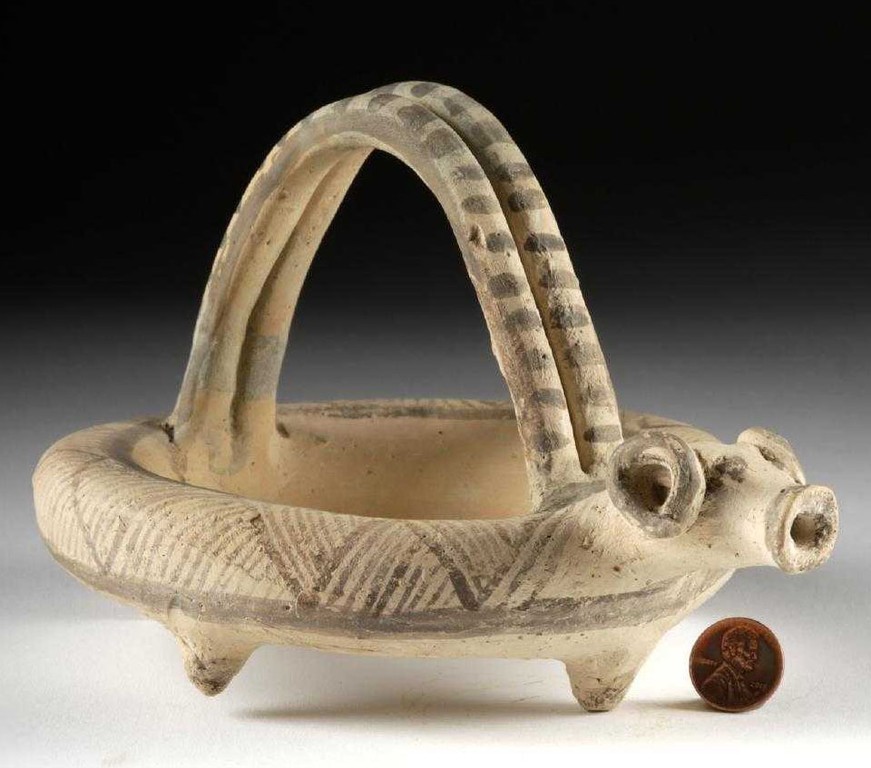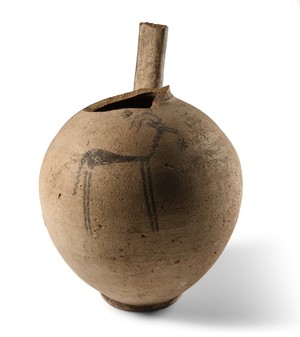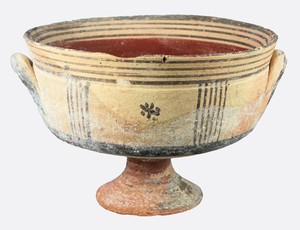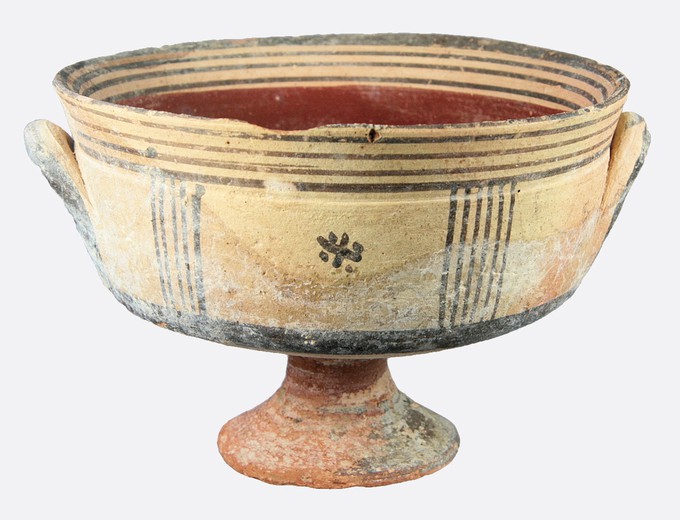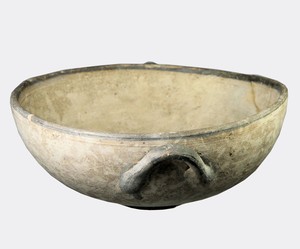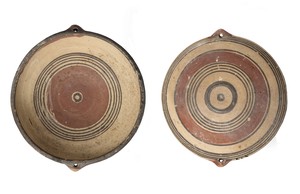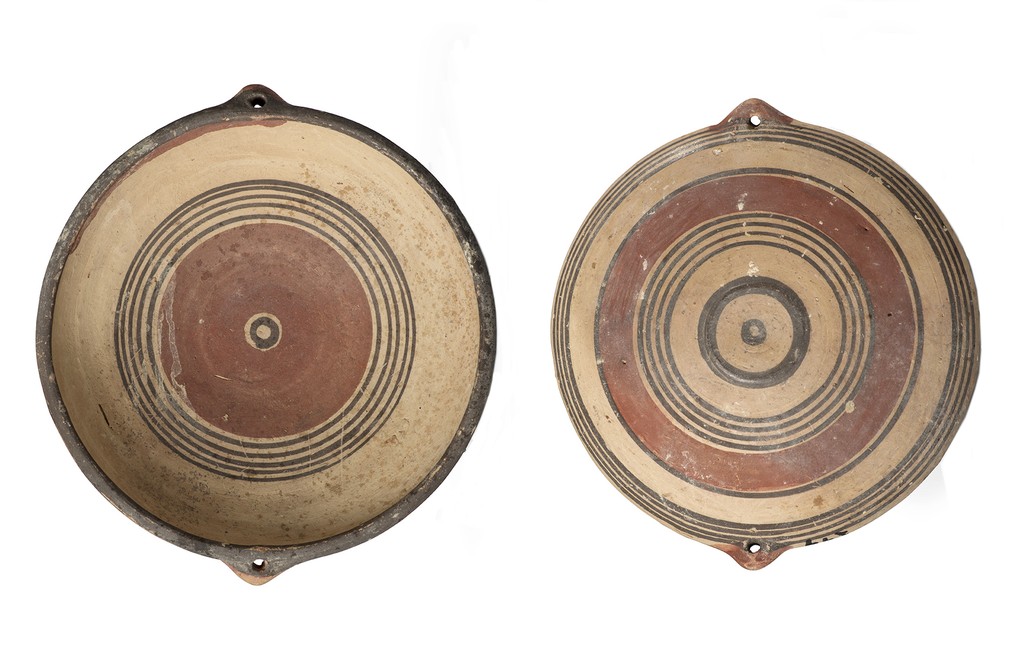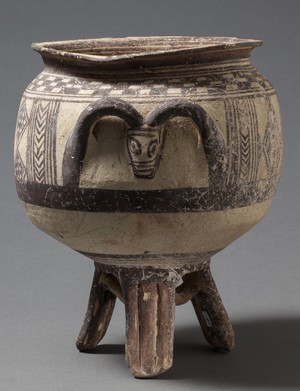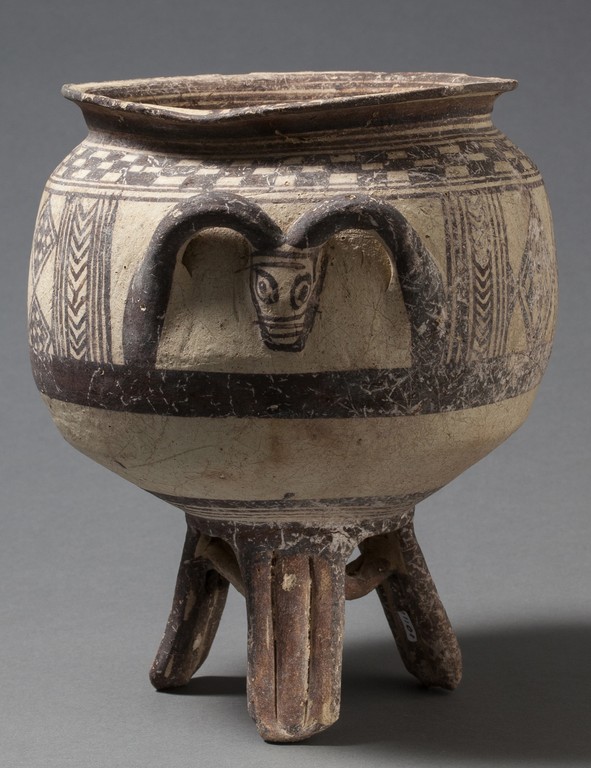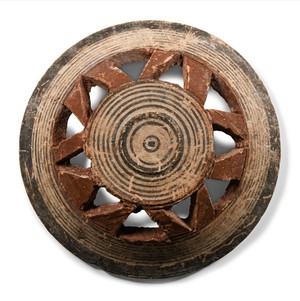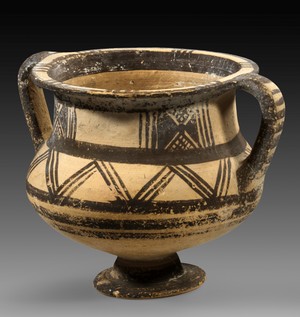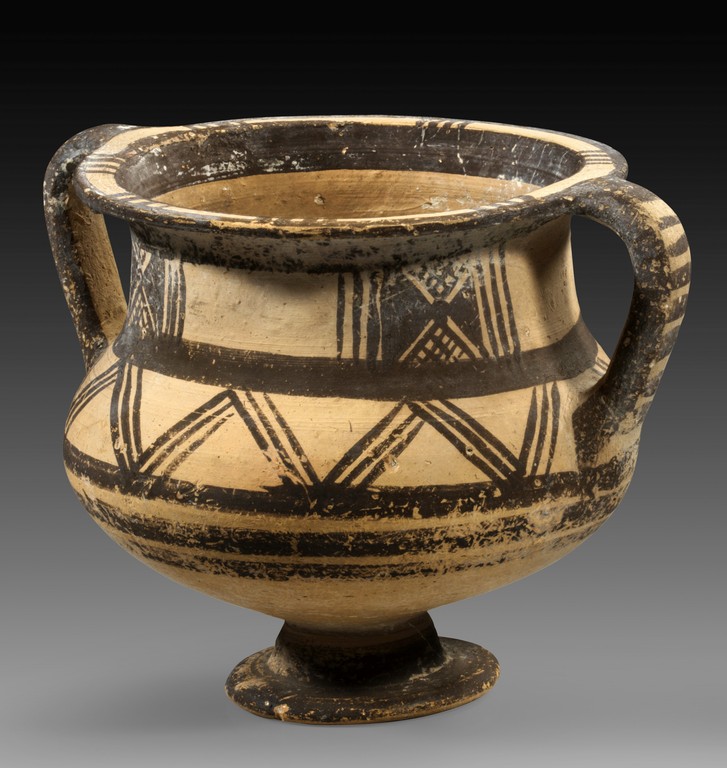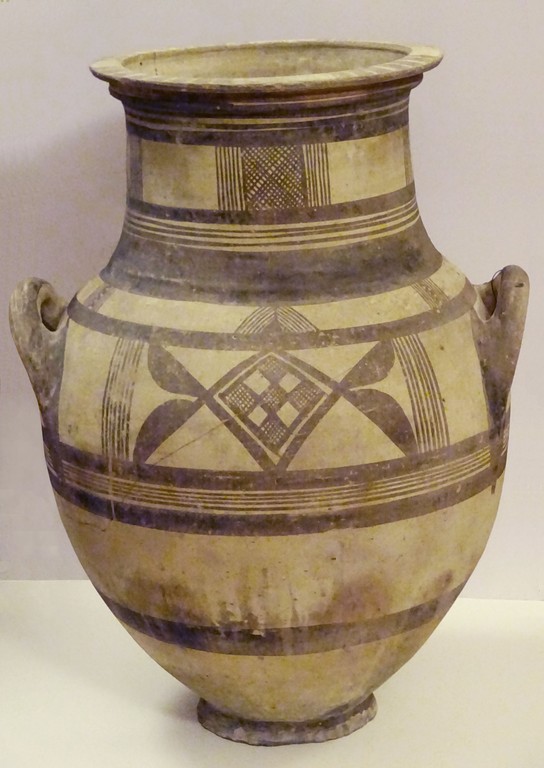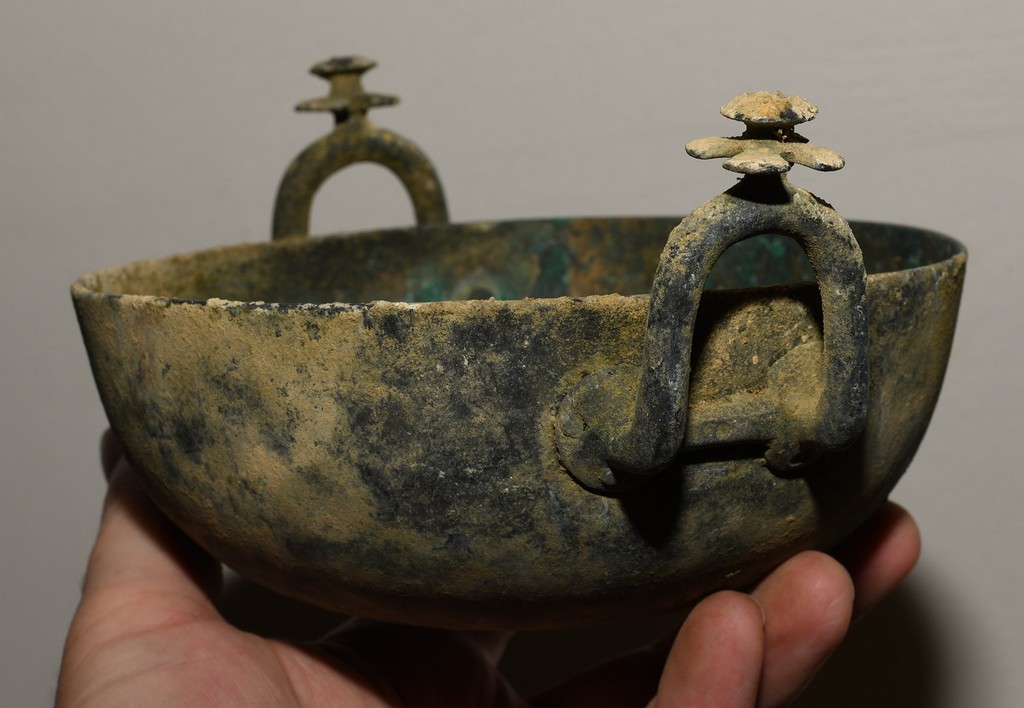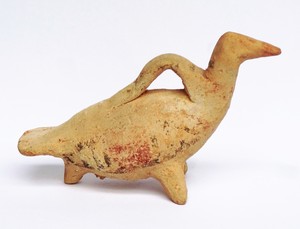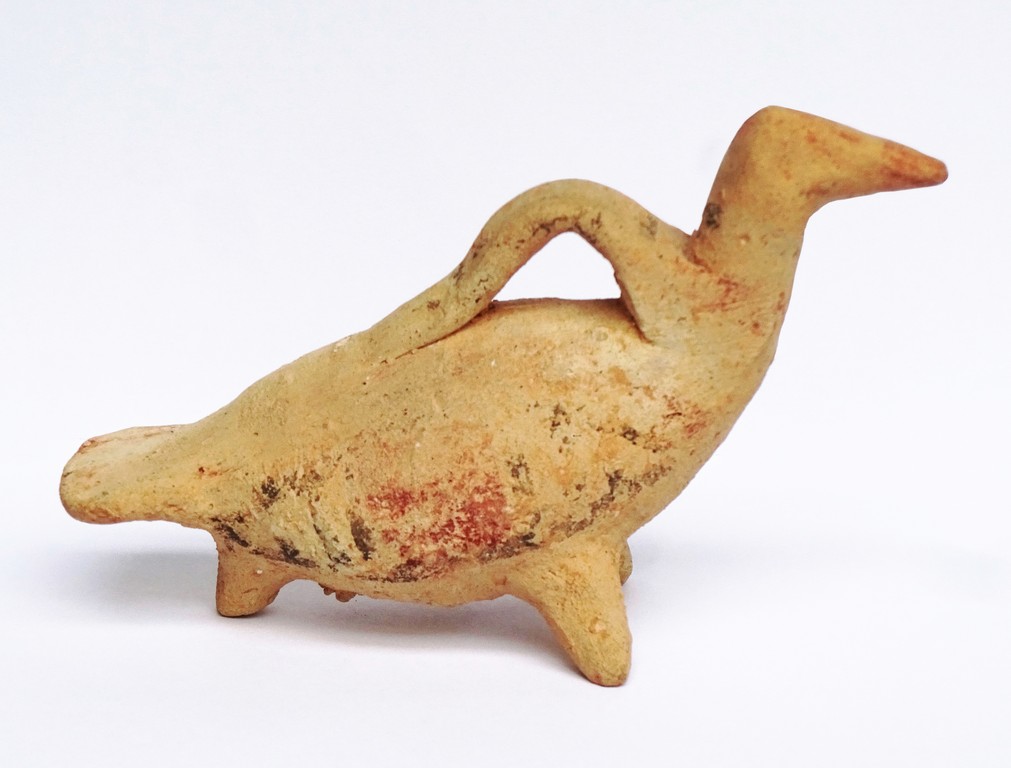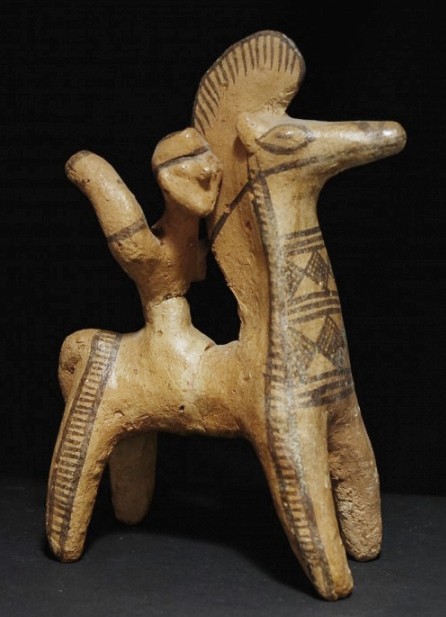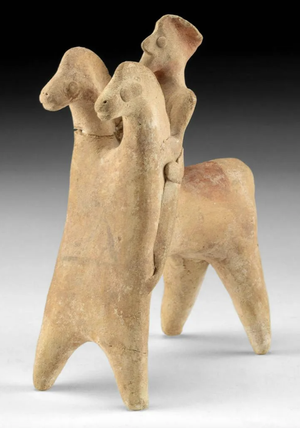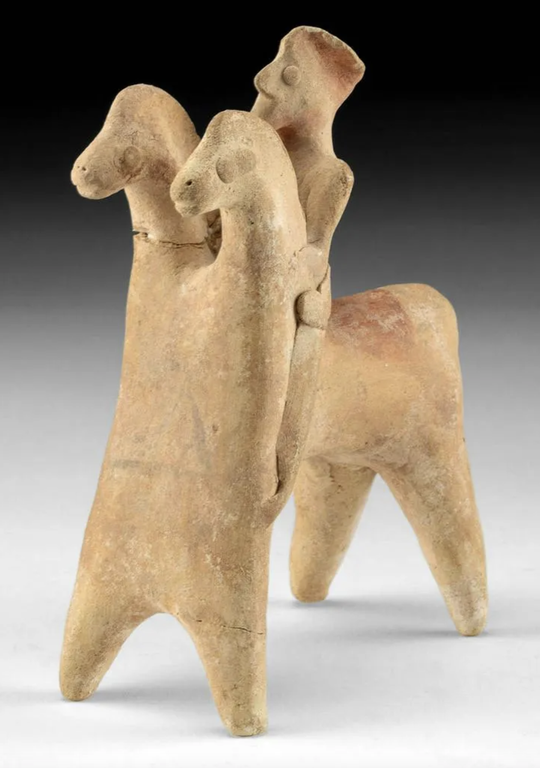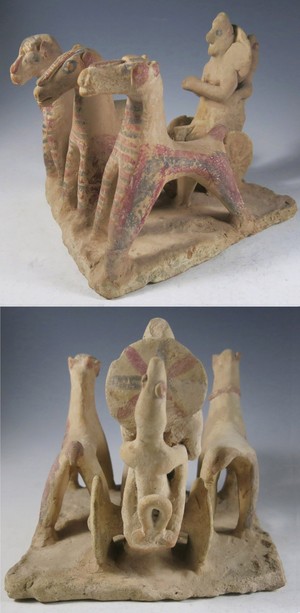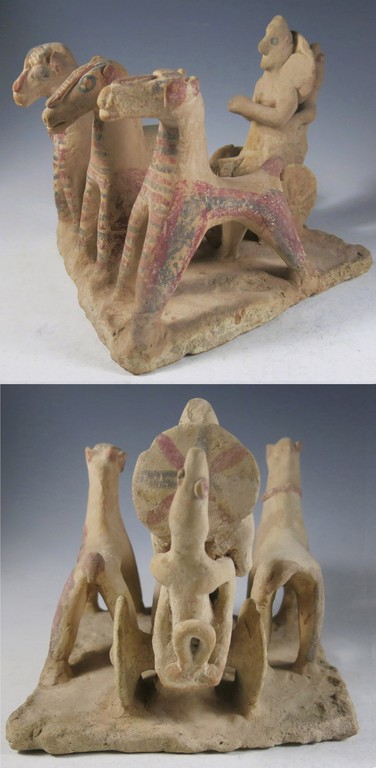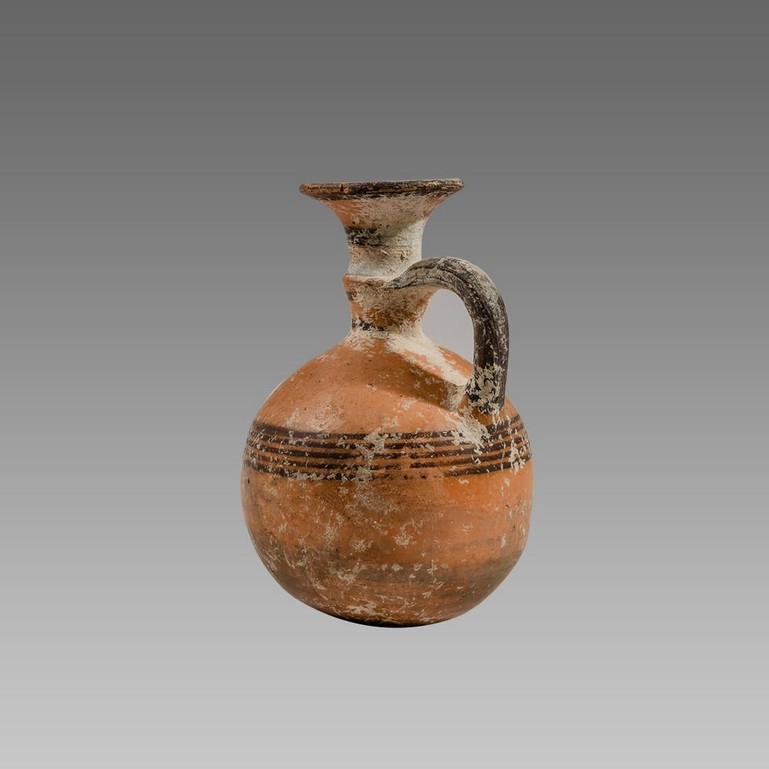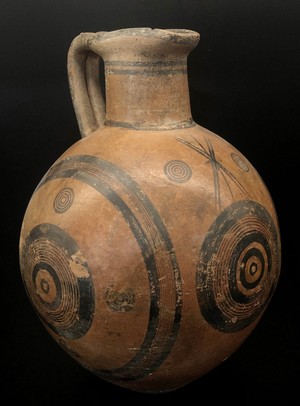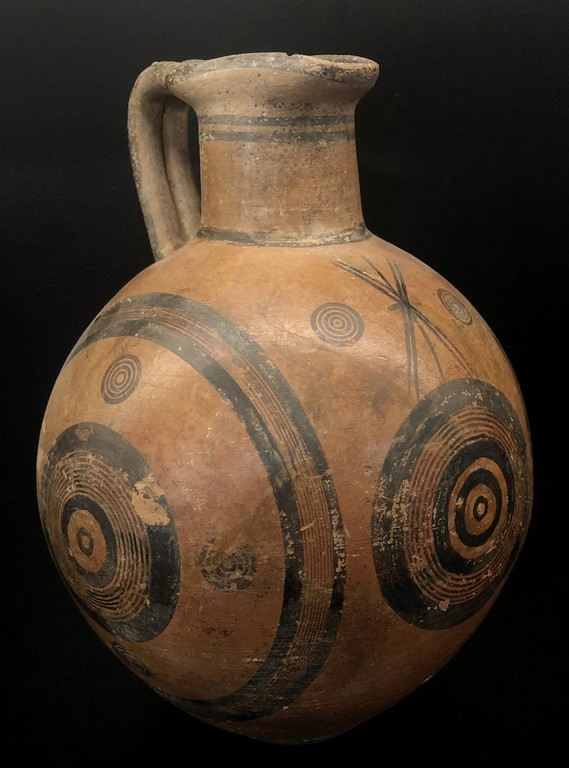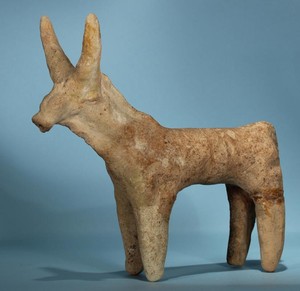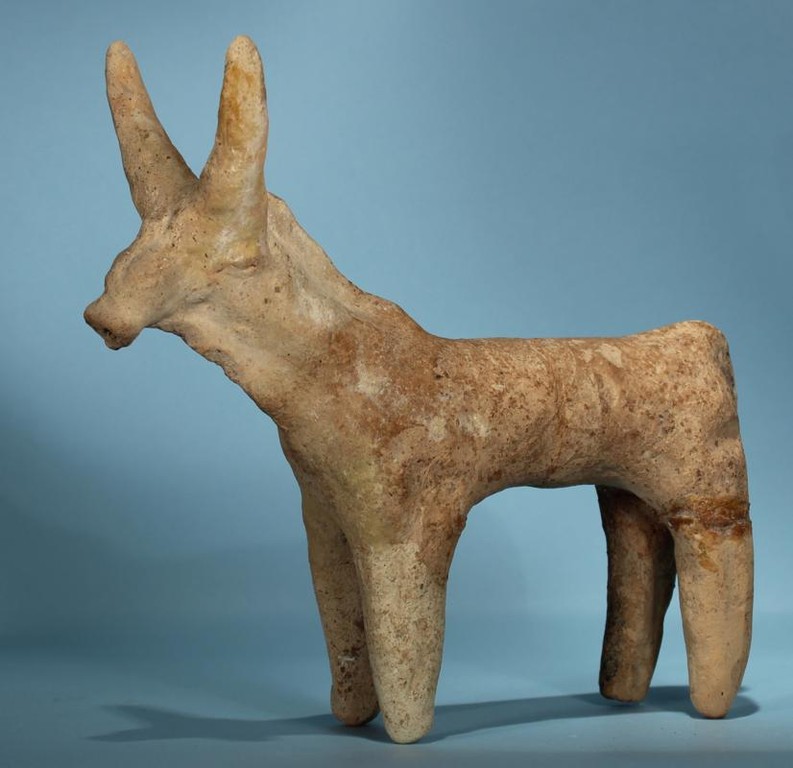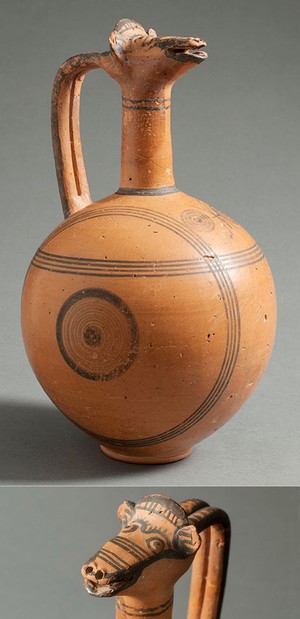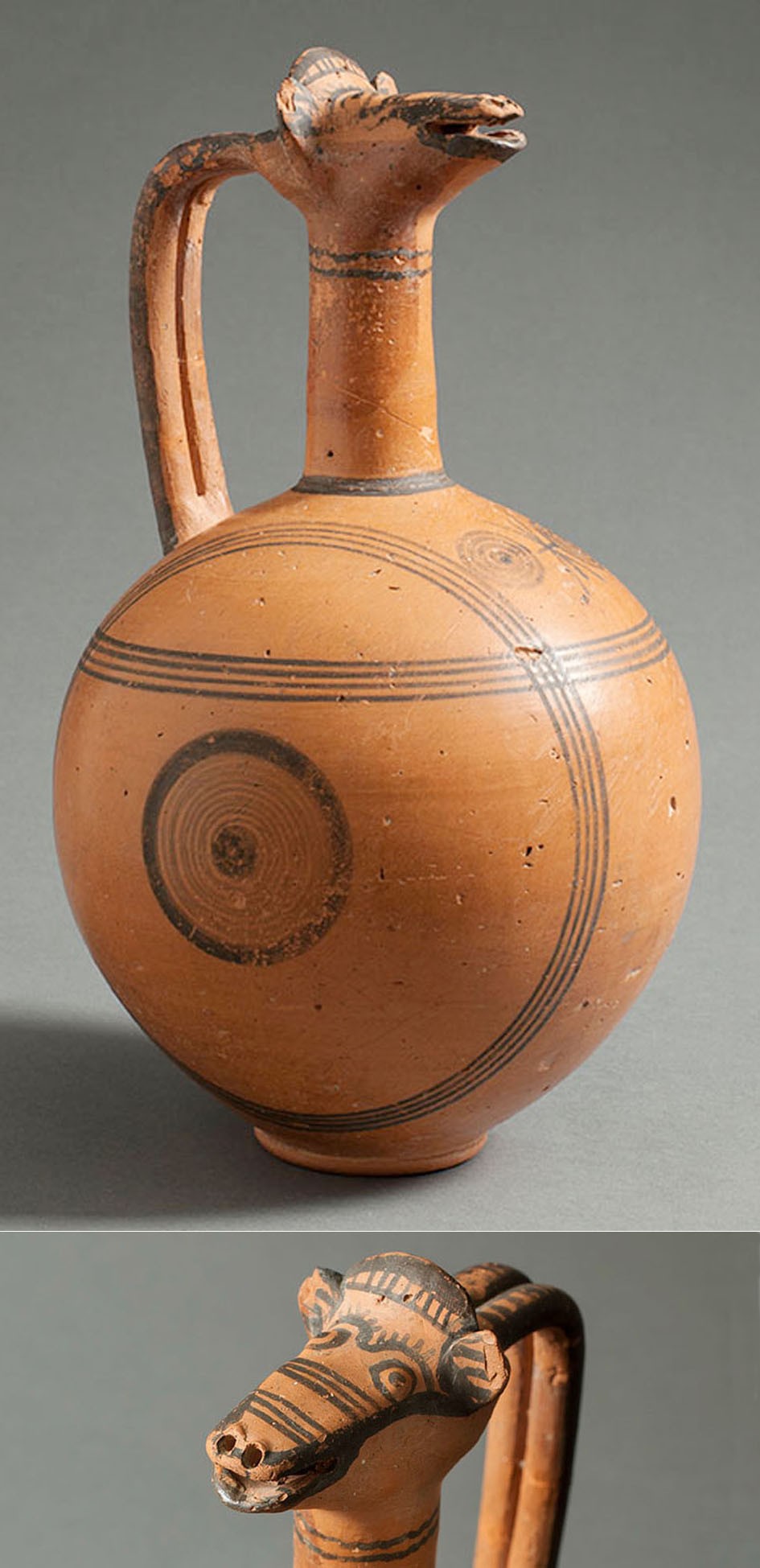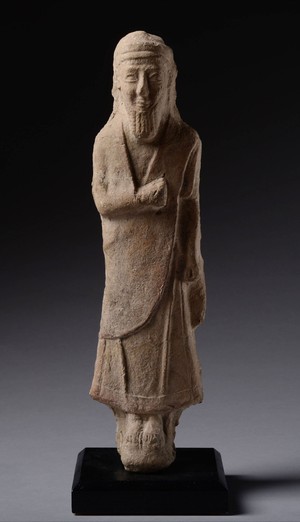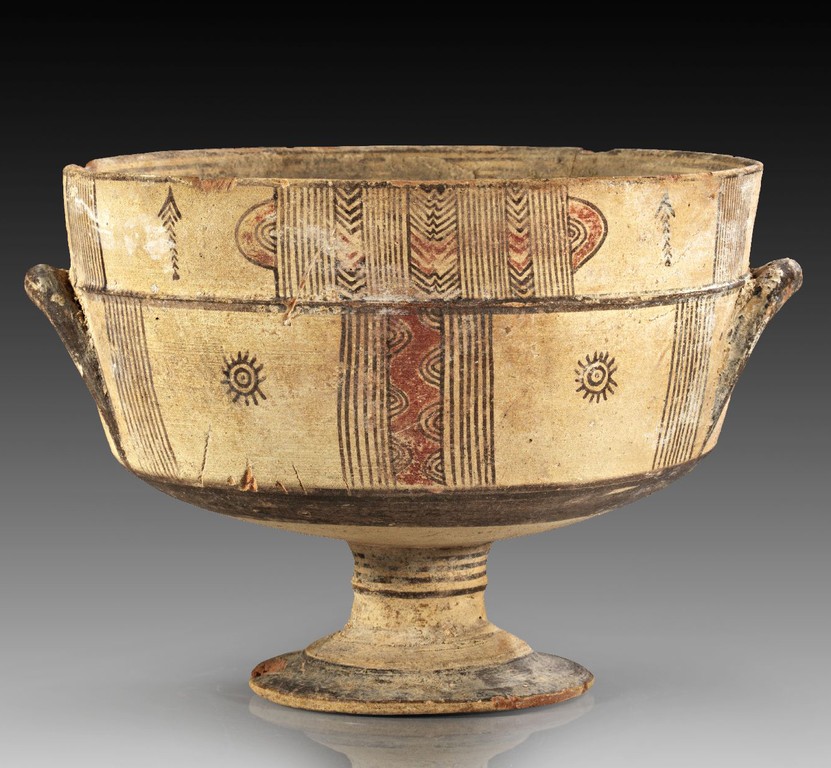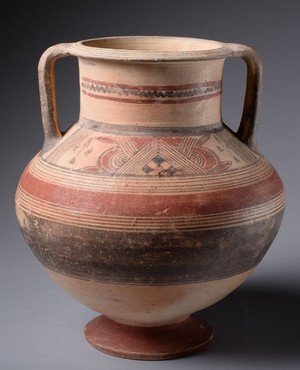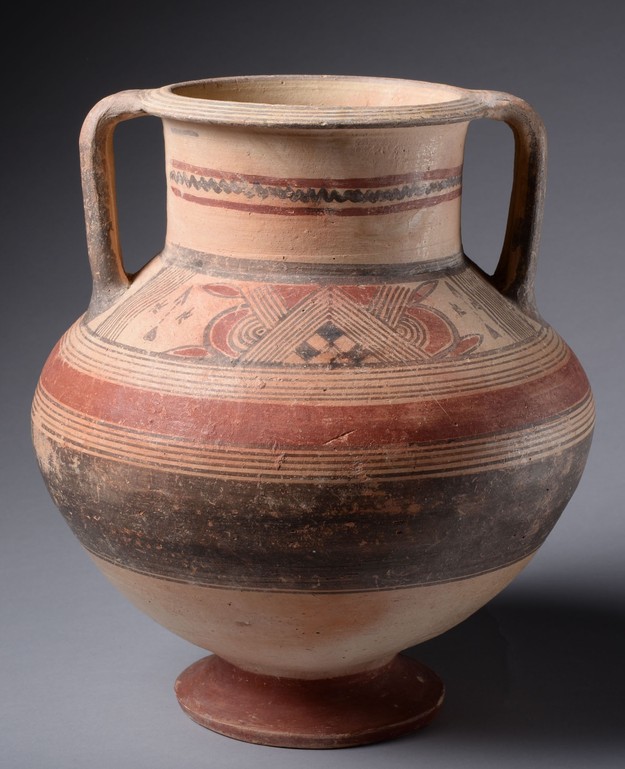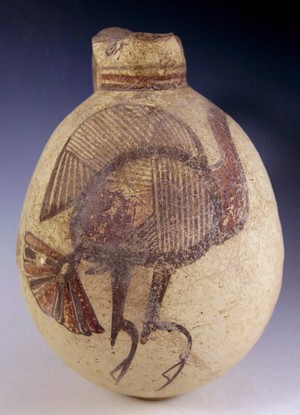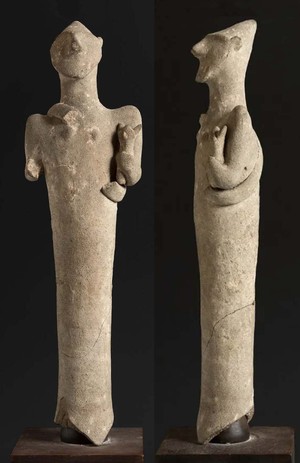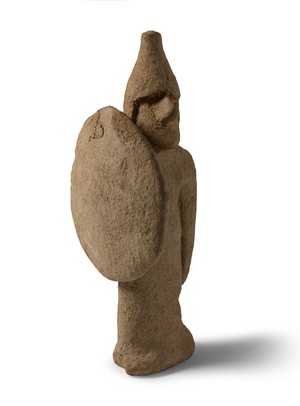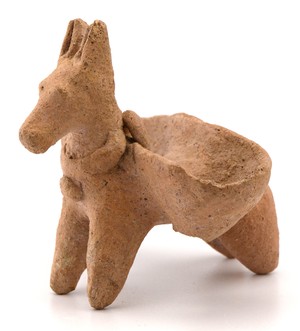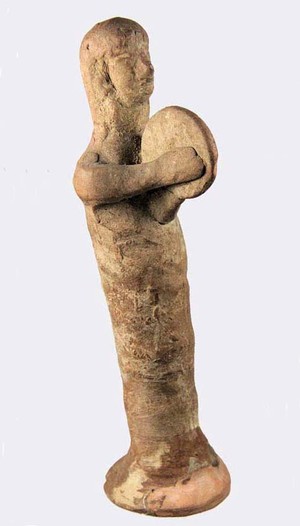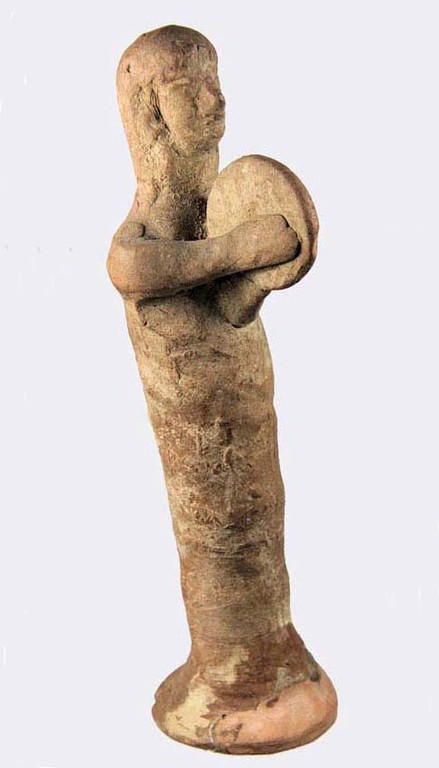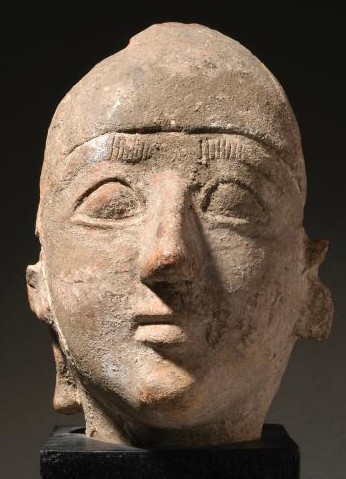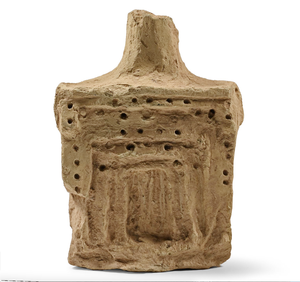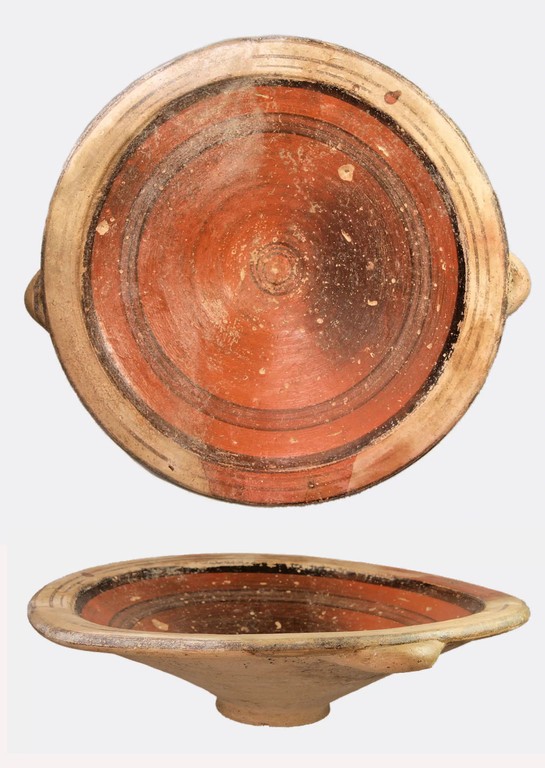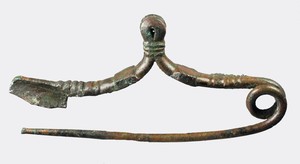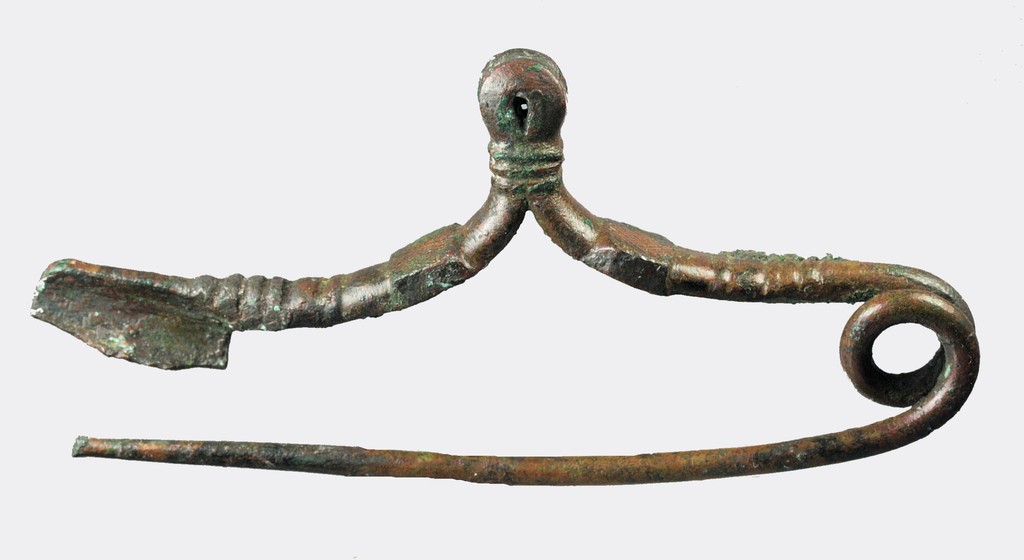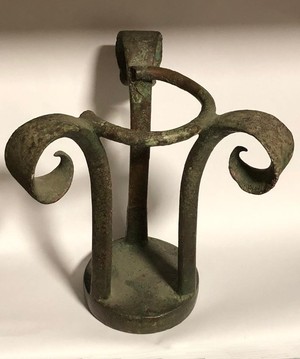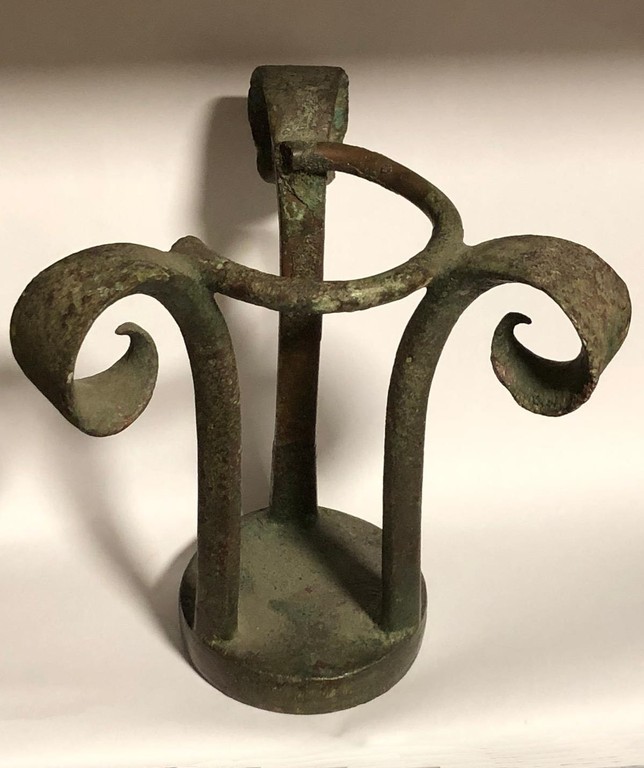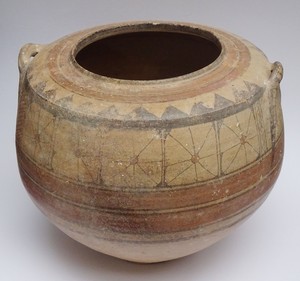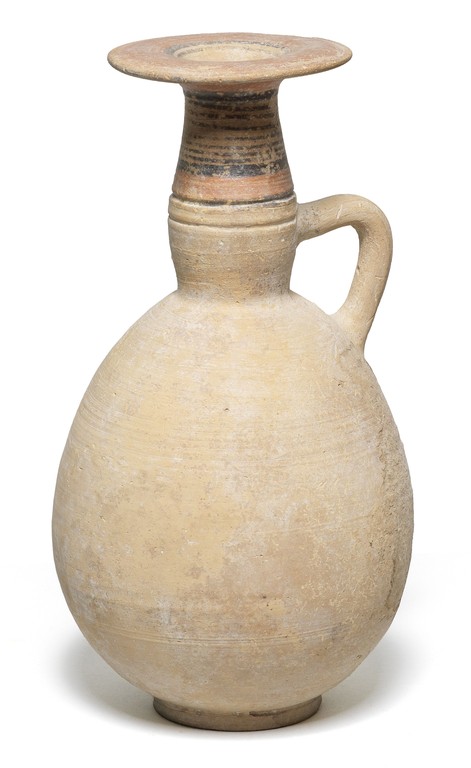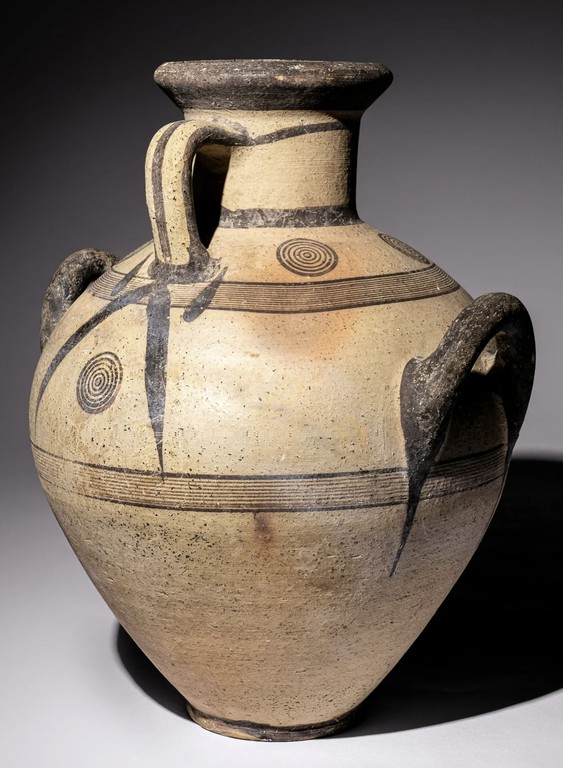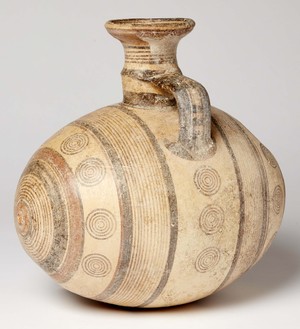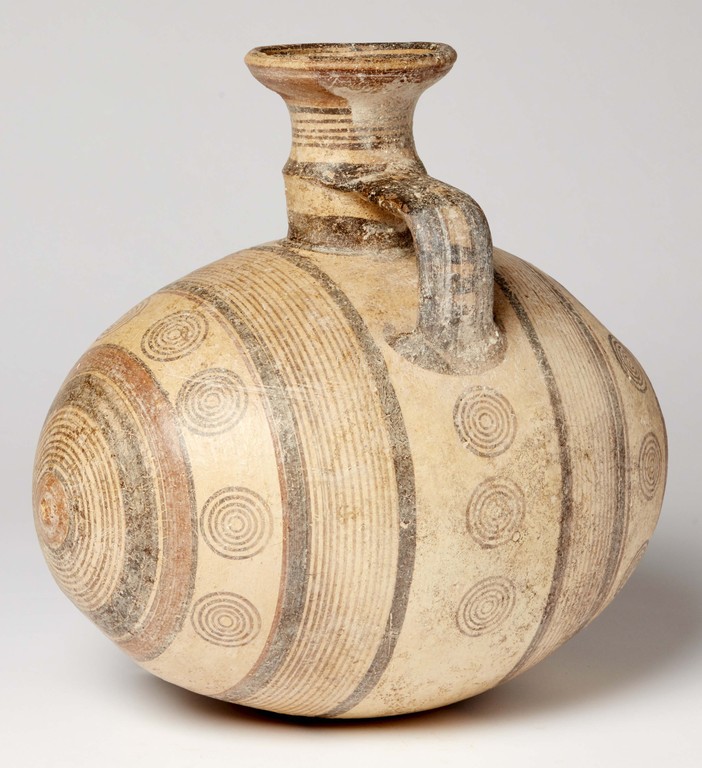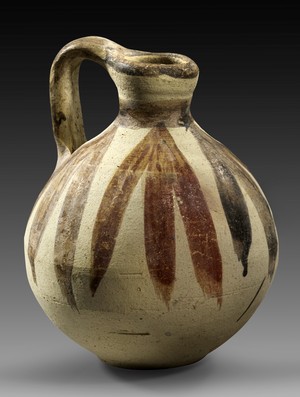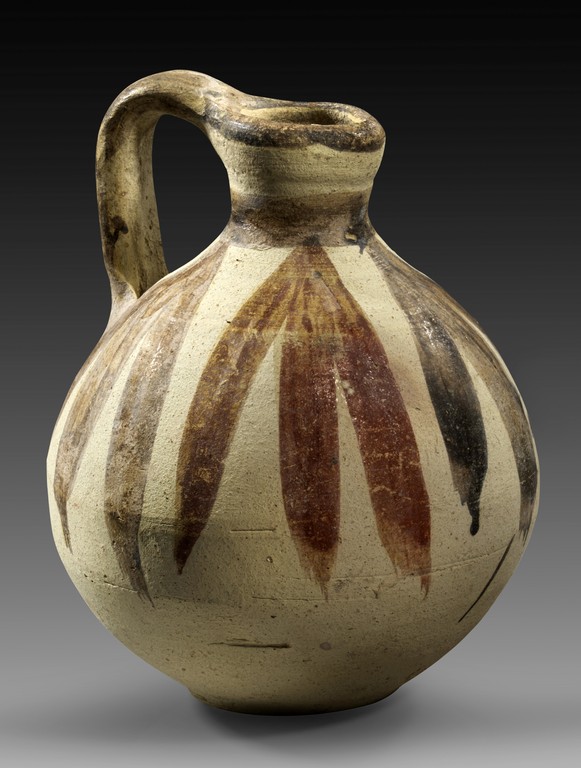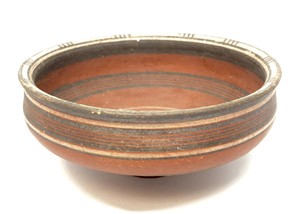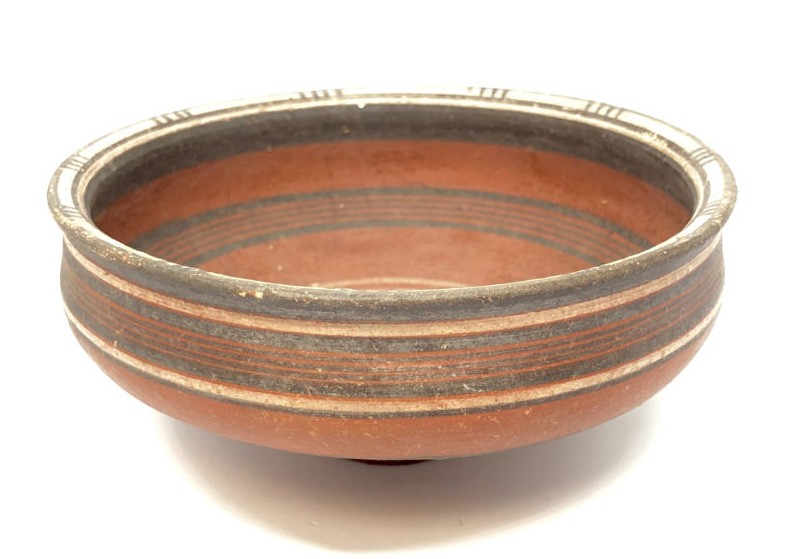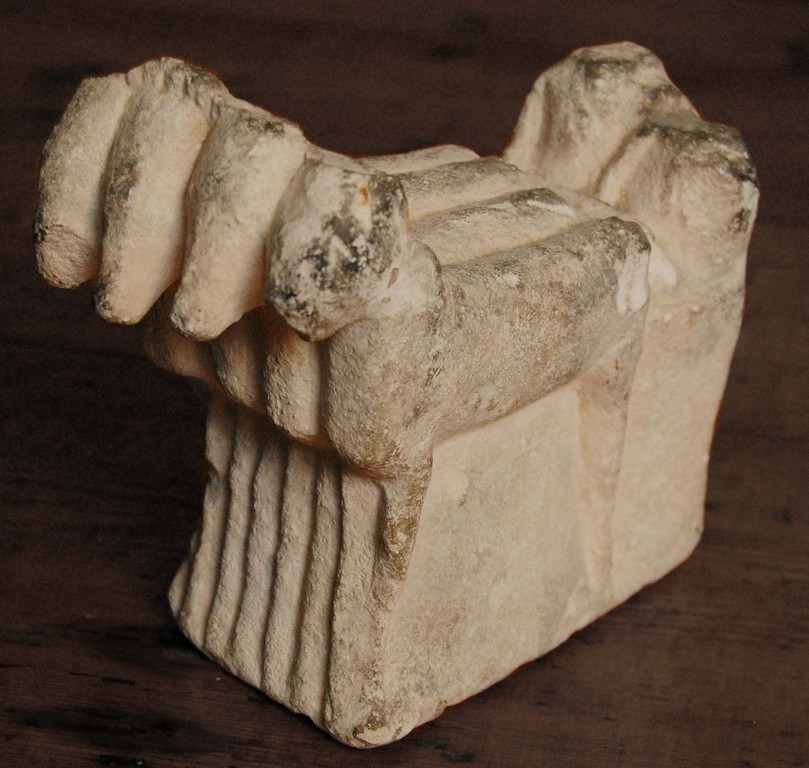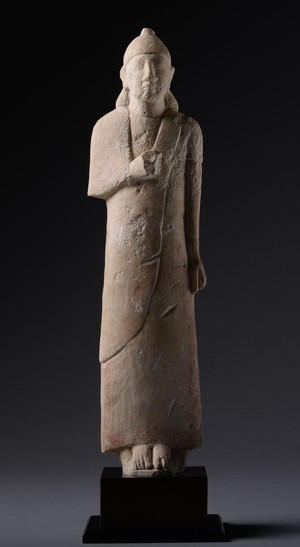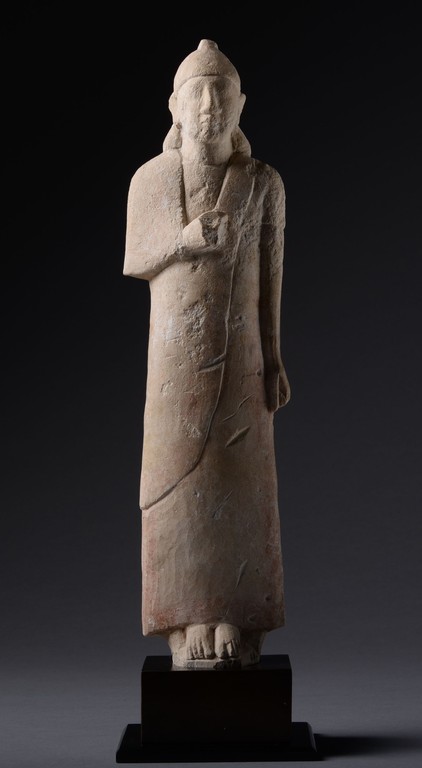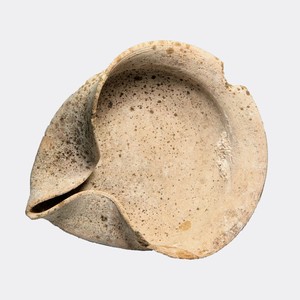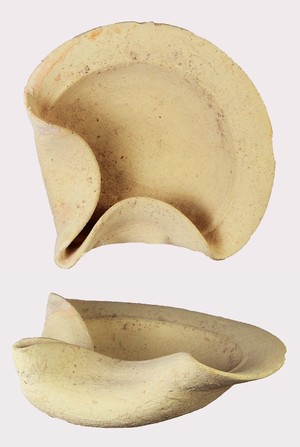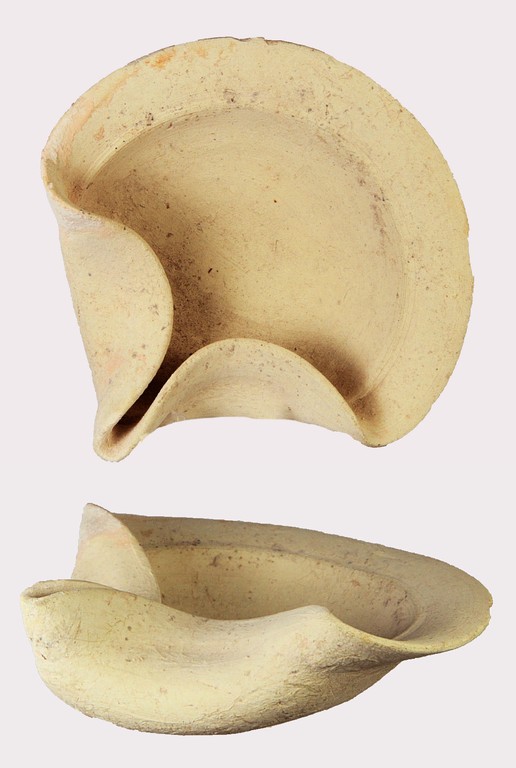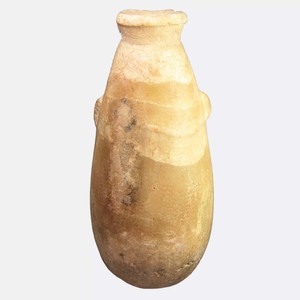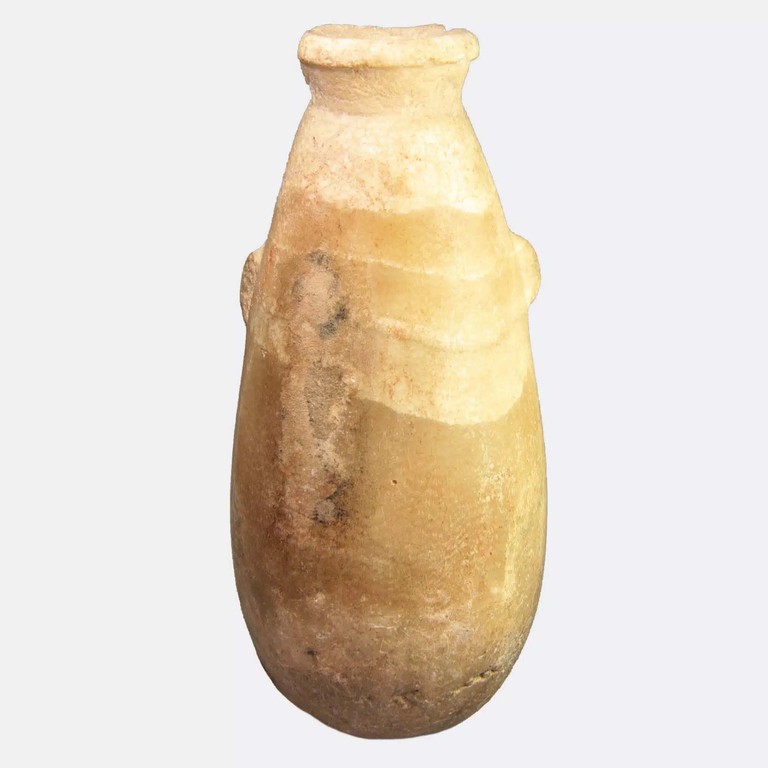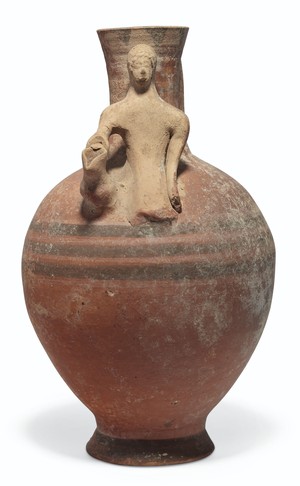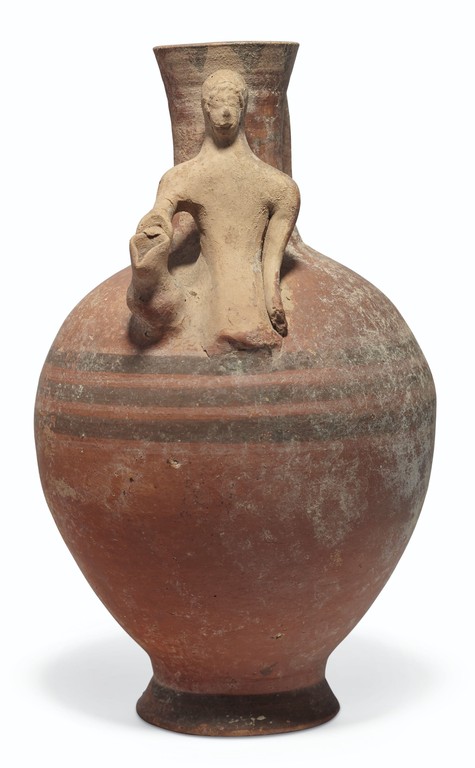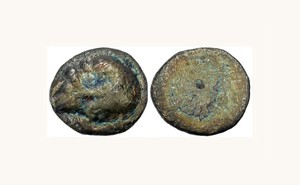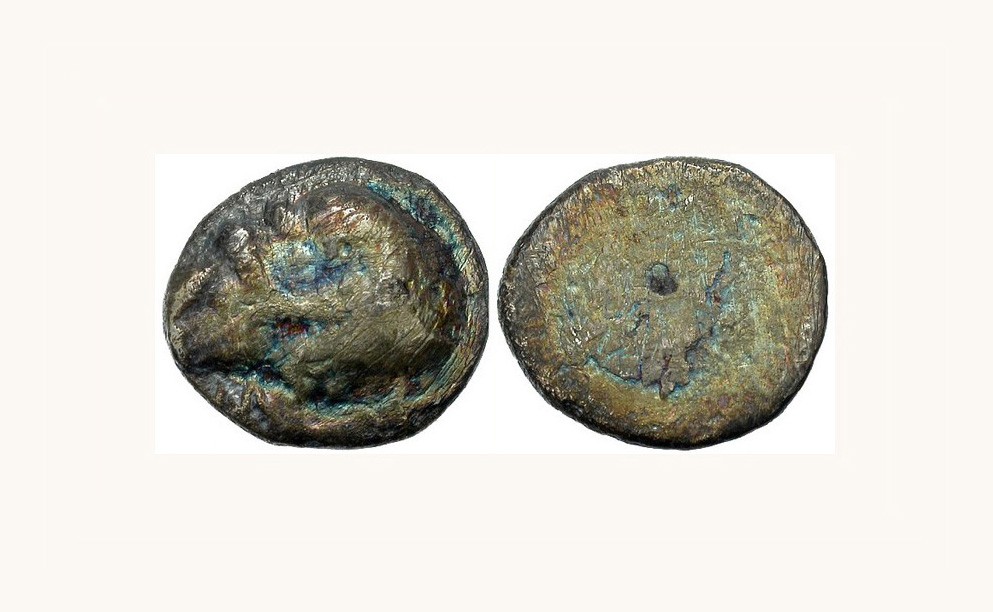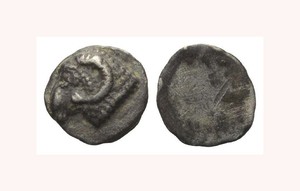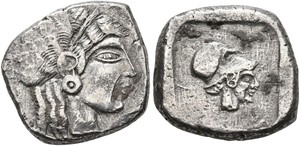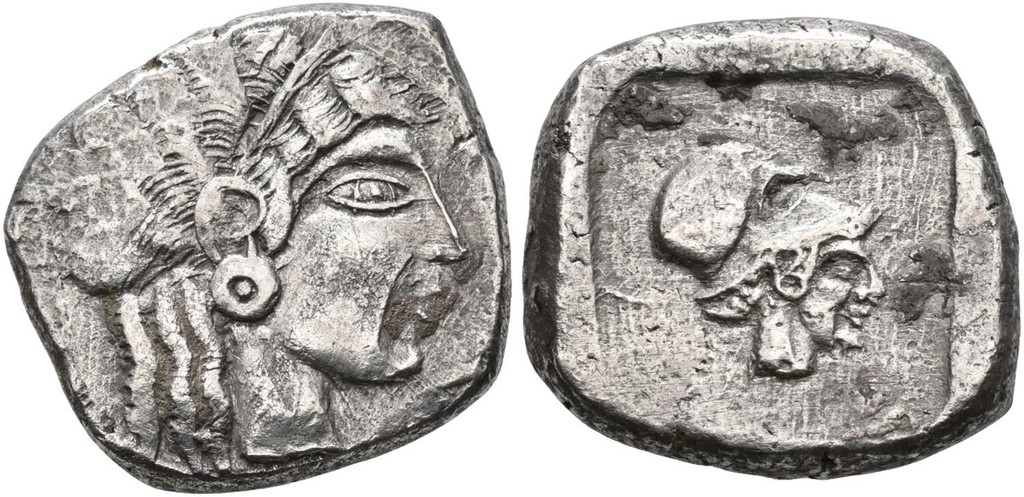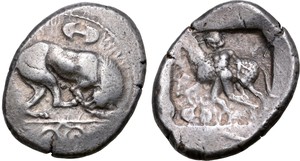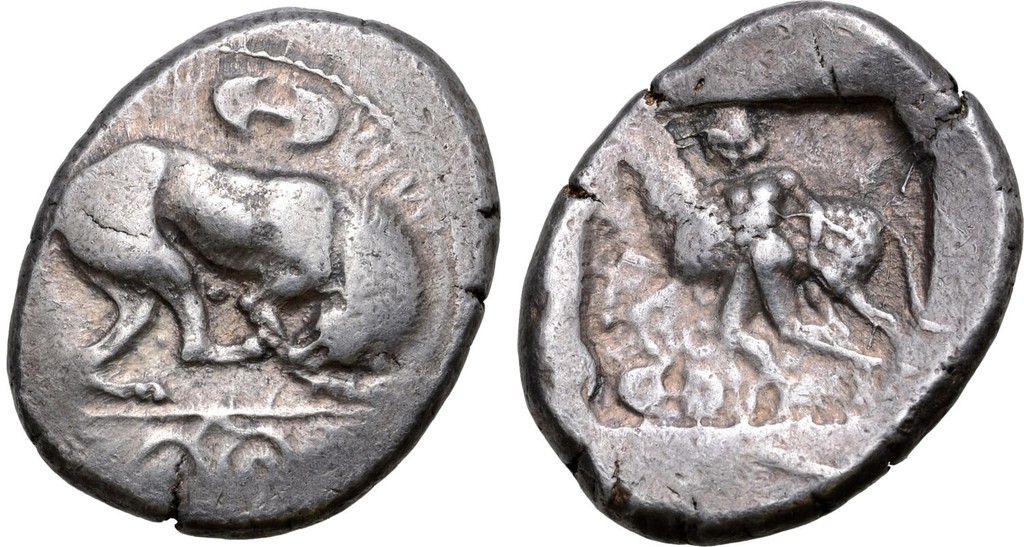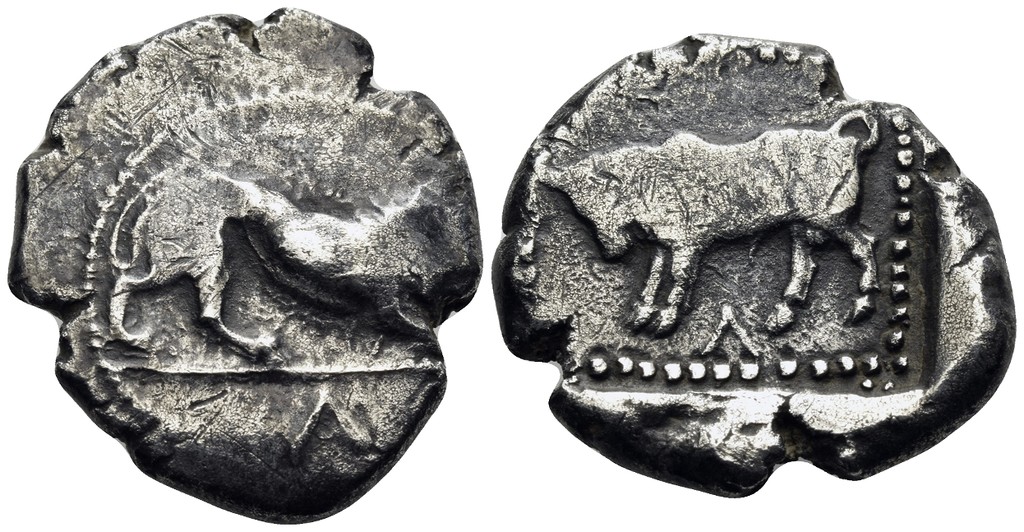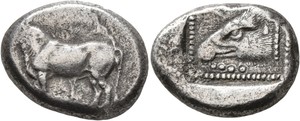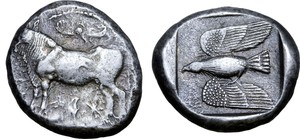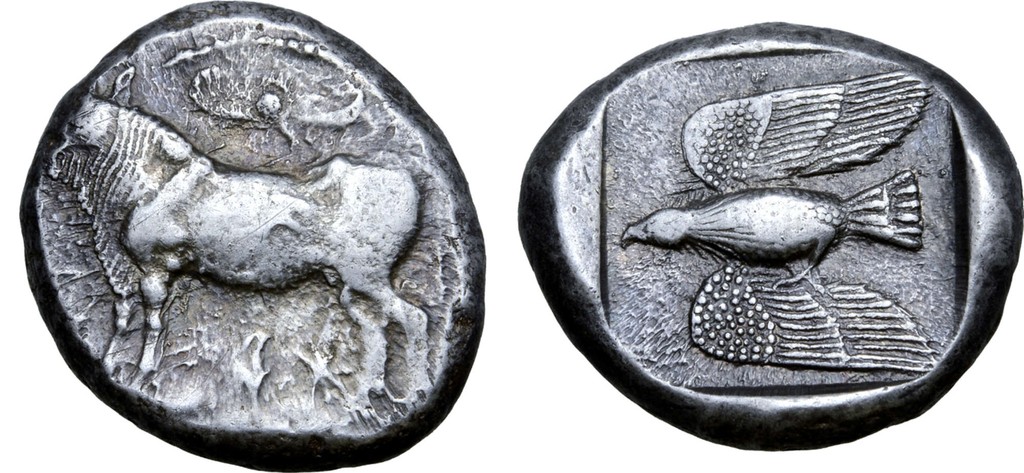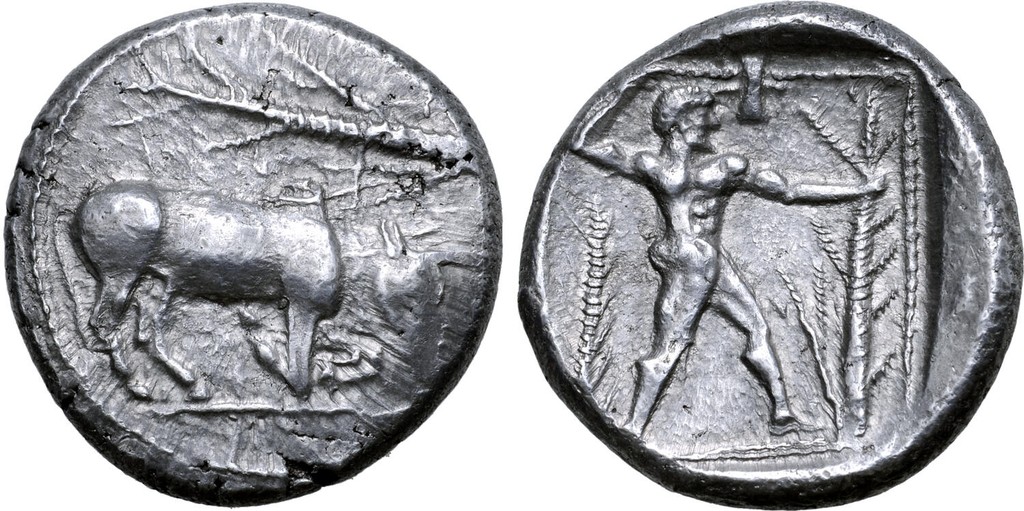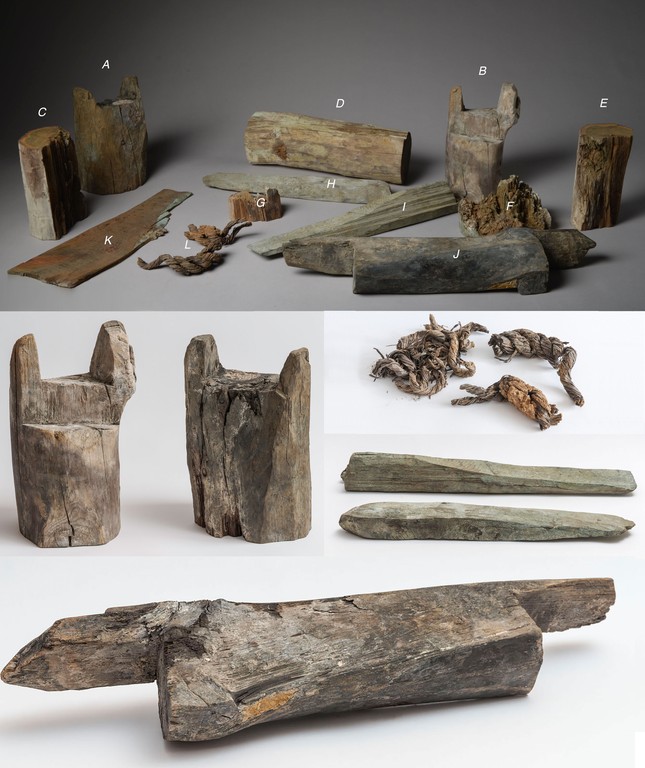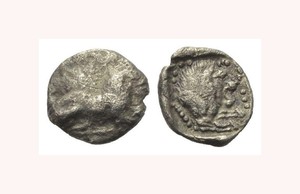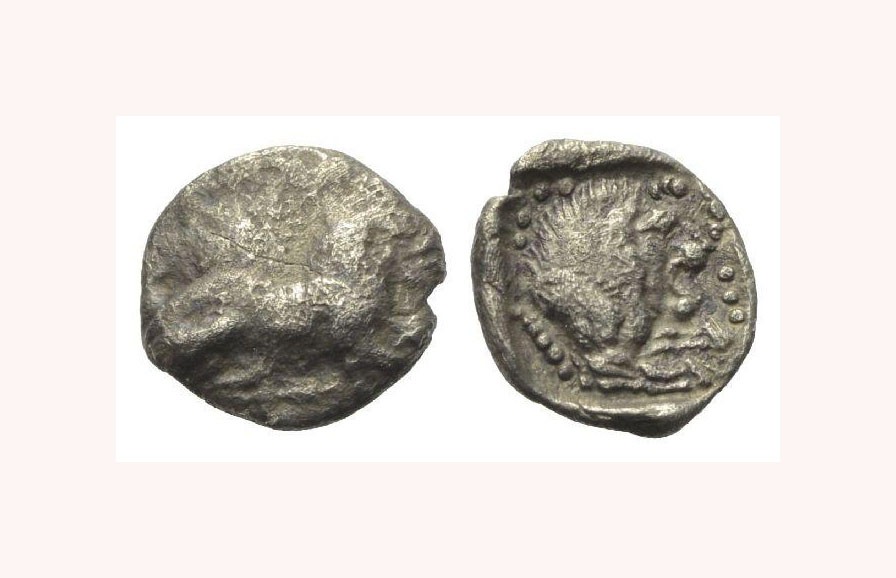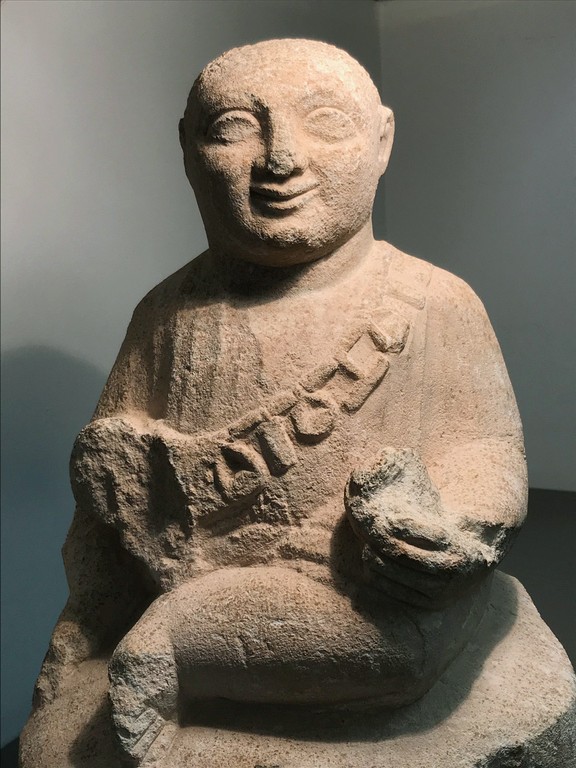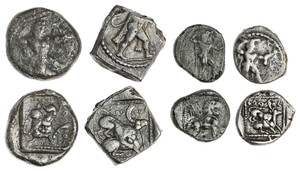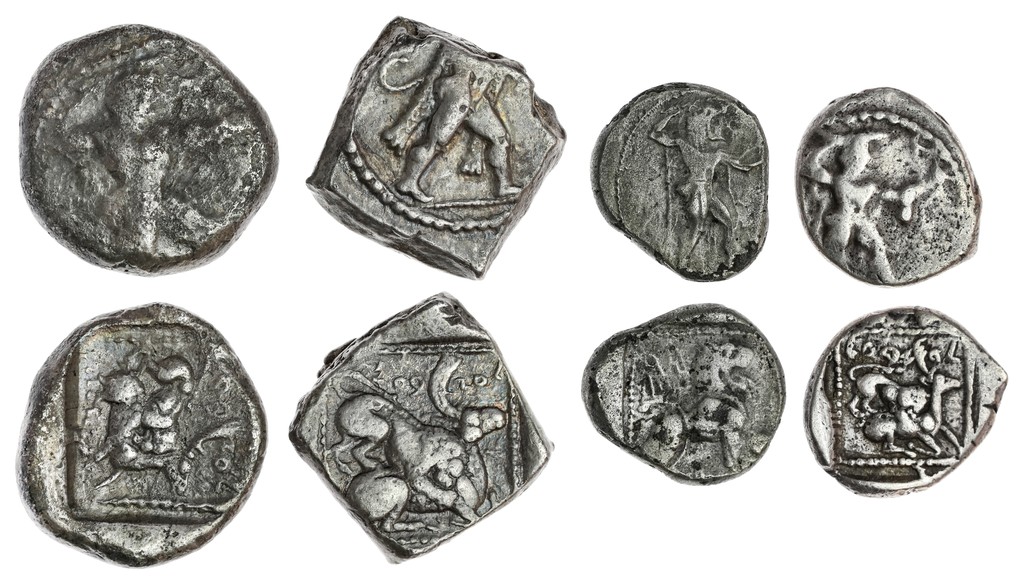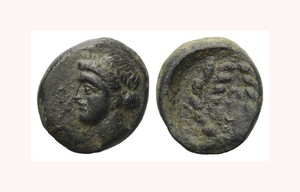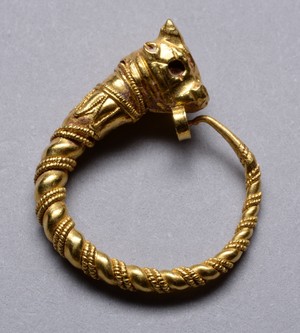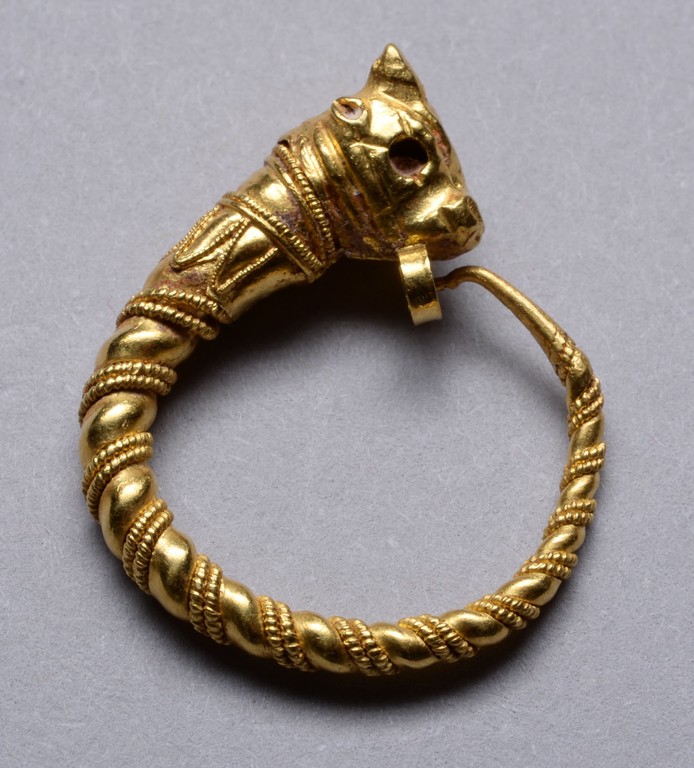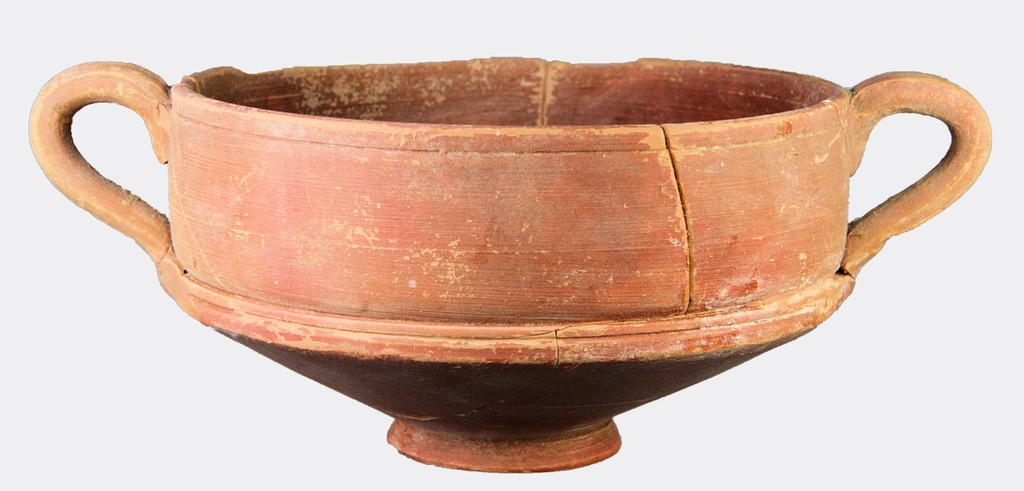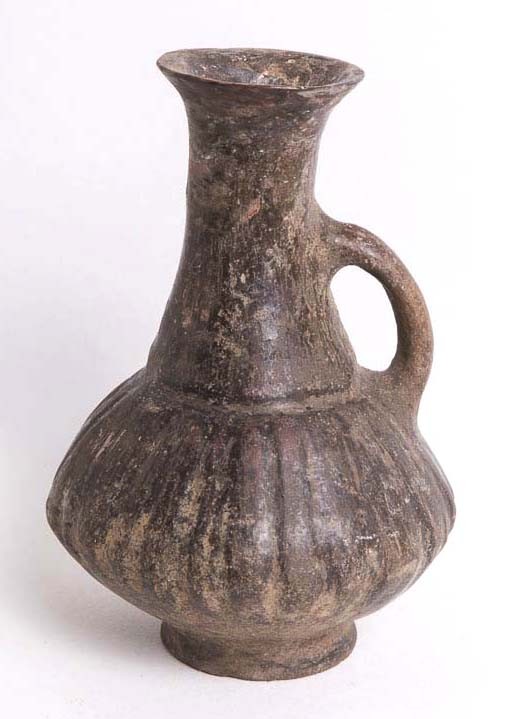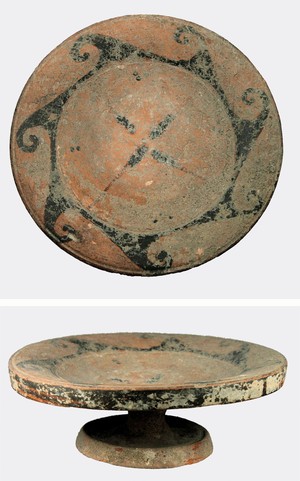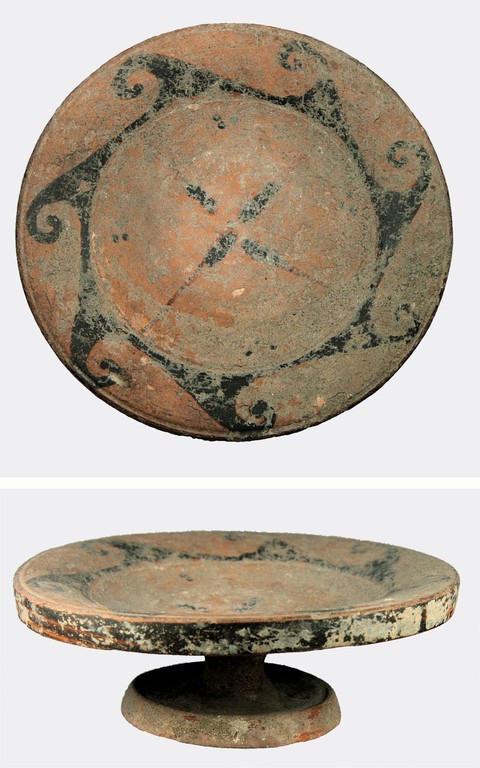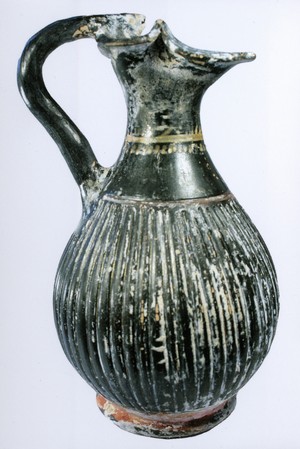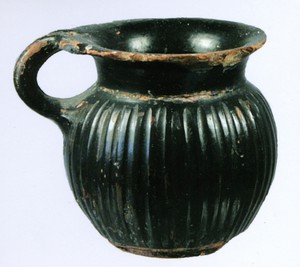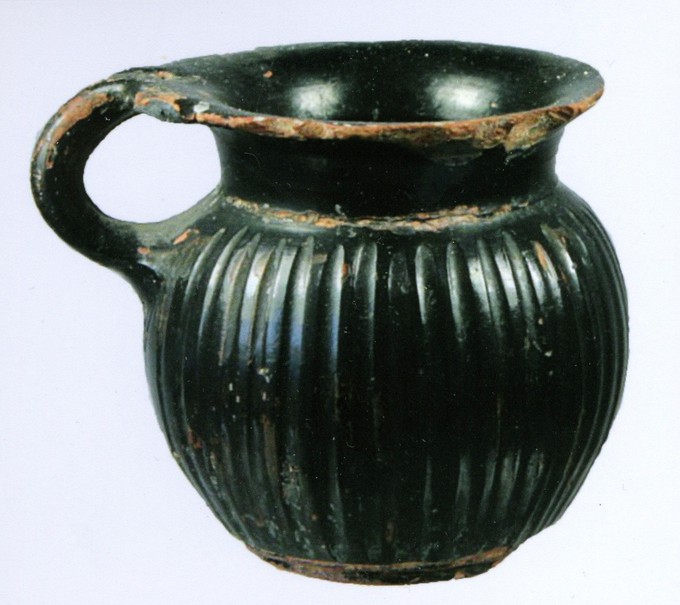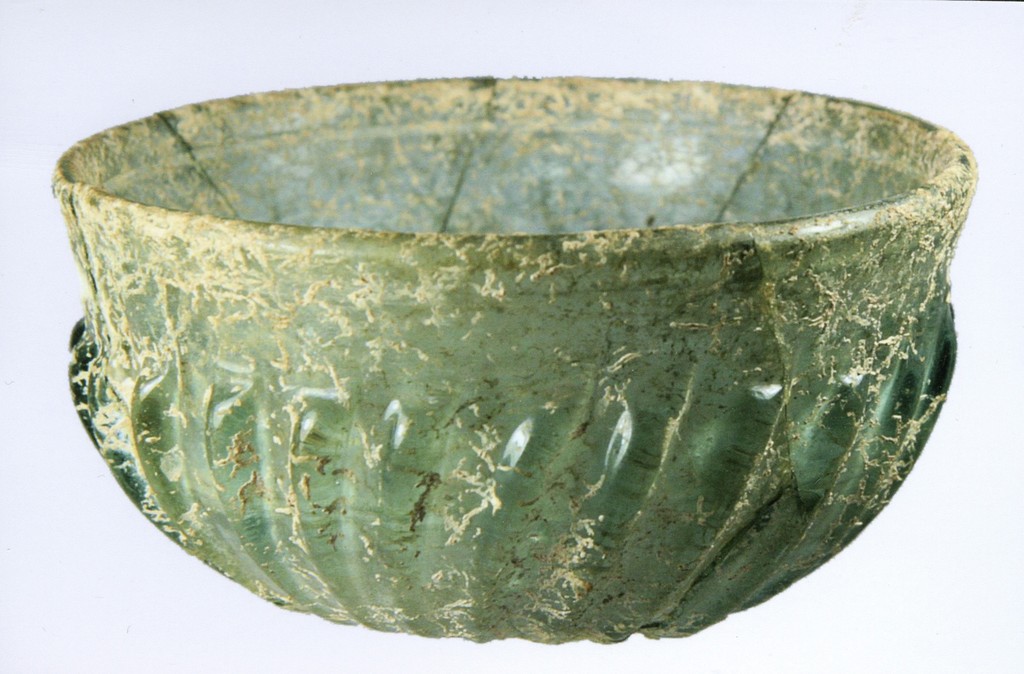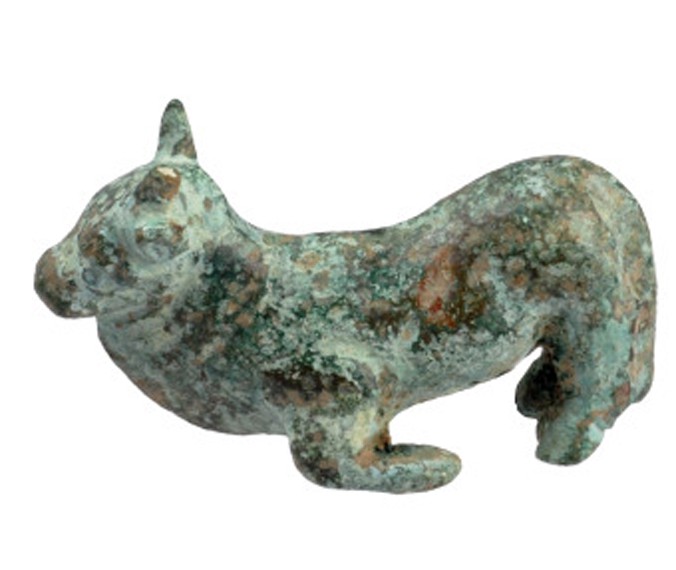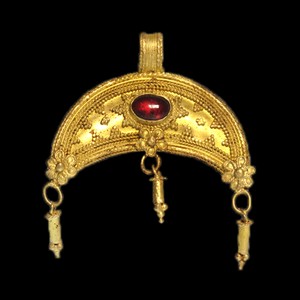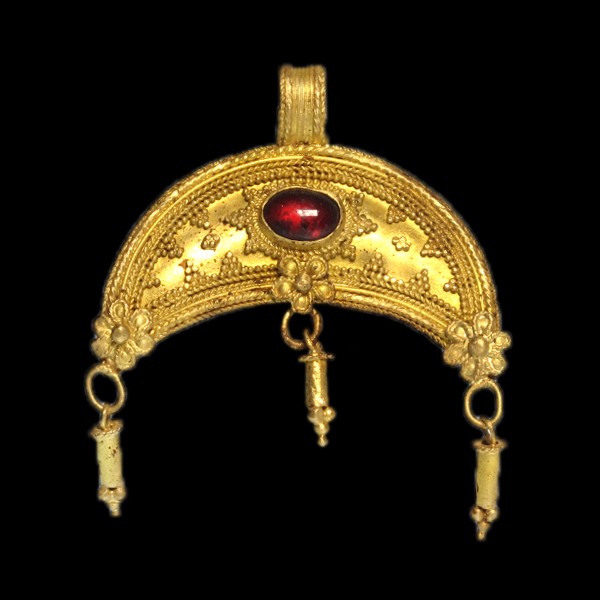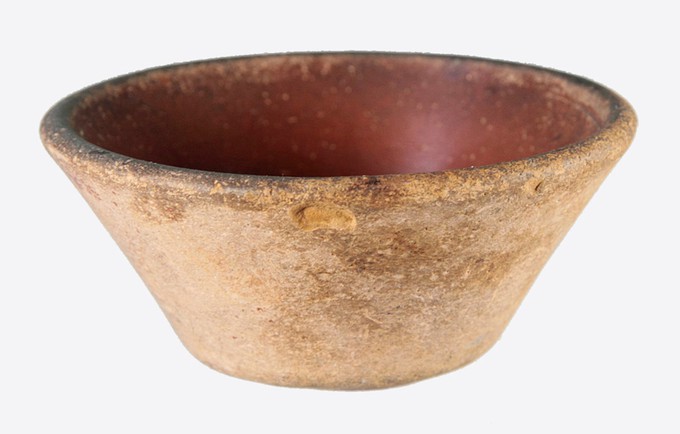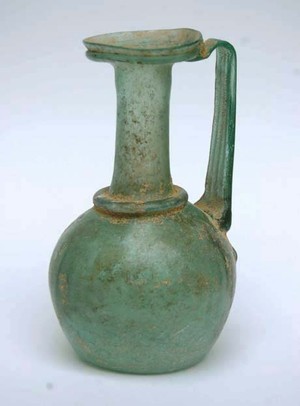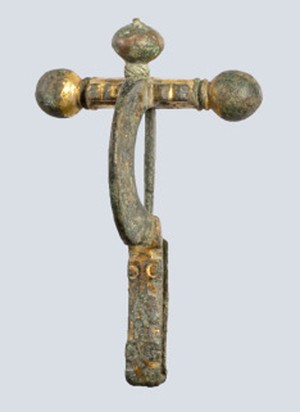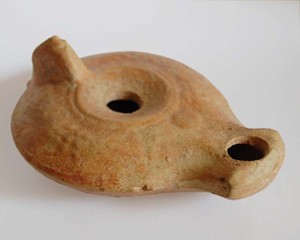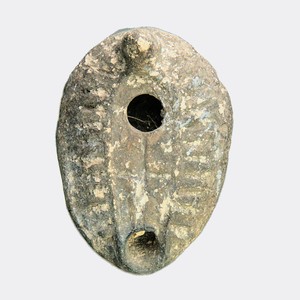The Collection
Palaeolithic UK Flint hand-axe/tool Pre- 10,000 BC (?)
Found by HD Johnson in the garden at Red House Farm near Sible Hedingham, Essex c1960. The British Museum agreed it was probably a stone age implement (it fits the hand beautifully) , but I have not found the letter to see what period they suggested. However a friend who has an interest in hand axes believes it is Palaeolithic (ie before 10,000 BC), which was a period of hunter-gatherers.
I have used that period as my title but stone tools continued to be used for thousands more years of the Mesolithic, and the Neolithic which brought farming, and even after the introduction of Bronze in around 2150BC metal only took over very gradually. Some stone tools were still being used for nearly 1000 more years.
East Anglia is a well known source of flint. The famous Neolithic flint mines known as Grimes Graves in South Norfolk are reckoned to have produced 16000 - 18000 tons of flint which was traded across the country.
Size: 10cm L
DJ-1
European Late Neolithic bowl (fragment) c. 5500-4500 BC
Central and East European, Linear Pottery Culture (Danubian I) round-bottomed burnished bowl with incised linear decoration and (5?) lugs. (Compare with less-crude, Early Bronze Age Cypriot incised polished ware.) Fragment made of 5 pieces. Only about 1/8th of the vessel is original, the remainder has been carefully reconstructed with painted plaster, repeating the existing pattern 4 times, though originally without the other (4?) lugs, which I have added. The restored parts have recreated the look of filling the incisions with lime (as is found also in Early Bronze Age Cypriot pots). Note that the original bowl was only partly black with other parts merging into reddish buff, representing different conditions in the kiln. The densest evidence for Linear Pottery Culture is on the middle Danube, the upper and middle Elbe, and the upper and middle Rhine. It represents a major event in the initial spread of agriculture in Europe. The pottery after which it was named consists of simple domestic kitchen ware: cups, bowls, vases, and jugs: without handles, but in a later phase with bases and necks and often lugs as here.
The large fortified settlement at Uzlonk (Poland) was from the end of the culture. It had 30 large trapezoidal longhouses, between 7 and 45 metres long, made of massive beams with wattle and daub infill, plus 80 graves.
Size: 22cm W
(Ex private collection Regensburg Germany)
(Aquired Helios Gallery 2014)
DJ20
Sumerian stone beads (Mesopotamia) c 3000 BC
Sumer, is now South Iraq. The Sumerians invented the yoke for ploughing with oxen at this time. Beads are commonly found profusely in Sumerian graves, worn around arms, neck or head. These are the most humble kind, but they can be semi precious stone, glazed pottery, or glass which the Sumerians are believed to have discovered 500 years earlier, during the early smelting of copper. They may have been the first to make bronze at about the same time they invented the potters wheel (3500BC). Then about 3200 BC either they or the Egyptians invented picto-graphic writing (it used to be thought the Sumerians were first, though it should be said that a sort of proto-writing was used by the Vinca - centred around Siberia - as early as the 6th or 5th century BC). Sumerian cuneiform (syllabic and alphabetic) writing followed in about 2000 BC.
(When bought the necklace had a simple metal catch (now changed) which was anachronistic for any jewelry at the start of the bronze age, but especially something so basic.)
Size: 64cm around
(Aquired Ancient Art)
DJ2
Sumerian clay cuneiform tablet Ur III period, c. 2112-2004 BC
A finely preserved Sumerian clay cuneiform tablet from the city of Girsu in the kingdom of-Larsa, detailing provisions to be given to a courier/emissary travelling to Susa. Girsu is about 75km North of Ur (Then part of the Kingdom of Isin and later of Babylon) between the Tigris and Euphrates rivers in modern South Iran. The text runs around 3 sides of the tablet.
Susa was 300km to the East, beyond the Tigris. Founded in 4200BC, it was part of the Uruk and then Elam cultures and then capital of an Accaddian province. However the governor rebelled in 2100 and at the time of this tablet it was ruled by the Neo Sumerian Ur III dynasty (who had conquered Elam) and was a literary centre. Later it became an important city of the Median and then Persian empires.
Cuneiform was among the first writing systems, impressed with a wedge shaped stylus in wet clay (Cuneform means wedge-shaped).
Emerging in Sumer in the late fourth millennium BCE (the Uruk IV period), cuneiform writing began as a system of pictograms. These became simplified and abstract, reducing from about 1000 in the Early Bronze Age to about 400 in Late Bronze Age (Hittite cuneiform). The system consists of a combination of logophonetic, consonantal alphabetic and syllabic signs. The original Sumerian script was adapted for the writing of the Akkadian, Eblaite, Elamite, Hittite, Luwian, Hattic, Hurrian, and Urartian languages, and it inspired the Ugaritic alphabet and Old Persian cuneiform. Cuneiform writing was gradually replaced by the Phoenician alphabet during the Neo-Assyrian Empire. By the second century CE, the script had become extinct, and all knowledge of how to read it was lost until it began to be deciphered in the 19th century.
About a million cuneiform tablets have been excavated, only about one in 20 having been read and translated. Most are administrative lists, but they also including the Epic of Gilgamesh from around 2100 - 1200BC (there are a number of evolving versions)- often called the first work of world literature, and containing a version of the flood remarkably similar to the much later one in the bible.
The text reads:
"5 quarts of beer, ordinary 3 quarts of chickpea flour 1 scoop of vegetable oil within the city;
1 kor(?!) of beer, sweet-wart, ordinary 5 quarts of flour, for travel Puzur-Enlil.
5 quarts of beer 3 quarts of chickpea flour 1 scoop of vegetable oil within the city.
1 kor of beer, sweet-wart 5 quarts of flour, for travel Abbamu, emissary, going to Susa.
Month V (Girsu calendar)"
Size: 4.2 x 2.7 cm
(Ex. private collection, Brittany, France; acquired late 19th or early 20th Century.)
(Aquired Helios Gallery, February 2016)
DJ50
Neolithic Cyprus 9000 -3800 BC
Cyprus is on the techtonic plate boundary between Africa and Europe, and was upthrust from the sea bed about 12 million years ago. Most of the superficial rocks are limestone, from the sea bed, but the modest size Troodos mountains, ringed by copper-bearing pillow lavas, were originally part of the earth’s mantle For most of its history the island was covered in forest and was sparsely inhabited.
Human settlement came relatively late. Burnt bones of birds, fish and pigmy hippopotomi, and later tools, have been found by Acrotiri coastal caves, spanning from 10800 to 9800 BC. However these people may have been visitors and the oldest known Cypriot settlements were Neolithic I, from c. 8700 – 6000 BC. Society seems to have been broadly egalitarian. Small, stone images sometimes combining phallic and female elements suggest a magical concern with fertility. They had round, mud brick houses with stone foundations and burnt lime floors and stone pots and tools, since they had not discovered the art of making ceramics. They also dug the oldest known water wells in the world. There were already pigs and birds, but they introduced dogs, sheep, and ibex (goats) to Cyprus and possibly a few cattle, which remained wild and later died out. They also introduced and hunted fallow deer and boars and grew cereals and pulses. Average age at death was about 34. Graves are found under the floors of houses, one from 7500BC included the owner’s cat (the oldest known domestic cat: well before the Egyptians). Weaving is attested by the presence of spindlewhorls and garments were probably of wool. They were fastened with bone pins, and sewn with needles. Personal ornament is represented by stone beads, pendants and bracelets; and necklaces of dentalia shells, carnelian and greyish-green pikrite. Bone was used for handles of stone tools, for awls, pins and needles. Maces of polished stone were used as weapons.
Their most famous site is Choirokoitia (Khirokitia), a walled village of c.60 excavated houses, (where 3 houses have been reconstructed) though there may have been many more. Through most of the Neolithic period Cyprus remained relatively isolated, though there has been some imported obsidian and other imported materials found.
There is a gap in the record, and then from 5500 – 3500 BC there was a Ceramic, Neolithic II society across the island, probably brought by new settlers from Syria and Anatolia. Like the earlier settlers they lived by farming and herding. Their pottery was monochrome with combed decoration. In the final phase there was also a painted red on white ware. Burials outside the settlement became the norm. Their settlements, such as Sotira (c.50 thin-walled rectangular houses with rounded corners) were devastated by earthquakes c. 3800 BC
Cypriot polished-stone tool Neolithic or Chalcolithic
Polished stone tool. Although stone tools and axes are regularly ascribed to the neolithic, they continued to be made exclusively of stone in the Chalcolithic period since copper was too rare and valuable for such things. Even into the late bronze age the high cost of bronze and greater ease of working stone meant that stone tools and axes continued to be made. I intend to investigate whether stylistic differences might narrow the date attribution in this case.
The stone used for polished tools is usually Gabbro, which has a volcanic origin, as has the copper ores in the pillow lava of the lower slopes of the Troodos mountains, which were to become so important in the Bronze Age. Tools with a sharp edge were made of flint or occasionally, in the NW, obsidian imported from Anatolia. Bowls and dishes were carved from limestone or volcanic Andesite.
Size: 6 cm
(Collection General-Surgeon Dr. Josef Mayer-Riefenthaler, Vienna. Acquired in Cyprus in the 1950s & 1960s, during his deployment as UN soldier.)
(Aquired Christoph Bacher, Vienna, February 2016.)
DJ56
Cypriot limestone small mortar Neolithic or Chalcolithic
If this is probably a small, crude, mortar, it is almost impossible to date but very evocative. However I would have expected a smoother interior. I am unsure if it should be described as soft limestone or compact chalk. Households had much grinding equipment for different purposes but grinding stones (or pestles) are found in collections more often than mortars. It probably comes from a settlement as such things were not normally put in tombs (though in the neolithic I am less sure). If it is a mortar, this must have been for grinding small quantities of some flavouring or medicine or pigment. It was collected in Cyprus but this is a very obvious example of how meaning is lost from a lack of excavation context.
Except for the "spout", it looks very like a very early, Aceramic (pre-pottery) Neolithic bowl (9th-8th millenium BC) of similar diameter in the Cyprus Museum, though more shallow. If made later it was a poor and crude example. A harder stone would have been preferable for either purpose but more difficult to obtain than limestone.
Alternatively hollowed out stones were used as lamps well into the Bronze Age, though, again, the crudity suggests an earlier date. A wick made of plant fibre would have dipped into the oil or fat in the side channel. Presumably the stone would have absorbed some of the oil at first.
Crack opposite spout. (There was no information as to whether the shells it was sold with were excavated at the same time, but it seems possible so I have retained them).
Size: 4 x 9 x 8 cm
(Ex collection of David Read, acquired between 1966-1969 while working as a government official in Cyprus. He explored the ancient sites and museums and got to know local collectors and historians.)
(Aquired 14th Dec 2017 through Chiswick Auctions from failed lot 152 (part))
DJ96
Cypriot Chalcolithic Period 4000/3800 - 2400 BC
The Erimi culture of the Chalcolithic Age, found especially in the South and West, followed Neolithic II without a cultural break. Though still basically a stone-age society they discovered and worked the small nuggets of native copper which can be found on the surface of the earth. Only a few small items could be hammered out of this soft, pure copper: small chisels, hooks and jewellery. The buildings were round, 2 – 16 metres across with painted plaster on mud brick walls, on a stone base. The largest have internal posts to support the roof. There was growing social, as well as technical complexity which became more explicit in the Bronze Age. Houses and grave-goods now show some social differentiation. They made Red on White pottery as well as large plain, storage and cooking pots. The cruciform Picrolite (or sometimes pottery or larger, limestone) figurines with spread arms and long necks have become emblematic of the period. Some other ceramic figures explicitly depict childbirth. The island was probably ruled by regional chiefs.
In the late Chalcolithic (from 2800 BC) there was a shift in the underlying ideological system with a move away from communal activities, which led to changes in funeral ritual. Though most people were still buried within the settlements a select few were buried in cemeteries of rock-cut tombs. Monochrome pottery dominated and figurines apparently disappeared. There were some large communities of substantial, round stone and mud-brick houses, many abandoned before the Bronze Age. A few signs of Anatolian influence appear from 2800 BC onwards.
?Cypriot [Iranian? jar - previously believed Cypriot Chalcolithic. 3500 – 2700 BC
RETURNED TO DEALER> NOW BELIEVED TO BE FROM NORTH IRAN
Chalcolithic Red on White ware continued from Neolithic Red on White, but died out in the late Chalcolithic (though it was perhaps continued by the very rare White Painted Philia ware).
If accepted as genuine this would have been a very rare near-intact Red on White Ware Middle Chalcolithic beaker (3000-2750BC) (restored chips on rim). The main shape would have been typical but not the out-turned rim. Cross-hatched triangles have been found on chalcolithic pots (though rare). The piece is thick-walled and heavy for its small size.
Bought 2014 It has now been returned to the dealer as not Cypriot.
Size: 15.9cmH
(Ex. private collection Wiltshire UK. Acquired at auction from a deceased estate in a mixed lot of Victorian pottery. All previous provenance had been lost or thrown away. [March 12016: suggested to be from N. Mesopotamia/NW Iran and after research, North Iran is now accepted.] Since discovered in a Bonhams auction catalogue 1999, lot 394)
(Aquired 2014. RETURNED TO DEALER. Now considered to be from North Iran.)
DJ28(x)
Cypriot picrolite cruciform figure Middle Chalcolithic 3000 - 2700 BC
Cruciform figures made of green picrolite stone are the most emblematic remains from the Cypriot Chalcolithic period: one even appears on the Cypriot one Euro coin. They have been found across the island but mostly in the South West. Quite large numbers of these have been found, both in graves and in houses, including an apparent manufacturing site in Souskiou. Frequently these are found in a child's grave and perhaps had been worn by the mother during her pregnancy (and possibly earlier to promote it). All the adult burials containing these figures (where we know the sex), have proved to be female. Though the middle Chalcolithic starts in 3600BC, most cruciform figurines were made after 3000 BC. At the start 0f the late Chalcolithic (from 2700 BC) the production of figurines died out and though late chalcolithic culture continued in some areas well into the Bronze Age Philia period, the next significant production of figurines was the "plank" figures starting about 600 years later.
These images were at first thought to represent a fertility goddess, but are now generally believed to have been potent charms intended to promote successful pregnancy and childbirth by sympathetic magic. However it has also been suggested that the 2 known, very large (c 40cm) limestone versions might have been cult figures and all the smaller ones portable representations of them. The most common type of cruciform figure are tiny and, like this one, simplified with a pierced head to hang them around the neck from a thong. The most famous types, however, are larger and more detailed with facial features and fingers, 6 -14cm high. They appear to be in a crouching pose and all have outstretched arms and long neck, which gives them a cruciform shape. The outstretched arms are thought to refer to a birthing position, still widely used in many parts of the world, where the crouching woman's arms are supported by an assistant from behind. One of the largest of these figures has a tiny version of itself depicted hanging around its neck. There were also other figures made of limestone and pottery, some the latter depicting childbirth. After death they were placed in the graves of women and children.
Vertical grooves on and (sometimes) between the arms, as on this one are a feature of a number of examples but it is unclear what they signify.
There is a restoration of a lower leg, more extensive on the (plain) back of this figure. Some people like the restored sections of an antiquity to be distinct from the original parts but why this was done in such a different colour in this case is a mystery. However, judging from a photograph an eminent archaeologist thought the figure was authentic. He thought that the fine striations were the result of both manufacture and wear and were quite typical. This means it had been worn and afterwards probably inserted with a burial. Picrolite stone had been used for ornaments long before, and picrolite beads have been found in Acrotiri caves from 6000 years earlier.
Size: 5.8cm
(Collection General-Surgeon Dr. Josef Mayer-Riefenthaler, Vienna. Acquired in Cyprus in the late 1950s, or more likely 1965-(67?), during his deployment as UN soldier.)
(Aquired Christoph Bacher, Vienna, February 2016.)
DJ53
Cypriot picrolite cruciform-figure fragment. Middle Chalcolithic (3000 - 2700 BC)
Lower half of a Chalcolithic cruciform figure, broken just below the (always outstretched) arms. This figure would have been relatively large (perhaps 10cm since the neck of these figures is always very long, forming the characteristic almost symmetrical cross). These iconic figures of Chalcolithic Cyprus are found across the island but particularly in the South West where they (and probably this piece) were mostly made. In a few instances the arms are replaced by a second figure at right angles to the first, or the second figure may even stand on top of the other, forming a double cross.
They are usually considered to be birthing figures, probably intended to magically promote successful pregnancy and childbirth and are found only in the graves of children, and women (where sex can be determined). They are depicted in a crouching position used in childbirth (or as in the small pierced versions, probably alluding obliquely to this position) in which a helper would have supported the woman from behind.
The vertically divided V shape on the front of the torso suggests the stylised depiction of breasts found on two much larger limestone cruciform figures, one probably from Souskiou, now in the J Paul Getty Museum at Malibu. The shape is also very suggestive (probably intentionally) of a displaced female pubis with vaginal cleft. Indeed the other figure, the “Lemba Lady” now in the Cyprus Museum, has both breasts and vagina which echo the same shape. This latter figure also has similarities to some neolithic figurines. At one time all these figures were generally believed to represent a fertility goddess and as recently as 2004 Louise Steel suggested these larger figures were cult figures to which the small, portable versions referred.
The figure is broken cleanly across the middle. Whether this might have been done deliberately I do not know. Certainly there is some evidence this was done to many Early/Middle Cypriot plank figures, “killing” them to enter the world of the dead. However it has been pointed out to me that plank figures are not well fired and it is easy to break them accidentally. Certainly a few cruciform figures seem to have been deliberately broken or defaced and the famous ceramic model of a house with a door found at Lemba, containing terracotta figurines also relating to childbirth, seems to have been deliberately defaced before burial, by the door of a house. This may have been at the point that figurines ceased to be made at the end of the Middle Chalcolithic, when there seems to have been a general change in beliefs, practices and social organisation of communities.
Size: 4.6cm high
(Ex 1960s Savva collection (Savva was a Cypriot living in England. I am uncertain if this might be Savva the artist) . Exported from Cyprus, 1960s, by repute. The dealer said he was told it had been stored in a box with other antiques wrapped in 1960's newspaper.)
(Aquired from Art Ancient, London October 2017.)
DJ89
Cypriot Picrolite cross pendant (Middle Chalcolithic ?) ie 3000- 2700 BC
A nearly unique stone pendant of pale green picrolite in the form of a flat cross, with the horizontal arms shorter but wider, and the top drilled horizontally for suspension. An ancient fracture at the back and a small mend at the top front.
This piece belonged to Desmond Morris, who argued that it was Chalcolithic and represented an abstract version of the familiar picrolite cruciform figures. Since his book another in the Zintilis Collection (Museum of Cycladic Art, Athens) has been published. It was found in the Limassol districting and has a less geometric, more freeform shape. Picrolite pendants were made in South East Cyprus from the Neolithic into the Middle Bronze Age, though by far the most in the Middle Chalcolithic, so it is difficult to be sure of its date. None of the other known pendants is anything like this and, indeed, the cruciform pendant figures seem the closest. Are they precursors of, or late, simplified variant of cruciform figures, or indeed simultaneous? The formal similarity might be a coincidence but I don't believe so. However, was the shape merely suggested by the picrolite cruciform figures, or was it meant to have a similar or linked meaning and use?
The figures are generally believed to depict a position for childbirth, and thus to enact an associated, sympathetic, protective magic, though some think they represent a fertility goddess.
(Published: Desmond Morris, The Art of Ancient Cyprus 1985, p125, Pl 173
Size: 4cm long
(Ex the collection of Desmond Morris (b 1928) (DM -ST 07))
(Aquired Acquired Art Ancient, London)
DJ 236 (Annex 216)
?Cypriot Anthropomorphic stone figure Early or Middle Chalcolithic (2900-2700)
This unique small basalt sculpture is most probably Cypriot, but this attribution relies to a large degree on provenance. It was owned by a family in the Larnaca district of Cyprus who handed it on to the grandmother of Ms D Mavroleon, the last owner. The grandmother and her husband and family brought it to the UK on emigrating in the 60s. None of the family collected antiquities and it was not much valued by the family. Her father used it as a paperweight. Acquired by DJ from D Mavroleon when she was retiring and downsizing. In 2011 it was pronounced as probably Cypriot Chalcolithic by Dr Lesley Fitton, from 2007–2023 the Keeper of the Department of Greece and Rome at the British Museum.
There is no precedent in stone on Cyprus. However, other than the cruciform figures there is great variation in Cypriot Chalcolithic sculpture. The best comparanda are ceramic figures. The face has strong parallels with the Chalcolithic pottery quadruped askos with human face from Souskiou Vathrykakas, now in the St Barnabus Monastery Museum (North Cyprus) previously in the Hadjiprodomou collection, which itself has the same eyes as the so called "ejaculating" figure in the Pierides Museum, Larnaca. Slightly similar arm positions are found in a seated figure from Kissonerga and so called lactating figures from the South West and Alaminos (Larnaca district). However there are also similarities to Balkan figures, particularly anthropomorphic Neolithic figures from Lepenski Vir, Serbia, possibly representing ancestors.
The figure’s sex and function is unclear. Could it be a precursor of stone plank figures, perhaps a fertility figure or ancestor? The arm position with hands on breasts was much later considered one of prayer or worship. The pelvis might be female but no vulva is indicated. Basalt and closely related diabase and andesite are found in the Karelia Mountains, the Troodos massif and the Mamonia complex just to its South West.
Crude, blocky stone figure with wide, flattened head, and torso with shoulders. Eyes expressed as ovals in relief and wide mouth as a similar loop. The nose extends up to form a crest on top of head. Arms bent in U shape with hands, divided into 3 fingers, over the position of breasts. Below the arms, ridges on each side at the front might represent bent legs. Part of lower right has broken off and there appear to be black burn marks around the area and around the top. A similar smaller piece on left reversealso missing . Black staining on arms and reverse, possibly burn marks? Orange oblong mark, possibly from a stand on lower reverse.
Size: 15.7 x 10.8 cm
(see text)
(Aquired direct from D Mavrolion)
(DJ 257 AN 237)
Cypriot Philia period (Early Bronze Age) 2500 - 2200 BC
Around 2500BC, new settlers from Anatolia (South Turkey) brought new technologies and animal species to Cyprus. They may have been refugees from Indo European invasions. (In Anatolia these conflicts led to the Accadian empire of Sargon the 1st.)
The Philia culture, as it is now called, quickly moved from the North coastal plain into the foothills of the copper-rich Troodos mountains. They introduced copper smelting but most of the metal had only accidental impurities. Harder bronze was made by including more arsenic (which is found in many Cypriot copper ores) to the soft copper, but this was mostly in the next (ECI) period. (Only later, in the ECII period, was the less toxic tin added, which had to be imported.)
They introduced ploughs and sickles and the warp-weighted loom and had mud-brick houses, or compounds, built on stone footings (rectangular rooms arranged around a courtyard). Pit and rock-cut chamber tombs were outside the walls. They brought in donkeys and re-introduced cattle to the island in large numbers. These animals pulling their new ploughs allowed larger areas to be taken into cultivation, which started an expansion of the population
The Philia also made flat-bottomed red polished ware pottery (often with broken-line incised decoration). There are strong similarities with Anatolan Red Burnished ware (eg from Tarsus and Troy), though the latter had dishes and sometimes used the potters wheel - neither of these introduced in Cyprus. However the famous Philia large jugs with cut-away spout have parallels in western Anatolia.
The quite uniform Philia culture took a long time to occupy the whole island and the process appears to have been peaceful. They are chiefly associated with the vertical centre of the island, North to South, with not much in the East and West). A few of these outlying areas clung to Chalcolithic culture till possibly as late as 2300 BC. The Early Cypriot I culture which took over from them spread similarly slowly, starting around 2300BC, and again the process seems to have been assimilation rather than conquest.
It is only recently with the work of Webb and Frankel that the Philia period has been accepted as predating Early Cypriot. The dates of Cypriot Chalcolithic and Early Bronze Age periods tend to be regularly revised. Most knowledge comes from cemeteries and there has been limited digging of stratified occupation sites of this period, partly due to the 1974 Turkish invasion and occupation of the North, which led to a UNESCO ban on archaeological co-operation.
Cypriot Philia Period large jug with cut-away spout (Early Bronze Age) (2500 – 2200 BC)
Philia Red Incised Polished Ware. The majority of the red slip has been lost. The jug with cut-away spout is an iconic shape from the small repertoir of Philia period pottery as catalogued by Webb & Frankel. There is an almost identical piece in a photo from the Department of Antiquities, Nicosia: http://eca.state.gov/files/bureau/icpp/cypruspc/00000004.htm except that my one has incised abstract decoration to the upper body which, as is usual is in this period, is made up of discontinuous straight lines. However it also has a handle made from 3 strips twisted together, a sort of compromise between a twist and a plait. Twisted handles are found occasionally from the Early Cypriot onwards and plaited ones in the Iron Age. But I have been told this might be the only known, relatively complete example with a plaited handle from the Philia period. One fragmentary example is known from tomb 9 at Nicosia Ayia Paraskevi excavated by Stewart in 1955. Mine has an awkward experimental look, as though the potter didn't quite know what she (or he) was doing. Perhaps it was an attempt to copy hair braiding. This makes me wonder if this piece is transitional between Philia and Early Cypriot (The end of the Philia culture used to be put at 2300BC but is now edging towards 2200BC, so perhaps this jug comes from between these dates. A pair of relief eyes on either side of the spout have been applied to give the jug the appearance of a bird with an out-stretched neck, as in the example from the Department of Antiquities. The zoomorphic appearance is typical of Ancient Cypriot pottery from the Philia right on into the Early Iron Age (see my Iron Age jugs which both have painted eyes near the rim). The jug becomes a personage. The spout is cut away in a characteristic way which was continued into Early and Middle Cypriot jugs (see my Middle Bronze Age jug) though not in the south.
This piece is likely to have come from the North (from a site such as Vasilia) or from the Ovgos Valley, both areas of the island which have been under Turkish occupation since 1974. Although tomb looting goes on across the island, if it was acquired after 1974 it is most likely to have been looted and sold from the occupied area. I am attempting to find out from his estate when the famous artist who collected it is likely to have bought it.
The jug is flat-bottomed which is normally the case with Philia pottery, while Early and Middle Cypriot wares were almost always round bottomed, except in the South where the flat bottom can be found nearly to the end of the EC period. Only with Base ring Ware and Handmade Bichrome Ware in the Late Bronze Age did pots reappear which could sit on a flat surface, joined later in that period by imported Mycenaean wares and Cypriot wares derived from them. The jug was sold to me as Early or Mid Bronze Age so I was quite excited when I realised what it must be. I had been hoping for a while that I might find a piece from the first culture of Anatolian settlers who brought bronze-making technology to Cyprus - and here it is.
Repaired from numerous pieces, surface of slip worn, some losses and (red) patches of restoration.
Size: 40 cm x 18cm
(Ex. collection: Walter Womacka, Germany (1925-2010). Womacka was a Socialist Realist painter and head of the School of Art and Design Berlin-Weissensee from 1968 until 1988.)
(Aquired Helios Gallery Aug 2015)
DJ39
Early Cypriot (Early Bronze Age) 2300- 2000/1950 BC
Around 2500 BC Anatolian settlers on the North coast of Cyprus initiated the Cypriot Bronze Age. Their “Philia” culture introduced copper smelting technology, the plough and sickle, and the warp-weighted loom. They introduced the donkey and also re-introduced cattle to the island in large numbers. These animals pulling the new ploughs allowed larger areas to be taken into cultivation, which started an expansion of the population that continued through the Early and Middle Bronze Age. They quickly moved from the North coastal plain into the foothills of the copper-rich Troodos mountains. But the process seems to have been peaceful, and the rather uniform Philia culture took some time to spread across the whole island (developing in the South into RP South Coast Ware). Eventually it hybridised with local Chalcolithic traditions, creating the Early Cypriot culture. The flat bottomed Red-Polished Philia pottery gave way to a profusion of local, round bottomed variants produced in each settlement. The centre of pottery innovation in the early to middle Cypriot period was at first Vounous and then nearby Lapithos, near the North coast.
There were no towns yet. Buildings in settlements were close-packed and shared walls. Access was by narrow lanes. Houses were stone or more often mud-brick on a stone base, generally composed of a few rectangular rooms on one or two sides of a small courtyard. Walls and sometimes floors were rendered with lime plaster with low benches and hearths against the walls and pivot holes for doors. There were mortars sunk into the floor and lime plaster bins for storage jars and pots. Pierced lugs on many smaller bowls and vessels suggest they may have been hung from pegs in the wall. Stone grinders and scrapers were used in food production. Although there are two ceramic depictions of thrones, and a few tables and possibly stools, most people probably sat on the floor to eat. After the Philia period and until the End of the Middle Bronze Age almost all vessels had round bottoms (like many traditional African pots now), so large storage vessels sat in dips in the floor while others probably sat in organic rings (perhaps rafia).
Staple foods comprised bread wheat, barley, chickpeas, and lentils, plus probably dairy products, while the major source of meat was sheep and goat, supplemented by venison, pork, and beef only for special occasions. This would have been extended with olives, berries, nuts and herbs, and seafood by the coast. Wine and beer were drunk. Wool, goat hair, and later flax fibres were spun and made into cloth.
Although food production and some fabrication took place in houses and courtyards there were also mixed use workshops. The supreme example was discovered at Pyrgos Mavroraki near Limasol, where a complex of buildings contained copper smelting facilities, a perfume factory, an oil press with 500 litre storage jars, textile production and a winery.
Aside from some pit graves, burial was in rock-cut chamber tombs, which had a Dromos (a shallow pit or ramp outside, possibly used for rituals) leading through a narrow entrance (or entrances) into one or several chambers, generally cut into soft limestone, which were progressively re-opened and re-used and added to by a kin-group, sometimes for hundreds of years. Most of the complete objects we now have came from these tombs. They were a considerable distance from the settlements, though usually within sight of them, which suggests some nervousness about the dead. There seems to have been a fertility cult based around horned animals, principally the bull. The snake, representing the chthonic forces of death and rebirth was also represented, and late in the early Bronze Age images of birds proliferated in grave goods, possibly representing the spirit. Funerals may have been double: a cursory burial, followed later after only bones remained, by a major celebration when the bones were transferred to a family tomb. This would suggest a possible cult of ancestor reverence. It is probably misleading to make a distinction between sacred and secular in such early cultures.
These elaborate funerals involved feasting and the consumption of alcoholic drinks and were occasions for the assertion and display of status by the provision of food and grave goods, including pottery, bronze and gold objects. The most common are the simple bowls used by the participants but beside the normal jugs and bowls, more elaborate and imaginative composite pots with proliferating spouts and bodies appeared, plus scenic models, most probably made especially for funerals, and representations on vessels of activities and cult animals. A little before 2000 BC the mysterious Plank Figures started to be made at Lapithos, which are found both in settlements and tombs and spread across most of the island.
As the Early and Middle Bronze Ages progressed signs of further social differentiation appeared in grave goods, probably created by the development of copper extraction and trade, but this did not produce distinctive elite dwellings. By the Middle Bronze Age the whole island was occupied. More and more of the natural forest which originally covered the island was cut down to make farms and for fuel, especially for copper smelting.
Probably authority was still local and there is little sign of conflict. It was not till the disturbed and transitional Middle Bronze Age III (1750-1650BC) that the few defensive forts appeared, probably to protect the copper trade routes to newly founded Enkomi on the East coast, from the Troodos mountains. A number of settlements were abandoned at this time but there is no evidence for foreign raiding for example by the Hyksos who were causing problems in Egypt. At the same time the first towns were founded, mostly close to the coast where the growing international trade with other cultures, especially the Levant (Ugarit), Anatolia (ie South Turkey), Egypt and Crete, was producing the first luxury imported goods in exchange for Cypriot copper.
In the Middle Bronze Age (from a little after 2000 BC) the variants of Red Polished pottery were joined by other wares, principally White Painted Ware, which by the end of the Middle Bronze Age had become dominant. This was later joined by others, principally Black Slip and Red on Black wares.
Cypriot Picrolite Pendant Early Cypriot II- Middle Cypriot I (2150-1850BC))
Picrolite flat stone pendant with rounded-oblong body and extended narrow neck, pierced near the end for suspension. Both sides are marked by shallow drill holes, 9 on one side, 8 on the other. A 10th drill hole on the right extreme edge of the paler side, apparent on Morris’s photo, seems slightly damaged since and now appears more as a tiny chip. 2 larger chips from lower edge might have included drill holes.
This piece belonged to Desmond Morris who said in his book that he believed it was Chalcolithic and an ancestor of similarly shaped but much larger pottery “Comb Figures” from the EC II -MC I, which he thought might be ancestors of the Anthropomorphic Plank Figures. Since then a number of similar shaped pendants have been found in the South, principally in the Kouris region, from Middle Bronze Age contexts or one dated EC III-MCI (Lubsen-Admiraal), 4 made of picrolite and two of serpentine. It now seems reasonable to see Comb Figures and these similarly shaped pendants as contemporary and referring to the same thing, though comb figures have only been found in mortuary contexts, while comb pendants have been found in both settlements and tombs. However, Comb figures have parallel vertical grooves on their lower 2/5ths and the pendants have analogous corrugations along their lower edges, which this pendant does not have. However this pendant is clearly from the same corpus. Conversely this pendant uniquely has shallow drill holes on both sides. The closest equivalent found on other pendants from the EC III-MC I (including one comb-shaped pendant) is an engraved dot with a ring around it. However shallow drill holes are a known decorative feature from the Early Cypriot period, so it would be reasonable to consider that period, contemporary with earlier comb figures, as a probable dating.
The meaning of Comb figures (and therefore now comb pendants) has always been controversial.. Toiletry combs or ritual brushes or musical instruments have all been suggested, but the most likely are either carding combs, used in preparing wool for spinning, or beaters used in weaving. These references to important elements of textile production would probably have been symbolic, and they joined spindle whorls and model spindles in tombs. Morris’s suggestion that Comb figures (and thus comb pendants) were anthropomorphic and ancestors of Plank figures is not now widely held. The shape is very widely referenced on the backs of Plank figures (see Annex 99 & 160) and on pottery (see Annex 61). In the former case the suggestion that these represent actual pottery Comb Figures, used for example as counterweights to necklaces, seemed unlikely due to their weight, but pendants might have been worn in this position.
Picrolite pendents are known from the Aceramic neolithic through the Bronze Age, and ones with drill-hole perforations have been found from the Late Neolithicto through the Bronze Age. It was once thought that after Middle Chalcolithic cruciform figures died out, picrolite pendant production ceased in the Bronze Age, but clearly production merely waxed and waned.
Bibliography: Luca Bombardieri: Erimi Laonin tou Porakou, A Middle Bronze Age Community in Cyprus. Astrom Editions Uppsala 2017 pp240-241. Frankel and Webb 2006: 244 (Frankel and Webb in their final SIMA volume on the excavations at Marki Alonia.). One only slightly similar example in Zintillis collection p30. Knox: Making sense of Figurines 2012, p141
picrolite pendant (EC II-MC I)
Size: 4.4 x 3.7 x 0.4cm
(Ex Desmond Morris collection, acquired 1970s, Sotheby’s or Christies. Published: Desmond Morris “The Art of Ancient Cyprus” 1985 p.138-9 Pl.175)
(Aquired Art Ancient)
DJ 204 (Annex 186
Cypriot bronze, tanged spearhead (Early Bronze Age) : 2450 - 2100 BC
Fine 15” (38cm) spear head, sold to me as 1200 BC, the time of the Trojan war, but now suggested on stylistic grounds to be probably from early in the Cypriot Early Bronze Age. However if this is the case it should be made of arsenic bronze rather than tin bronze. This is untested. The offset knob or button on the tang occurs on Philia culture examples (the first phase of the Bronze Age dated before the Early Cypriot period, so around 2450 to 2200 BC) but the rounded shoulder is more typical of EC I-II date (2200 to around 2000 or so) Very similarly shaped spears but with hooked tip to the rat-tailed tang were common in Cyprus and the near east and they existed right through the Bronze age, though in the Late Bronze Age many spears had sockets. The socket is functionally superior but more complex to make.
This spear is so fine it would have been a prestige object which only important people might have owned (and been buried with). The spear tip would have been cast in a two part mould and then hammered. Forging bronze is tricky – mistakes can’t be rectified as with iron. It would have been fixed into the handle (with knob-end visible) by boring a hole and splitting the end; afterwards binding the split end with laching cord*.  The angled tang prevents it being pulled out. A 6 ft or at most 8ft wooden shaft is likely. There are longer spears, held with both hands, depicted later in the bronze age (eg Acrotiri fresco 1600 BC). Throwing spears were also later and had smaller heads. Spears were the most common weapon of the time. Although there is no direct evidence, combat reconstruction suggests it may, as later, have been used largely one-handed in battle with a shield in the other hand, but impromptu use might be different. There are no defences or other indications that the Early Bronze Age was a period of conflict on the island, but spearheads are found in tombs – though not as often as later in the Bronze Age. They may have been status symbols or simply standard weapons carried by males who had to be prepared for the dangers of everyday life. Spears might also have been used for hunting and ceremonial purposes, though in more recent times hunting spears usually had smaller heads than this. Often in northern Europe such bronze objects were deposited as a propitiatory offering in water in which case they were usually first bent or broken to remove them from this world. Similarly weapons placed in Cypriot tombs were often deliberately bent. Cyprus was the chief Mediterranean source of copper and Homer said that his heroes wore Cypriot bronze armour. Indeed, most western languages derive their word for copper from Kupros (Kypros), the Greek name for the island**. Copper made Cyprus rich but 200,000 tons of ancient copper slag suggest 200 million pine trees cut for fuel, which deforested the island. The industry largely died around 300 AD due to lack of fuel.
The angled tang prevents it being pulled out. A 6 ft or at most 8ft wooden shaft is likely. There are longer spears, held with both hands, depicted later in the bronze age (eg Acrotiri fresco 1600 BC). Throwing spears were also later and had smaller heads. Spears were the most common weapon of the time. Although there is no direct evidence, combat reconstruction suggests it may, as later, have been used largely one-handed in battle with a shield in the other hand, but impromptu use might be different. There are no defences or other indications that the Early Bronze Age was a period of conflict on the island, but spearheads are found in tombs – though not as often as later in the Bronze Age. They may have been status symbols or simply standard weapons carried by males who had to be prepared for the dangers of everyday life. Spears might also have been used for hunting and ceremonial purposes, though in more recent times hunting spears usually had smaller heads than this. Often in northern Europe such bronze objects were deposited as a propitiatory offering in water in which case they were usually first bent or broken to remove them from this world. Similarly weapons placed in Cypriot tombs were often deliberately bent. Cyprus was the chief Mediterranean source of copper and Homer said that his heroes wore Cypriot bronze armour. Indeed, most western languages derive their word for copper from Kupros (Kypros), the Greek name for the island**. Copper made Cyprus rich but 200,000 tons of ancient copper slag suggest 200 million pine trees cut for fuel, which deforested the island. The industry largely died around 300 AD due to lack of fuel.
* fixing illustration and other information: Andrea Salimbeti: http//salimbeti.com/micenei/weapons2.htm
** via Latin: early Latin “aes cyprium” which means “Cypriot ore”; later Latin “Cuprum”. The name Kupros may itself derive from the Sumerian for copper. The native Bronze Age name for Cyprus was Alashiya but the Greek language and customs gradually supplanted Cypriot, following extensive Greek immigration in the 12th and 11th century BC.
Size: 15” (38cm)
(Ex British private collection acq 1980s)
(Aquired ArtAncient 2014)
DJ25
Cypriot Bronze toggle pin Early Cypriot III-Middle Cypriot II
Probably from North Cyprus in the Middle Bonze Age (or just possibly Early Cypriot III). They known from the Philia period onwards, and are believed to have been used to secure clothing. However their unnecessarily large size suggests a large element of prestige display. Such pins are thought to be represented on many plank figures. Other than daggers/ knives toggle pins were the most commonly found among the 18000 copper based objects found in 140 Lapithos tombs. They were also the object type containing the highest proportion of tin. Many of the other objects were predominantly alloyed with arsenic or a combination of tin and arsenic.
Ref: Charlambous & Webb 2020. Cf Swedish Cyprus Expedition P Dikaios & J Stewart 1962. Vol4 1a. p136
Size: 13cm
(Found by the Dr Allen Heflin in Cyprus 1962 (His notation written on pin). The archaeologist Dr Heflin donated items to museums in the Universities of Missouri, Columbia, and Kansas. Later sold by Harlan J Burk Ltd, Chicago USA to HD Enterprises, Aurora CO, USA. Subsequently bought from them by K Kiriacou.)
(Aquired Generously donated by Kyriacos Kyriacou to David Johnson collection Nov2020)
DJ 210) (Annex 192
Cypriot Small horn-lug bowl Early Cypriot I (2300-2200BC)
Red Polished I-II ware (Black Topped). Horn-lug bowls are characteristic of Early Cypriot I in the North, especially Vounous. Often, as here, they have a black top and interior created by a reducing atmosphere in the kiln.
Small, hemispherical bowl with rim extended vertically and up-tilted horn lug pierced at the base. Red polished slip with black rim and interior. Intact, small surface damage.
Cf: British Museum 1939,0217.42 (and .9 and .35)(Vounous, Stewart)
Size: 7.2 x 11.1cm
(Ex. private collection, Bath, Somerset, UK; acquired during residency in Cyprus with the British High Commission 1969- 1972. The collection was purchased from licensed antiquities dealers in Ledra Street, Nicosia, reputedly selling duplicate and surplus items on behalf of the Cyprus Museum.)
(Aquired Helios Gallery London, December 2023.)
(DJ 264 AN 244)
Cypriot Ear-lug jar Early Cypriot I (2300 – 2150 BC)
An iconic EC I shaped Red Polished I Ware. Particularly associated with the North coast but with small loop handles elsewhere (Lubsen-Admiraal p63). Usually black-topped, though not here. Division into zones by horizontal lines suggests end of EC I.
Reconstructed from several pieces with small areas of reconstruction on neck. Most of slip lost on one side of body, and possible modern fire blackening on the other. Chips from handle and upper neck.
Ovoid body stretched at bottom to small, flat base, and above to tall, wide, cylindrical neck, out-turned at the top. Two opposed, vertical, flange handles at junction of body and neck. Burnished red slip with incised decoration, originally filled with lime: chiefly un-bordered, diagonally hatched diamonds on neck and upper body. At mid body and below lugs a double line above dotted line. Same triple lines form 12 chevrons below the mid-line.
Cf: Dikaios & Stewart 1962 p.317 Pl.CIV; British Mus. 1939,0217.14;
Size: 30.5 x 17.2cm 1.7kg
(From a collection acquired on the UK art market from various auction houses and collections mostly before 2000. From an important Cambridgeshire estate; thence by descent. Extreme blackening of of several items suggest a house fire.)
(Aquired Timeline Auctions)
(DJ 280 AN 260)
Cypriot Early Red/Black amphora Early Cypriot I - II (2300-2100 BC)
A rare and very early flat bottomed amphora with vertical handles. Red/black polished ware from early in the Early Cypriot period, covered in a dense pattern of incised chevrons and diagonal checkerboards, filled with white lime. This is almost a Black Polished Ware piece, with only a little red retained at the bottom. The black areas of the slip were achieved by reducing oxygen in the kiln to reduce the iron oxide in the clay (still visible in its red, iron oxide colouring at the bottom). Possibly this flat bottom is a hang-over from the earlier Philia styles. It is a Cypriot Bronze Age stylistic trait that the joining of handles to a pot body is normally effected by pushing the handle through holes in the body and then smoothing off on the inside. This gives a particularly strong connection. In this vessel the handles have been pushed a considerable distance through the fabric but not smoothed off so that spikes have been left sticking out on the inside. Whether this was because fingers could not reach far enough inside to do it (which could be the case) or they simply forgot is not clear. Possibly the pot was made for the funeral it was used in, and dramatic external appearance was what mattered, rather than suitability for repeated re-use.
Very old reconstruction from many fragments.
October 2018, I finally received my 6 pieces from the Cyprus Museum (Jacksonville USA) dispersion auction, but very sadly despite paying an exorbitant amount to have them all professionally packed in individual boxes this piece was badly broken in transit. The box showed no damage. The heavy but soft pottery fabric caused by low temperature firing may be partly to blame, plus probably old glue which had weakened, plus quite a lot of missing fabric on the inside which had not been restored, leaving many vulnerable mend lines. Most of the breaks were on old mend-lines but there were new ones and many small fragments. I had several high-res photos from before the breakage and hoped the small pieces of exterior could all be re-used,and indeed all but the finest grains on the surfaces have been used with the minimum of in-fill, and the appearance seems very close to how it was.
.
Size: 28cm high
(Ex Museum of Cyprus, Jacksonville, New Carolina, USA. Assembled by Dr Takay Crist after the Turkish invasion of North Cyprus and opened to the public as a museum in 1988. This century the museum has not made significant acquisitions. It consisted of antiquities, documents, maps paintings and artefacts and was endorsed and by the President of Cyprus and the ambassador, as saving the antiquities from the market and making them available to the public and for study. The sale of the entire museum collection represents a betrayal of the trust of Cyprus and almost all record of the provenance and history of the pieces seems to have been lost, including their dates of acquisition.)
(Aquired Leland Little Auctions, USA, 15th June 2018, lot 2206)
DJ 111
Cypriot tulip bowl Early Cypriot I (Early Bronze Age) : 2300-2150 BC
Red Incised Polished Ware. Most tulip bowls (named from their shape) are from Early Cypriot I and the area of Vounous in the North of Cyprus. The clay was covered with red slip which was then burnished to produce a high polish. The decorative incised lines were probably originally filled with (white) lime. This one has a bird’s head protruding on either side of the rim, facing outwards. (It should be mentioned, however, that it has been suggested they might simply have been ornamental lugs and their clear bird head form might have appeared during restoration.) Birds were probably considered to be spirit vehicles, especially later in the Early Bronze Age when they become the dominant animals on cult vessels, and perhaps even 1500 years later in the archaic period when birds dominate the imagery on the splendid "free field" jugs.
The bowl's narrow pointed base is pierced horizontally through the tip, perhaps to hang it up by a string when not in use. The hanging of pottery from pegs in the wall seems to have continued well into the Early Iron Age. Probably when used it would have sat on a ring made of straw or wood. This design seems to have died out well before the end of the Early Cypriot period.
Red polished ware was the dominant ware of the Early Bronze Age and continued into the Middle Bronze Age alongside new, painted wares, principally White Painted Ware.
Very elaborate cult vessels from this period have been found which had modelled birds, bulls, bucrania (bull's heads) stags and mini depictions of bowls and jugs, sitting on the rim. (See the Middle Cypriot period for my own late example from this tradition. But such cult vessels, along with others showing scenes with human figures, were impractical and probably made especially for ceremonies tombs. As such they were usually less well fired since they wouldn't have to withstand wear. Of course, other than fragments, most pots have been found in tombs in any case.
Repaired from fragments with some consolidation and repainting over the repair lines. The bird head lugs have been repaired. The interior repainted over repairs and worn patches. Perhaps over-restored for my taste, though you can see repairs and restorations if you look. The last owner broke 2 large pieces from the rim and glued them back extremely crudely, which I have had mended.
Size: 16.5cm H
(Ex collection of Desmond Morris (DM-IRP-97); Christie's London, 6 November 2001, lot 159; then collection of Dr Pietro Villari. Published: Desmond Morris, The Art of Ancient Cyprus (Oxford, Phaidon, 1985), p. 223, pl. 251. Also V Karageorghis "The Corplastic art of ancient Cyprus" (1991) Vol 1, XII:28, p.161-2. Exhibited: Ashmolean Museum Oxford, 1985.)
(Aquired Alexander Ancient Art, Amsterdam, Aug 2015)
DJ45
Cypriot Small “tulip” bowl/conical cup Early Cypriot III (2300-2100BC) - Middle Cyprio I
Red Polished Ware "Tulip bowl" with partly black-top. Conical beaker with 2 pierced, pointed lug handles by the rim, decorated with incised lines filled with white lime. Double lines by rim and base and between them vertical features: bunches of zig-zags, hatched diamonds, two larger, hollow hatched diamonds containing groups of dots. Also groups of dots alternating with patches of unbounded diagonal lines. The pointed base would have compelled the drinker to empty it before it was put down, or to pass it to someone else.
This is a small version of a shape normally believed to date only from Early Bronze Age I-II in North Cyprus, especially around Bellapais Vounous. However the appearance belies this. In particular the hollow, hatched and outlined diamonds, as here, as well as the simple zig-zag inside a triangle are only known from the Middle Bronze Age in the Karpas (NE Cyprus). They are found in Red and Black ware from the Karpas on larger bowls and tall necked bottles which Desmond Morris made a study of (see my two).
The bottles were dated by by Stewart (1962), as MC II-III from what is still the only provenanced example (tomb 6 at Ayios Iakovos). Red and Black Ware was identified as a ware from 22 examples by Herscher and dated MC I- early II. Morris identified and studied 200 more, including 2 tulip bowls almost identical to this. All are extremely precisely decorated with fine lines (here 9-10 lines per cm) and a unique repertoire of design motifs. Circles and horizontal zig-zags disappear. The amount of red and black varies hugely in different examples, but is unlike Red Mottled and Red Black Topped Wares. The ware is anomalous in the late MC and would make more sense in ECIII-MCI, with the tulip bowls becoming simply late use of these forms. With no sanctioned digging in the region since the 1974 Turkish invasion, the dating range still awaits clarification
Reassembled from 5 pieces, otherwise good condition.
Size: 9.6cm high
(Ex Private collection, Germany, of O Schwarzwälder since 1980.)
(Aquired Acquired from Gerhard Hirsch Nachfolger, Munich, auction 367 lot 1136.1)
DJ 230 (Annex 210)
Cypriot Tulip bowl (2) Early Cypriot I-II (2300- 2150/2100 BC)
See previous. This tulip bowl is possibly slightly later than the other, with more sophisticated incised patterns similar to the ear-lug jar, alternating two patterns between two tiers. Mended from many pieces, possibly small restorations, smeared filler inside.
Convex conical vessel with top curving inwards and pointed base. Four, long, tapering flat-faced lugs arranged symmetrically, turning out above the rim. Red slip on the lower half, black above and inside. Incised decoration covers the upper half, originally filled with white lime. Three double lines at rim, midline and intermediate, create two horizontal bands which fluctuate in depth. In the spaces between lugs, two patterns alternate in top and bottom bands. One consists of multiple parallel zig-zags, the other of two rows of three tlinked diamonds filled with dots. Three similar diamonds run down each lug, with diagonal lines across lug tops. Fine striations down interior.
Cf: Dikaios & Stewart 1962 Fig.CXXXV (18) p.332
Size: 16.5 x 16.3 x 16.7cm
(Collection of Annie Trotter & Ian Parsons, then personal collection of BL (known to me personally but name withheld on request), acquired 1989.)
(Aquired Acquired by DJ from BL December 2023.)
(DJ 259 AN 239)
Cypriot Jug with cut-away spout and nipple base. EC I-II ? (1300-2100 BC)
Red Polished I-II Ware. Complete, good condition
This jug, similar to 13 and 19, is a small version of EC jugs derived from flat bottomed Philia shapes (see 8). The spout suggests EC I-II but the handle should be a flatter loop for that period, and the lower neck normally wider.
Cf. Dikaios & Stewart 1962, LV (11,14), LVI, LXI (2); British Museum 1939,0217.28
Size: H 27cm
(Christies Auctions, London,11 December 1974, Ex collection of Lord Dayton of Corran, formed 1960-2000. Bonham’s Auctions, London 27th April 2006, lot 313 (part))
(Aquired Acquired by DJ: Timeline Auction 5th March lot 0038 (part))
(DJ 266 AN 246)
Cypriot bottle with nipple base. Early Bronze Age I -II. (2400 -2100BC)
A very early Red Polished Ware bottle with cut-away spout and nipple base, and large nodules decorating both ends of the handle. To stand upright it would have required a ring shaped stand or a dip in the floor. Could the base have suggested the contents should be drunk in one go by those present before it was put down? Probably for wine or beer - both of which are known to have been made?
Size: 29cm high
(Ex G. Kyriacou collection, London, formed between the late 1970s-2002. (Possibly Ex Desmond Morris))
(Aquired Bonhams auction)
DJ 174. Annex 148
Cypriot small early bottle Early Cypriot (Early Bronze Age) 2400-2000 BC
Incised, Black topped Red Polished Ware. These round bottomed bottles (along with the flask above) demonstrate the wide variations of the shape and decoration of small vessels in this period. There is a huge range of incised motifs and combinations of motifs found on them, all as usual filled with white lime. These 3 all contain circular motifs which are particularly found in the North of the island and to a lesser extent in the centre, but almost not at all in the South. Most other motifs are found equally everywhere. The North is also where most Black topped Red Polished ware comes from. Later in the period, in the North West, the circle motif disappeared and the taller red/black bottles with finely-drawn chequerboards became dominant (see end of this period). The taller bottle has its neck pierced below the rim, presumably to hang it up.
Size: 9.5 H. 11.5 H
(Ex collection John A Badman, The Monarch, Glastonbury in the 70s)
(Aquired Chiswick Auctions 29.09.2015 lot 53.( with tall bottle & small jar))
DJ41 DJ42
Cypriot shallow Red Black mottled bowl Early Bronze Age I-III (2300-2000 BC)
Mottled Red and Black Polished Ware shallow bowl with black, burnished interior, single handle and dimpled base. I had nothing quite like this version of the most common item from the Early and early Middle Cypriot, the personal eating and drinking bowl of red polished ware. Mottled red-black ware became less common after the Early Bronze Age II and ended before the Middle Bronze Age. The red colour came from iron oxide in the clay and the black from creating a local condition during firing that exceeded access to oxygen and thus created a reducing atmosphere. This is believed, in the case of black top ware with black interior to have been created by partial burial in sand in the kiln.
Size: 4.3 x 15.1cm +handle
(Private collection Hampshire,UK; acquired late 20th Century.)
(Aquired Helios Gallery UK, August 2019)
DJ 153
Cypriot Very large conical bowl Early Cypriot II-III (2150-2000BC)
Red Polished II-III Mottled Ware (DJ 277 AN ***)
Large bowl perhaps intended for feasting and used in the funeral feast prior to being placed in a tomb. Even larger examples are known. The piercings on the ledge-handle probably to hang it up when not in use.
Large, almost conical, parabaloid bowl with small flat bottom, ledge handle below rim pierced twice, and section of rim opposite, extended up. Complete, good preservation, chip from rim.
Size: 37 x13cm
(From a large and important collection in Cambridge and by descent. Collected prior to 20000 from major UK auctions and dealers)
(Aquired Timeline Auctions 3 Sept 2024)
DJ 277
Cypriot Black Top bowl with 2 handles
Black topped Red Polished Ware bowl. A colour scheme obtained in the kiln by reducing the oxygen in the black areas to reduce the red oxide – probably by placing it inverted in sand.
Size: 10.8cm x 22.7 wide i
(Private UK collection acquired in 1969 (name withheld by request but in my records).)
(Aquired Chiswick Auctions)
DJ 170 Annex 149
Cypriot 2 black topped bowls Early Bronze Age II - Middle BA I (1850 BC)
2 Black-Topped bowls from the Early II/Middle Bronze Age I. The black interior and edge achieved by selectively reducing the oxygen supply to parts of the bowl during firing: probably by inverting in sand.
Size: 12.5cm & 10.1cm diam
(Ex Desmond Morris collection prior to 1985, then Christie’s auction London, 14th May 2002, lot 25 (part). Subsequently G Kyriacou collection London)
(Aquired Bonhams auction, London)
DJ 176 & 177.
Cypriot bowl (early Bronze age III) 2100 – 1900 BC
Incised black topped Red Polished Ware (see above). Rounded bottom with small pierced lug (possibly to hang it up by a string). This hand held, hemispherical bowl is a decorated version of the red-slip bowl, the commonest form of Bronze Age pottery, along with cooking and storage pots. The black inside and rim may have been achieved by inverting the bowl in sand in the kiln to reduce the oxygen supply to these parts, thus reducing the red iron oxide in the slip coating. Red/black ware was also produced in the Philia period and can be found from 4500-3500BC in Naqada culture of chalcolithic, pre-dynastic Egypt. Earlier archaeologists used to say that the transition away from round-bottomed pots in the later Bronze Age indicated a greater degree of civilisation - ie. domestic furniture instead of loose soil floors, but it is now argued that round-bottomed vessels may have been supported on organic rings (eg wood or straw) which haven’t survived and thus the transition from the traditional shape need not have coincided with other changes. The bowl was probably drunk from, or held in one hand while eating with the other, as is still done in many cultures. Plates did not exist in Cyprus till the Iron Age and no cutlery is known. (Restored from 2 pieces)
Size: 13cmW
(Ex private collection. Oxford: bought Christies 1960s)
(Aquired Helios Gallery 2014)
D18
Cypriot Small wheel-made cup with sgraffiti, EC III - MCI (and LC – Classical)
A cup or very small bowl which is hard to categorise or date. It looks superficially like Red Polished Black-top Ware (EC III-MC I), with a round bottom and black interior and rim, but it also has a slight carination producing a vertical section below the rim, similar to some Proto Base Ring Ware bowls, though without a handle. More importantly it also seems to be wheel-made like Bichrome Ware and Plain White Ware, so should normally be late Bronze Age. However the potters wheel had been used since 1900BC in the Levant and since Early Bronze Age III in Anatolia (not to mention 1500 years earlier in Mesopotamia) so it is quite possible a potter from the continent settled in Cyprus in the ECIII-MCI period.
However it also has sgraffito marks on the underside which seem intentional and might represent signs from (a) Cypro-Minoan script (after 1500BC) or (b) the Cypriot Syllabary (Early Iron Age). They consist of 3 groups, scratched between the carination and near the bottom. These are (a) a nearly vertical arrow pointing upwards,(probably “ti” for both scripts), and (b) two pair of parallel, vertical or slightly sloped lines with line across the top (“ko”?), one pair possibly with loop between, the other with a short vertical. Other marks on each side might also be intentional (diagonals on left and short vertical with tilted reverse-L on right). Of course these could have been added later, but this might mean it had been kept unbroken for several hundred years or, more likely, had re-emerged from a tomb of 500 or 1500 years earlier. Another possibility is that the marks are modern, but this seems less likely.
One large and 3 small chips from rim. Some scrapes or accretions on base.
Size: 4.2 x 9.7cm
(Ex private collection of deceased Sussex gentleman who collected mostly Asian antiquities, 1970s and later. Sold by his wife, Bellmans auctions UK, part of multiple lot 2104, 24 Feb 2023.)
(Aquired Helios Gallery UK, 3 April 2023)
(DJ 248 AN 228)
Cypriot incised Red Polished Ware bowl Early II/Middle bronze age I (2150-1850)
The Red Polished ware individual bowl is the basic piece of Early and Middle bronze age pottery. This one is enlivened by incised decoration cut into the bowl when it has dried to the leather-hard stage. Normally the coating of red clay slip (clay and water) was added after this. The pot was burnished, perhaps with a pebble, and the incisions filled with white lime. All Early and Middle bronze age pottery and most Late Bronze Age was handmade (moulded or built up from coils).
Judging by the divided circles and comb-like motif of the decoration this particular example comes from the end of the Early or beginning of the Middle Bronze Age which was a single period only divided by the appearance of painted wares in the latter half. the comb motif relates to comb figures which Desmond Morris believed were a version of the plank figurines though most academics believe they refer to carding combs. As with much early and mid bronze age pottery, a pierced lug allowed it to be hung from a peg in the wall by a string. The inside of day to day food bowls were never incised.
The simple undecorated red polished bowl is most common object found in tombs from the Middle Bronze Age. Earlier the number of bowls was smaller and they were more likely to be decorated. Unlike the larger and more elaborate prestige items found in tombs these plain bowls were probably simply objects used in the funeral feasts and indicate that larger numbers of people from the kin group took part in these events. The model sanctuary depicted in the Vounous bowl from the early Bronze Age has a figure trying to look over the wall, so probably not everyone was allowed to take part.
Size: 12cm
(Collection General-Surgeon Dr. Josef Mayer-Riefenthaler, Vienna. Acquired in Cyprus in the 1950s & 1960s, during his deployment as UN soldier.)
(Aquired Christoph Bacher, Vienna March 2016)
DJ61
Cypriot small Burnished Red and Black mottled pottery bowl Early Cypriot II-Middle Cypriot I
Probably from Early Bronze Age since red/black mottling died out at the end of the period, but possibly a bit later. This is a less common smaller version of the very common red polished personal bowl for eating and drinking from the Early - Middle Bronze Age. Most probably it was made for a child. There is a small double-horned lug handle on the rim
Size: 5.3 x 9.5cm
(Ex collection Cyprus Museum , North Carolina, USA. Collection founded by Dr Takey Crist 1988 and most of the collection acquired 1970 and 1980s. The museum was endorsed by the President of Cyprus and Dr Crist made an honorary consul, so the sale of the collection represents something of a break of trust. Sold by Leland Little Auctioneers June 15th 2018.)
(Aquired Helios Gallery UK, August 2019)
DJ 154
Cypriot Red Polished Ware bowl Early II- Middle Bronze Age (2150-1650 BC)
This is the basic and most common artefact of the Cypriot Early and Middle Bronze Age. The basic shape, size and ware (covered in a red slip made from iron rich clay) is found through the Early and Middle Bronze Ages, either with the top edge (as here) turning slightly inward, or lower and more open. There are also slightly smaller versions which are less common. There are also variants which are decorated with incised lines which were then filled with white lime. Bowl could also have a black inside and top edge, or it could have patches of black, or be entirely black, created by firing in a low oxygen, reducing atmosphere to reduce the red iron oxide in the clay slip. There is also a drabber version (where the slip can vary in tone considerably) known as Drab Polished Ware, found particularly in the South.
These were individual eating and drinking bowls which would have been held in the hand and eaten from with the other hand. There is no evidence for eating implements. There is a single pierced lug for suspension, perhaps from a peg in the wall, though there is evidence from tombs for nesting smaller bowls in a larger one, and dips were created in the floor to rest round-bottomed storage vessels. Although almost all Early Bronze Age tombs contained Red Polished bowls, in the Early Bronze Age they were more commonly decorated. In the Middle Bronze Age they became generally more numerous per interment and were now mostly plain. For example in the famous tomb 22 at Vounous, which contained the so called "Vounous Bowl" (a model of some sort of ritual with 22 figures inside an enclosure - possibly representing a part of the funeral ritual) out of 22 objects in the tomb 14 were plain RPW bowls with pierced lug. The bowls such as this one, found in tombs, had almost certainly been used in the funeral feast, indicate a fairly larger number of people taking part in this period. However the figure represented trying to look over the wall in the "Vounous Bowl" suggests some, perhaps many, people were excluded from parts of the ritual.
Almost perfect condition.
Size: 8.8. x 13.7cm
(Ex Museum of Cyprus, Jacksonville, New Carolina, USA. Assembled by Dr Takay Crist after the Turkish invasion of North Cyprus and opened to the public as a museum in 1988. This century the museum has not made significant acquisitions. It consisted of antiquities, documents, maps paintings and artefacts and was endorsed and by the President of Cyprus and the ambassador, as saving the antiquities from the market and making them available to the public and for study. The auctioning of the entire museum collection on June 5th 2018 was a betrayal of the trust of Cyprus and almost all record of the provenance and history of the pieces seems to have been lost, including their dates of acquisition.)
(Aquired Galerie Ostrakon, Switzerland, December14th 2018)
DJ 123
Cypriot small plain red bowl Early / Middle Cypriot (2300-1750)
One of 6 bowls in the Bonhams lot. A standard but unusually small bowl, possibly for a child.Most likely Middle Bronze Age.
Size: 10cm diam. (plus lug
(Ex G Kyrriacou collection - one of 6 in lot (Cypriot artist living in London) (Need to contact Kyrriacou for more information))
(Aquired Bonhams auction, London)
DJ 180
Cypriot incised Black Polished Ware bowl Early III- Middle Bronze Age I (2100 - 1850 BC
Black Polished Ware. Sometimes as in my first bowl, the Red Polished Ware was turned partially black by restricting oxygen to those parts during firing. However reducing oxygen in the whole kiln produces Black polished ware. This is relatively rare. In the Early Bronze Age this type of ware is also found in Yortan Culture (Syria). Again the decoration suggests its EC III/MC I date. Circular motifs generally derive from the centre of the island rather than North or South. Most of these basic Bronze Age bowls, from the Philia period through to the start of the Late Cypriot, are about the same size. They were probably held in the hand while drinking, or eating from it with the other hand.
Size: 11.9cm
(Collection General-Surgeon Dr. Josef Mayer-Riefenthaler, Vienna. Acquired in Cyprus in the 1950s and 1960s, during his deployment as a UN soldier)
(Aquired Christoph Bacher, Vienna, March 2016. (reserved, still with dealer)
DJ62
Cypriot tripod cooking pot Early Bronze age 2300-2000BC
Tripod pot with one small and one dipper-type handle. Red Polished Ware such as this was dipped in a slip of iron-rich clay and polished. Tripod vessels are believed to have been shaped thus to stand in the fire to heat the contents. This is much more effective than standing a pot on the wood of the fire, instead raising the pot above it. The long handle obviously keeps it away from the heat. However the tripod also allows it to sit directly on a flat surface and cooking pots were not normally put into tombs.
A rounded bottom is, in general, better for a cooking pot, to spread the heat, and for larger pots, allow room for the fire not to be smothered. I am not clear, though, why all pots in the Early and Middle Cypriot periods were round bottomed, though it does suggests that at first people sat on the floor to eat (with pots set in dips in the floor) rather than around a table. However pots may have stood on an organic ring of some sort, as the marks on my Cult bowl suggest.
Cooking pots are generally made from coarser clay with more inclusions, which reduce the thermal shock on the fabric.
There are markings from roots from the long period when it was buried presumably in a tomb, though as in most cases this information is lost.
Size: 18cm high
(Collection General-Surgeon Dr. Josef Mayer-Riefenthaler, Vienna. Acquired in Cyprus in the 1950s & 1960s, during his deployment as UN soldier.)
(Aquired Christoph Bacher Archaologie, Vienna, February 2016)
DJ55
Cypriot Cooking or storage pot (Pyxis) Early- Middle Bronze Age (2200-1600BC)
This Red Polished Ware pot which at first I assumed was Red/black mottled ware. It is very heavy (2.55kg) with a thick base. Although apparently round bottomed, there is actually a small flattened area, slightly off-centre. The black area on one side (but not above the handle or on the base) which I originally took for black mottle of the fabric, I now think is soot marking from a fire. It extends around the back (as seen in photo) almost to the other handle, though fainter. This does not fit the pattern of red/black-mottling. It was sold to me (and named on its Cypriot export permit) as a dinos (drink mixing pot), but I believe it was more likely a storage pot (Pyxis) as the nearest object I can find in the Swedish Expedition catalogue is labelled, or a cooking and mixing pot (possibly what is called a "stirring pot" which is placed up against but not on a fire). However usually cooking pots are coarser ware than this. Also this is slightly unusual as cooking and storage pots were not regularly placed in tombs, and do not survive in settlements as well preserved as this. It is complete but a chip on the burnt side seems to show a somewhat course fabric with possibly a small stone chip in it. This would be in line with the corser ware that cooking pots were made of, which often incorporating tiny fragments of stone, as this helps it withstand the changes of temperature better. As well as the unusually shaped robust handles here are 2 holes on each side just above them and below the rim, possibly to secure a lid (which would be normal for a Pyxis (or so it can be lifted without burning the hands if associated with cooking). The nearest equivalent is identified by Stewart as a Pyxis (class IX) variant B, subgroup f, though the handles inn his example are simple projections and there are no holes. However he assumes it would have had a lid. Many early pots have means for suspension, probably to keep them out of the way, but this is more emphatic than usual and designed to hang in a level position. I am very unsure of the date. If it had been mottled it would have been Early Bronze Age, but Stewart assumes his pot is EC III or Middle Bronze Age. It is a bit like some very early shapes, but utilitarian pots like this didn't change so much as fancier items, and it could easily be Middle Bronze Age.
Size: 21cm high
(Mr A. N. Strouthos collection, exported from Cyprus to the UK under licence in 1978; and thence by descent to the present owner.)
(Aquired Bonhams auction 28th November 2018, lot 118)
DJ 121
Cypriot Mottled Red Polished Ware jug (Early Cypriot II-III) 2250-2000 BC (?)
This haloed black and pale mottling effect on the red slip was named Fire Clouding by Frankel and Webb, and required an unknown but deliberate technique, possibly placing the item against burning wood or embers in the kiln. Especially found at Psematismenos, it was specific to South Cyprus in the Early Bronze Age. (Frankel & Webb, Colours and Clouds of Bronze Age Cyprus. CeramicsTechnical No.29, 2009)
In the early 80s BF Cook of the British Museum identified the jug as 21st century BC (but also, according to Dr Craig's notes, as: Philia-Vasiliko “Cypriot but Cretan type” which now sounds wrong.)
Partly from the neck shape it appears to be later in the Early Bronze Age, which fits the fire clouding.
Irregular oviform biconical body, with short narrow neck and cut-away spout with circular profile handle from top of body to base of cut-away. Also 6 shallow lugs: 4 around the upper body, 2 opposite handle, one near top of cut-away, the other at the bottom of the neck..
Intact apart from minor surface chipping.
Size: 24.1 x 12.1cm
(Ex. private collection, Haslemere, Surrey, UK; acquired from the collection of J Wallace Craig MD, active in the 1940’s-1970’s. The collection identified and authenticated in the early 1980’s by B F Cook, Keeper of Greek and Roman Antiquities at the British Museum.)
(Aquired Acquired from Helios Gallery, UK . [Currently still with Helios])
DJ 241 (Annex 221)
Cypriot Very large spouted bowl with bulls Early Bronze Age (2400 – 2000 BC)
Large Red Polished Ware spouted bowl: smaller than the other, similar one in the collection (DJ )and with only one spout, though with an interesting Early Cypriot dagger-hilt shaped handle. Probably from Vounous as this vessel is almost identical in shape to ones found there (though of those illustrated by Karageorghis, 2 have birds on the rim and one a horned quadruped). Probably used for serving of drink at feasts (water, beer or wine). This vessel will have been found in a tomb, having been used at the funeral feast for which it was almost certainly made.
On one side is the figure of a bull in relief (the main torso partly restored), plus there are 5 heads near the rim. two have no horns and are more ambiguous: the Christies Catalogue calls them feline, which is possible. 3, however are the more usual bulls heads. These reflect the bull cult known through the length of the Bronze Age in Cyprus and other cultures. Bull protomes are found in shrines and much pottery, and in Late Bronze Age temples as “horns of consecration, as well as being the main animal represented in figurines, outnumbering all other subjects put together. The bull, as well as, to a lesser extent, other male, horned animals (stags and Bezoar goats with long, back-curving, ribbed horns) are believed to have represented male fertility, and in the context of mortuary ritual, by extension also rebirth.
Central section of torso of main bull restored. Several small areas of repair and restoration.
Size: 48cm x 28cm high
(Offered for sale early 1990 by Chris Martin. Bought by another dealer and offered for sale Christies (12.12 1990) lot 54 but not sold. Re bought by Chris Martin and sold to BL December 1990 (personal friend: full details in my records). The dealer is trying to find his records of earlier provenance for me.)
(Aquired From private collection of BL (formed late 80s, early 90s) Nov 20th 2017.)
DJ95
Cypriot Pottery knife model 17cm long (Early Cypriot IB- II) 2300 – 2100 BC
This is the earliest Cypriot pottery skeuomorph type (life size model) imitating a bronze knife with wooden handle. (see also my horn model - DJ 109.) It appeared at least 100 years before thorn models and comb figures and died out at about the same time as Plank Figures appeared. As usual this is Red Polished Ware, specifically in this case re-black polished ware. Some red is visible on the blade and black around the handle, under encrustation which may be hiding a more normal appearance
Decorated with triangular groups of incised concentric circles: two and then one on each side of the wedge shaped handle, separated by parallel lines, and another 3 on each side between the forward angled cross-piece and the blade proper, which narrows to a blunt point, while thickening towards its midline. Groups of dots decorate the narrow sides of the handle and around the cross-piece. All incised lines would once have been (and may still be) filled with white lime.
It is very similar to the knife model from Vounous tomb 114 and may be from the same maker. More than 11 knife models and 13 sheath models are known to archaeologists, but as with all Cypriot antiquities, others will be in private collections, having originally probably been looted. All those with a provenance (known find site) are from Vounous by the central North coast which, with Lapithos later, was the origin of all skeumorphs and object models and most other pottery innovation in the Early Bronze Age. These “knives” are normally accompanied by a pottery model of a leather sheath, often with incised imitation of stitching.
Such objects were made for tombs as a funeral gift and have no observable use-wear. It may have been a substitute for a more valuable, real bronze knife, but models of less valuable objects were later also put in tombs and a model may have had a particular magical function in relation to the dead. The original knife was probably a practical, everyday blade rather than primarily a weapon, perhaps used in hunting and butchery.
Cf Stewart E & Stewart J: Vounous 1937-38 Field Report on Excavations sponsored by the BSAA. 1950 Lund. Plate XCVIIa. Desmond Morris The Art of Ancient Cyprus 1985 Fig 477 p257.
DK Knox Making Sense of Figurines in Bronze Age Cyprus 2012, p 135, 319-320.
Size: 17cm long
(Provenance: Formerly in collection of Colonel Norman Colville MC (1893-1974). Subsequently Charles Ede Ltd, circa 2006, then private English collection, acquired from the previous.)
(Aquired from Art Ancient, London)
DJ 235 (Annex 215)
Cypriot Horn model Early Cypriot II-Middle Cypriot I (2200-1850BC)
In the Early and early-Middle Cypriot periods models of several everyday object were placed in tombs in North Cyprus. The earliest were ceramic models of knives with separate knife-sheaths. Possibly they had an apotropaic purpose or were substitutes, on occasion, for the real bronze items. Later these were joined by models of bull horns, spindles (for spinning thread) and carding combs (at least this is the most common interpretation of the latter), all of them in Red Polished ware. There was clearly some sort of fertility cult around horned animals, most usually bulls but also goats and stags. (Plank figures were at one time also interpreted as female fertility figures but this is now widely discounted). In this period these horned animals were often pictured on vessels, and bull (and perhaps goat) heads appear on poles in model shrines. In the late ate Bronze Age "horns of consecration" have been found in sanctuaries (as on Crete) and with them hollowed out bull skulls presumed to have been used as masks in ceremonies. Whether these ceramic horns were used to drink from or to pour libations is uncertain, but clearly had a symbolic or magic function in funerals when they were put into tombs. The horn is pierced near the rim, presumably for suspension. Perhaps this suggests they were hung on the walls of houses as a protection. About 20 are known, from North and central Cyprus, though no doubt there are other (originally looted) examples in small, private collections like mine.
Size: 13.3cm long
(Ex Museum of Cyprus, Jacksonville, New Carolina, USA. Assembled by Dr Takay Crist after the Turkish invasion of North Cyprus and opened to the public as a museum in 1988. This century the museum has not made significant acquisitions. It consisted of antiquities, documents, maps paintings and artefacts and was endorsed and by the President of Cyprus and the ambassador, as saving the antiquities from the market and making them available to the public and for study. The sale of the entire museum collection represents a betrayal of the trust of Cyprus and almost all record of the provenance and history of the pieces seems to have been lost, including their dates of all acquisition. However the dealers Charles Ede identified this piece (along with another) as having been bought by them from Hayler (a dealer) in 1990 and illustrated in their catalogue "Cypriot Pottery XII" (1991) Plate 4. Chinor might have been the auction mentioned in another provenance, or both might be the name of a collector. Further information is no longer available from Ede as purchase invoices from pre 1994 were long ago disposed of. A fellow collector tells me he has traced provenance for a number of other pieces from the auction.)
(Aquired Leland Little auctions, USA, 15th June 2018 lot 2056)
DJ 109
Cypriot small phallic flask Early Cypriot III- Middle Cypriot I (2100-1850 BC)
Small flask with cut-away spout and flat base - rather like horn models but with open ends reversed, or like one type of feeder bottle illustrated in the Swedish Expedition catalogue plate CLII. Except this is smaller than the latter. The two piercings by the rim, possibly to hang it up, are typical of flasks. The shape and perfectly flat base is unlike any small flask I can find reference to.
The resemblance to an uncircumcised penis, including in size, is striking, especially if held sideways It is hard not to believe the resemblance was intended. However it is not an erect phallus, so most likely not intended as a fertility symbol, and I know of no other body-part votives from the Early/Middle Bronze Age, and this was in a tomb, not a shrine. A puzzle. Was it just a visual joke, or some meaningful use which never caught on in that period? After all, the significance of dagger and spindle models in tombs has never been properly resolved, let alone the so called comb figures.
It was suggested to me that it could have been hung on the wall with the base against it, which would evoke a penis best, so I tried it. Unless there was a slight projection to stop it, the base slid down the wall unless the string was almost next to the pot base, which obscured the piece. I concluded this was unlikely.
Old collection label on base.
Size: 8.1 x 4.2cm
(Ex private collection, Surrey, UK; acquired from Sotheby's (London) between 1960s - 1980s. Research of old catalogues required.)
(Aquired Helios Gallery 11th October 2019)
DJ3 166 (no Annex)
Cypriot large spouted pot Early Bronze Age I- III (2300 -2000 BC)
Mottled Red Polished Ware. Round bottomed so probably not a Philia pot which were usually flat bottomed, but other feature (especially the spout) are similar to Philia wares. Very large bowls of this type are considered to have had some ritual significance, perhaps like the communal kava bowls of Fiji. Or they may simply have originally had some domestic use. Red Polished Ware was the dominant pottery of the Early and Middle Bronze Age in Cyprus. The black patches were caused by a part of the clay having reduced oxygen in the kiln. 2 holes restored, spout repaired.
Size: 19.7 x 31 cm
(Ex. collection: Patrick Joseph Roche, Ireland (1929-2011). Purchased in Cyprus between 1969-1971)
(Aquired Helios Gallery Apr 2015)
DJ33
Cypriot 4 bowl kernos with handle and jug models Early Cypriot I-III (2400-2000 BC)
In the Early Cypriot - Middle Cypriot I kernoi appeared in Cyprus, in particular around Vounous in the North, with several linked bowls, assumed to be for several different offerings, perhaps of fruit and grains. These had a central vertical handle which in many cases were very tall and flat, as here, with apertures cut to give a sort of ladder effect. Most are Red Polished Ware and some, like this one, have incised decorations, usually filled with lime. In four cases from Vounous a human plank-like figure was incorporated near the top. This example, with four, linked bowls, is very unusual in having 2 small model jugs at the top (I know of no other example though they may well exist). Model bowls and jugs are frequently added, standing on rims or shoulders of actual larger vessels in this same period, along with plank figures, horned animals and (more common later in the period) birds. All these elaborate ceramic items were rather impractical for use (and often less well fired, presumably because they did not have to stand up to frequent use) and were probably more for prestige display, and mostly made specifically for the funerals in which they were deposited or possibly other cult ceremonies. As with almost all well preserved objects this kernos will have been found in a rock-cut tomb. Elaborate kernoi of other kinds continued to be produced in Early Iron Age Cyprus, particularly the so called ring-kernoi.
Some chips, deposits, and encrustations; repaired break at second handle aperture.
Size: 32.5cm high
(Ex Museum of Cyprus, Jacksonville, New Carolina, USA. Assembled by Dr Takay Crist after the Turkish invasion of North Cyprus and opened to the public as a museum in 1988. This century the museum has not made significant acquisitions. It consisted of antiquities, documents, maps paintings and artefacts and was endorsed and by the President of Cyprus and the ambassador, as saving the antiquities from the market and making them available to the public and for study. The sale of the entire museum collection represents a betrayal of the trust of Cyprus and almost all record of the provenance and history of the pieces seems to have been lost, including their dates of all acquisition. However I have managed to trace 2 of the pieces I bought to Charles Ede, 1989 - name (only) for previous owners. Another collector has discovered collection histories of many more pieces than the catalogue mentions, going back to the di Cesnola brothers, Desmond Morris and the Erlenmeyer collection.)
(Aquired Leland Little Auctions USA, 15th June 2018, lot 2218)
DJ 113
Cypriot jar with handle Early Bronze Age III (2100 - 2000 BC)
A classic Early Cypriot, incised Red Polished Ware jar, with the incisions filled with white lime. The red is an iron rich slip. A quite common but very pleasing form. Complete.
Size: 15.7cm high
(collection of Professor Dr. Günther Marschall, Hamburg (1913 - 1997), bought between 1967 - 1975. German export certificate 6491, 27 July 2017)
(Aquired Auction Gorny & Mosch, Munich, Germany 30th June 2017, lot 79)
DJ83
Cypriot shallow small bowl Early Cypriot (2300-2000BC)
Small, shallow red/black mottled Early Cypriot bowl with zig-zag decoration and decorative protrusions on rim and pierced lug at side. Such shallow bowls are fairly unusual, though I have seen one almost identical, dug up by a Cypriot friend while making a pool in his garden (and registered with the authorities). The small decorative flanges on the rim seem to date it to the Early Bronze Age, probably EC II-III. The variation from red to black of the surface relates to degrees of oxidation or reduction in the kiln of the iron oxide in the clay slip.
Size: 14cm diameter
(Ex collection Lord Dayton of Curran (Irish scholar) formed 1960-2000, then Bonhams London 27th April 2006 lot 319, Then Private Dutch collection, sold Bonhams auction 2010 or 2011, part of lot of 9 items bought by dealer. Subsequently this & 2 others bought by BL.)
(Aquired BL (scholar and friend of mine - details in my records) June 22nd 2019)
DJ 136
Cypriot Juglet with zig-zags. Early Cypriot IIIB – Middle Cypriot I (2050-1850BC
A common Red Polished III ware juglet shape in the ECIII-MCI but with unusual incised decoration. Such small, narrow-necked containers probably had stoppers and contained oil.
Complete, good, handle reattached, some pitting, mostly on underside.
Piriform jug with round bottom, narrow, tapering neck with sharply everted rim. A loop handle from top of body to rim, with a lug opposite at top of body. Lustrous red slip, paler and yellower on body, with incised, lime filled decoration. On the body 12 vertical hatched panels each with a central, single side-step. Multiple lines round upper neck, then pendant concentric semi-circles plus 3 more lines at base.
Cf: Dikaios & Stewart 1962 fig XCII (7-9);
Size: 14.4 x 10.4cm
(Ex personal collection of BL (known to me personally but name withheld on request), acquired from Chris Martin, London 1990.)
(Aquired Acquired by DJ from BL December 2023.)
(DJ 261 AN 241)
Cypriot funnel (Early Bronze Age III- Middle BA I) 2100-1900BC
A very rare Bronze Age funnel. The shape as a bowl with handle, or even a dipper, would be more normal but as a rounded bowl with funnel base and handle I only know one other, in the British Museum, though I imagine the Cyprus Museum must have one or two. The BM one is slightly cruder with a more open bowl shape and horizontal, Proto wishbone-shaped handle. I know of two funnels of a quite different, more conical shape and no handle. It is also slightly reminiscent of very thin stemmed bowls with solid base from the ECIII. Desmond Morris calls it Early Bronze Age. I think it is most likely to be Early Bronze Age III or Middle Bronze Age I. I am unsure, though, during what periods the double horn projection on the rim was used on Cypriot bowls.
Size: height 15.2 x 14cm
(Ex Cyprus Museum, Jacksonville, USA, Collected by Dr Takay Crist in 80s and 90s after the invasion by Turkey of North Cyprus, opened to the public 1988, dispersed 2018 by his daughter at Leland Little Auctions, USA, 15th June 2018. Previously Ex Desmond Morris collection pre 1985. Illustrated in Desmond Morris: Art of Ancient Cyprus 1985)
(Aquired Art Ancient, London, August 20th 2019)
DJ 161
Cypriot Jug with 2 spouts Early Bronze Age III (2100-2000 BC)
Round bottomed, incised Red Polished Ware jug with cut-away spout and front, phallic spout. More elaborate vessels such as this were fairly common in the Early and Middle Bronze Age.
I had the jug investigated and both "reattached" side pieces of the cut-away (top) spout turned out to be fanciful restorations, as I had suspected. I have had them remade in a more typical (and minimal) form. Apart from these, the neck and spout has been reassembled from 3 pieces and the handle probably re-attached, and body cracked. The lower spout, which I suspected might once have been longer turns out to be unaltered. Although the typical rounded bottom is beautifully formed, other aspects are slightly crude, making me wonder whether, as Laura Gagné deduced for white painted ware in her paper "Learning to make pottery", children being trained in pottery production were involved.
Size: 22.9cm high
(Ex collection of Professor Dr. Günther Marschall, Hamburg (1913 - 1997), bought between 1967 - 1975. German export certificate 6491, 27 July 2017)
(Aquired Aquired Auction Gorny & Mosch, Munich, Germany 30th June 2017, lot 79 (2))
D82
Cypriot flask (early Bronze Age) 2300 -2000 BC
Incised Black topped Red Polished Ware (RPW). A variant of handmade Red-Polished ware, which was the dominant form of pottery in early and mid bronze age. Sometimes it was incised or partly black (usually the top and inside), or both as here. One type is entirely black (BPW). Basically red from iron oxide in the clay-slip, black was obtained by cutting the oxygen supply, either to the kiln (as in later Etruscan Bucchero ware) or to part of the pot, as here, to reduce the oxide. The liquid slip coating was burnished when dry to give gloss. Usually, as here, the incisions were filled with white lime. The rounded bottom was standard for pots after the initial Philia culture. This shape is also often seen with a handle starting from the rim and joining the top of the bulbous part. The majority of red/black ware was from the North of the island.
Pottery was probably made locally by a few households in each village, working part-time.
(Much mended.)
Size: 13cm H
(Ex collection Leto Severis Cyprus: bought Christies)
(Aquired Helios Gallery 2014)
DJ16
Cypriot small black top jar Early Cypriot III (2100-2000 BC)
Small incised Black topped Red Polished Ware jar Incised. These round bottomed bottles demonstrate the wide variations of the shape and decoration of small vessels in this period. There is a huge range of incised motifs and combinations of motifs found on them, all usually filled with white lime. Those using circular motifs are particularly found in the North of the island and to a lesser extent in the centre, but almost not at all in the South. Most other motifs are found equally everywhere. The North is also where most Black topped Red Polished ware comes from. Later in the period, in the North East, the circle motif disappeared and the taller red/black bottles with finely-drawn chequerboards became dominant (see end of this period). The taller bottle has its neck pierced below the rim, presumably to hang it up.
Size: 9.4x6.2cm
(Ex collection John A Badman, The Monarch, Glastonbury in the 70s)
(Aquired Chiswick Auctions 29.09.2015 lot 53.( with tall bottle & small jar))
DJ 42
Cypriot very large jug with 2 stags, 2 (goats ?) and snakes Early Cypriot III (2100 - 2000 BC)
A very large, twice restored Cypriot red polished ware flagon, the front of the cut-away spout decorated with a horned quadruped in relief (stag, goat or bull?), with two applied wavy lines (probably stylised undulating snakes) along each edge. Another quadruped with straight horns, below the spout, on the body which is ovoid but tapering at the bottom to a tiny flat base). A strap handle runs from below the spout cut-away to the shoulder. On each side of the top attachment is an applied disc, with three more around the bottom attachment, and on each side two applied stags with branching horns, facing inwards. The jug would have been intended for feasts, possibly a particular funeral feast, after which it was put in the tomb. However the paler slip on the handle might indicate wear from repeated use. Possibly from Vounous.
For a large flagon with applied 'snake' motifs see D. Morris, The Art of Ancient Cyprus, Oxford, 1985, p. 230, pl. 261, and for similar applied stag decoration see p. 271. pl. 298. Morris notes that the deer of ancient Cyprus were fallow deer, dama mesopotamica, which in the Early Bronze Age became a popular motif on pottery. These along with other horned animals, principally bulls and some goats, are thought to have been male fertility symbols. He also observes that although the undulating 'snake' decorations on Bronze Age pots never depict a head it seems likely that they do indeed represent snakes. Snakes are thought to have been a chthonic sybol due to their living in holes in the earth. Cyprus is home to the highly venomous Levant viper, which can grow up to one and a half meters long.
When I bought the piece it was uneven and completely covered with a thick layer of acrylic paint. I have had the paint stripped off. It covered a botched restoration from about 150 pieces pieces, with a few restored patches. Some of the red slip near joins had been lost in attempting to conceal the mends. The acrylic paint has now been removed, and the jug taken apart and remade. Some of the areas of lost red glaze and restoration on the body were touched up but can be discerned. The decorations and figures are not restored and most of the glossy red slip is original.
cf Vounous Tomb 39 item 8Diakos P 1938
Size: 57cm high x 36cm
(Ex Anonymous sale; Sotheby's, London, 21 May 1984, lot 184. then with La Reine Margot, Paris. Private collection UK, acquired from the above in 1985.)
(Aquired Bonhams auction (London))
DJ 171
Cypriot Large flagon (Early Bronze Age IIIb) : 2100 -2000 BC
A magnificent large piece of Early Cypriot pottery from around 2100-2000 BC. The general type ceased to be made in about 1950 BC and the size of this one suggests it is not from the start of the period. Middle Cypriot wares were seldom so large. It is also thick walled and heavy (4.5kg). Red Polished ware was made by covering the pot in iron-rich red slip which was afterwards polished. This applied relief decoration (here 3 snakes, plus 2 rings) was an alternative, on early pots, to the more frequent incised decoration. Snakes are believed to have been considered as chthonic creatures (ie relating to the underworld of the dead) since they often come out of holes in the ground. They are also associated with rebirth because they shed their skin. The 3 protruding decorative spikes are probably a stylized form derived from lugs on earlier pots. The jar would presumably have sat on a wooden or straw (or even pottery) ring as happens in some cultures still, or even in a hole in the ground, as happened with Roman storage amphorae which could reach enormous size. However this was clearly a prestige item, probably needing to be fired on its own.
Such vessels were presumably used to serve water, wine or beer during feasting. Like almost all of these large flagons, or intact vessels of any kind, it must have been found in a tomb and would have been used at the funeral feast. Priscilla Keswani has convincingly argued that by th e EC III the norm was an initial temporary grave and, months or even years later, after the flesh had been removed from the bones, the repackaging of the bones in a communal grave of the kin-group, which was sometimes used for hundreds of years. It is likely that this second funeral, often reburying several individuals at once and probably celebrating their rebirth as ancestors, would normally have been the main occasion for sacrifices, feasting and drinking, and the offering of grave goods such as this flagon - the interval between having allowed time for making such items and collecting resources for the feast. It is probable, though unproved, that such vessels were also used at other communal events.
Repaired and missing part of lip.
Size: 55cm high x 28.5cm
(Ex. The Mr & Mrs S. Matantos Collection of Classical Antiquities (formed during the late 1950s and 1960s - see also Plank figure): subsequently Sotheby's London, 29 January 1968, lot 167. Sold Sotheby's London, 8 December 1994, lot 73. Rupert Wace Ancient Art, London, before 1997. Sold Bonhams 30.09.2015 Lot 30.)
(Aquired Art Ancient. Nov 2015/received Jan 2016)
DJ46
Cypriot large flagon with stags. Early Bonze Age III (2100-2000 BC)
Red polished ware large flagon with round bottom and relief decoration including, originally, 2 stags with branched horns and 2 goats with swept-back horns (or possibly mouflon?). The deer in ancient Cyprus were fallow deer, which were a popular motif in pottery along with male goats of the Bezoar type (a kind of ibex with long, swept-back horns) and (most commonly) bulls. The erect genitals are emphasised on all three of the readable animals on this piece, in keeping with the presumed male fertility symbolism of these animals, which is similar to that in a number of cultures at the time.
The flagon is in a bad state with many breaks and crude in-filling in 2 places. Large areas of the relief modelling of the stags have broken off, leaving clear traces of where they used to be. In one place a groove has been made in the pot fabric to key-in the stag body (it continues under the still existing part, and some original clay still fills the other end). However only two of the figures are complete and the other the head of the second stag. The body of the latter and the fourth figure are visible only as a faint trace of slightly different colour. I though initially that these missing areas had been over-painted in restoration but investigation by a conservator shows the red slip on these areas is original. It must be that while the piece was dried, but before it was slipped and fired, these areas of modelling had broken off, perhaps never having been well adhered. It is notable that a few areas with retained modelling appear not to be well adhered. It is unclear how much restoration should be done, since we do not want to cover up archaeological information.
Size: 52cm high
(Ex collection of David Read, bought between 1966-1969 while working as a government official in Cyprus. He explored the ancient sites and museums and got to know local collectors and historians.I have photos of the piece in his house from 1971.)
(Aquired Bonhams 28th November 2017, lot 54)
DJ91
Cypriot large flagon with 3 birds Early Cypriot III (2100-2000 BC)
Large Flagon with 3 birds (Early bronze Age III) 2100 – 2000 BC
Large flagon probably made specifically for the funeral feast and possibly to serve wine or beer. Elaborate and impractical pieces such as this would have expressed and reinforced the status of the giver, and is especially known from the North, which developed a less egalitarian society than apparently continued in the South, perhaps due to the development of a copper smelting and distributing industry in the North foothills of the Troodos Mountains.
It has been argued by Priscilla Keswani that most dead bodies in this period were given a temporary simple, shallow burial till the flesh had disappeared from the bones at which stage, when the process of death had ended, the person was able to become an ancestor and their bones reburied (often with one or two others) in the kin-group tomb, cut out of the soft limestone. This would also have given the mourners time to make and assemble the gifts of pottery and bronze, gold etc, plus animals and alcohol for the feast - especially cattle, not otherwise much eaten due to their value in pulling the new ploughs. This pattern of double funerals is known from around the world to anthropologists and implies some degree of ancestor reverence. Early Bronze Age pottery often featured horned animals, believed to have been male fertility symbols: especially bulls, stags and goats. Later, though these still continued, birds become a feature. Possibly they represented the spirit. Alternatively it has been suggested that a kind of “sky burial” might sometimes have been used (as in Tibet now) where bodies were defleshed by carrion birds, but there is no proof of this.
I now have 4 large flagons of this approximate size and shape, and two slightly smaller.
Size: Height 50cm
((Ex Museum of Cyprus, Jacksonville, New Carolina, USA. Assembled by Dr Takay Crist after the Turkish invasion of North Cyprus and opened to the public as a museum in 1988. This century the museum has not made significant acquisitions. It consisted of antiquities, documents, maps paintings and artefacts and was endorsed and by the President of Cyprus and the ambassador, as saving the antiquities from the market and making them available to the public and for study. The sale of the entire museum collection Leland Little Auctions USA, 15th June 2018, (this piece lot )represents a betrayal of the trust of Cyprus and almost all record of the provenance and history of the pieces seems to have been lost, including their dates of all acquisition.)
(Aquired Charles EdeLtd (London))
DJ 182
Cypriot Incised RPW Flagon Early BronzeAge III. (2100-2000 BC)
Large flagon, highly decorated with a dense pattern of hatched panels and concentric circles, similar to one from Morphou. The concentric circles seem to be a motif found mostly in central and North West Cyprus and from near the end of the Early Bronze Age and start of Middle Bronze Age, an important period in the history of Cyprus which also saw the production of the Plank Figures. Incised Red Polished ware was covered in an iron-rich slip which was then burnished and the incised lines filled with lime.
The main handle is clearly re-attached or heavily restored with restored areas around the lower attachment point which must originally have been decorated (as at the smaller handle) with concentric circles but is now plain. I cannot see much in the way of obvious mends but the surface seems to show extensive repainting, especially of the white lines which should be lime in the grooves but now looks like new paint. This might conceal other repairs and possibly restoration, particularly the everted spout which looks too thick and may have been completely restored. I had hoped to uncover the original surface but investigation shows that the repainting had at least 2 phases and has unfortunately damaged and bonded with the original surface too extensively to be removed. This was a bad purchase, even though the jug is still substantially in its original form.
Size: 40cm high
(Ex Museum of Cyprus, Jacksonville, New Carolina, USA. Assembled by Dr Takay Crist after the Turkish invasion of North Cyprus and opened to the public as a museum in 1988. This century the museum has not made significantly acquisitions. It consisted of antiquities, documents, maps paintings and artefacts and was endorsed by the President of Cyprus as saving the antiquities from the market. The sale of the entire museum collection represents a betrayal of the trust of Cyprus and almost all record of the provenance and history of the pieces seems to have been lost, including their dates of acquisition. However I have traced the source of 3 pieces I bought at that auction and will now research this piece.)
(Aquired Charles Ede, 26 November 2018)
DJ 119
Cypriot large incised flagon Early Bronze Age IIIB -MB I (2050 –1900 BC)
These large Red Polished Ware flagons usually have decorations in relief, like those above. This, perhaps slightly later version, has elaborate and dramatic incised patterns. These were filled with white lime in the usual manner of the Early and Middle Bronze Age. They were presumably used to serve water, wine or beer during feasting. Like almost all of these large flagons, or intact vessels of any kind, it must have been found in a tomb and would have been used at the funeral feast. Priscilla Keswani has convincingly argued that by this period the norm after death was an initial temporary grave and, many months or a couple of years later, after the flesh had been removed from the bones, the bones were repackaged and put in a communal grave of the kin-group, which was sometimes used for hundreds of years. It is likely that this second funeral (often for several individuals) probably celebrated their rebirth as ancestors. It would have been the occasion for sacrifices, feasting and the offering of grave goods such as this flagon; the interval between having allowed time for making such items and collecting resources for the feast. Opening the family tomb less often, and pooling resources for one big event would have made sense and allowed more impressive grave gifts to enhance the prestige of the donors. It is possible, that such vessels of this kind were also used at other communal events. Rounded or slightly pointed bases were the norm for Early and Middle Cypriot vessels, and would have required dips in the floor to stand in, or in the case of smaller vessels, probably some sort of organic ring to stand on. The diagonal wavy line on the side of this flagon is very unusual.
Recomposed from several large fragments. Some of the joins were very messy and confusing and I have just had much over-painting removed. Two pieces are proved to be restorations, the larger including the upper end of some wavy lines (not on the side illustrated).
Size: 49.5cm high
(Ex private collection of BL (personal friend: full details in my records). Bought from Chris Martin (Ancient Art) 1990. Mr Martin claims it came from a private collection via another dealer and is searching his records to see if he can find a name.)
(Aquired the private collection of BL (formed late 80s- early 90s) Nov 2018)
DJ 94
Cypriot egg shaped Pyxis Early Bronze Age III (2100-2000 BC)
Red Polished Ware Pyxis (storage box with lid) from Early Cypriot III. This egg shaped Pyxis type is relatively rare and quite specific in date and is not found in any other period. The lid is missing. The holes in the upturned flanges would have corresponded with holes in the almost flat lid, usually in a corresponding central upstanding flange or, in at least one example with no flanges in either position, merely piercing the lid and container surface and would have been used to tie it in place. In contrast to more usual plain storage containers this type of Pyxis is highly decorated and clearly meant for a precious content. Although it is reconstructed from several pieces and a large part of the lip is restored it is almost certainly from a tomb and may have been made specifically for the funeral. Some of these pyxides have 2 figures standing on the top, either anthropomorphic or zoomorphic or one of each. There may be two humans or one with a bird, or a bird and a bull or (in one case) 2 birds and 2 stags alternating. The anthropomorphic images in all but one case are plank figures (which I believe represented ancestors) or on one case a plank is paired with a figure as found in the pottery scenic model of ploughing, presumably representing a living person. In this case (a Pyxis in the Cyprus Museum) there is a plank figure with breasts carrying a baby, facing a figure assumed to be male. Could this have represented a woman who died in childbirth and her living husband?
Size: 23cm long
(Ex Desmond Morris collection, Oxford, acquired prior to 1986. Published D. Morris "The Art of Ancient Cyprus, Oxford 1985, p75, pl.139.)
(Aquired Bonhams auction, London 3rd July 2019, lot 5.)
DJ 147
Cypriot Large Black topped pouring bowl Early Cypriot III (2100-2000 BC)
Large Black-topped Red Polished Ware spouted bowl with complex incised patterns. The very extensive black areas have had the red iron oxide in the slip reduced by restricting air (possibly by partial immersion in sand in the kiln). The handle is clearly Early Cypriot and the decoration has elements seen on the tall-necked vases, which date from the same Prehistoric Bronze Age III period. There is no longer any sign of the usual white lime in the incisions. The main bowl shape is reminiscent of the Late Cypriot milk bowls, though even larger
Reassembled from many pieces and a piece detached from the side when bought, requiring restoration (probably through being picked up by the edge).
Size: 30cm x 22.5 x13.5cm
(Ex collection of David Read, bought between 1966-1969 while working as a government official in Cyprus. He explored the ancient sites and museums and got to know local collectors and historians.)
(Aquired Chiswick Auction 5th December 2017 lot 135 (part))
DJ92
Cypriot Large gourd jug with plank figure Early Cypriot IIIB - Middle Cypriot I (2050- 1850
CURRENTLY BEING REPAIRED FROM RECENT FIRE DAMAGE. OVERPAINTING HAS CHANGED COLOUR.
Similar to jugs 24-28 though a little smaller and extremely unusual for this type in incorporating a vulnerable, large plank figure (7.5cm). These figures may represent ancestors (see Nos 66-73) though it is unclear whether they have the same spiritual function as freestanding plank figures or merely refer to them. Probably made for a funeral feast to serve wine, beer (or water) and to be placed in the tomb. Reconstructed from several pieces with some restored areas and considerable overpainting. Most lime in incisions lost. Possible fire damage.
Red Polished III Ware, Globular body with rounded base, tall tubular neck and flared mouth; loop handle with thumb-pad spur from shoulder to neck, and lug at body/neck junction opposite. On the shoulder by it, a plank figure facing inwards. (Might this direction have been reversed by restorers?) It widens from head to sloped shoulders, then narrows a little below.
Red slip with incised decoration filled with lime. Plank figure with line for nose with tiny horizontal under, and dot eyes. At top, shoulders, and base, a line flanked by dotted lines and double line zig-zag at middle. On reverse: vertical zig-zag hair above, with line flanked by dashed-lines at shoulders, middle and base.
On the pot: neck ringed by 10 lines, top and bottom and two groups of 3 lines between, and central 3 line zig-zag. On body, rectangular blocks of horizontal parallel lines form an approximate 6 layer irregular chequerboard, with horizontal 3 line zig-zags, concentric circles and small double columns of dashes filling the gaps.
Cf: Dikaios & Stewart 1962, Fig.XCV (6) p.310 (shape)
Size: 37 x 20.3 x 20.3cm
(From a collection acquired on the UK art market from various auction houses and collections mostly before 2000. From an important Cambridgeshire estate; thence by descent. (see 10B))
(Aquired Timeline Auctions, lot 50, 26th Nov. 2024)
(DJ 279 AN 259)
Cypriot bottle with attached plank figure. Early Bronze Age III (2100 - 2000 BC)
Red Polished ware jug with handle, and top half of small plank figure attached. There are only a small number of vessels existing with attached plank figures (perhaps 40 or so, of which about half are this type, and others on the top or lid of a Pyxis or incorporated into the handle of a multi bowl Kernos). I believe that plank figures represent the spirits of ancestors, and in the case of the larger, freestanding figures, were intended as containers for an ancestor's spirit. They started to be produced in the Early Cypriot III, along with the freestanding plank figures, but ended around the start of the Middle Cypriot. All with known provenance come from the North central area.
Reassembled from several pieces, and varnished by a previous owner which I will get at least partially removed. I intend to attempt to write to the last owner through the auction house to improve the provenance in relation to his grandfather.
Size: 17.6cm high x 13.4
(collection of MA, North Germany, inherited from his grandfather. With old, undated authentication letter from Galerie Gunter Puhze and photo. German export certificate 6491, 27 July 2017)
(Aquired Gorny & Mosch auction 30.06.2017 (lot 78))
DJ81
Cypriot small Plank Figure (Early Bronze Age III Middle BA I) : 2100-1800 BC
This is a very small (18.3cm) plank figure, though smaller freestanding ones are known (and even smaller ones attached to pots). It is very unusual in not having a protuberant nose. See my second and third plank figures for a general discussion of them.
Like most plank figures, this is Red polished Ware (pottery covered in a red slip) decorated with incised lines filled with lime. It does not have pierced ears or protuberant breasts or nose: the latter most unusual . However it has features that are common in other types and were not represented on my larger one. Most especially it has the incised lines normally interpreted as necklaces (not continued at the back). It also has the two diagonal lines below these which were at one time interpreted as arms (they sometimes end in a group of small puncture marks) but are now most often interpreted as large bronze or copper toggle pins holding the garment at the shoulders, such as have often been found in graves. There are also eyebrows and circular eyes plus vertical grooves ending in something that looks like a mouth, but it is not certain that this is a nose: it has sometimes been interpreted as a filtrum (the groove below the nose). Horizontal lines on the cheeks (found frequently on plank figures) could be tattoos or scarification simply painted facial decoration, but they are repeated on the back of the head and lower on the sides of the back (and the back of my larger example). Vertical zig-zag lines down the upper back would normally represent hair but strangely do not also appear on the back of the head. A criss-cross pattern, between the lower horizontal lines, presumably decoration on clothing) appear at the front but are left out at the back which is fairly plain. The vertical zig-zags marks at the top of the back (normally depicting hair) which normally continue all the way up the back of the head stop below the head, which is strange.
There are breaks at neck and waist which have been consolidated, but the Christies catalogue of 1989, and the Sotheby's catalogue 1993 do not show the waist breakage as it is now - with a small piece missing - and it must have been broken again at a later stage, losing large fragments at the back which were not restored when it was mended, leaving the old consolidation on display there and the strange appearance of another surface, possibly caused by folding of the clay when originally made. Alternatively, as Colin Bowles' restorer suggested, the apparently very old glue inside may have failed and fragments become detached. Many (anything from 20 - 50%) of these figures have been conjectured to have been "deliberately" broken across the middle of the torso before being placed in the tomb (probably to kill them to enter the world of the dead). They are almost always restored now. Perhaps there might still be some way to tell if this was the case with this one but the double breakage might make this problematical. Alternatively, a curator has pointed out that they are mostly not well fired and break accidentally quite easily (he admitted ruefully that this had happened to him). An upper corner of the head may be restored and there is much erosion of the slip at the back (possibly it may have been moved around while lying on its back in the tomb?) he vertical zig-zags marks at the top of the back (normally depicting hair) which normally continue up the back of the head stop below the head, which is strange.
I am not certain that the head and body are from the same figure. If not, investigation of the edges might show filing to make them fit. The head seems a very slightly paler than the body.The short horizontal lines on the back of the head are frequently found on the back of these figures and the fact that they match those on the back of the body could be a coincidence. I know of only one canonical early plank figure which lacks a protuberant nose as this one does (a rather similar one in V Karageorhis' encyclopaedic "The Coroplastic Art of Ancient Cyprus" Vol I, p.58 No 15, which also has this unusual head shape and I have to assume is genuine). This is another factor which worried me, though there is a slight scar where the nose should be which might indicate a nose which was added but failed to adhere properly. The design is otherwise almost identical to the most reproduced plank in the Cyprus Museum. However I may be worrying unnecessarily as the conservator at a major museum and and "experts" working for Bonhams think it is OK (the former judging only from photos).
Size: 18.3cm high
(Ex the James Chesterman collection. Chesterman (1926-2014) was a publisher. His main collection was given to the Fitzwilliam Museum in Cambridge in 1979, but he continued to collect, buying this piece from a Christies auction 12th Dec. 1989, lot 191. Later)
(Aquired Bonhams auction Nov. 30th 2016, lot 10)
DJ76
Cypriot Tall Plank Figure Early Bronze Age III- Middle BA I (2100- 1850BC)
This is the nearest I have to a "classic" shoulder figure, before arms and other details were added in relief in a slightly later period, though the head is of an unusual shape, tall but narrow and tapering slightly downwards. As is normal with the classic form of early plank figure, the nose is the only part projecting from the plank, but also, as in about half of these figures, with sideways projecting ears, pierced for earring. Other details of the face, necklaces and patterned clothing, plus long hair at the back, are depicted by incised lines, originally filled with white lime. Lines on the face not representing facial features may represent facial painting or tattoos or scarification. In the centre of the back is a "paintbrush" shaped feature found on many plank figures, sometimes interpreted as a counterweight to the necklaces. It is sometimes linked to the Brush Figures which have been found in tombs, dating from up to 50 years before the planks and dying out 100 years before them, which have been identified as possibly carding combs, or by Desmond Morris as a type of figure prefiguring Plank Figures. The 2 double diagonal lines on the upper half of the body were once thought to be arms but now thought more likely to be long ornamental pins to fix clothing, as have been found in tombs.
This figure is very close to two others in Vassos Karageorghis's "The Choroplastic Art of Ancient Cyprus", most especially one in the Cyprus Museum, Nicosia, probably from Vounous - Plate XXV, Cat. No Bc.2 & P.59 which is almost identical. This was almost certainly made by the same potter. The bottom quarter of the figure is a restoration, and the rest is restored from 7 pieces. The first restoration had been a little too long. However the piece was broken again in transit between the Leland Little's packers and Art Ancient , London. It was restored shorter, but now too short so I have had it re-restored in line with the piece in the Cyprus Museum, mentioned above. The lowest band of surviving incised lines form triangles. I imagine that these were repeated upside down, thus forming diamond shapes between themas in the small bottle with handle. However restorations should not be speculative.
See my narrow-necked "Plank Figure" below ( http://ant.david-johnson.co.uk/catalogue/59 ) for more general comments about plank figures: their development and possible purpose.
Size: 27.4cm height
((Ex Museum of Cyprus, Jacksonville, New Carolina, USA. Assembled by Dr Takay Crist after the Turkish invasion of North Cyprus and opened to the public as a museum in 1988. This century the museum has not made significant acquisitions. It consisted of antiquities, documents, maps paintings and artefacts and was endorsed and by the President of Cyprus and the ambassador, as saving the antiquities from the market and making them available to the public and for study. The sale of the entire museum collection represents a betrayal of the trust of Cyprus and almost all record of the provenance and history of the pieces seems to have been lost, including their dates of acquisition.))
(Aquired Art Ancient, London, 20th Aug 2019)
DJ 160
Cypriot Plank figure (Middle Bronze Age I) 2000 - 1850 BC
The almost flat idols known as Plank Figures were first found in 1913, but now nearly 300 have been found representing a production of about 350 years. They date from the end of the Early Bronze Age (Early Cypriot III A) but continued into the start of the Middle Bronze Age (MC I & II). This one, a so called "shoulder type" figure, may be a slightly later example of the classic type in that it has arms. The narrow head/neck is unique. This, like most Plank Figures is incised Red Polished Ware and most came from the North and North-Central Cyprus, though a few stone ones exist from the south-west. In the MC II period some were also made in White Painted ware or Plain ware.
The basic, early Plank figures are almost completely flat with a protuberance for nose (the only part always depicted in relief), pierced ears (usually), and breasts in about a 10% of the classic type without arms (but 30% of all types). Eyes are depicted (as concentric circles or holes) but mouths only sometimes and ambiguously (as here). Why noses were clearly more important symbolically than mouths (and pierced ears than mouths) is unclear. Often as in this one, zigzags indicating hanging hair behind. Sometimes they have vestigial arms, mostly found in central Cyprus and probably later in date, but most of the modified types are from the Middle Bronze Age. Decorative incised patterns, filled with white lime, indicate necklaces, clothing, waistbands and sometimes headbands, or possibly tattoos or scarification. Usually, as here, there are strongly depicted shoulders, and head and neck are not differentiated in out-line. Legs are never indicated and either these were unimportant or the rectangular body may depict a figure in a long dress. The emphasis on the nose may relate to the idea of the breath of life. Interestingly the mouth, associated with eating, drinking and speaking is not seen as important in this kind of figure.
There are also versions with two narrow heads/necks, or even three and small versions mounted on pots. There are also "Cradle Figures", very similar depictions of one, or sometimes two, babies on a cradle board (i.e. strapped to a flat construction designed to be carried on the mother's back, as once used, for example, by Native Americans). Desmond Morris thought that comb figures, which seem to have earlier antecedents and which look a bit like a wide decorator’s paintbrush, were abstracted human figures. Current opinion relates them instead to carding combs but my figurine does suggest a tenuous link.
Since more life-like figures are known from the time, represented in scenic models of communal activities (ploughing, wine treading, a ritual in an enclosure) it is reasonable to think that these planks, which also appear on some vessels, are not representations of living people but spirits, represented in only two dimensions, usually without limbs but defined by clothing - as in our popular representation of ghosts as draped in a sheet.
Priscilla Keswani has convincingly argued that, at least from ECIII (when plank figures began to be produced) most burials were double, starting with a simple interment, then after an interval in which had allowed the bones to have been cleansed of their rotting flesh, and materials to be collected for the funeral, a much larger funeral with feasting and lavish grave goods in which the bones would have been put into the family or "kin group" tomb. This would be in line with many known societies and according to the classic anthropological theories of Robert Hertz, would have celebrated the rebirth of the spirit as an ancestor.
My figure has a uniquely tall, narrow neck/head (as attested by Vassos Karageorghis), similar to the head/necks of double and triple headed figures which are exclusively from Lapithos and Denia near the North coast (but also, with its long neck returns to the form of Chalcolithic cruciform figures). Since multi headed planks are thought to have been made in the mid Middle Bronze Age, along with modelled vestigial arms, this figure may derive from the Middle Bronze Age and possibly in that area. However the inclusion of arms relates it more to Central Cyprus .
Until fairly recently these figures were all considered to be female and identified as Earth Mother figures and fertility figures, even though only one third have breasts and only two have (ambiguous) genitals. Also unlike the Chalcolithic figurines, which similarly only sometimes show breasts, these austere angular depictions make unlikely fertility figures. Consequently this identification has been challenged by L Talalay & T Cullen who argued that an ambiguous sexuality might have been intended. Possibly this would have allowed them to have a more complex and varied social and ritual function. Certainly they must have been magical objects and may have ensured the continuity of human existence. In many cultures symbols can have different meanings in different circumstances, such as concentric-circles for the Australian Walbiri people, which can mean vagina, waterhole, campsite or entry into another world. Many double-headed plank figures, found in one area by the North coast, may represent a symbolic marriage or some spiritual double-ness, or may derive from a two headed Chalcolithic deity. However see my interpretation below.
These figures are not so much representations of spirits as material objects for spirits to inhabit. In a sense they are the spirit. In African belief systems the spirit is not always in the object that has been made for them, but always knows what is going on in its vicinity.
Like most figures of this type and almost all the later Middle Cypriot and early late Cypriot figurines, however crude, the pierced ears are insisted on. This even where there are almost no other references to human features, such as limbs or mouth, though nose (and in these later figures, breasts) are usually present. Usually 2 or 3 piercings are depicted and this is also true in half the Late Cypriot figurines (the so called "Earring Figures") where actual pottery earrings were inserted through the holes in huge ears. Before plank figures in the Earl Cypriot period, the chief figure in the famous Vounous bowl has pierced ears, and earlier still, in the Chalcolithic period, earring holes are shown in some small pottery figurines (eg a fragmentary figure from Choirokoitia 7000-5800BC). Why was it so important? Is this a marker of status (obviously male figures in the scenic models, made at this time, also sometimes show pierced ears)?
However, the most obvious question is, why are plank figures so flat and abstract when animal figures and human figures in contemporary group scenes are more naturalistic? Some believe they derive from cradle boards: the infant may have been swaddled attached to a board to be carried, as is done in some societies still. There are, indeed, a whole genre of plank figures actually depicting this. If this is so the breasts depicted on some figures might not be breasts, or there might be a conflation of mother and baby in one fertility figure. It has been argued that the origin of the plank form must be in some pre-existing (wooden?) object which, as is common in Cypriot pottery, has been given a human (or animal) persona. However, since the human figures in the pottery "Scenic Models" of the same EC III - MC II period, are modelled in the round and have arms and legs it seems obvious that these are not representations of live people A spirit has no three-dimensional physical presence and no need to get about on legs so could sensibly be represented flat and limbless. If as now seems to be generally agreed they are not goddesses, the most likely identity of these figures is deceased family members who were especially loved or revered. Others have mentioned the possibility that they are generic ancestor figures but ancestor cults normally appeal to particular ancestors rather than a generic one. These ancestors are believed to still be able to affect the material world of the living so that they need to be propitiated and can be appealed to to work for the health, fertility and prosperity of their living relatives. They also constitute a focus for the identity of the family and often the authority of the (normally male) elders.
As mentioned above, there is plenty of evidence now for an ancestor cult. Shrines are found by the entrance of some tombs, often with a pot for offerings, and funerals had become extremely elaborate and costly, often involving two stage funerals, the second and more elaborate one following the de-fleshing of the body and reburying of the bones in a different tomb. In Cyprus, however, if I am right that these figurines are homes for the spirits of dead relatives, we have an early, developing form of the ancestor cult, less patriarchal and more attuned to individual sentiment. After all, one third of them seem to have breasts (20% of the canonical, early type) so are presumably female. About 8% are babies, individual large cradle figures, on top of the babies carried by some "adult" plank figures. The multiple headed figures may represent married couples. In that case the 3 cripple-headed examples might be a man with two wives. Since, in Lapithos, where all but one of those with known provenance have been found they constitute 40% of the plank figures they might seem too common to be twins, which would be the other possibility. However, if there had been a cult of twins (which anthropologically have often been seen as magical) the total number is not great and the interpretation is reasonable. It would also make sense of triple-headed examples.
Plank figures have been found equally in houses and tombs and many of those in tombs show signs of wear. Consequently their primary function was probably primarily in the settlement (almost certainly in the home since cult houses have not been found except in one possible case). We can imagine them set up in the corner of mud-brick houses to be looked at and touched. They have wear marks on nose and head and edges. The bottom end is often degraded or broken off, and where it exists rarely has decoration (though mine has). From this it has been suggested they may have originally been stood vertically, lodged into the earth floor of house or tomb, though in the case of this example this would conceal the decorative lines at the bottom edge (which were somehow left out of the Karageorghis drawing of the back). Sometimes small plank figures appear on pots, standing in pairs facing each other, which seems to reinforce this view. In at least one case only one of these figures is plank shaped so might represent a couple, one of whom has died.
Many of those in tombs are worn or have been broken and mended which suggest they had been the possessions of those in the graves (though some seem to have been made especially to accompany them into the after life). They are especially associated with the bones of females and sometimes set up by the head. Often, but not in this case, they seem to have been deliberately broken across the middle to symbolically put them into the world of the dead. Modern restorers have repaired them.
Plank figures appear at the point that Cypriot people moved away from conjoined houses to separate ones and at the point that graves seem to be used by succeeding generations rather than cleared for new use. They particularly correlate with tombs which contain bronze objects, spindle whorls and comb figures and terracotta animals, so they may be an elite item. D Morris thought that comb figures (shaped like a large, house-painters brush) might be a version of the plank figure but this has not been the general view. They may depict carding combs, rather as other models are accepted to depict knives. They are smaller than plank figures and usually pierced at the top as pendants (occasionally depicted as such on figures, though they seem rather heavy for this).
There were plank figures made in various cultures, some far away, but there is probably no connection except possibly with Anatolian examples (though those look rather different). They follow on from the Neolithic stump figures and Chalcolithic cruciform figures which had been made of stone or pottery. The Chalcolithic figures were especially made of Picrolite, a soft blueish-green stone, and were particularly found in the graves of women and children. Except for small ones pierced as pendants they are all in a crouched, birthing position. Only fragmentary possible human figurines remain from the Philia period. In the Early Cypriot period animals or animal heads, particularly birds, bulls and stags, are found modelled on jugs and bowls. Possibly the bird was considered a spirit vehicle, though one writer has speculated that perhaps exposure of bodies to scavenging birds may have been practised. Other pots famously depict group scenes from daily life, but all these complex creations were less well fired and seem only to be made for tombs. They would have been impractical for use. After plank figures, figurines gradually acquired limbs and more realistic characteristics until they reached the two Late Bronze Age types (the Earring and Flathead figures - I own one of the latter) which remained unchanged for about 300 years.
Late bronze Age figurines are much more naturalistic (and were probably intended to lie on their backs) and feel like they should have had a different spiritual function, though it is difficult to be certain if this was the case. Most likely they represent the influence of foreign deities, especially the very similar (but slightly earlier) figurines from the Astarte cult of the Hittites. Cypriot plank figures have a particular appeal to modern eyes, used to contemporary art.
The right shoulder area had been completely restored a long time ago, including the small right arm, but unfortunately without restoring the right breast, which looked very odd . I have since had the breast added on the restored part, without touching any of the original fabric (June 20180). Has part of the left arm broken off? It could originally have been more explicitly modelled. There are a few other minor restored patches and a mended break on the neck. The polished red-slip has been eroded over much of the front surface and the slip lost – a diagonal division between eroded and un-eroded on the front possibly indication of partial submersion under silt from flooding of the tomb.
[I am currently (02.2017-) writing a paper on Plank Figures. I have partially updated the above entry in line with this, though the now jumbled ordering of ideas needs revision.]
I now have 6 Red Polished Ware plank figures and one cradle-figure.
Size: 27.5cm High
((Ex collections of Mr. and Mrs. S. Matantos, and lent by them to exhibition 1968 (see below). Acquired by H. Wagner, Berlin, between 1992 and 2003. Published: F. Nicholson, Ancient Life in Miniature – An Exhibition of Classical Terracottas from Private Collections in England, Birmingham Museum & Art Gallery 1968, Plate 10 no. 224. Also published: V. Karageorghis, The Coroplastic Art of Ancient Cyprus, Vol.I (1991), fig. 83, Bi2. p.82,83,94.)
(Aquired Aaron Gallery October 2015)
DJ48
Cypriot Cradle figure Early Cypriot III - MC III (2100- 1700BC)
Cradle Figure (reserved and being considered, not yet in collection)
Cradle figures are believed to depict swaddled babies (or occasionally two babies) tied to cradle board, to be carried on the mother's back, with a loop projecting forward to protect the head, as could still be found quite recently, for example, among some natives North American groups. The baby has eyes, nose, nostrils and eyebrows and either a chin or a mouth (?) and shows the armpits and top of arms just above the swaddling. Usually such figures are similar to plank figures, almost flat and rectangular except for the protective loop above the head, but this one is uniquely almost cone shaped and nearly as thick as it is wide. This may mean that it is a late example when the tradition of plank figures had disintegrated into a tiny number of divergent experimental figures. Cradle figures are very rare: Daisy Knox knows of 30 (whereas she lists over 200 plank figures), but there are probably a few others in private collections, mostly looted from tombs. Despite this, unlike multi-headed plank figures, which only come from one settlement in a narrower time range, they seem to be found in contexts from Early Cypriot III to near the end of the Middle Cypriot and over a wider area. They are usually considered a type of Plank Figure. When the latter were considered fertility goddesses, cradle figures were seen similarly to refer to fertility, perhaps magically to aid fertility and childbirth, like the Chalcolithic cruciform figures. However Priscilla Keswani's investigations of mortuary rituals suggested Early and Middle Bronze Age Cypriots used dual obsequies, normally connected by anthropologists with some kind of ancestor reverence. In the light of this it has been suggested (and I agree) that plank figures may be ancestor figures. In many societies babies are seen as only partly entered into human society and still partly in the realm of the ancestors from which they came. Thus, though by definition not ancestors, they have some of the same spiritual power. This lead some earlier Chalcolithic cultures to bury babies under the floor of houses, presumably to retain their spirit power within the household. Many cradle figures show significant wear, suggesting long use and handling in the settlement (probably in a house) before most were finally deposited in tombs.
Restored from several fragments (largely complete).
Size: 21.5cm
(Ex Jerome Eisenberg collection, acquired London 1990s, subsequently American Private collection acquired from J Eisenberg. Subsequently sold Sotheby's (New York) June 12th 1993 ,lot 182, then British private collection until now, acquired on US art market 2014.)
(Aquired Art Ancient (reserved))
DJ 137
Cypriot miniature spouted vessel Middle Bronze Age I -II (2000 – 1700 BC)
Red Polished Ware miniature vessel for pouring small amounts of liquid, possibly oil. Perhaps to fill lamps? Cut away (or damaged?) spout and rounded base. The cut-away spout seems to make it unsuitable to feed a baby. Or could it be a toy? It cannot be filled more than half full without leaking from the spout, unless kept tipped backwards.
Extensive light encrustation.
Size: 6 x 11cm (inc spout)
(Ex collection of David Read, acquired between 1966-1969 while working as a government official in Cyprus. He explored the ancient sites and museums and got to know local collectors and historians.)
(Aquired 14th Decemberthrough Chiswick Auctions from failed lot 152 (part))
DJ97
Cypriot small bottle Early Bronze Age II-III (2200-2050 BC)?
The shape and some of the decoration would normally date this as Early Cypriot I & II, but most of the decoration is very distinctive of Red and Black Ware, most famous from tall necked bottles from the West Karpas region in the Middle Bronze Age. These were first dated by Stewart (1962) as MC II-III from what is still the only provenanced example (tomb 6 at Ayios Iakovos). Red and Black was identified as a ware from 22 more varied examples by Herscher and re-dated MC I- early II. Morris identified and studied 200 more, including 2 tulip bowls almost identical to this. All are extremely precisely decorated with fine lines (here 9-10 lines per cm) and a unique repertoire of design motifs. Circles disappear. The amount of red and black varies hugely in different examples, but is unlike Red Mottled and Red Black Topped Wares. Horizontal zig-zags are normally absent in Red and Black Ware so I believe this piece is transitional. A date range of ECIII-MCI would make the most sense, with this piece and the small tulip bowl becoming simply late use of these forms. With no sanctioned digging in the region since the 1974 Turkish invasion, the dating range still awaits clarification
This Red/ Black Polished Ware bottle is somewhat similar to the refined tall necked jars from later in the Middle Bronze Age, though in this case the decoration and shapeis clearly from an earlier time, and (apart from being shorter) the transition between body and neck is more gradual. It is also heavier than many of the later type, but like most of the latter has a pierced rim, possibly to secure a stopper or hang it up. Desmond Morris had a large collection of the tall necked bottles (over 100) which he only sold recently, half of them to what was the Alexander Malios collection in Leipzig and is now AMRICHA, which is planned to become a Museum in that city.
Size: 15cm high
(Ex Desmond Morris collection Oxford, acquired prior to 1985. Published D. Morris, "The Art of Ancient Cyprus", Oxford, 1985, p.65, pl.92)
(Aquired Bonhams auction, London, 3rd July 2019, lot 11.)
DJ 148
Cypriot very large bowl with double spout (Red Polished III Ware) Early Cypriot IIIB to Middle Cypriot I 2025-1850BC
An important, very large, Early- Mid Bronze Age, deep pottery bowl. Red Polished Ware decorated below the rim with horizontal and vertical groups of wavy lines in relief. These may be abstract, but are similar to lines usually identified as depicting snakes. As the snake was a chthonic symbol (since it supposedly came from underground) this might identify the bowl as specifically funereal: perhaps for serving alcoholic drink at a funeral feast. Thee three vertical snakes (or wavy lines) in particular seem to relate to the "snakes" on the 3 vertical elements on the shrine in the Vounous bowl, reinforcing the feeling that this is a sacred symbol.
The front of the rim is mounted with two spouts linked by an arch, the rear with a single handle. A number of large bowls of this type with twin spouts exist, several of them (among the most important productions of Early- mid Cyprus) with scenic representations of people and animals in relief just below the rim. Some are taller, with a less rounded lower part, but one of the hemispherical ones, with flattened bottom, is the famous “Oxford bowl” which belonged to Desmond Morris. Like many others it had a vertical handle rather than a horizontal one like mine, and it had lost the horizontal bar between the spouts which mine retains. These bowls seem to be restricted to Central Cyprus, particularly around Vounous. The scenic type is only known from the town of Margi, plus a few from Kalavassos, 18 miles further south. Pottery coated in Iron-oxide-rich red slip and burnished.
Repaired with minor infill, rear handle restored.
Size: 41 high x 51cm
(Ex. private collection, Yorkshire, UK; acquired from Helios Gallery in 2008. Formerly ex. collection: Jorgen Jacobsen, Bornholm, Denmark. Acquired while on UN duty with the Danish peace-keeping forces on Cyprus (Dancon X/XI) between October 1968 and October 1969.)
(Aquired Helios gallery November 2015)
DJ49
Cypriot small RPW cup Early Cypriot III- Middle Cypriot I (2100-1850BC)
New purchase, still at auctioneers.
Red polished ware small incised pot, with deep red-slip surface and originally white lime in incisions.
Size: 10 x 6cm
(Ex collection of NR of Oberbayern, bought in the 1970s from the Zimmerman collection, Munich.)
(Aquired Gorny & Mosch auction 27th June 2019, lot 66,(one of two))
DJ 145
Cypriot spindle whorl Early Cypriot III or Middle Cypriot I :2000-1800BC
A Black Polished ware spindle-whorl for spinning thread. The whorl was placed on the spindle to give its spinning motion more momentum. Such biconical whorls are known from the Philia period. Often, especially in the Late Bronze Age, these spindle whorls were made of stone or bone. (Recently I have wondered if I could be wrong and this example could be black stone (steatite?) except it would be unusually elaborate for a stone one.)
Spinning thread seems to have been a skill that was brought by the earliest settlers and the earliest spindle whorls known in Cyprus are from such places as Choirokitia in the Aceramic Neolithic when garments are thought to have been woven from wool.
The warp weighted loom was brought to Cyprus by the Anatolians who brought bronze making technology around 2500 BC. Goat hair, wool or flax, was carded witha kind of comb to line up the hairs and was then drawn continuously off a distaff and twisted into a thread by spinning a spindle on the lower end, which was given more momentum by having a heavier weight fitted on it called a spindle whorl.
This one appears t be Early Bronze Age, judging from the deeply incised decorative circles. It is nearly spherical with flattened ends, rather than the more common bi-conical shape of the mid bronze age. Most seem to be 3-4cm across though a few larger ones are known. For goat hair and finer thread a smaller weight was used and since mine is at the upper end of size it was probably used for flax (to make linen), or a thicker wool thread.
Spindle whorls are particularly found in groups in female graves suggesting spinning might have been a specialised occupation. It is striking that they were considered important enough to have been put into tombs. Normally loom-weights, and everyday cooking and storage pots did not get included.
Size: 4 x 3.5cm
(Collection General-Surgeon Dr. Josef Mayer-Riefenthaler, Vienna. Acquired in Cyprus in the 1950s and 1960s, during his deployment as UN soldier.)
(Aquired Christoph Bacher, Vienna, February 2016.)
DJ52
Cypriot 4 spindle whorls Early/Middle Bronze Age 2100-1700BC
4 more spindle whorls in Red Polished, Drab, and black-slip(?) wares. All similar weights. Variously globular or truncated biconical, the flat end actually concave in 2 cases. Although they have been a group in 2 collections before mine, identified as Cypriot, and James Chesterman was a respected collector, I cannot identify whether the slightly different one on the left of the photo (DJ 77A) is actually Cypriot.
It has been discovered that ancient Cypriot spindle whorls had the weight at the lower end of the spindle when spinning thread, with the narrow end down. This is not what was at first thought. Modern spindle whorls in Cyprus use the high whorl position.
Size: 3.3-4.2cm high
(Ex James Chesterman collection, bought September 1993 from the collection of Alex Cotton, Hampshire. James Chesterman was a publisher and gave his first antiquities collection to the Fitzwilliam Museum, Cambridge in 1979. This is from his subsequent collection.)
(Aquired Chiswick Auctions 7th December 2016 lot 80.)
DJ 77 A, B, C & D
Cypriot Pottery Ladle Early/Middle Bronze Age (2300-1600 BC)
A crudely fashioned mottled red and black polished ware pottery ladle with a high arched handle. Ladles were used for scooping and measuring food. This is a smaller example but the bowl is often the size of an individual eating/drinking bowl, with several times the volume of this one.
Large conical bowls were used for presenting and serving foods and may have been laid out on the fixed benches at the sides of rooms, suggesting communal serving of meals. I have a smaller version of one of these bowls (see last item), but they can be considerably larger and those were presumably for large feasts such as the final funerals. (I could have acquired one of those a year ago but had nowhere left to display it).
Repaired from two pieces, rim chipped
Size: 10.8 x 15 cms includ
(Ex. private collection, Essex, UK; acquired mid to late 20th Century. Ex. Cyprus Museum (Nicosia, Cyprus), their original export tag retained on the handle. An ink collection number under the base, probably from the licensed dealer P. Kolokasides.)
(Aquired Helios Gallery February 9th 2018)
DJ102
Cypriot Amphora with combs Early Cypriot III- Middle Cypriot I (2100–1850BC)
Handmade pottery storage jar (‘amphora’) in red polished ware. Notable for 4 detailed depictions, on each side and under the handles, of combs or brushes, similar to pottery comb figures and small picrolite pendants, and possibly depicting carding combs. A larger, more explicit version of a shape seen mainly on some plank figures, usually on their backs, possibly representing pendants (see DJ 99 & 160). The globular body with rounded base and tall cylindrical neck with everted rim; pair of opposing horned handles from lower neck to shoulder; decorated with lime-filled incisions. The 4 combs have handles bounded, hatched and crossed; middle part with horizontal parallel lines; lower part unbounded vertical parallel lines. Also zig-zags on rim, handles, neck base, between comb handles, and bottom of body. On the neck a horizontal band defined with double lines and parallel zig-zag band below. Three columns of hatched checkerboards between each comb.
Repaired from several fragments with small areas of infill and overpainting.
Published in: Morris D, The Art of Ancient Cyprus (Oxford 1985), 67, Pl. 102b; p141 Pl. 176c,d
Cf. British Museum, Museum number 1888,0927.29
Size: 22cm high
(Ex collection of Desmond Morris (1960s-70s) prior to 1985. Subsequently collection of Art Historian Prof. Dr. Albert Blankert, The Hague, purchased 09-22-2006 at Auction Cahn (Basel), Lot 304.)
(Aquired Venduehuis der Notarissen auction, The Hague NL, 16 June 2022 Lot 410)
DJ 239 (Annex 219)
Cypriot Large storage Jar EC IIIB-MC I (2050-1850 BC)
Large Red Polished III Mottled Ware storage jar with bulbous body narrowing to tiny flat base, and slightly constricted junction to slightly convex neck, 40% the diameter of body with everted rim. Two, opposed loop handles from mid-neck to shoulders. Red slip with dark patches. Complete except minor chips from rim, good condition with small scratches and accretions.
Cf. P Dikaios & JR Stewart: The Swedish Cyprus Expedition 1962, pl.CXI (2, 5) p318. VIIA, type r2 / t.
Size: 40 x 27cm
(Ex UK collection of JB, acquired in 1980s from his father's collection in Austria. Then property of central London gallery.)
(Aquired Apollo Art Auctions, London 29th January)
DJ 246. AN 226
Cypriot 3 body composite jug Early Cypriot III (2100-2000 BC)
Early Bronze Age III- Middle Bronze Age I incised Red Polished Ware jug with 3 ovoid bodies, internally interconnected, and pale orange-brown slip. The lower necks of 3 jugs combine into one tall neck. A small half-circle handle immediately below the cut-away spout with lugs by each end, on both sides, and pierced lug opposite. The 2 upper lugs consist of a flattened pellet surmounted by a smaller flattened pellet and dot in the middle: in appearance reminiscent of eyes on Late Cypriot figurines. Five groups of 3 incised lines ring the neck continuing up the spout and onto the lower necks, interrupted by 3 groups of 4 vertical lines (front and sides). Each of the 3 jug bodies has an incomplete ring of grouped lines top and bottom, and between these, 2 rows of concentric circles (3 above and 2 below) and groups of parallel lines joining these, creating 3 triangles. Any white lime there may have been in the incisions has disappeared.
Such composite vessels come almost entirely from the North which was the focus of formal innovation, and good parallels are found at Bellapais-Vounous and Lapithos during EC III, in particular one from Tomb 15, No.50 which is so similar it must be from the same workshop. (Pl XXXI "The Excavations at Vounous-Bellapais in Cyprus 19312-2" P Daikos, Archaeologia 88 1938)
This elaboration of multiplied forms for their own sake was clearly intended to impress, rather than to be functional, and such pieces may have been created especially as funeral gifts to confirm and enhance the prestige of the giver and the kin group. They suggest that the North had a more hierarchical society than the rest of the island, which retained some of the egalitarian features present in the Chalcolithic. In other examples, such multiple vessels were topped by a fourth, superimposed body, or the 3 jugs can be one above another.
Complete but with some repairs of handle and spout and (probably) the linked bodies.
Cf. D Morris “The Art of Ancient Cyprus” 1985, p.91
Size: height 35.5cm
(Ex collection of Desmond Morris, bought after his book (pub.1985) from group lot of mostly Victorian pottery at a country auction (catalogued as Mediaeval).)
(Aquired Desmond Morris)
DJ 217 (Annex 198)
Cypriot composite 4 bodied jug Early Bronze Age III-(2100-2000BC)
This is the kind of exuberant, playful vessel typical of the complex Red Polished ware of the early and middle Bronze Age that originally made me fall in love with Cypriot ancient pottery and subsequently to collect it. It was probably made as a prestige piece for a funeral, to signify the wealth and influence of the family. Priscilla Keswani has argued that these funerals with lavish gifts and feasting and drinking were secondary funerals after the body had been in a simple grave for some months or years. When the flesh had been stripped from the bones, they were bundled up and placed in a communal tomb of the ancestral kin group. Possibly the spirit, now no longer subject to corruption, only now became fit to be an ancestor. Often several new ancestors were buried at once and the tombs were sometimes used for hundreds of years. This idea of double funeral has been found across the world by anthropologists. The interval between them allowed the family time to collect materials for the major, second one.
3 spherical bodies are joined by short linking sections in a triangle and the necks of these vessels support a fourth one with a cut-away spout. In effect it is composed of 4 jugs with their interiors communicating. The whole thing is covered with red slip and decorative incisions filled with lime, each sphere decorated with a different patterns, which is the case with at least two of the other known examples (otherwise this much-mended piece might have had me wondering if it was a composite fake. It is reassembled from at least 13 pieces and all the lower bodies are reattached to the upper one and to each other. However at least one of the joins of necks entering the base of the upper jug is un-mended, which reassures me.
Modern potters such as Ramié have imitated this form, including Picasso who turned it (in several versions) into a figure supporting its head in its hands. Desmond Morris illustrated 9 other versions of this design in his book The Art of Ancient Cyprus (p 91-93 and Fig 159), one very large one with multiple extra spouts and 3 smaller bodies (in the Museum of Cyprus, which owns several of the others), plus there is one in the Louvre, and one in the St Barnabas monastery museum. However this is one of the best. (There are also other, simpler variants of the type, where the necks of the 3 lower vessels simply come together to make one spout, without an upper body). Most of these complex vessels come from Vounous in the North (and some other multi-bodied types from nearby Lapithos), but one version in White painted ware came from near Morphou a little to the west and one from as far away as Katholiki (near Limassol). Due to my example's similarity to some of those from Vounous, I assume mine is likely to be from there. It seems to have been the engine house of most Early Cypriot innovation, joined slightly later by nearby Lapithos.
Some surface chips, repairs to spout, handle and supports as mentioned; hairline cracks to base. The tip of the cut-away spout may be wrongly restored: it would be usual for it to be sliced across at right angles, leaving a semi-circular tip shape, rather than narrowing to an almost flat point. I may have this investigated, and re-modelled if the tip turns out to be a restoration.
Size: 35.3cm high
(Ex Museum of Cyprus, Jacksonville, New Carolina, USA. Assembled by Dr Takay Crist after the Turkish invasion of North Cyprus and opened to the public as a museum in 1988. This century the museum has not made significantly acquisitions. It consisted of antiquities, documents, maps paintings and artefacts and was endorsed by the President of Cyprus as saving the antiquities from the market. The sale of the entire museum collection represents a betrayal of the trust of Cyprus and almost all record of the provenance and history of the pieces seems to have been lost, including their dates of acquisition. However the dealers Charles Ede identified this piece as having been bought by them from "Chinor" in 1989 and illustrated in their catalogue "Cypriot Pottery XII" (1991) Plate 2. A Photo of the piece appeared in a Jacksonville Daily news piece about the museum in 1998. (Chinor might have been the auction mentioned in another provenance (it is the name of a village in the Chiltern hills), Or it could be the name of a collector. Further information is no longer available from Ede as purchase invoices from pre 1994 were long ago disposed of. A fellow collector tells me he has traced further back a number of others un-provenanced pieces from the museum auction.)
(Aquired Leland Little auctions USA, 15th June 2018, lot 2051)
DJ108
Cypriot Composite ritual vessel with jug and bowls Early Cypriot III - Middle Cypriot I (2100-1850BC)
A very rare composite vessel in incised Red Polished Ware, combining symbolic bowls and jug above a larger container, perhaps to indicate the paraphernalia of the ritual funeral feast in one piece. Or possibly the main vessel would have contained wine or beer and the bowls used for offerings as in a kernos. This impractical vessel would have been made for the funeral feast to express and reinforce the prestige of the giver, as well as the importance of the dead person. I know of only one (very) similar piece, found by Buchhotz and Karageorghis in Lapithos (see Desmond Morris “The Art of Ancient Cyprus fig 72, p.94). The similarity of form is so great I believe this vessel must come from the same workshop in Lapithos, though the other one had no circles in the incised design. The lower half is complete but the upper re-assembled from many fragments (originally quite crudely). It was recently taken apart to check the parts were all original and the joins painted over when reassembled, which is not my preference.
Size: 42cm high
((Ex Museum of Cyprus, Jacksonville, New Carolina, USA. Assembled by Dr Takay Crist after the Turkish invasion of North Cyprus and opened to the public as a museum in 1988. This century the museum has not made significant acquisitions. It consisted of antiquities, documents, maps paintings and artefacts and was endorsed and by the President of Cyprus and the ambassador, as saving the antiquities from the market and making them available to the public and for study. The sale of the entire museum collection Leland Little Auctions USA, 15th June 2018, (this piece lot )represents a betrayal of the trust of Cyprus and almost all record of the provenance and history of the pieces seems to have been lost, including their dates of all acquisition.)
(Aquired Charles Ede Ltd (London))
DJ 181
Cypriot Small jug with cut-away spout EC III-MC I (2100 -1850 BC)
A pleasing, squat, Red Polished III Ware smaller jug very unusual in that both ends of the handle are on the upper body, and the junction of body and neck is the narrowest point. The extended tips of the cut-away spout suggest later EC III or MC I. Complete, good condition
Cf.: Dikaios & Stewart 1962 LX II (6), LXIII, LXVII (10-14) LXVIII (1-2) (spout), (6) (body)
Size: H 19.5cm
(Estate dispersal of large collection from Cambridge bought mainly from well known Auction houses, mostly before 2000, then by descent.)
(Aquired Acquired by DJ: Timeline Auction 5th March lot 0038 (part))
(DJ 267 AN 247)
Cypriot Incised bowl with pointed lugs (Middle Bronze Age) 2100 – 1700 BC
Drab Polished Ware bowl with incised pattern of hatched diamonds, the lines filled with white lime, and with prominent winglike lugs (one may be restored). One of 6 bowls bought as single lot from Bonhams auction.
Size: 12.3cm 13.4 inc lugs
(Ex Desmond Morris collection, acquired before 1985, then Christie’s auction, London, 14th May 2002 lot 27 (part). From then in the G Kyriacou collection (Cypriot artist , sculptor and collector living in London))
(Aquired Bonhams auction (London))
DJ 178
Cypriot Red Polished Ware juglet Early Bronze Age III - Middle BA I (2100-1900 BC)
This Red Polished Ware juglet is a quite well known shape from the transitional Early Cypriot III to Middle Cypriot I period (sometimes a bit larger and possibly for oil), particularly found in Dhenia, but also Alambra-Mouttes and Marki Alone etc, rather than the tall cut-away spouts the period is better known for. The long, thin spout is a nice feature of many smaller jugs at the time. The zig-jag lines with dots at the joints are the usual decoration of these and interestingly very similar to the diagonal lines with dots at their ends found on many plank figures - initially taken to represent arms, and now generally agreed to refer to the long, bronze pins used to secure clothing. This seems to show that the surface markings derive from pot decoration, which is then used to refer to clothing and jewellery. In this case, as with all versions of this pot design I have seen, there is no lime in the decorative incisions, though this may simply have been lost.
Handle reattached from 3 pieces, otherwise well preserved.
Size: H 12.1cm (handle)
(Ex. Massachusetts USA private collection, J.B., acquired in the early 1960's)
(Aquired Aphrodite Gallery, New York. Live Auction 24th Sept 2018 lot 7)
DJ 115
Cypriot Large bird askos from Vounous Early Cypriot III- Middle Cypriot I
Askoi were used to pour libations, perhaps of wine, beer or oil to propitiate and honour spirits. Despite seeming to have 4 legs, this could be seen as only having two legs which fork for stability, and such images are interpreted as birds. This one is almost identical to one found at Bellapais Vounous in tomb 32 in 1932 (only an extra set of body rings). It is clearly by the same potter, probably in the same batch. Tail broken off, small losses of slip. Legs and neck/handle reattached.
Ovoid horizontal body with tubular neck and cut-away beaked spout: handle from behind spout to nearby body. A leg extending from below front and back of body, sloped outwards, both forking half way down.
Red slip with incised lime-filled decoration: diagonal dashes down handle and back, on the latter flanked by triple lines. Down the sides four bands of parallel lines flank a band of two lines flanking a line of dashes. Similar band on sides of neck, linked at the throat by 3 parallel lines. Parallel horizontal lines below neck and on leg tops.
Size: 17 x 26cm
(Sold at auction Etude Laurin, Gouiloux, Buffetaud, Tailleur, Paris, March 3, 1975, lot 30. Then private collection, then auction Drouot, Paris May 12, 2023.)
(Aquired Bought by DJ 21 November 2024 from AnticStore Paris.)
(DJ 277 AN 257)
Middle Cypriot (Middle Bronze Age: 2000/1950 – 1650 BC
(Recently changed from 1900-1650BC). I have not yet redated all my pieces.
During this period the Red Polished Wares of the Early Bronze Age continued but with variants, and were joined by various painted wares, the most common being Handmade White painted Ware. The potters wheel was still not used and pots continued to have rounded bottoms. This was a period of great diversity and inventiveness with pottery making still local and household based with local styles cultivated. Large pithoi (storage jars) 1.2 metres or more high were sometimes sunk into the floors of buildings. Pithoi were sometimes used to store olive oil and were to become truly enormous in the Late Bronze Age.
The whole island was now already occupied. More and more of the natural forest which originally covered the island was cut down to make farms and fuel the copper smelting. Enkomi was founded to trade with nearby countries and in the Late Bronze Age other large coastal towns would develop which became the focus of international trade based on the export of copper. Local chiefs were probably still dominant though control of much of the copper production was starting to be asserted from Enkomi late in this period. Although Cyprus remained independent and largely peaceful some forts were built towards the end of the period, though what danger they guarded against is unclear. It has been suggested that some of them may have guarded the Enkomi control of copper from the Troodos mountains, Some luxury imports from Minoan Crete and Egypt were starting to arrive in Cyprus but in nothing like the quantities of the Late Bronze Age. Over 200 square or pyramidal gaming stones have been found which have (respectively) been identified with the Egyptian board games of Senet and Mehen. Some personal ornaments still continued to be made from picrolite.
There continues to be evidence of feasting and consumption of alchoholic drinks at funerals. Through the Bronze Age from Early Cypriot (from 2300/2400BC) through Late Cypriot IIC (to 1200BC) most burials (at least the known, higher status ones where most of the objects in my collection were found) were in rock cut tombs, often in limestone and often prone to flooding. Consequently many objects have calcium salt deposits on them and may have floated around. The bodies were laid on rock cut benches, or in niches for children and infants, and the vessels and other objects and offerings were laid on the floor.
The divisions of Early/Middle/Late Cypriot are now not considered to be the most meaningful, but despite others being suggested the old ones persist. In particular the start of the Middle Cypriot simply marks the start of painted wares, and otherwise cuts in two a period better considered as one. I have placed items from the Early Cypriot II/Middle Cypriot I at the end of the Early Cypriot section.
Note: The Middle Cypriot (Middle Bronze Age) is dated from the advent of White Painted II - VI (Handmade) Ware. (White Painted I Ware is a very rare Philia ware). It has a white slip painted with dark (red/black) lines. It overlaps the start of the Late Cypriot I. White Slip I-II Ware of Late Cypriot I-II has a thicker slip and more stable painted lines. This transitioned into Late Cypriot III Proto White Painted (Wheelmade) Ware (and Proto Bichrome Ware - where both red and black paint were used).
Cypriot goat jug/askos (Middle Bronze Age) 2000 -1650 BC
Incised Red Polished Ware. A very unusual jug or possibly a rhyton (drinking vessel) in the form of a goat (Bezoar Ibex) with back-swept ribbed horns which form a handle. The mouth forms a spout for drinking or pouring but the nostril holes are shallow. There is an upstanding filling-hole in the middle of back and another hole with un-slipped edges in the upper buttocks which probably indicates a missing upturned tail-spout (found in many animal jugs of the Early and Middle BA) which has been smoothed and coloured to hide the break. Goats do, in any case have an upturned tail. It is one of the differences from sheep. There is also an anal hole which does not communicate with the interior (or is this a messy, shallow TL test hole).
This Jug has been TL tested at the Oxford Authentication Laboratories (samples taken from undersides of belly and foot), and confirmed as ancient. Stylistically the form of this goat has no precedent that I know of. However, taking the possible date as the normal 20% on each side of the calculated date gives an earliest date of 1900 BC, which used to be considered the start of the Middle Bronze Age (however, as I understand it this 20% is a convention in the face of numerous factors and a slightly earlier or later date is not impossible). Representations in the Early and Mid Bronze Age include the highly stylised human “plank” figures. These were once all considered to be female, but this is widely questioned now. I believe they are ancestor figures. The animal representations were mostly horned (male) animals: principally bulls, but also fallow deer and goats. These all probably relate to a fertility cult. The same is found in traditional animist African religions. There were also some images of birds and a few elaborate “scenes” (and later a very few sheep and pigs).
Neolithic settlers had introduced goats to Cyprus, plus dogs, sheep, fallow deer and probably pigs and a few cattle, which were probably left wild. The cattle died out in the 8th millennium BC but were reintroduced in large numbers in the Early Bronze Age.
Size: 21.5cm L
(Ex private collection Mrs Berki, acq in the ME in the 1980s)
(Aquired Artemission Apr 2015)
DJ34
Cypriot 2 headed plank figure Middle Bronze Age I - II (2000-1750 BC)
Multi headed plank figures are rare, and come almost exclusively from Lapithos in North Cyprus (plus one from Dhenia, nearby, and some with no known provenance). Vassos Karageorghis illustrated the 24 examples known to him and I know 7 more, 5 from the Pierides Museum in Larnaka, one in a private collection in Cyprus, plus this one). Most are 2 headed and in the Red polished Ware, dominant in the Cypriot Early and Middle Bronze Age. One is White Painted Ware and 4 have three heads. A few others are, no doubt, in private collections unknown to him and most probably looted from tombs, and possibly others in museums and represented by small fragments. They had always been classified (eg by V Karageorghis) as Early Cypriot III. However they seem now to be classified as early Middle Bronze Age, along with the other later modifications to the classic plank figure. Daisy Knox, in her 2012 PhD thesis says that “none is attested before MC II”, which would make it a very late arrival. I do not know what reassessment has caused this and what is now generally believed. She was certainly wrong in stating that no plank figure is decorated near its bottom edge, though this is a general rule.
Like the other plank figures they were probably intended for use in the settlements, since they have been found in both tombs and settlements and many of those in tombs show wear from having been handled. Possibly they constituted family shrines. Interpretation of the double headed examples have been various, including Campo who thought they depicted the divine marriage between a god and goddess, with an implied link to human marriage. However this does not account for the 3 headed ones and there is no sign that they represent different sexes. Either the single body has breasts (60%) or it doesn’t. This was at a time when the majority of scholars interpreted all planks as female fertility goddesses, despite only 30% of all plank figures having breasts (less than 10% of the classic, early type with one head and without arms). Now many explanations are offered. They might represent a god such as the Babylonian Marduk, (or perhaps the Syrian double eye-idols) who incorporate male and female. Other interpretations see them as twins, since twins are considered to be magical in many cultures, especially identical twins, and even more so the one survivor of a deceased twin. But why should this only be represented in one settlement? It has been suggested that plank figures began in Lapithos, since many planks were found in the tombs (though the settlement has yet to be located). It is the only place with all the plank types, but perhaps other areas did not take up the double variant. Certainly this doubling is in accord with a general love of doubling and multiplication in Cypriot pottery, which includes a profusion of vessels with double spouts.
Other anthropomorphic figurines of the period are represented quite differently and more realistically and with almost no clothing represented. If plank figures represent spirits this might explain their two dimensional form. Priscilla Keswani has convincingly argued that, at least from ECIII (when plank figures began to be produced) it became the norm for those accorded proper burial to be buried twice, starting with a simple interment, then after an interval in which had allowed the bones to have been cleansed of their rotting flesh, and materials to be collected for the funeral, a much larger funeral with feasting and lavish grave goods in which the bones would have been put into the family or "kin group" tomb. This would be in line with many known societies and, according to the classic anthropological theories of Robert Hertz, the second burial would have celebrated the rebirth of the spirit as an ancestor. In line with this I believe that plank figures represent ancestors (probably specific, recently deceased ancestors – to judge from ancestor cults investigated by anthropologists) and would have been intended to contain their spirits. The figure would have constituted a family shrine in the home. In that case then they might represent a married couple, or deceased twins. Alternatively they might have represented generic, rather than specific ancestors, but in almost all examples known to anthropology the primary emphasis is on specific, individual, recently deceased ancestors. Two of the known cradle-figures (plank figures depicting babies tied to a cradle-board) depict the heads of two babies on one board.
The three headed version is a problem for some interpretations, such as the idea of the union of sexes in a divinity. If plank figures are ancestor figures, could there have been this many twins and triplets in one village? Well, not in proportion, but perhaps if there was a special cult of twins the numbers are not high. Similarly for the married couple theory, a man with more than one wife seems possible.
Almost all multi-heads have long heads/necks, joined at the top, perhaps to make them less vulnerable, though one is known with independent heads/necks. The faces can be at the top or anywhere down to the middle of the head/neck, which seems to have been the case here.
As with almost all plank figures there are many details of clothing patterns and jewellery. In this example, the "necklaces" at the front are particularly fine and unusual and the object apparently hanging at the back below the central aperture should be noted. There are some single plank figures with a feature like this, which is sometimes seen decorating other objects. It is a bit like the "comb figures" which have been seen as precursors of plank figures by Desmond Morris but are more widely seen as models of combs, perhaps carding combs. This feature hanging at the back has been interpreted by some as a counterweight to necklaces, though not many think this. In any case it is an iconographic decorative element found on other pottery (such as my RPW bowl).
In my example the main body is complete, though broken across the middle and across one shoulder. This may have been deliberate (perhaps killing the figure to go into the afterlife with the deceased) and may have applied to as many as half of them. However it has been pointed out to me that most of these figures are not well fired and easily break accidentally.
Of the head/neck areas only one face and the start of the other neck are original. The remainder of this region is a conjectural reconstruction. On purchase, the appearance of the necks as reconstructed appeared to me to be too squat and slot too short at the top, and the second face not quite satisfactory. Consequently I have had the top slightly extended and the slot cut higher, and the currently concealed distinction between original and reconstructed portions (shown a little darker) made clearer. The restored face is a cast from the existing one. This will be its third version since the first was, I gather from a detail photo, wildly wrong.
The face has been placed at the lowest feasible level (and lowest known level for a face), with only a small insert of new material to allow the area below the "face" to echo the details on the other neck, as is always the case. However even this small insertion seems too much at the back, where the zig zags presumed to represent hair should start from roughly the same level. These hair zig-zags always go all the way up the head/neck so have been reconstructed. I am considering reconstructing some similar horizontal parallel lines above the "faces" as there are below, on the basis that all of the extant 2 head planks which have room for a design above the "faces" repeat it at the bottom of the neck, with only one exception(Cat Bd20 in Karageorghis's book) which has a vertical feature below the nose often seen in single-head planks and sometimes interpreted as a philtrum, but this is the only multi-head I know of (out of 31) which has it.In one case there are a bunch of horizontal lines top and bottom of the head/neck and a different feature added below the "face"(but the low position of the face on my figure makes that irrelevant as a possibility). The top edge usually has small parallel lines all along, either vertical, diagonal or chevrons, but the choice would be speculative so this area will be left blank. The length of "neck" restoration above the heads I made about as long as it can be for the heads not to be below the mid point of the necks. However the necks are still a bit shorter than usual and the heads very unusually low. The only way to get over this would have been for the hair zig-zags to start at even more unequal heights. The shape of the top, joining the heads, is typical, and specifically based on the nearest known example (from Lapithos, tomb 18 – now in the Cyprus Museum). The holes near the top corners, assumed to represent ear-piercings, are found on all multiple-headed plank figures (and most single-head ones) and can appear on both male and female figures in the scenic models.
Size: 22cm high
(Ex. Collection of J Patrick Lannan (1905-1983). Subsequently with Royal Athena Galleries. Subsequently US private collection. J. Patrick Lannan was a business executive, financial consultant and patron of the arts. He was a director of the International Telephone and Telegraph Corporation for 36 years. He was also a director and member of the executive commmittee of the Macmillan Publishing Company, and a past chairman of the board of trustees of the magazine Poetry. established the Lannan Foundation to give financial help to needy artists and writers. His Park Avenue apartment became a showplace of paintings, sculpture and artifacts from ancient China to contemporary America. In 1981 he founded the Museum of the Lannan Foundation in Lake Worth, Fla. Although this piece could have been collected by Mr Lannan as late as the 1970s (he died 1983), his collecting was mostly prior to that.)
(Aquired ArtAncient January 17th 2018)
DJ99
Cypriot slab plank-figure with arm stubs Middle Cypriot II (1850- 1750BC)
Slab style Plank Figure from the Middle Bronze Age I-II. The slab figures do not have the head and neck narrower than the body as in the classic "Shoulder Figures", which were decorated with incised patterns marking clothing and necklaces. Slab figures also often have rudimentary arms and are much more likely to have breasts than the classic figures. They are generally taken to be a little later than the classic plank figures and in these later figures the incised decoration (with only the nose in relief) is replaced by other features in relief, often including arms, which the earlier figures do not have, and later (in transitional figures from the Middle Cypriot III- Late Cypriot I) even legs.With its flipper like "arms," the outline of this figure is somewhat similar to the 7 slab-plank figures made of chalk from South West Cyprus, now in the Cycladic Museum, Athens. These are blank but may have been painted originally. Its ears are curiously bent over at the top, very like on the "flat head" Base Ring figures of the Late Bronze Age, the ears of which it has been suggested intentionally imitated the ears of the contemporary bull figures. This is another reason to think that the figure may be at least as late as Middle Cypriot II
See my general notes on Plank figures with my narrow necked "Plank figure" http://ant.david-johnson.co.uk/catologue/59 (and also http://ant.david-johnson.co.uk/catologue/116 )
Size: 24.5cm high
(Ex private collection, Japan, prior to 1985. Mitsukoshi Department Store, Japan, 1987 Subsequently Christies auction 9796, New York| 5 - 6 December 2001. Published as drawing, D. Morris, The Art of Ancient Cyprus 1985, p.143 fig.212. Also published as drawing Vassos Karageorghis "The Choroplastic Art of Ancient Cyprus" Vol 1, p 87 (1991))
(Aquired Art Ancient)
DJ 151
Cypriot Small late plank figure Middle Cypriot II (1850-1750 BC)
A Red Polished Ware female “slab” plank figure. Small, like many late examples. Plank figures were previously considered fertility goddesses, but now their identity and function is controversial, though many believe they are ancestor figures.Only a few of the early, classic, armless "shoulder" plank figures have breasts (around 10%) but the majority of the later ones do. Does this represent a move towards making explicit what was once assumed, or if they are ancestor figures has it become possible for more females to take on that role?
Sideways protruding arm stubs, curved forward, and projecting ears with 3 piercings, slightly turned forward at the top, reminiscent of Late Cypriot ears on both humans and bulls. Nose and small, high breasts in relief – nipples indicated by depression. Poked depressions for eyes, incised eyebrows and 3 horizontal zig-zags for hair. On reverse, 8 vertical zig-zags represent hair. Repaired from 2 pieces, some scratches and discolouration, red slip missing on back.
Cf. V Karageorghis The Coroplastic Art of Ancient Cyprus, 1. I, p 85, Bj10, plate L(5). Metropolitan Museum, Accession Number: 74.51.1537.
Size: 13.5 x 16.7 x 1cm
(Ex collection of Daniel Hartmann, Zurich (date of acquisition unknown), subsequently collection of Art Historian Prof. Dr. Albert Blankert, The Hague (& Cambridge UK) - Purchased in 2001 at TEFAF Maastricht from Galerie Cahn (Basel).)
(Aquired Venduehuis der Notarissen auction, The Hague NL, 16 June 2022 Lot 409)
DJ 238 (Annex 218)
Cypriot spouted serving bowl Early Bronze Age (2300-2000 BC)
A Cypriot hemispherical Red Polished Ware spouted bowl with an opposed pierced lug handle. This was probably a serving bowl, perhaps placed on the plastered stone benches often found against the wall of living spaces where the hearth was.
I am uncertain of the date. It may be Early Bronze Age as many bowls with similar shape are listed in the Swedish Expedition catalogue. However there is one from the middle Bronze Age and the thinness of the fabric seems instinctively to me to be MC.
Size: 33cm wide incl spout
(Ex G. Kyriacou collection, London, formed between the late 1970s-2002. Kyriacou is a Cypriot artist, sculptor and collector living in London.)
(Aquired Bonhams auction (London))
DJ 173
Cypriot large conical spouted bowl Early III-Middle Bronze Age II (2100-1750 BC)
A very large, relatively shallow, Red Polished Mottled Ware conical bowl. It has a spout and double-pierced lug handle This conical shape is sometimes found in even slightly larger and deeper versions in the Early Bronze Age and was probably made especially for feasts. Indeed this could be Early BA though the walls would be quite thin for that period. The slight asymmetry of height, and mottled red-black appearance, suggests Southern or central Cyprus. The funeral assemblages in those areas tend to consist of undecorated vessels with more large food bowls than in the North, but fewer jugs. Overall the small personal eating/drinking bowl dominated both Early and Middle Bronze Age tomb assemblages, with the early period having more decorated versions, and the Middle BA more and plainer bowls, suggesting more people were involved in the funeral feasts.
A minor repair on one side of the pierced lug, otherwise intact.
Size: 15 x 34.5 x 40 cm
(Ex private collection, Herefordshire, UK: acquired 1980s-90s.)
(Aquired from Helios Gallery December 2017)
DJ98
Cypriot slab plank figure. Middle Bronze Age II-III (1850-1700 BC)
Later type of the flat Plank Figures, called by Desmond Morris "slab figures" since the head and neck are subsumed within the body shape with no shoulders. It was a designation in which he included the stone planks which may have a separate origin, or even a different use, from the classic earlier type, which is characterised as a rectangular body with a smaller rectangle representing the head, and with a protuberant nose (the latter in all but 2 cases I am aware of) and often pierced ears protruding to each side. Here there are slight lateral bulges, suggesting shoulders and arms. Later, incised decorations gave way to applied decorations (in this case eyebrows in relief) and frequently the depiction of arms, usually in relief. Slab figures probably date from a little later in the Middle Bronze Age though possibly overlapping the classic types. Small, high, widely applied breasts had been an unusual feature in classic shoulder figures (about 10%) but found in the majority of these later types. This figure also has ears with 3 piercings for earrings and puncture marks for nostrils and eyes, and tiny punctures possibly representing hair. Below the nose is a vertical incised line with groups of horizontal markings on each side, possibly representing facial decoration with tattoos or scarification or simply paint. Ear piercings are so much insisted on in Cypriot anthropomorphic figures from the Bronze Age, even when almost no other features are indicated, that they must be a marker of status. Figures with arms and relief details (other than breasts and nose) almost all come from central Cyprus. The horizontal facial marks are often found on the classic plank figures but rarely on slab figures and is thought to represent tattoos, scarification or face painting . Like many of these later figures, the piece has none of the body markings (probably represent patterns on clothing and jewellery) which are always present on the classic type. If the figure had not had breasts, the facial markings could also have been interpreted as a beard and moustache. The straight arms by the sides (with fingers indicated by incisions, as in the later Astarte figures) are also unusual. Although representing the beginning of new approaches to a static form, these figures also feel like a degeneration of the hieratic plank figure. This figure, which is very crude, has a blank back. This is extremely unusual and certainly none of the classic figures are like this. Normally plank figures are worked on all sides and have a flat bottom edge. However a few, such as MS77 at the Pennsylvania Museum are similar to this one.
I believe that all plank figures represented ancestor figures. These were probably individual, named ancestors, but were possibly generic. The figures may have functioned as shrines within the home, intended to actually contain ancestral spirits. In this context the round base is strange as it would be hard to keep the figure standing up, unless there were a slot in the floor. However unlike the classic figures this is of a size which could comfortably be held in the hand. Although most of the classic figures are a little under 30cm they can be as little as 10cm high. There is a tendency for these slightly later, variant figures to be of this smaller size.
See the other 4 plank figures (under "Early Bronze Age" even though they probably date from EC III - MC I). The article on the second (with narrow head and neck) has more details on plank figures' possible uses and relation to other artefacts and beliefs.
Unrestored with only minor chips. Remains of old collection labels front and (chiefly) back.
Size: 18.3 cm high
(From the collection of Georges Halphen (1913-2003), acquired 18.12.1970. An old label on the back of the figure reading “Idole Chypre, Terre Cuite 3 mill [?]CP 18.12.70. 94 no 13 930”. Georges Halphen was the son of the composer Fernand Halphen and his wife, Alice de Koenigswarter. He was a life-long collector and donated works to the Musée d’Orsay and the Musée du quai Branly. Subsequently sold at Christies, Paris 20th November 2003, lot no. 510. Exported from France under export license no. 061589. Subsequently UK private collection. Acquired from the above by ArtAncient, 2017.)
(Aquired Art Ancient August 2017)
DJ86
Cypriot Turtle bowl Middle Cypriot (1900-1700BC)
Middle Bronze Age mottled red and black pottery bowl with a nearly hemispherical body decorated with five vertical projections to the rim. The lugs are each incised with three lines on the interior and one is attached to a pierced lug on the exterior for suspension. When placed upside-down the bowl is reminiscent of a tortoise, the lugs forming four legs and the pierced protrusion imitating a head. Some versions of this bowl type have 6 lugs, the last possibly the tail. Perhaps actual tortoise shells were used as bowls sometimes in ancient Cyprus. In this context it has been suggested to me that the Tulip bowl in Desmond Morris' The Art of Ancient Cyprus, Pl 168 might also refer to a tortoise. Complete with some minor accretions.
Size: 6.7 x 13.4 cms inclu
(Ex. private collection, Exeter, UK; inherited by family descent from a collection formed between c. 1910-1945.)
(Aquired Acquired Helios Gallery, near Bath, UK)
DJ 232 (Annex 212)
Cypriot Very large bowl Early Cypriot II-III- Middle Cypriot I (2000-1850
Large Red Polished III Mottled Ware bowl perhaps intended for feasting and used in the funeral feast prior to being placed in a tomb. Even larger examples are known. Piercings on the ledge-handle were probably to hang it up when not in use. Complete, chip from rim, eroded slip on central underside and rim. Possible modern fire damage.
Large, low conical, or paraboloid bowl, round bottom, ledge handle below rim pierced twice, and section of rim opposite extended up. Thick walls (2.3kg). Red slip with black patches on inside only.
Cf. British Museum BM1884,1210.176 (ECIII-MCI): Dikaios & Stewart 1962 CXXIX(16)(ECI, deep); CXLV (13) (EC II, not conical); Lubsen-Admiraal 2004 p.73 Fig.103 (body and handle); Karageorghis 2010b p.22 (ECI-III, bowl shape)
Size: 37.2 x 34.5 x 13.7cm
(From a large and important collection in Cambridge and by descent, collected prior to 20000 from major UK auctions and dealers. (see 10B))
(Aquired Timeline Auctions 3 Sept 2024 lot 35)
(DJ 276 AN 256)
Cypriot Reserved-Slip bowl Middle Bronze Age (1900-1700 BC?)
Reserved-Slip Red Polished Ware is a very rare ware in which parts of the red slip were wiped away while still wet, revealing the clay underneath as a paler, “negative” pattern. It seems only to have been made in the area of Dhenia and Polis. Being so rare it is possible it was the product of a single potter, or in any case a single settlement. The pattern on this example is not as contrasted as sometimes. There is also a small loop handle and pointed decoration on the spout, also seen on my very small red jug. This may also be a dateable feature but I cannot find one to compare with or a more specific date for reserved-slip.
One of 6 bowls bought as single lot from Bonhams auction.
Size: 11.3cm, 14 + handle.
(Ex Desmond Morris collection, then Christie’s auction, London, 6th November 2001, lot 102, then G Kyrriacou collection (Cypriot artist living in London). Published D Morris, The Art of Ancient Cyprus, Oxford 1985, p.26 plate 18)
(Aquired Bonhams auction, London)
DJ 175
Cypriot tall necked flagon with face Middle Cypriot I - II (2000-1750 BC)
A Cypriot red polished ware jug , the elongated neck decorated with a stylised face formed of two pierced ears and a nose-shaped pierced lug, the arched handle with a double spurred thumb rest, the spherical body with a short projection on the shoulder, I particularly enjoy the ancient Cypriot inclination to make pots into personages.
Desmond Morris believed this piece was Early Bronzer Age but I think it is more likely Middle Bronze Age.
Size: 40cm high
(Ex Desmond Morris collection, acquired prior to 1985. The Desmond Morris Collection; Christie's auction, London, 6 November 2001, lot 144. G. Kyriacou collection, London, acquired from the above sale. (Kyriacou is a Cypriot artist and sculptor living in London who formed a collection of ancient and modern pottery from the late 70s onwards. He was drawn by similarities between ancient Cypriot, 13th and 14th century Eastern ceramics and modern studio ceramics.. Published: D. Morris, The Art of Ancient Cyprus, Oxford, 1985, p. 50, Pl. 44b)
(Aquired Bonhams auction (London) lot 31)
DJ 172
Cypriot Small black-topped Red Polished Ware jug Middle Bronze Age I-II (2000-1800 BC)
Black topped Red Polished Ware jug with beaked, cut-away spout and globular body, the handle from shoulder to top of neck, dividing in two at the base and grooved down the middle with incised dashes each side, bound by ring in relief. Lugs at the base and near top of the neck, opposite handle, and on all 4 faces of the spherical body, all with a vertical groove. Paired, short, parallel dashed and straight lines, the upper sloped back, the lower forwards, decorate body (x4) and neck. The black top is nearer a dark brown, reminiscent of Base Ring I ware of the LBA.
Good condition. Inscribed in capital letters in white ink: 'CYPRUS.',
Size: 18cm high
(Ex private collection J. O. Edwards (1911-2000), UK, acquired prior to 5 April 1983; and thence by descent to the seller.)
(Aquired Bonhams auction London, 6th July lot 44)
DJ 225 (Annex 206)
Cypriot bowl with horned handle Middle Cypriot II-III (1850-1650 BC)
One of the basic bowl shapes of the Early/Middle Cypriot period but with an added handle of a design which continued and was developed into the Late Bronze Age and beyond (see my Late Cypriot Base Ring Ware cup). Red polished ware and its variants make up almost all pottery of the Early Bronze Age and the largest proportion of the Middle Bronze Age. It is created by coating the pottery in a red slip and later burnishing the surface, possibly with a smooth stone.
New acquisition still with previous owner - more details to follow
Size: 14x17x9.1-13.5handle
(Ex Desmond Morris collection, sold Christies, London, 14th May 2002 lot 4. Subsequently private Dutch collection sold in lot of 9 Early Cypriot items, Bonhams 2010 or 2011, 3 of them subsequently sold to BL)
(Aquired BL (scholarly friend of mine - details in my records) June 22nd 2019)
DJ 135
Cypriot pithos (Middle Bronze Age) 2000 - 1600 BC
This typical Middle Bronze Ace storage pithos is in Red Polished Ware, the main type of pottery in the Early and Middle Cypriot Bronze Age. Often, though, they had a wider base. It has a handle on either side of the neck and would have been used for storage of dry foodstuffs such as grain or dried pulses, or possibly olive oil or wine, though it would have needed a large stopper. Possibly, given the narrow base, it might have stood partially buried in the floor or placed in an enclosure or "bin", probably lined with lime plaster. It is very similar shape to the "Sévres Jar" (D Morris P280) but without the scenic compositions.
Some chips and a surface crack on the lower body
Size: 46.5 x 33cm
(Ex. private collection, Yorkshire, UK; acquired from Helios Gallery in 2008. Formerly ex. collection: Jorgen Jacobsen, Bornholm, Denmark.; acquired 1968-1969 while serving in UN forces in Cyprus.)
(Aquired from Helios Gallery, May 2016)
DJ68
Cypriot Red Polished jug Middle Cypriot I (2000-1850 BC)
Red Polished III Ware, with high angular handle and pierced V shaped suspension loop opposite, and with rounded base. Incised overall with geometric motifs, a zig-zag band on the rim, the handle with linear pattern, a band of chevrons at the neck, with a pierced 'V' shaped suspension loop at the shoulder, the globular body with vertical panels of cheques, lozenge and zig-zag ornament,
Size: 18.5cm high
(Ex George Dennis collection (1814-1898) UK, and by descent, till Sotheby’s sale London 18th October 1996 lot 207, and acquired by Charles Ede Ltd. Sold by them London. 4 March 1998 to private collector.)
(Aquired Acquired from Bonhams 7 Dec. lot 76)
DJ 234 (Annex 214)
Cypriot Tripod Red Polished small bottle Middle Bronze Age II-III (1850-1650BC)
Red Polished Ware small bottle of the string-hole type on 3 legs. Piriform, slightly carinated body with tubular, dropper spout and forked strap handle from edge of dropper hole to upper shoulder. 2 pierced lugs on the neck plus 2 on each side of the filling hole and 5 on the body. Decorated with zigzag incised lines on body and handle (filled with white lime), and applied strings with puncture holes, giving chain-like appearance on shoulder, spout and around filling hole. A shape common in White Painted String-hole Ware from the period. The dropper spout provided a filling hole and gave a more even flow of liquid. Probably to pour oil: most likely scented oil in rituals.
Size: Height 20cm
(Ex collection of a Judge S. Brenner Boca Raton, USA. Bought in the late 1980s or early 1990s in Jerusalem.)
(Aquired Auction, Archaeological Centre Ltd, Tel Aviv, Israel,)
DJ 202 (Annex 184)
Cypriot small relief-decorated jug Middle Cypriot II-III? (1850-1650 BC)
Small, elaborate Early Cypriot or Middle Cypriot jug with applied decoration in relief, including wavy-line "snake" motifs on the body and top of spout. Only one larger and one small patch of black but this looks like Red-Black Mottled Ware, which should make it early Bronze Age (Early Cypriot). It was assigned as 2000-1500BC (Middle Bronze Age I (or Early Bronze Age III by old dating) - Late Bronze Age I !) in the controversial sale of items from the Toledo Museum. (2000BC was previously the dating for Early BA III but is now Middle BA I. I am unsure which dating Christie's used but dealers seem not to have noticed the change of dating). I previously thought it slightly more likely Early Bronze Age III based especially on the decoration, though it has some features of the Middle Bronze Age III in size and shape. However it is very unusual, whichever of these two periods it was made. However it is like a slight elaboration of the decoration on Handmade Black Slip Ware (MC II-III), and an eminent curator has given his opinion as Middle Cypriot II-III as small items densely covered in applied decoration were prevalent then. I now accept this is the most likely.
In good condition except broken tip of spout, plus the lip of the top opening and one "tip" on the handle appear to be repainted. A better photo will follow.
Size: 12cm high x 9.4cm
(Ex. Gen. Luigi Palma di Cesnola 1868-1873; Greek and Roman Department, Metropolitan Museum of Art, 1873-1916. Purchased by Toledo Museum of Art, Ohio in 1916, Accession no. 1916.126. Sold in Christie's NY Auction 25th Oct 2016 lot 59.)
(Aquired Art Ancient April 5th 2019)
DJ 134
Cypriot Zoomorphic two headed askos (Middle Cypriot II - III) 1950 - 1650 BC
This zoomorphic "hole-mouth" askos has a bulls head at one end and indeterminate animal head at the other (both with pierced mouth and eyes), and a round hole in the chest beneath each. There is a similar vessel in the Ashmolian Museum - with a bull’s head and a stag head (and the tiny 2 headed bulls on my MBA cult vessel are close relatives), but usually these bull figures have just one head and chest hole. Even in those cases the function is unclear. They are often called askoi (perhaps for pouring libations?) though the low position of the hole would make it rather unsuitable for containing liquids. Here, though there is a handle, it is hard to see how it could be easily filled and used unless one put a thumb over one of the holes or dipped the whole vessel. This was before writing was used in Cyprus, but could some sort of charm or symbolic food have been placed in it? Similar even larger holes in the chests of larger bull figures are found in the Early Iron Age (see http://ant.david-johnson.co.uk/catalogue/179 ). It is Red Polished Ware, like most pottery of the period. Usually these figures have 3 legs - and a small pierced lug on the back, rather than a large loop.
Size: 9.5 cm long
(Phillips auction,18th June 1987 lot 45. Later Ex collection of Tony Eastgate, London, UK: acquired 28th March 1989 from Charles Ede, hence by descent. Published: Phillips 18thJune 1987; Charles Ede Ltd, Cypriot pottery XI (London 1989) No5.)
(Aquired Charles Ede July 2016)
DJ71
Cypriot cult vessel ("bull" bowl). Middle Bronze Age I-II : 2000 - 1800 BC
This bowl was most likely made in the Karpass peninsular (North West Cyprus), perhaps at Ayios Iakovos, judging from the painted decoration. "Decorated vessels" - a term used for bowls or jugs with projecting rim or shoulder mini vessels and/or animal figures or protomes - are normally Red Polished Ware and from the Early Cypriot period. Painted ones are very rare. As far as I can determine this one is unique in several ways and thus archaeologically important.
Handmade White Painted Ware such as this was dipped in a cream coloured slip and then painted with black, grading to dark brown or red lines, partly depending on the temperature of firing. The introduction of painted wares around 1900 BC defines the start of the Middle Cypriot period, though White painted Ware II was used as the marker and there was actually a rare White Painted (Philia) ware earlier.
Large and elaborate cult vessels such as this, which would be impractical for everyday use, are believed to have been made especially for funereal use and to go into tombs. However, although nothing of this sort has been found in settlements, the idea has been raised that they might sometimes have been kept (perhaps concealed), for use in more than one ceremony before finally being put into a grave. This might explain the (very unusual) substantial handle sticking out from the body of this bowl, clearly for hanging it securely from a peg, as was probably common with domestic items, though in this case it would have been hung face out from the wall, protecting the vulnerable rim. More normally a handle would be by the rim and the decoration concentrated on the outside, suggesting it would be kept with the underside visible. It is perhaps possible that a handle simply reflects a detail being imitated from domestic items, but the unusual size and placing make this seem unlikely.
These elaborate pieces are usually less well fired, presumably since they would not have to stand up to regular wear. Clearly ostentation was part of their intention, asserting the social position of the kin group, and the donor within the kin group, but their iconography presumably refers to the practice and symbolism of funeral ceremonies. It is thought that these ceremonies included feasting and drinking, as well as dancing and animal sacrifice, plus possibly the use of animal horns and hides for costumes. Clearly many small bowls were required for these ceremonies, since many are found in tombs, along with jugs and animal shaped askoi: the latter possibly for pouring libations. Perhaps the tiny bowls around the rim represent this set of bowls, necessary for the ceremony. It is suggested that alcoholic beverages were involved (the representation of the brewing and wine pressing process is suggested as explaining some of the “scenes” modeled in Early Cypriot Bronze Age pottery and both a probable brewery and stone wine-pressing vats have been found). However the depiction of a small vessel on a full size one became a continuing theme in Cypriot pottery, for example even in Archaic and classical times the spout of a jug was often made in the form of a mini jug. The mini vessels depicted on many early Iron Age Geometric ring kornoi, which are still remarkably like the few Early Bronze Age examples, even though the presence of horned animal heads must no longer have held more than a shadow of its original significance. (Kernoi are conjoined small jugs or bowls for different offerings). Certainly when the interiors of the mini vessels are conjoined, such as in ring-kernoi, the original purpose of separate offerings has become a reference which is then explicitly subverted by the idea of unity.
Of course whatever social function the increasing ostentation of grave goods served, there must be an assumption of original beliefs that these gifts objects left in tombs were of some use to the spirits of dead, at least symbolically, which suggests the ancestors had some presence and power in the everyday material world. Christians believe in an afterlife but do not bury objects with the dead. (Indeed the absence of grave goods is one indication of an early Christian grave).
There seems to have been an increasing elaboration of multi-stage mortuary ritual, involving the later manipulation of the bones. This all seems to suggest an ancestor cult, as has been suggested in Crete, probably relating to rights of lineage, including perhaps to land. Cemeteries were normally several hundred yards from the settlement and consisted of rock-cut tombs consisting of a dromos (outdoor entrance ramp) leading to one or more chambers. There was a gradual increase in the number of bodies in tombs deposited over a long period, probably by a family. The bodies were laid on rock cut benches, or in niches for children and infants (though both these groups are under-represented in tombs of that time), and others with the vessels and other objects and offerings were laid on the floor, often along with the bones of animals sacrificed and presumably eaten at the funeral feast. These cemeteries might also have been the site of other communal ceremonies since shrines or temples in settlements are only known from the Late Bronze Age. Our knowledge of such early Bronze age cemeteries derives particularly from Vounous and Lapithos on the North coast, excavated before the Turkish invasion, while our knowledge of settlements comes mostly from excavations since then in Central and Southern Cyprus.
Elaborate bowls (and jugs) such as this, with horned animals and mini-bowls around the rim are particularly associated with the Early Cypriot periods I and II around Vounous. They are normally Red Polished Ware with bulls, deer, goats, rams and birds (or simply their heads) depicted standing on the rim. Also projecting from the rim, usually on stalks, are small bowls - miniature versions of itself (or in the case of jugs there may be mini jugs, depicted with the other items on the shoulders of the jug). During the important period at the end of the Early Bronze Age and start of the Middle Bronze Age (EC III & MC I) when this bowl was probably made, such cult vessels spread across Cyprus, and the majority (70%) of the animals depicted become birds. Previous to that, in the Early Cypriot I & II period the animals depicted on this type of vessel were all horned animals, roughly in proportion to the amount of meat represented by the animal bones found in tombs, presumably from sacrifice and consumption at funeral feasts. Since this was a period when tombs were no longer cleared for re-use but there was considerable secondary funeral activity involving the handling of bones, it is suggested that the EC III and Middle Cypriot dominance by bird imagery might be a reference might be to de-fleshing of the bodies by scavenging birds (as in Tibetan "sky-burial" now) or they could just be a symbol of the spirit. This delayed final ceremony allowed time for the collection of funeral materials and according to theories originally put forward by the anthropologist Robert Hertz allowed a liminal period in which the soul was separated from its social role and finally freed from the process of death and corruption could finally join the unchanging company of the ancestors. A good transitional example of such bowls is on the cover of the Desmond Morris book (now in the Metropolitan Museum NY). Plank figures from the same period might be a domestic component of this ancestor "cult", constituting family shrines to contain the spirits of named recent ancestors (or, just possibly, generic, or perhaps heroic early ancestors.
The finish of these vessels is still normally the red slip of Red Polished Ware and until recently I had not come across any examples in White Painted Ware in museums and dealers' catalogues, or the online or printed literature. However there is a White Painted Ware bowl with 4 mini bowls around the rim, plus a WPW double-spouted jug with goat and bird heads and mini bowls (from as late as the start of the Late Bronze Age) in the Pierides Museum in Larnaka, and 2 other simpler version of the latter in the Athens Museum of Cycladic Art and (I have read) the Louvre, so I am sure there must be others. The latter 2 are in Proto White Slip ware and I am unsure if the Larnaka version might also be.
White painted wares are associated with high status tombs, rich in bronze items, and came from the North, starting near the North coast and spreading into the foothills of the Troodos mountains and then the North West and East to the coast, including the Karpass peninsular. In other words the source is not far from the source of the earlier cult vessels. The patterns on this one, made almost exclusively from multiple parallel rows of wavy lines, most parallel with the rim, and all unbounded by straight lines, is very unusual. Also the fact that the decoration is inside the bowl is unusual, but explained by its ceremonial function: not being stored with the bottom visible, and not expecting the abrasion of much use and cleaning. It has been suggested to me that if genuine (see end of this article) the painted designs suggest it is probably from the Karpass area, possibly Ayios Iakovos in the Kyrenia range. I imagine this could be verified by a petrography test if anyone thought it worth it. I gather a slip like this, more buff than creamy white, tends to be characteristic of early White Painted ware. However the varnish the last owner put on it will have darkened the appearance.
My example has a row of 4 abstracted bulls with a head at each end, alternating with 4 miniature bowls. The bulls (or at least one of them, it is hard to make out much with the others) have dots painted along the middle of their backs. An incised form of this can be found on Early Bronze Age, red polished ware animals attached to vessels. Often there are also sets of dots on the body of those vessels and several interpretations have been put forward for the latter, the main ones, when they are within a broken circle, being that they represent the houses in a village or loaves in an oven. What they mean on an animal is unclear.
The most interesting feature of this bowl is the other (ninth) element on the rim. This is an upwardly projecting part of the rim with a hole through it. It must have a conventional meaning but what that is is unclear. I have not seen anything quite like it, but I was recently reading Louise Steels very interesting "The Social World of Early Bronze Age Cyprus: Rethinking the Vounous Bowl". The Vounous bowl is probably the most celebrated and interesting piece of Cypriot pottery. It contains within it a crude choroplastic (modeled pottery) representation of a communal, probably ceremonial space with penned bulls, standing and seated figures, and what appears to be a shrine with bucrania on top. Opposite the shrine is a hole in the side of the bowl that clearly represents a door, with lintel raised above the level of the rest of the rim. Another similar bowl with a door with lintel cut into it contains a scene with figures around a hob. Itl was found at Nicosia Ayia Paraskevy, tomb 50, along with another similar bowl without a door, showing a large plank figure on a throne in front of a shrine, surrounded by smaller, more naturalistic figures. Neither of these has yet been fully published. The idea is also found much earlier in a large Chalcolithic bowl from Kissonerga, which is turned into a house by the depiction of a hearth and the cutting of a “doorway” in the side (with hinged pottery door). However if this is a tradition there must be a whole series of intermediate steps which have never been found.
Could the hole in my bowl be a later, conventionalised and reduced representation of an entrance into a ceremonial space, and/or into the tomb and the world of the dead? This would suggest that the whole bowl should be thought of, like the Vounous Bowl, as a representation of a sacred, social space: an area where the human world can interact with and influence the spirit world. The bowl is not just an object to be used in a magical rite, but itself magical. Could it be that many or all of these bowls were seen as depicting a sacred space? A space in a cemetery, delimited by rings of wooden posts has, indeed, been found and guessed to be such a sacred space, but also a few dromoi (entrance ramps outside tombs) have been found which have linked pilasters carved on their walls with, in at least one case, bucrania (bull heads) on top and a large jar in front, just like the models of shrines sometimes found in tombs, and like the shrines depicted in the bowls.
Representations of horned male animals (almost always bulls) or bucrania were very common in Bronze Age Cyprus and believed to be associated with a fertility cult, as in Crete. Symbols of fertility are often also symbols of rebirth after death, an example being the planting of corn in the ground. Large abstracted bucrania known as “horns of consecration” are found in Late Bronze Age temples. Even now, in modern Cyprus, bulls heads are set up on top of barns etc. as noted by Desmond Morris
I am making the assumption that the creatures on my bowl with head at each end are specifically bulls, but some of the creatures represented on such cult vessels are deer with antlers and one assemblage on a jug could be interpreted as deer being milked into bowls. Certainly there is much evidence of deer being eaten in the ceremonies associated with these funeral sites, along with cattle, sheep and goats. Perhaps only the idea of a horned male animal was needed. Processing round a rim in either direction they emphasise that it is a circle, an ancient and continuing symbol of eternity. Does this in any way relate to why the bulls have heads facing both ways? To the modern eye the mini bowls seem like offspring, suggesting an infinite regression or infinite continuation, perhaps another symbolic suggestion of rebirth.
It has been suggested to me that the long, abstracted, two headed bulls are quite like Mycenaean examples (which I have not seen). I have also seen a Mycenaean figurine in the Allard Pierson Museum depicting a table with 2 conical bowls and a cat(?) on it. The bowls are very similar to the 4 on mine and are painted with radial lines in the same way. In that case the bowl would be from the Cypriot Late Bronze Age, relating to the Mycenaean influence from the 12th and 13th century BC. However there are many precedents for earlier Cypriot two headed horned animals, such as my own EBA III "pushmi-pullyu" and the similar one in the Ashmolian Museum, plus a small figurine in the Metropolitan museum. So although I know of no other example of two headed bulls on a Cypriot vessel I will be very surprised if this proves correct. Even though the bowl shape is unlike the tall cult bowls of the EC I, the piece fits more credible as an extension of that tradition into the Middle Cypriot, than as part of the Late Cypriot, contemporary with the Mycenaean influence on Cyprus.
The rounded underside of the bowl shows the marks of an organic ring of some kind, possibly twisted or plaited straw, which must have supported the bowl while it was wet. 4 strands of this have clearly impressed their shape on the bowl. This suggests to me that such rings might also have had day to day use to stand round-bottomed pots in. Without it the bowl is tipped a little to one side by the weight of the handle.
The bowl is fairly crudely repaired from about 30 pieces, without significant in-filling. Breaklines are visible but smear-filled on the handle and interior and the design painted-over darker than the partially masked or eroded original lines. Also a pale coating has been added to much of the underside to conceal the breaks. Some of the figures on the rim are reattached using blobs of some red substance I cannot identify, but is similar to the restored sections on my Philia jug. Along with other pieces in the last owner’s collection, the bowl has unfortunately been varnished. I am told collectors commonly used to wax or varnish antiquities to “protect” the surface. The slightly brown varnish has dribbled and pooled. It might be possible to remove this (with acetone?). Colin Bowles are investigating the similar varnish on another piece from this source for me, to identify it and see if it can be removed without damaging the underlying paint lines. However they are worried it may have bonded too well with the paint for this to be done safely. The paint on Middle Bronze Age handmade White Painted ware tends to flake off rather easily in any case. This is the start of investigation to see if more of these crude restorations can be redone less crudely or removed, especially the over-painting which might just be removed or could be re-done in a more sympathetic way. In any case, a piece of this importance deserves expert and conservative care.
There is, though, one other possibility to be considered. Rather than being a unique and very important bowl, this might be a fake. It was collected in Cyprus in the 1960s and experts have said that this and its current state makes it unlikely to be a fake. However, it may be necessary to do a TL (Thermo-Luminescence) test just to make sure (as had been done to my RPW Goat jug). This method gives the date to within approximately 20% on each side, which makes it unsuitable to establish date but useful to detect fakes. This does involve drilling small holes in the fabric, so I might begin with confirming the main bowl is Bronze Age, by drilling the base of the handle now (the one place the bowl is thick enough to do easily), and investigate the rim figures later if it seems necessary. One mini bowl seems not to have needed to be been reattached.
Size: 15 x 37 x 34cm
(Collection General-Surgeon Dr. Josef Mayer-Riefenthaler, Vienna. Acquired in Cyprus in the late 1950s, but mostly in 1965-7, during his deployment as UN soldier. Many of his pieces were bought from Cypriot Galleries, which was still legal then, and still bear their accession numbers, but probably not this one.)
(Aquired Christoph Bacher Archaeologie, Vienna, February 2016)
DJ51
Cypriot seated plank-like figure Middle Bronze Age II- III (1850-1700BC ?)
Extremely unusual plank-like female seated figure on stool, White Painted Ware from around MC II (or possibly early III?). Ears pierced twice, the top piercing vertical. Legs unfortunately broken off and missing. Red/brown painted lines on a cream slip, at the back and forehead representing hair, and on face horizontal lines reminiscent of incised decoration on Red Polished Ware plank figures. It is not clear if this is just decoration or represents face painting, tattoos or scarification. The dashed lines on the back could be scarification or represent a detail of clothing, like the box-like shape on the chest and horizontal lines on shoulders and buttocks as well as on the stool. (Compare the back with my plank figure with narrow neck/head). The division of the buttocks is a nice touch. The flipper-like stub arms are found on a number of the late "shoulder" plank figures and "slab" plank figures. Only a small minority of classic double-rectangle, legless and armless Plank Figures have breasts (about 10%) and those that do are tiny and located far from a naturalistic position (near each shoulder), however this figure has notably larger breasts in a realistic position. Indeed at least half of the late, somewhat more realistic Plank Figures (often with arms) have breasts - still small but somewhat more realistically positioned.
Compare with (smaller) seated figure with child - V Karageorghis "Coroplastic Art of Ancient Cyprus Vol I, Plate CXXVI. However it is not clear if that figure, which is broken off some sort of base, should be considered a plank figure. (See also the model stool, Plate LIX.) However, other than this possible example, none of the few, very late plank figures with indication of legs are depicted seated. Plank figures normally cannot stand unaided. Compare those with the more naturalistic, earlier seated figures of the scenic compositions such as the "Vounous Bowl" which clearly depict live humans and are not plank-like. Compare also with the seated variant of the unvarying Late Bronze Age "Flathead" Base-ring figurines generally considered to represent divinities. Coincidentally those seated variants are usually also rather plank-like in shape and seated on (less explicit) stools, and also leaning back (in the photo above the figure has been propped to reduce this, otherwise it is rather unstable).
I am currently of the opinion this is a late, variant of the Classic plank figures, despite being seated and with more realistic breasts and the body being smaller and a little thicker than classic plank figures. By this I mean that I believe it was made as a conscious variant of a tradition and was probably made for the same purpose. When sold in 1976 it stood on a stand which said "Statuette of Aphrodite Cyprus". This reflected the belief from the late 19th century until quite recently, reinforced by the theory of Universal Archetypes put forward by Jung, that all early societies had a Great Mother fertility goddess. Since the Cypriot Chalcolithic had figurines which clearly related to childbirth and the Late Bronze Age had 2 types of figurines which also clearly related to fertility and one of which looked very like earlier Hittite figures of Astarte, the intermediate Plank Figures were co-opted to be fertility goddesses, even though they mostly had no indication of sex and were angular and singularly inappropriately shaped for a fertility goddess. Indeed many archaeologists and academics are now questioning the identity of most of these figures as female and looking for other roles for them than goddesses. My preferred solution among these is that they are ancestor figures (probably relating to specific ancestors). Priscilla Keswani wrote a persuasive book (Mortuary Ritual and Society in Bronze Age Cyprus) arguing that in Early/Middle Bronze Age Cyprus, most funerals were double: the first at most a simple shallow burial with no grave goods and the second some time later, after the flesh had rotted off the bones, being a lavish feast with elaborate, often specially made grave offerings. At this point the bones were put into the family tomb cut in the soft limestone, which was sometimes used for hundreds of years. This was the moment ( in line with the classic writing of anthropologist Robert Hertz) when, freed from the feared corrupting power of death the person could became an ancestor. This suggests some version of ancestor veneration. It is now accepted that Plank figures were used in settlements and in most cases only afterwards placed in tombs. It follows that, in line with many traditional cultures studied by anthropologists, these figures might be intended not merely to represent ancestors but to contain the spirit of an ancestor. If they are spirits this would explain their flat shape and (in the classic period) lack of limbs - in contrast to the more rounded depictions of people in the scenic compositions of daily life, both freestanding and on vessels. Cemeteries were always quite far away from the settlements, often up to a mile away, though usually within sight of the settlements. This was a marked change from the Chalcolithic when the dead were sometimes buried under houses. It suggests some nervousness about the power of the dead.
Most plank figures, even in the very late transitional variants, continued to be made as Red Polished Ware, despite White Painted Ware having risen to dominance by the end of the period. Karageorghis pointed out that this conservatism is characteristic of depictions of divinities (and if I am right that plank figures represent ancestor spirits the same would presumably apply). What the function was of the tiny number of eccentric figures made in the late Middle Bronze Age and Early Late Bronze Age I (between Plank figures and Base Ring Ware figures) is unclear. This may well have been a period of transition to new beliefs as the old practices disappeared and new urban cultures started to appear. In this context these transitional figures are seen as ancestors of the Late Bronze Age so called "Astarte" figures in that they often have legs and tend to have clear sexual features, and are not dominated by details of clothing and jewellery.
Size: Approx 18cm high
(Lawrence - Cesnola collection 19th C: On back marked Lawrence P818. A few pieces excavated by General Luigi Palma di Cesnola, but most by Major Alessandro Palma di Cesnola (1839-1914) and given to his future English father-in-Law, Edwin Henry Lawrence (1819-91), who had financed his late digs. He sold much of his collection at Sotheby's: 1-4 June 1883, 15-17 May 1884, 12-14 March 1888. After his death this piece was in a final auction 25-27. Sold 27th April 1892 as part of lot 525 (a set of 8 "figures of Aphrodite, bought by General Pitt Rivers for £1, 8 shillings). Subsequently in the second Pitt Rivers collection and possibly exhibited at his Museum at Farnham. (see 'Rethinking Pitt-Rivers' project at http://web.prm.ox.ac.uk/rpr/, page 818. [Add.9455vol3_p818].) The collection subsequently sold by his daughter 1960s-70s. Sold Sotheby's 7th December 1976. Sold Bonhams 1999.)
(Aquired Art Ancient February 2019)
DJ 130
Cypriot WPW male plank-like figure Middle Bronze Age II-III(1750-1600?)
A pottery figure with a flat body, red-brown painted decoration and pierced ears. Both male and female figures are depicted regularly as wearing earrings. It must have been an important social marker as pierced ears are shown when almost all other facial features are omitted. The legs are broken off but a pubic bulge identifies the figure as male. Probably broken off a scenic model (such as the Middle Cypriot boat model ion the Louvre), or the rim of a vessel. Although it has a few features shown by late plank figures, it is probably not one. Unusual double-puncture eyes and possibly hat or helmet.
Size 10.9 x 5.2 cms
Provenance.
Ex. private collection, London, UK; acquired from Helios Gallery in November 2006, formerly in the collection of Robert J Molnar, New Jersey, USA, acquired between 1960-1978.
Acquired from Helios Gallery 9th Dec
DJ 185 Annex 160
Size: 10.9 x 5.2cm
(Ex. private collection, London, UK; acquired from Helios Gallery in November 2006, formerly in the collection of Robert J Molnar, New Jersey, USA, acquired between 1960-1978.)
(Aquired Helios Gallery (near Bath, UK))
DJ 185
Cypriot stag Askos Middle Bronze Age III (1750-1600 BC)
White Painted Ware Askos in the form of a stag with 8 point antlers, but unusually no modelled face (though the [paint is missing in this area and may have delineated the face). The enlarged tail functions as a spout in the usual way of the period. Handle pierced twice, possibly for suspension in line with axis of figure. Body covered in chequerboard patterns in dark paint on a creamy white slip, some of it a little worn, especially at the front. Otherwise intact.
Askoi were used to pour libations of oil, wine or beer. They appear in this period usually in the form of horned animals, especially bulls or, especially later, in the Late Bronze Age, as a wine-skin with bull's head. Usually, but not in this case, the mouth of the animal forms a spout. Rhytons, another form of (usually) animal shaped vessel prevalent in the Late Bronze Age in the form of bulls (of which there are hundreds extant) had, in addition, a filling hole.
Still in USA or in transit.
Size: 20cm
(Ex Museum of Cyprus, Jacksonville, New Carolina, USA. Assembled by Dr Takay Crist after the Turkish invasion of North Cyprus and opened to the public as a museum in 1988. This century the museum has not made significant acquisitions. It consisted of antiquities, documents, maps paintings and artefacts and was endorsed and by the President of Cyprus and the ambassador, as saving the antiquities from the market and making them available to the public and for study. The sale of the entire museum collection represents a betrayal of the trust of Cyprus and almost all record of the provenance and history of the pieces seems to have been lost, including their dates of acquisition. However I traced it to Christie’s auction South Kensington 8/5/1989, Ex European collection, thence by descent. Bought by Charles Ede.)
(Aquired Leland Little Auctions, USA, 15th June 2018 lot 2069)
DJ110
Cypriot small kernos Middle Bronze Age I : 1800 - 1650 BC
This small kernos is in White Painted Ware: pottery covered in a creamy slip decorated with red (or often black) painted patterns. Kernoi are groups of offering bowls with several small bowls for different offerings fused together into one piece, usually with a carrying handle.
In the case of the later Ring Kernoi, a hollow ring links the interiors of the vessels, usually surmounted by models of larger vessels as filling openings, often accompanied by animal models or animal heads (protomi). In this case the vessels have become more symbolic and could be linked, perhaps, with the Early/Middle Cypriot cult vessels.
Although Red Polished ware and its variants (black polished, drab, etc) make up most of the pottery of the Middle Cypriot period until MCIII, there are a few, painted wares, white-painted being by far the most important. It seems to be associated with high status tombs and is the only ceramic ware known to have been exported in the Middle Bronze Age, other than red on black ware. It continued to be made until about 1400BC (well into the Late Bronze age), after which the rather similar White Slip ware took over.
Extensive encrustation possibly from repeated flooding of a tomb and some erosion of the surface at one end.
Size: 14 x 15.5cm
(Ex UK private collection Acq Bonhams 22April 1999 lot 375 (part). Previously from UK deceased estate, collected in 1970s. Bonhams dealt with the solicitor from the estate and could not find record of the collector's name.)
(Aquired Chiswick Auctions 7th December 2016 lot 34.)
DJ78
Cypriot Large White Painted II Ware jug Middle Bronze Age I (2000 - 1850 BC)
This jug is unusually large for Handmade White Painted Ware, which was typically used to make small items. White painted ware is covered with a white clay slip and painted in red/brown or black lines. The latter typically do not adhere very well due to rather low temperature firing. The twisted handles are unusual but can be found now and then through Cypriot ancient history (see for example my much earlier Philia period jug), but paired untwisted handles are very common in the Iron Age (see my Geometric period jug). The multiple pierced lugs are slightly reminiscent of String-Hole Ware, and the cut-away spout looks earlier than MCIII, so I am guessing Middle Cypriot II (ie Middle Bronze Age II) (1850-1750 BC).
The body of the jug and handles, and the junction with the neck have been much and slightly messily mended, and an odd mend of a piece of the spout lip needs investigating. A huge crack in the body needs consolidating. New purchase.
Cf. White Painted II Ware - Inv. No. 19530 (h.: 36.5cm) Middle Cypriot I, Vassos Karageorghis, Ancient Cypriote Art in the National Archaeological Museum of Athens, Nikosia, 2003, p. 32, cat no. 41
Size: 34cm high
(Mr A. N. Strouthos collection, exported from Cyprus to the UK under licence in 1978; and thence by descent to the present owner. (photocopy of export certificate retained))
(Aquired Bonhams auction 28th November 2018, lot 120. (one of 35 pieces from ANS))
DJ 120
Cypriot 2 faced pot Middle Bronze Age I : 2000 - 1850 BC
Incised Red Polished Ware pot, with 2 handles and two faces or bucrania. Where not making askoi, rhytons or figurines in explicit animal shapes, Cypriot potters liked to make their pots into personages - animal or, less often, human. Two pierced lugs easily become noses with nostrils (the only part of plank figures always depicted in relief) and two applied curved lines become eyebrows, making the whole upper part of the jug into a head with a face on each side, and the lower part then becomes the body. Although eyes are not clearly depicted the three vertical, dashed lines under the nose and eye positions might refer to them, and to the vertical line frequently found under the nose of plank figures. The horizontal patterned bands below (and in this case above) this, are identical to those on a slab figure that belonged to Desmond Morris. The handles could even be seen as pierced ears. On the other hand they are just as likely to be intended as horned bull heads, in which case the piercing through the lugs becomes two eyes. The ambiguity may have been deliberate.
This overall jug shape was made over a long period from Early Cypriot III to Late Cypriot III (2100-1450 BC). Intact except for small chips
Size: 22 cm high
(Ex Collection General-Surgeon Dr. Josef Mayer-Riefenthaler, Vienna. Acquired in Cyprus in the 1950s and 1960s, during his deployment as UN soldier.)
(Aquired Christoph Bacher Archaeologie, Vienna, February 2016)
DJ54
Cypriot incised jug or large tankard Middle Bronze Age 200 0- 1650 BC
Another very similar Red Polished Ware pot, continuing the dominant ware of the Early Bronze Age. Here however there are no small handles, lugs or applied eyebrows, but instead a single handle as for a jug or tankard (not visible in this photo), and a very elaborate incised pattern over the whole surface, including profuse vertical zig-zags. As in almost all Middle Bronze Age wares, the base continues to be rounded. After the Philia period, flat bases were almost never made in Cyprus till Late Bronze Age, Base Ring Wares and a few wheel-made wares, including imitations of Mycenaean pottery. This pot was intact, except for an obvious small plugged hole in the side, until the upper part was broken into several pieces in transit to me with a courier. It was expertly restored by Colin Bowles of London to the state it had been in prior to this disaster, with reference to earlier photos (not restoring the older chip on the lip). Normally with ancient breaks I prefer to leave the breaks apparent.
Size: 23.2 cm
(Ex Collection General-Surgeon Dr. Josef Mayer-Riefenthaler, Vienna. Acquired in Cyprus in the 1950s and 1960s, during his deployment as a UN soldier)
(Aquired Acquired Christoph Bacher, Vienna March 2016)
DJ58
Cypriot Tall necked bottle II Middle Bronze AgeI -IIa (2000-1800 BC)
Red and Black Polished Ware was first included in Red Polished IV Ware by Stewart (1962), and dated (MC II-III) from what is still the only provenanced example (tomb 6 at Ayios Iakovos). It was identified as a ware from 22 examples of bowls and bottles by Herscher in 1973 and re-dated MC I- early II. Certainly it seems out of place against the backdrop of crude wares in the unsettled MC III. Morris identified and studied 200 more, including 2 tulip bowls almost identical to this. All are extremely precisely decorated with fine lines (here 9-10 lines per cm) and a unique repertoire of design motifs. Circles and horizontal zig-zags disappear. The amount of red and black varies hugely in different examples, but is unlike Red Mottled and Red Black Topped Wares, typically varying from side to side. Some of the ware is anomalous in the Middle Cypriot and would make more sense extended back into EC III, with this bowl, No.78 and No.21 becoming simply late uses of these forms. With no sanctioned digging in the region since the 1974 Turkish invasion, the dating range still awaits clarification. I also have 2 other tall-necked bottles, a large bowl, a small bowl and a small tulip bowl in this ware.
Similar to my other tall necked, Red-Black Polished Ware bottle from the Karpass area, but the red part restricted only to the bottom and part of one side of the body. Mostly it appears like Black Polished Ware. This bottle is heavier and broader, and with slightly less delicate markings, but the design, though slightly clumsy compared to most of this type is very individual and unlike any other I have seen, almost as though trying out something new. One interesting detail is that some of the blank black areas do not have a line around them but are defined by the ends of the parallel white lines. As is most often the case the lip is pierced, perhaps to hang it up or secure a stopper. It was part of Desmond Morris's collection of over 100 of these bottles which he sold just before I bought it in 2019. He attributed a number of these bottles to particular makers. This one is in the group he called "The Tiered Diamond Artist. Style B"
Published: Desmond Morris: The Art of Ancient Cyprus 1985 p351, Plate 318a
Size: 21cm high
(Ex Desmond Morris collection (acquired 1985 or earlier))
(Aquired Art Ancient, London 7th June 2019)
DJ 140
Cypriot jug with applied decoration Middle Cypriot III (1750-1650BC)
Round Bottomed, Black Slip ware jug, looking a bit like Base Ring Ware but thick and heavy, with zig-zag wave decoration in relief probably derived from a snake motif. A pierced lug under the spout seems almost like the head and eyes of two other small "snakes". The sophisticated spout is typical of the very end of the Middle Bronze Age or even Late Bronze Age I, but the round bottom was gradually replaced with flat during the end of the Middle Bronze Age.
Size: 24cm high
(Ex Cyprus Museum, USA)
(Aquired Art Ancient, London, 20th Aug 2019)
DJ 162
Cypriot tall-necked bottle Middle Cypriot I-II (2000 -1800 BC)
Red-and-Black Incised Burnished Ware with extremely refined incised decorations filled with lime (about 10 lines per cm). This technique of making part of the red slip turn black by contact with carbon monoxide in the kiln reducing the iron oxide in the clay, goes back to the Philia period at least.
This ware, characterised by long necked, round bottomed bottles, replaced ordinary Incised Red Polished ware in the Karpas area (North East extension of Cyprus). The complex checkerboard, diamond and vertical zig-zag motifs are characteristic. Circular motifs and horizontal zig-zags disappear. Constant variation and recombination of a few motifs is found, and it is believed that the work of individual makers can be differentiated (see Desmond Morris, p341-352 - he owned over 100 of these bottles). I cannot find a definite match but the "Fine Line Mimic Artist" comes very close. Many of these bottles are pierced both sides of the rim, for suspension, or attachment of a stopper (but not this one).
Size: 21cm H
(Ex collection of John A Badman, The Monarch, Glastonbury in the 70s)
(Aquired Chiswick Auctions 29.09.2015 lot 53.)
DJ40
Cypriot Handmade Black Slip jug Middle Bronze Age II-III (1800-1650)
A rare Handmade Black Slip Ware pottery jug with an orange/grey surface decorated with pierced relief lines. This ware is sometimes hard to tell from Drab Polished Ware. (For another example, though less ornate, compare Desmond Morris: Art of Ancient Cyprus Plate 20a. The top of the handle and front of the shoulder are decorated with abstract zoomorphic or anthropomorphic shapes. The figure on the shoulder is reminiscent of a crouching profile female form. Much of Middle Bronze Age Black slip ware looks very like base ring ware without the ring and with a gently rounded base.
Chipping and light surface abrasion.
Size: 20.7 x 15 cms
(Ex. private collection, Cambridgeshire, UK; acquired mid-late 20th Century. Thence with Sworders Auctioneers, Stanstead Mountfitchet, UK.)
(Aquired Helios Gallery Feb 12th 2018)
DJ104
Cypriot Tall necked bottle No.3 Middle Cypriot I -IIa (2000-1800 BC)
As previous examples: Red-and-Black Polished III Ware . Probably made by Morris’s “Fine Line Artist”. Highly polished slip and very fine hatching (11-12 lines/cm). Complete, fine condition, small chip and accretions on rim.
For general comments on the ware see the first tall necked bottle.
The incised motifs consist of bands of 3 horizontal lines at the top and bottom of neck, also three fifth down and three fifths up the neck, and below mid-line of body. Two vertical, 3 line zig-zags down the central neck alternate with vertical checkerboards of open-plain and enclosed-hatched rectangles. Body filled with three, joined diamonds each of three diagonal hatched stripes with plain stripes between. Single two line zig-zag below each join and two pairs of short diagonals above join. Spout perforations filled?
Unpublished.
Size: 21.3 x 8.9cm
(Ex personal collection of BL (known to me personally but name withheld on request), acquired from Chris Martin, London, early 1992.)
(Aquired Acquired by DJ from BL December 2023.)
(DJ 263 AN 243)
Cypriot small black slip juglet Middle Cypriot III - LC IA (1750-1600BC)
Small Handmade Black Slip jug with incised decoration and slightly trefoil spout, from the end of the Middle Bronze Age. This ware later transitioned into the Base Ring Ware of the Late Bronze Age. It may have contained perfumed oils. The shape and engraved decoration were probably inspired by Tell el-Yahudieh jugs. This Egyptian ware, often found in Cyprus and the Levant, is sometimes considered a mark of the presence of Hyksos invaders.
Size: 12cm high
(Ex private collection Stephen Churley, purchased Ancient Art, London, UK on 25th July 2014 (their COA erroneously states ‘Early Bronze Age, 3rd millennium BC). Previously ex Bonhams, New Bond Street, London, 13th April 2011, part of lot 363; ex Bonhams, London, 27th April 2006 lot 312, ex private Dutch collection; previously ex Lord Dayton of Corran collection formed 1960-2000.)
(Aquired Stephen Churley August 2019)
DJ 158
Cypriot large Black Polished Ware amphora Middle Bronze Age II-III (1850-1650 BC)
This imposing amphora with spurred handles is Incised Black Polished Ware, similar to the normal Red Polished ware but fired umber to black by reducing air to the pot in the kiln, producing a reducing atmosphere. This is an unusually large example. The elaborate incised decoration consists of bands of parallel lines and bands of circles connected by dots. White lime was put into the incisions. It is round-bottomed like almost all Early and Middle Cypriot pots. This shape may have been achieved by using a gourd as a mould. It probably required a ring of some organic material, such as plaited straw to sit in, though it may have been stored upside down or in a lime-plaster “bin”. These are known to have existed in some houses, along with narrow, plaster-covered benches along the walls. The walls and sometimes the floor in those houses were also covered in lime plaster.
Intact with a few minor chips and surface wear.
Size: height 24cm
(Ex. Private collection, Germany (name of collector known to me but withheld here); acquired Nicosia 1972-1974)
(Aquired Charles Ede, 27th July 2016)
DJ72
Cypriot spouted pot or “kettle” (Middle Bronze Age III) 1850 – 1750 BC
Drab Polished Ware comes mostly from the South coast. Compare with my Early Bronze Age “large spouted pot” which was larger and less decorated but essentially the same, except the handle is vertical. Indeed this spout shape goes back to the Philia period and there is even here a small flattened patch on the basically rounded base. Applied decoration is also a feature of earlier pots, but is here more delicate chain design made by interweaving two lines. Presumably it would have been used in company to pour drinks. As with many pots there is a pierced lug which could have been used to hang it from a peg in the wall when not in use or may by now have simply become a decorative element. A very pretty pot.
Size: height 15cm x 23.5cm
((Ex. William R Crawford collection acquired in Cyprus prior to 1972. Like the other piece I own it is accompanied by a copy of the 1972 export license issued to him by the Republic of Cyprus Department of Antiquities. William Crawford was an American career diplomat and expert on the Middle East and Cyprus. He was director of Arab-Israeli Affairs at the State Department 1959-64 and Deputy Chif of Mission in Cyprus thereafter. In 1970s he was ambassador to Yemen and then to Cyprus and later became principal deputy assistant secretary of state for Near East and South Asian affairs. He donated part of his collection to the Virginia Museum of Fine Art prior to his death in 2002. See http://www.adst.org/OH%20TOCs/Crawford,%20William.R.toc.pdf)
(Aquired Sands of Time Ancient Art, Washington USA, Sept 2016))
DJ75
Cypriot Small grey juglet. Late Cypriot IA (1650- 1550 BC
Black Slip III ware. This juglet probably had a stopper and contained perfumed oil. Complete, good condition, chipped rim.
At the junction of Middle and Late Bronze Ages, the old wares disappeared and new ones were created. A few bridged the gap, notably Black Slip. Unlike earlier Black Slip this ware was often not degraded and slap dash but, under the influence of Tell el-Yahudiyeh ware from Syro Palestine (but first found in Egypt), it was very precise, and featured incised decoration with delineated panels and multiple parallel zig-zags probably made with a multi-tool, analogous to red-on-black multi-brushes. The Ware led on directly to Black Slip V (fig 123) and Base Ring Ware.
Biconical juglet with almost flat base, slim neck and everted rim, with strap handle from upper body to below rim. Warm mid-grey, matt to slightly lustrous slip with minutely incised lime filled decoration. Plain horizontal bands at mid-line frame a band of alternating thrice superimposed Xs and diamonds. Above and below, plain vertical bands frame 6 panels filled with parallel horizontal zig-zags.
Unpublished. Cf: Lubsen-Admiraal2004 p.113; British Museum Cat. 1899,1229.97
Size: 11.2 x 7.8 cm
(Ex personal collection of BL (known to me personally but name withheld on request), acquired from Chris Martin, London 1990.)
(Aquired Acquired by DJ from BL December 2023.)
(DJ 262 AN 242)
Cypriot jug with pierced ribs Middle Bronze Age III (1750 - 1650 BC)
Black Slip Ware (or possibly Drab Polished Ware) small jug with beaked, cutaway spout and 4 very unusual multiply-pierced "ribs" splaying out from the neck, typical of the West of the island in the last part of the Middle Bronze Age. The ribs make it feel plant-like, or perhaps like a young bird. The cut-away spout is a later, delicate reduction of Philia spouts (see my Philia jug). The vessel is round bottomed, as was normal in the Early and Middle Bronze Age, and the incised lines may have been filled with white lime. If Dab Ware it would be from the South coast or South West. Part of one rib and spout re-attached and the latter with chip missing.
Size: 16cm high
(private collection, East Yorkshire. Acquired in Cyprus in the 1960s and thence by descent.)
(Aquired ArtAncient 9th July 2017)
DJ84
Cypriot jug (Middle Bronze Age) 2000 – 1650 BC
Red (or Drab) incised polished ware with rounded base. (Sold to me as Early Bronze Age). A typically fanciful piece. Red polished ware was the main pottery of the Early (Philia & Early Cypriot I - III) and Middle Bronze Ages. Only the simplest Bronze Age Cypriot pottery is functional in shape, but was instead moulded like a piece of hollow sculpture. Until the advent of the potters wheel in the late Bronze Age, Cypriot pottery is believed to have usually been made by women. The globular body is like a fruit or gourd; the applied lugs, including one on the neck, are here more like nipples (compare my Neolithic bowl). These projections, sometimes pierced (see my MBA small askos), continue through the Bronze Age, occasionally becoming stylised heads. Though sometimes functional, most are ornamental. The neck and typical beaked spout (a clear descendant on the Philia jugs) suggest a dancing grebe rising from the water, and incised zig-zags radiate from the base, usually originally filled with white lime. (Reassembled from fragments)
Size: 21cm H
(Ex Ian Auld UK private.collection acq 1970s-90s. Sold Bonhams 29.04.2009, lot 316. (Ian Auld (1926-2000) was a famous potter who lived and travelled in the Middle East in the mid 50s and collected antiquities and African tribal artefacts.))
(Aquired ArtAncient 2014)
DJ21
Cypriot tankard or small jug (Middle Bronze Age) 1900 – 1650 BC
Drab incised polished ware, with rounded base. (Sold to me as Early Bronze Age.) Drab ware was a variant clay slip of Red polished ware. The exuberant incised patterns would have been filled with white lime. Early and mid Bronze Age pottery is all hand-made by pinching and coiling techniques. Lugs, as here on the neck, were common, either pierced or plain: now usually purely decorative. Drab-ware and black-ware variants of Red Polished ware come from South and West of the Troodos mountains and are usually less burnished. Cyprus was the crossroads of the Mediterranean world and with its abundance of copper it was an important center for seafaring trade and commerce in antiquity. Early and Mid Bronze Age Cyprus was an independent country, with its own unique styles of pottery. The warp-weighted loom and bronze tools and weapons had been introduced with this period and cattle were reintroduced to the island in large numbers, having died out in the 8th millennium BC. Dogs, sheep, goats and pigs were kept and fallow deer and boars hunted. Cereals and pulses were grown.
Size: 12.5cm H
(Ex Ian Auld, UK private collection collected 70s-90s, sold Bonhams 29.04.2009, lot 316. (Ian Auld (1926-2000) was a famous potter who lived and travelled in the Middle East in the mid 50s and collected antiquities and African tribal artefacts.))
(Aquired ArtAncient 2014)
DJ22
Cypriot Zoomorphic Askos with face Middle Bronze Age II-III (1850-1650 BC)
An askos (vessel for pouring small amounts of liquid, such as oil) in the form of an animal with bulbous body, four legs and a face on the spout suggested by three pierced lugs. This face is similar to that on my tall necked RPWflask, with the side lugs suggesting pierced ears (or even eyes) and the third lug a nose. Seven other pierced lugs decorate the vessel making it similar to "String-hole Ware" though this is normally made in White Painted Ware. There are also 9 chain-link or twisted looking relief decorations, similar to those on my late MBA "Tea Pot", 7 radiating from the loop at the centre of the back (two rather snake-like) and three like necklaces at the front. In the funeral context it probably had a ritual use, for example to pour libations.This is probably Drab (rather than Red) Polished Ware from the second half of the Middle Bronze Age. Drab ware was made in Southern Cyprus.
Size: 19.7 x 23.5cm
(Ex private collection of Hester Diamond, New York, USA (Known as "DK New York collector" - see interview online) collected early 1990s.)
(Aquired Artemis Gallery, Louisville, CO, USA)
DJ 187
Cypriot Desmond Morris case of Fragments Early Cypriot to Classical
Desmond Morris’s box of Ancient Cypriot fragments
These fragments, left over from the sale of his collection, were given to me in this case by Desmond Morris April 2021. Mostly Early/Middle Bronze Age Red polished Ware, including 1/3 of a pyxis, but also Early Iron Age figurine fragments. He said that sometimes such fragments were included in a mixed box of complete vessels at auctions, plus a few parts were from restored pots to which they did not originally belong.
Plus 15 small bronze fragments from rings, needles, a knife blade etc.
DJ 219 (Annex 201)
Fragments of figurines:
(Annex) 201 A Part of figure detached from Middle Cypriot , White Painted Ware vessel. 3.8cm high. Pointed face/nose with poked eye holes, flattened pellet on back of left shoulder. Arms and lower body missing.
201 B Solid Archaic female votive figure with raised arms, possibly a priestess. Cylindrical body, tall, flat hat or “diadem”, flattened pellets for breasts and ears, modelled pointed nose and chin. Missing most of both arms, lower body and top of “tiara”, chipped nose and chin. 10.8cm as preserved. Cf V Karageorghis 1998 (Vol I) Pl.CXLVI (2) p.189. A type derived in Cyprus in the 11th century BC from Bronze Age Minoan originals. Very similar to many figures found around the island but particularly at Yeroskipou Monagri. Cf V Karageorghis 1998 (Vol V) Pl. V, VI & VIII p.10-15.
201 C Head from votive figure similar to 201B, but decorated with bichrome paint. Tiara widens going upward and top broken off. Black paint along both edges of tiara and black lower edge, with horizontal lines on the front alternating with red stripes. Large eyes depicted as black almond shaped outlines with dash at centre. Black along jawline. Red in ears. Fragment 6cm high. Similar to figures found at Palaepaphos. Cf V Karageorghis 1998 (Vol V) fig.11 p.12 & fig 7 p.8 but with painted face as Pl I (1 & 4), p.4 Fig.4 & 5
201 D Small head from votive figure of bearded man with tall pointed hood (Classical?)
201 E Small head of of woman from votive figure (mould made) Classical
201 F Small head of wreathed man from votive figure (mould made) Classical
201 G Head from plaque of female votive figure (mould made) Classical
201 H Lower part of robed votive figure with open cloak and feet (Classical)
201 I Legs possibly from small Late Cypriot birdface or flathead figurine. Fragment 5.8cm
201 J & K. 2 tiny Archaic horses heads with flattened pellet eyes (Cypriot?)
201 L Head of (?) horse. Eye from flattened disk with hole at centre. Loops of clay between eye and hole (?)missing eye. (Cypriot?)
Other pottery:
Early/Middle Cypriot
201 M About 20 fragments (some reassembled) making about 30% of a Pyxis in Red Polished Incised Ware , including 2 handles. Early Cypriot III- Middle Cypriot I
201 N & O fragments from two similar spikes (similar to 4 complete from DM’s collection) detached from a Red and Black Polished Ware vessel from West Karpas (cf complete vessel in St Barnabus Monastery Museum looted from Hadjiprodromou collection)and Cyprus Museum A.1788. Middle Cypriot I or IIA. (cf E Herscher 1973). However one is incised but the other plain Red Polished.
201 P 7 fragments from Red Polished Incised Ware vessel. (EC/MC)
201 Q - onwards Many other fragments including 9 spouts from EC/MC vessels, either Red Polished or Red/Black polished, including several from tall-necked vases such as Annex 57 & 125, and section of 2 small plain bowls.
201 Bronze. 15 small bronze fragments from rings, pins, a knife blade etc.
(Ex collection Desmond Morris)
(Aquired Desmond Morris (gift))
DJ 219. (Annex 200)
Cypriot small amygdaloid flask Middle Cypriot II-III (1900-1650 BC)
A common, White Painted Ware type of miniature flask, possibly used for scented oil. Amygdeloid body, with narrow, out-turned neck and small loop handle at join. Horizontal red/brown stripes on neck, 4 pairs of vertical lines, alternating with wavy lines down body. Rim chipped, areas of paint loss, as is common with WPW.
Size: 11.6 x 5.5 x 4.8cm
(Ex. private collection, Oxfordshire, UK; inherited from a mid 20th Century local collection.)
(Aquired Helios Gallery)
DJ 209 (Annex 191)
Cypriot small White Painted bowl (MBA) Middle Bronze Age II -III: 1800 - 1725 BC
A small White Painted III - IV Ware handmade bowl from the Middle Bronze age, perhaps a small eating and drinking bowl like the Early and Middle Bronze Age, Red Polished examples, except here slightly flattened, with an in-turning upper half and out-turned lip. There is a hole in each side so it can be hung up. The introduction of White Painted Ware II has been taken to define the start of the Middle Bronze Age. However the parallel groups of lines in the lower part of the bowl, converging towards the middle, suggest a late date slightly suggestive of the converging bands of LBA White Slip Ware.
Only a small proportion of the goods in Middle Cypriot I-II graves were painted. White Painted Ware tends to be associated with high status tombs which also contain bronze items. However by the end of the Middle Bronze Age white painted ware had become dominant. In general wavy lines suggest an origin in the Karpass peninsular, while decoration in the East is generally linear and the West geometrical and the central area geometrical rows . The decoration of the bottom of the bowl suggests the converging bands of White Slip Ware milk bowls of the LBA.
However there is something about its completely unstained appearance which worries me, even though there is a little wear of the paint in places. The lip shape is unusual, though I have seen one a bit similar and it would more normally have had a handle. Could this be a fake made in Cyprus in the early 1960s?.
Size: 12 cm
(Collection General-Surgeon Dr. Josef Mayer-Riefenthaler, Vienna. Acquired in Cyprus in the late 1950s or 1965-66, during his deployment as UN soldier)
(Aquired Acquired Christoph Bacher, Vienna March 2016)
DJ60
Cypriot White Painted Ware jug Middle Cypriot II-III (1800-1650BC)
White painted ware from the second half of the Middle Bronze Age, with brown paint on a creamy slip. The alternating net pattern and vertical check-like pattern is typical, though the slightly square section of the handle is less common.
Size: 17.1 x 11.9cm
(Ex collection of NR of Oberbayern, bought in the 1970s from the Zimmerman collection, Munich. (as DJ 144 & 145))
(Aquired Gorny & Mosch auction 27th June 2019 (lot 66, one of two))
DJ 146
Cypriot small string hole askos (Middle Bronze Age) 1850 – 1750 BC
This is a tiny example of White Painted ware III-V (String-hole style ware). Usually versions of this askos design are twice this scale. White painted ware is chiefly found in North East Cyprus, but String Hole Style was made in the Mesaoria plain. It was the precursor of Late Bronze Age White-Slip ware, but the pottery and slip is thicker and the painted decoration tends to cover everything, in contrast to the empty spaces and decorative bands of White Slip ware (see the Milk bowl below). Ascoi are vessels for oil or wine; here perhaps a small amount of oil, eg to fill lamps or pour a libation or anoint the dead. Many are in the form of animals, such as bulls (see LBA and EIA askoi), rams, goats or sitting birds. Though abstract, this one is suggestive of a bird or turtle. It is unusually small with 6 pierced lugs, a feature of earlier Bronze Age pottery, either pierced or un-pierced. Originally functional, they seem to have quickly become a decorative feature - only one would be needed to hang it by, by a string. (3 lugs broken and small hole in front) (Wrongly sold to me as Late Bronze Age.)
Size: 7.2 x 4.9cm
(Ex. private collection, Bedfordshire, UK; acquired 1950's-70s)
(Aquired Helios Gallery 2014)
DJ27
Cypriot WPW small jug with animal Middle Bronze Age II-III (1850-1650BC)
Small White Painted Ware jug with well preserved paintwork of hatched triangles, typical of MC III but also found in MC II. On the top of the handle is a thumbhole in a zoomorphic shape. Red on White ares similar to white painted existed before the Bronze Age and a small amount of a White Painted Ware I existed in the Philia period at the start of the Bronze Age. However the White Painted Ware II-VI created in the Middle Bronze Age (and continuing into Late Bronze Age I) marked the start of the Middle Bronze Age. At first it was a luxury ware intruding into the main production which was still Red Polished Ware. However by the Middle Bronze Age III it was the main ware, alongside the old Red Polished Ware and Drab polished Ware, and the new Black Slip Ware and Red on Black Ware.
The ware involves a coating of off white or cream slip and painted designs varying from black to reddish brown. Each area and specific ware had its characteristic designs, which are very varied. The paint has a tendency to flake off rather easily since it was not fired at a very high temperature. This is seen in a large number of White Painted ware vessels and is characteristic.
In transit from dealer. (currently with customs)
Size: 11.4 x 8.8cm high
(Ex Collection Jil Damon Paris, collected 1940-1990)
(Aquired Baidun Fine Antiquities, Jerusalem, August 2019 (export permit from Israel))
DJ 157
Cypriot WPW stringhole jug Middle Bronze Age II-III (1850-1650BC)
White Painted Ware, Stringhole type jug on three small legs. It has a dropper spout which provides the filling point but also allows a better flow of liquid by introducing air. The end of this has broken off and been restored for 1-2cm. However this is too short: it should be 2-3cm longer. I will have the restoration removed and probably remade in a more idiomatic manner, for which there are many extant examples to copy. The so called stringholes are probably just a decorative elaboration of the pierced lugs common from the Early Cypriot I onwards, originally probably so that the items could be hung on a peg in the wall with a string or thong. The dropper spout and rows of triangles in the decoration suggest it is possibly from the Lapithos area or just possibly the Mesaoria.
In transit from dealer.
Size: 18.3 x 10.2cm (now)
(Ex Nigel Parks collection, Brussels, acquired 1979 from dealer Charles Ede, London.)
(Aquired Alan Baidun, Jerusalem, August 2019 (export permit from Israel))
DJ 156
Cypriot small amphora Middle Bronze Age : 1700-1600 BC
A Handmade White Painted Ware pottery amphora, decorated with a chequer board pattern on one side and lattices below a lozenge frieze on the other. Possibly from Western Cyprus.
WPW is painted with black or red lines on a cream slip and was the first of a few painted wares which supplemented Red Polished Wares in this period. Others are Red on black ware and Red on Red ware. Though small volume luxury products in Cyprus, White Painted ware and Red on Black Ware were actually the chief (and first notable) pottery exports from Cyprus of that period and between the world wars the latter became frequently used as a date marker for the Middle Bronze Age in the Eastern Mediterranean. White painted ware, however, was made chiefly North and East of the Troodos mountains, while R on B ware came from the Carpas Peninsular and eastern Mesoria. These are mostly now in Northern (Turkish) Cyprus, so not much investigated.
This shape, usually more elongated, is often found in other wares and can be very large. A fascinating study of WPW wares by Laura Gagné has demonstrated that children probably learned to make and paint pottery on the job with adult supervision. Pottery was made locally in a few households in each village.
The start of the Middle Cypriot period has been defined by the arrival of White Painted Wares. Otherwise this point of division is not very useful historically and other divisions of the Bronze Age period have been proposed. WP ware continued to be made in the Late Cypriot I period till 1400 BC.
Intact with surface wear.
Size: 11.7 x 11.7cm
(Ex. collection: Lord Dayton of Curran (Irish scholar); acquired from Charles Ede Ltd in October 1982 (catalogue no. 8) who had bought it from a (house-sale?), Chinnor 16th June 1982)
(Aquired Helios Gallery 30th November 2015)
DJ47
Cypriot bottle with dropper spout Middle Cypriot II-III (1800-1650 BC)
White Painted III-V Ware, String-hole type flask. String hole ware continued the Early Bronze Age habit of giving pottery a pierced lug to hang it up for storage, but turns multiple lugs into a decorative feature. The vessel has what is usually called a "dropper" spout which would create a smoother flow of liquid by introducing air into the narrow spout. The opening before the spout also functions as a filling hole. It cannot stand upright on its own so its use is unclear, but a number of these vessels exist. Were they for dispensing oil or feeding babies? Middle Cypriot White Painted Ware is painted with black or brown lines on a creamy slip. Unfortunately the painted lines tend to be friable and come off, probably because the kiln temperature was too low, as can be seen in places here and several of my other pieces.
Unfortunately most of my knowledge of this piece was discovered after the auction. I had not realised it was the same piece I had seen on the Barakat website. Assuming provenance given was correct, it is unclear if Moshe Dayan bought this piece or excavated it in Israel or the occupied territories (in which case it must have been an export from Cyprus). I had not known he was controversial in this regard.
"Dayan was an author and described himself as an amateur archaeologist, the latter hobby leading to significant controversy, as his amassing of historical artifacts, often with the help of his soldiers, seemed to be in breach of a number of laws. Some of his activities in this regard, whether illegal digging, looting of sites or commerce of antiquities, have been detailed by R. Kletter from the Israel Antiquities Authority." (Wikipedia)
Auction 27thMay 2007 (Haaretz): "A total of 165 archaeological artifacts collected by Moshe Dayan will be auctioned off Sunday morning at a small auction house in the U.S., but prices are being kept down in part because the former general and chief of staff may not have excavated them legally. The items are part of 200 glass and pottery vessels from the collection of Irving Bernstein, a United Jewish Appeal leader who was close to Dayan before he died in 1981. According to Bernstein's heirs, who initiated the auction, Dayan sold or gave Bernstein the items. As far as was known, Dayan left his private collection to his second wife Rachel, who sold it in 1986 to the Israel Museum for $1 million. Rachel Dayan said at the time she kept 15 items. The sale was widely criticized because many of the items were obtained illegally. The late archaeologist Yigal Shiloh said that selling the items to the museum was tantamount to approving the robbery of antiquities." However Mrs. Dayan has maintained that her husband bought the bulk of the collection legally.
In recent years (2015-18) this piece was advertised by Barakat Gallery (held in their Beverly Hills premises). They told me in a 2nd June 2015 email "In regards to Provenance, the entire selection of Cypriot art we have available was acquired as a whole from the collection of Desmond Morris in the late 70's." Morris actually sold his collection in 2001 and a few remaining pieces recently. However I hadn't asked specifically about this piece. I bought the piece from NY Elizabeth Auctions (Beverly Hills). The consignor was said to be a "Collector in Los Angeles" who used the same very low resolution photograph used by Barakat. I was an absentee bidder (since I was travelling at the time) and paid too much, not having taken-in that the bidding would start so high (my fault, I was a mug) though the estimated prices were obviously ridiculous $7,000-14,000 for this piece (https://www.live auctioneers.com/en-gb/catalog/136779_egyptian-and-middle-eastern-fine-art/?page=3 ), compared to $3200 on the Barakat website (http://www.barakatgallery.com/Store/Index.cfmFuseAction=subcatItemsDetails&UserID=0&CategoryID=37&SubCategoryID=1011). All other lots in the auction passed (ie were not sold) and all had similarly ridiculous estimates: I was the only buyer! What could have been the purpose of this sale?
13th March 2019. Unfortunately the piece arrived with spout broken off (ie in 2 pieces) now restored. Stand required.
Size: 23.5 x 7.6 x 2.75cm
(Ex collection Moshe Dayan. After his passing in 1981 his collection was purchased in Israel by a gentlemen. This is one of the lots from that collection. (information from consignor to NY Elizabeth auctions - however see below))
(Aquired NY Elizabeth Auction (Beverly Hills USA) 24th February 2019 lot 0069.Dayan)
DJ 132
Cypriot large lentoid White Painted flask Middle Bronze Age II-III (1850-1650BC)
Large and well preserved White painted Ware lentoid flask with double-reed small handle on one face by the neck and geometric bands of crosshatched triangles and lozenges. The lentoid flask with flat rim is a shape found often in the Middle and late Bronze Age and beyond. See for example my LBA Red Lustrous Ware flask. Here the vessel has a base which allows it to stand (a bit precariously) on a flat surface - very unusual for the Middle Bronze Age until the transition to the Late Bronze Age. Partly for this reason, although it was sold to me as Middle Cypriot II, I believe it may be MC III. T he rows of triangles suggest it might have come from the Lapithos area.
Size: 20.9cm high
(Ex private collection, acquired in Switzerland 1980, sold Christie's, New York auction, Sale 2755, December 13, 2013 lot 0024A. subsequently sold in Artemis Gallery auction 13th February 2015 (lot 63) to Stephen Churley.)
(Aquired Stephen Churley collection August 2019)
DJ 159
Cypriot Deep White Painted bowl with handle Middle Cypriot III (1750- 1650 BC)
Lovely small, deep White Painted V Ware bowl from the North or Mesaoria, probably Lapithos. Unusually, not everted near rim. Complete, good condition minor staining.
Flattened hemispherical bowl with in-curving upper extension, slightly convex at top, with horizontal, raised loop handle. Dull cream slip with very neat, black painted lines. A double line defines the upper third, iwhich is filled with a 5 line zig-zag. Below, two 6 line groups cross the bottom at right angles, one obscuring the other. Between these, double lines head towards the crossing point, three of them off-set anti clockwise. Wavy line inside rim. Thick line on both edges of handle, joined by three groups of 5 lines, top and bottom.
Unpublished Cf: Lubsen-Admiraal 2004 p.116 pl.225
Size: Dimensions: 8.2 (10.
(Ex collection of Annie Trotter & Ian Parsons, then personal collection of BL (known to me personally but name withheld on request), acquired 1989.)
(Aquired Acquired from BL by DJ December 2023.)
(DJ 257 AN 237)
Cypriot White Painted jug with bull Middle Bronze Age III- Late BA I (1750 -1475 BC)
A Handmade White Painted Ware jug with a flat base, possibly from the very end of the Middle Bronze Age but more likely from Late Cypriot I, (1650-1775) (as it was listed by Charles Ede and the Cyprus Museum of Jacksonville). Probably from Morphou, Toumba tou Skourou where most of the WPW jugs with animals standing on the shoulder were made. This kiln seems to have started to be active in the MC III and continued till the Archaic. The neck is long with trefoil spout and a stylised dog or bull is applied to the front shoulder. The flat base would have been rounded earlier in the Middle Bronze Age. Linear, zig-zag, cross hatch and circle-with-central-dot decoration. The main corpus of White Painted Ware is a characteristic high status ware of the Middle Bronze Age (extending into the start of the Late Bronze Ager) and is divided into types I - VII which are roughly chronological. This is possibly White Painted VI Ware, though the "eyes" are extremely rare and even without the dot would be more like Proto White Slip Ware which had a thicker slip and was fired at a higher temperature, and which followed these last examples of WPW.
WPW consists of a thin off-white or cream slip, with decoration painted in a colour which can range between black and red. It is very common for this delicate decoration to have worn off, unlike the more robust White Slip Ware which followed it. The animal standing on the shoulder of the jug was tentatively identified as a dog by V Karageorghis but since then as a bull. Karageorghis classified it along with 2 other vessels with functionless dogs, plus the many amphorae with dog-shaped handles. This jug is quite large for its ware: most WPW vessels are small.
Reconstructed from several pieces and with wear to the painted decoration.
Size: 24cm high
(Ex Museum of Cyprus, Jacksonville, New Carolina, USA. Assembled by Dr Takay Crist after the Turkish invasion of North Cyprus and opened to the public as a museum in 1988. It consisted of antiquities, documents, maps paintings and artefacts and was endorsed by the President of Cyprus as saving the antiquities from the market. The sale of the entire museum collection represents a betrayal of the trust of Cyprus and almost all record of the provenance and history of the pieces seems to have been lost, including their dates of acquisition. However I recognised this piece from an illustration elsewhere as having been sold by Charles Ede in 1989, who had bought it Ex the "Parker" collection on 4/7/1988 as part of a group of ten Cypriot pieces. Further information no longer available as purchase invoices from pre 1994 were long ago disposed of (information from Charles Ede). Published: Cypriot Pottery XI Cat. No 16 (illustrated)(1989). The Coroplastic Art of Ancient Cyprus, Volume I, 1991 Vassos Karageorghis p 191, Cat WHP.X3, illustrated Plate CXLVI 4/7/1988 .)
(Aquired Leland Little, auctioneers, Hillsborough NC, USA June 15th 2018, lot 2209)
DJ112
Cypriot square zoomorphic askos Middle Bronze Age III (- LBA Ia) (1750-1550 BC)
This zoomorphic jug or askos is normally assumed to represent a stylised bull, the head replaced by a spout. This is a relatively rare type (Daisy Knox has traced 25) which varies so little that they are probably all produced in the same workshop at the end of the Middle Bronze Age. However they were produced at a time of greatly expanded trade within the island and mass production, so they are found all around the island (except the SW) and were even exported to the Levant. Daisy Knox called them square bull askoi so I have followed her. The left and right legs of this type are only divided at the bottom and the Handmade White Painted Ware fabric is always painted with a similar simple dark design (here flaked off in some places, which is frequently the case with handmade White Painted Ware). However I notice a similar piece in the British Museum is marked as Late Bronze Age (1600-1200 BCE) despite being White Painted V - VI. Is this a mistake?
Size: 9.1 x 13.9cm
(Ex. private collection, New York, USA; acquired in the 1970's-1980's.)
(Aquired Helios Gallery 7th October 2018)
DJ 117
Cypriot large pouring bowl (Red on Black Painted Ware) Middle/Late Bronze Age 1720 -1600 BC
This thin-walled, round-bottomed bowl with spout and handle in Red on Black painted ware. Here, as with Black slip ware, the black slip often failed to darken over much of the surface, leaving the red lines the darker element. Presumably this related to the temperature of firing. The bowl may have been hung from a peg in the wall when not in use. Both the outside and inside surfaces of the vessel (the latter only slightly visible on one side) are covered with 2 wide bands of 16 red-painted parallel lines at right angles to each other and between them similar short lines, also at right angles to the rim, though it is unclear how far in they go. They were painted in a matt, dark red-brown with a multi-brush, onto a background slip which varies from a pinkish red to buff to almost black. They are widely obscured by what I and the dealer thought was surface accretions (which could be professionally removed but at great cost). However I soon realise the paler areas are where the slip has flaked off. There are some adhesions, especially on the inside which is more worn, but any attempt to remove them tends to take off the darker lines (and often the slip). The firing must have been very uneven. Unfortunately, although there are successful and well preserved examples, such flaking and variability are frequent in this ware.
Repaired from 15 pieces, but two holes have been drilled in antiquity after firing, indicating an ancient mend or crack, which must have been acceptable in a piece for a tomb. (Almost all of these pieces were found in tombs. Generally only shards from rubbish dumps remain from pieces in domestic use, since they were used till they broke and the sherds did not tend to remain together. Beliefs which caused possessions to be left in tombs have advantages now!).
Although the Middle Bronze Age continued the Red Polished ware of the Early BA, it also produced some high status painted wares, White Painted ware being the most dominant. Red on Black painted ware was produced for a quite brief period in the Middle Bronze Age III, and only in the Karpas Peninsula and Eastern Mesaoria. The source sites are now in Turkish North Cyprus and have hardly been investigated. It was exported to the Levant and is there used to date other wares found with it. The dense pattern of lines and use of multi-brush, as well as the flaking, matt surface are typical. It has been suggested that Red on Red Ware was a more fully oxidised variant of this, or was simply a mistake in firing.
Early and Middle Cypriot pottery is thought to have been locally produced by households, in contrast to the mass produced and traded wares of the Late Bronze Age. In general Middle Bronze Age pottery tended to smaller forms than the Early BA. Cyprus now had established trading contacts with Palestine, Syria (Ugarit), Babylon, Southern Anatolia and especially Egypt, and Minoan Crete which supplied luxuries and had merchants in Cyprus. As well as Copper, Cyprus exported some White painted ware pottery. Imported gold and silver trinkets are found and faience beads and alabaster bowls from Old Kingdom Egypt plus cylinder seals from Syria and Babylon. Several port cities, eventually with ashlar public buildings, grew up on the south and East Coasts in the Middle and late Bronze Age, chiefly to trade copper. Some fortresses were built later in the Middle Bronze Age but it is unclear what danger they guarded against. Possibly they simply guarded the passage of copper from the Troodos mountains to Enkomi on the East coast which became dominant at this time.
Click on image to enlarge, as with all these images.
Size: 26 x 30 x10cm
(Ex. Collection of Jorgen Jacobsen, Bornholm, Denmark; bought while on UN duty with the Danish peace-keeping forces on Cyprus (Dancon X/XI) between October 1968 and October 1969. Part of a large collection he made from antique shops in Cyprus during his posting.)
(Aquired Helios Gallery 2014)
DJ24
Cypriot small red on Black jug Middle Bronze Age III (1750 - 1650 BC)
Small Red on Black ware jug. Red lines painted with a multi brush onto a black slip. The slip is severely worn (on one side and the neck) which is frequently the case with this ware, which was only produced in the North East (Karpass peninsular) in a short period at the end of the Middle Bronze Age. Because of this narrow period of production, and the fact it was exported, it has been used as a date marker when found in Levantine excavations. Situated as this ware is, on the brink of the Late Bronze Age, some examples have a flat bottom, though most, like this piece, have the normal Middle Bronze Age rounded bottom.
Nearly spherical body with cylindrical neck and out turned lip. Strap handle rising from upper body to lip, rising slightly above it. Three vertical groups of red lines, plus a smaller group by the handle, are crossed by one horizontal group of 13 on the midline and another around the neck.
Size: 16cm high
(Ex private collection of Jorgen jacobsen, Denmark, acquired while on UN duty with the Danish peace-keeping forces on Cyprus (Dancon X/XI) between October 1968 and October 1969. Part of a large collection he made from antique shops in Cyprus during his posting.); then collection of Stephen Churley, Buckinghamshire, acquired 18 June 2009 from Helios Gallery)
(Aquired from Stephen Churley)
DJ 190 Annex 172
Cypriot Black Slip V - Proto Base Ring juglet Late Cypriot Ia (1650-1550)
Middle Cypriot Black slip continued into the LC I period. This rare piece could be considered a Proto Base Ring version of the Base Ring juglet popularly known as a "bilbil", produced in large numbers and widely exported.
Inverted ovoid body with flat base, long slim tubular neck and funnel rim. Strap handle from shoulder to upper neck where there is an applied ring. Incised decoration around body: double line near top and bottom, linked by 5 vertical cross-hatched panels. Even black slip. Complete, good condition.
3 old Labels on the item: (1)“Leeds Exhibition 1875, Property of Sandwith, No C7 27” (2)“Etruscan(?) bottle from Fry Collection, Somerdale, Bristol” (3)“10-12-52 Mrs Clarke Antique Shop, Yeovil”
Exhibited: The Yorkshire Exhibition of Arts and Manufactures, Leeds, 1875, cf. Exhibition catalogue.
Cf./Notes: Eames SJ 1994 p.132 fig.4a ……………………….
Size: H. 13cm
(Ex collection Thomas Backhouse Sandwith (1831-1900) (Diplomat & British Vice- Consul in Cyprus 1865-1870); later the Fry Collection, Somerdale, Bristol; later the collection of Lionel Walrond FMA (1927-2020).Acquired on 10 December 1952 from Mrs Clarke, Yeovil)
(Aquired Art Ancient, London, 25 April 2023)
(DJ 250 AN 230)
Cypriot small bowl with handle Middle III- Late Bronze Age I: 1800 - 1600 BC
Sold to me as Late Bronze Age, Proto White Slip Ware, but probably actually later Middle Bronze Age White painted ware, which might have inspired Proto White Slip bowls. Though Red Polished Ware bowls were more common in the Middle Bronze Age, white Painted Ware was a rarer and more high status alternative, made almost entirely in the North and East. This is a small, eating and drinking bowl with an upturned handle, sometimes found in an RPW version, which could be used to dip into a liquid. Often it would be plain but here has a painted decoration in various shades of brown on a pale slip, tending to red where well fired.
Analyses of slips on White Slip Ware have confirmed that it was a by-product of copper mining activities (Gomez et al 1998:). A production site of White Slip ceramics was found and excavated at Sanidha Moutti tou Ayiou Serkiou near the copper mines of Kalavasos.
Size: 13.5 cm (11.2 diam)
(Collection General-Surgeon Dr. Josef Mayer-Riefenthaler, Vienna. Acquired in Cyprus in the late 1950s or 1965/6, during his deployment as UN soldier)
(Aquired Christoph Bacher, Vienna March 2016)
D59
Cypriot Handmade Black Slip III or Proto Base Ring Ware bowl Middle Cypriot IIIB -LC IA (1750-1550 BC)
Handmade Black Slip Ware from the end of the Middle Bronze Age, transitioning into the Late Bronze Age. A rare piece of what might be called Proto Base Ring Ware. It has much of the look of Proto Base Ring, particularly the carinated top and also the thin walls of highly levigated clay (but without the base ring). The fabric looks very like Base Ring Ware. The handle is similar to MBA but ancestor to Late Bronze Age wishbone handles. The wishbone handle is already found in MC III and the only modification of the Middle Bronze Age rounded bottom is a dimple in the middle made by pushing in a small area. Only the White Slip Ware, Milk-Bowls (which are a similar size) and some Proto BR, retain the rounded bottom in the Late Bronze Age.
Size: 9.7 x18.8 x 24.2cm
(Ex collection of Mrs Rosemary Tetlow, Shipton Bellinger, Hampshire,UK; acquired between 1962-69; thence by descent)
(Aquired Helios Gallery UK, August 13th 2019)
DJ 159A
Late Cypriot (Late Bronze Age) 1650 – 1050 BC
Late Cypriot I (1650-1450BC) was a continuation of the transitional period of Middle Cypriot III. It had been a period of disruption and unrest when many settlements were destroyed or abandoned and forts were built. Most of the iconic products of the Early and Middle Bronze Ages such as plank figures disappeared, but many of those from the late Bronze Age (such as the "Astarte" figures) had not yet appeared. Almost all the old ceramic wares ended and new ones were created. There was a movement of population to the South and East coasts and towns started to develop. Late in this period writing was introduced, based (as was Mycenaean Linear B) on the syllabic Minoan Linear A script. However, there are a limited number of texts known and the Bronze Age Eteocypriot language is largely undeciphered.
Late Cypriot II (1450-1200BC) was a high point not just in Cypriot but in world civilization. Egypt, the Mycenaeans and Hittites were at their peak. In Egypt it was the period of Ramases II and Thutmose III, the warrior Pharaoh. The latter laid claim to Cyprus around 1450 BC and imposed a tax but his claim to have Conquered Cyprus was probably untrue. Then from 1430/1420 BC, Cyprus paid tribute to the Hitites, but Cyprus was not invaded except very briefly in the late 13th century BC when the Hittites claimed to have defeated their navy and then won a land battle. However despite these episodes Cyprus remained largely independent, peaceful and prosperous until the middle of the 12th century BC and achieved a level of civilisation not equalled till the Archaic period.
The population increased and coastal towns grew up which exported large amounts of Cypriot copper, in the form of oxhide-shaped ingots, as well as timber, pottery and perfumes, in exchange for luxury goods such as faience and cylinder seals from, among others, the Hittites (Turkey), Ugarit (Syria), Palestine, Mycenaeans (Greece), Crete and Egypt. A Late Cypriot shipwreck found off Anatolia contained 10 tons of copper as well as pottery.
To meet this demand production of copper enormously increased and this required much greater specialization, organization and control of production and distribution, which created new elites. Cyprus moved from local control by chieftains to domination by a ruler based in Enkomi, though there was no palace culture such as had existed for some time in dominant mainland civilisations. This Kingdom became known as Alasiya (or Alashiya) and its ruler wrote to the rulers of Egypt and Ugarit as equals.
Large, walled, grid-plan towns, such as Enkomi, grew up with some dressed stone houses and public buildings, and substantial sanctuaries containing walled courtyards (temenoi) containing stone horns of consecration and cult buildings, with containers and bull masks used in ceremonies (but few votive offerings). Some have metal workshops with smelting furnaces, either opening off them or closely associated, indicating the divine protection of this important resource. There were also large centralized storage facilities, such as the hall containing 50 giant pithoi for oil, 1.5 to 2 metres high at Kalavassos Aiyos Dimitrios.
Houses in towns and in mining and agricultural settlements displaying a variety of construction techniques, sizes and qualities, indicate an economic hierarchy. Typically a Late Bronze Age house featured several rooms built around 3 sides of a courtyard. Tables and other furniture were in use. A few bathrooms were supplied with cement floors, clay bathtubs and drains. At the start of the period they already had cisterns, benches, large storage pithoi and grinding installations. Gaming stones, cylinder seals, silver bowls and elaborate bronze objects such as wheeled stands were made.
Burials in urban areas were now beside, or even in the courtyards of houses, though in the country extramural cemeteries continued. Most tombs continued to be rock-cut but a few Corbelled rectangular tombs and Tholos type tombs were created. Collective burial diminished, though two stage burial probably continued. Many funerals must have been spectacular with very rich grave goods.
Pottery from this period became more diverse in type but the forms became generally more standardised. It was mass produced in a few sites, mostly by men, and was traded across the island. By contrast, Middle Bronze Age ceramics had been locally made in inventive local styles, perhaps mostly by women. Wheelmade pottery was still the exception, unlike on the continent. Although some wheel made wares were produced, especially in Late Cypriot III, the dominant Base Ring and White Slip wares were still handmade. The earlier limited trade with Minoan Crete was dwarfed by a flood of Mycenaean pottery found in many high status tombs.
Late Cypriot III : 1200 -1050 BC
Historically this was a period of major disaster regionally, with immigration and consequent change, culturally, socially, politically and artistically. However, compared to other regional powers Cyprus remained relatively stable until 1100 BC.
Attacks came from "sea peoples", who may have been the same Achaeans who created new settlements along the Cypriot coast in this period. Many of the major civilizations collapsed or were severely damaged. Mycenaean Greece, the Ugarit and Hittite empires disappeared (the latter already weakened by war with the Assyrians). Egypt was severely stressed. Epidemics and famines from climate change may have been factors.
In Cyprus there was great variation in how settlements and cities fared. Cypriot coastal cities, including Enkomi, Sinda and Kition, were destroyed, some by earthquakes and subsequently rebuilt. Though these towns never quite reached their old level this was still a prosperous period, and the 13th and 12th centuries BC were the high-point of copper production, clearing more of the remaining forests for fuel. Several other ports were abandoned with no sign of destruction and this may reflect the huge dip in trade with the destroyed or reduced civilisations in the Eastern Mediterranean and the subsequent failure of some interdependent mining and farming communities serving ports. Despite the abandonment of many settlements others were created to suit the new realities, and a few such as Palaepaphos and Hala Sultan Teke not only continued but had a golden period (though the latter, like Enkomi, was later abandoned due to its harbour silting up).
Waves of refugees, including craftsmen and potters came from Greece, and aspects of Mycenaean civilisation, which had disappeared in Greece, were developed in Cyprus. Ethnic Greeks gained more influence and Mycenaean artistic and political styles were copied and blended with local traditions, which lead, in the Geometric period, to the division of the country into Mycenaean style city kingdoms.
Burial methods changed from rock-cut tombs with a dromos to shaft graves and iron started to be made in this period. Halls with a hearth appeared, imitating the Mycenaean Megaron. Indeed the Late Cypriot IIIB (1125 - 1050 BC) is called the Sub-Mycenaean period, and sometimes now considered part of the Iron Age. In ceramics, Base Ring and White Slip wares, which had dominated for so long, were replaced by Proto White Painted wares showing Mycenaean influence. Most pottery was now wheelmade.
With the crash in foreign trade and consequent shortage of tin to make bronze, combined with lack of wood for smelting, many copper mines closed.
There is much evidence of a slump in population at the end of the Bronze Age which may relate not only to conflict but to the scarcity of metal for making ploughs and tools. In addition the deforested landscape had much of its thin topsoil washed away and the silt made several of the old harbours unusable. Foreign trade, which had already ended with the Aegean, almost ceased, and did not revive until well into the Geometric period largely through the contacts of the new Phoenician settlers.
Around 10.50BC huge earthquakes destroyed or badly damaged most towns and settlements and many were never rebuilt. All the major sites from the height of the Bronze Age had now been abandoned.
Cypriot Proto Base Ring small jug Late Cypriot I a (1650-1550)
Proto Base Ring Ware follows Middle Cypriot Black Slip Ware and anticipates the small bilbil shape. As here it is similar to Base Ring I ware but without the base ring but the base dimpled inwards, rather than flattened.
A slightly flattened (carinated) spherical body with narrow tall neck with damaged funnel rim. A strap handle from shoulder to mid neck, at applied ring. Applied decoration of two horizontal wavy snakes on upper body, heads facing down on each side of four long vertical applied lines, opposite handle, possibly representing their young. The snake, probably the notorious Vipera Lebetina, represents the underworld deity of earth and fertility.
Losses around the funnel rim and a small hairline crack on body, otherwise complete.
Cf The Swedish Cyprus Expedition, Vol IV 1C, The Late Cypriot Bronze Age. Paul Astrom Fig XLIX (1). Page136 fig 37 (21) (decoration) Cyp.Mus.Inv.No.A1039 (but 3 vertical lines); Ancient Cypriot Art of the Thanos N Zintilis Collection. SM Lubson-Admiraal p127.
Size: 15.5 x 9.9cm
(Ex. estate of Brian William Hooper, Bristol, UK; acquired late 20th Century from older collections.)
(Aquired Helios Gallery UK, [Currently still with Helios. Gallery])
DJ 240 (Annex 220)
Cypriot large Proto Base-Ring jug Late Cypriot Ia 1650- 1550 BC)
Large Handmade Black Slip ware jug with a flat base, from the very start of the Late Bronze Age. This marks the return to flat bases, towards the end of the Middle Bronze Age, after the round based wares of the Early and Middle Cypriot periods. The shape is impressively regular, despite being handmade. The fabric, shape and decoration are very reminiscent of jugs from the end of the Middle Bronze Age, except it has a flat base, but also very like Base Ring I ware of the Late Cypriot, except without a base ring. The form and applied rope-like decoration is like that on Base Ring one ware. It has been argued that this decoration is intended to refer to snakes, and is directly descended from snake decoration on Early Bronze Age ceramics.
cracked or mended at base of neck and handle, otherwise completely intact.
Size: 26.5 cm high
(Ex collection of David Read, bought between 1966-1969 while working as a government official in Cyprus. He explored the ancient sites and museums and got to know local collectors and historians.)
(Aquired Chiswick Auctions December 5th 2017 lot 135 (part))
DJ 93
Cypriot small stone tripod mortar (Late Bronze Age) 1650 -1050 BC
Mortars and querns go back to the dawn of human settled culture. Mortars would have been accompanied by pestles, usually made of the same stone. Such small mortars are modelled on larger 3 legged mortars which go back to late in the Middle Bronze Age. This one is probably from the Late Bronze Age. (see examples in the British Museum and Zintilis collections - Also the Metropolitan Museum which suggest the design continued into the Geometric period)
This mortar would seem too small (and fine) for grinding grains, but might have been used for cosmetics or possibly medicines. The former would seem more likely in a tomb. Normally a harder, volcanic rock (such as basalt) would have been preferred, though it is relatively uncommon in Cyprus which is entirely limestone, except in the Troodos mountains. This stone may be steatite or possibly green chlorite. Picrolite (a type of Serpentine) which was suggested by the seller is relatively soft, which this seems to be, and a piece this large though unusual earlier (in the chalcolithic it was found as pebbles in stream beds), could perhaps have been mined by this period.
The mortar has a re-attached leg and fragment of lip. Two other larger sections of the lip are missing, the larger one, including the top of the leg already mentioned, has been restored. As I received it the restoration had been very crudely done, covering parts of the existing original surface and all coloured over with brown (and some black) paint. Part of the original surface on one side, outside and in, seems to be stained black, but I don't know how. It may be soot. It seems to rub off to some extent and some of it has been eroded during restoration.
Size: 5.2 x 10.2 cm
(Ex. private collection, Surrey, UK; acquired from an older UK collection. A black ink inscription under the base S.R. 254/36 is indicative of a Cypriot export permit having been issued through a licensed dealer)
(Aquired Helios Gallery 23rd July 2018)
DJ 114
Cypriot Stone (Chlorate) mortar Late Bronze Age (1650-1050 BC)
A finely carved grey/green chlorite mortar or shallow dish standing on three legs with angular profiles.
A similar example in the British Museum and also my other mortar, both indicate signs of burning which suggests these finely made vessels may have served (also?) as ritual rather than functional objects, perhaps as incensarios or miniature altars.
Intact.
cf. BM object/G_1897-0401-962
Size: 3.4 x 12.5cm
(Ex. private collection, New York, USA; acquired from Edward H. Merrin Gallery, NYC. 1970s, and formerly with The Bactria Corp., NYC., 1960s-1970s.)
(Aquired Helios Gallery UK)
DJ 227 (Annex 207)
Cypriot small stone pestle Late Bronze Age (1650-1050 BC)
Small stone pestle (Chlorite or possibly Steatite) for grinding spices, medicines or cosmetics in a mortar, such as the previous item. The mass of tiny scratch marks along its length suggest it was also used in other ways as a smoother, or grinder, but not as a whetstone since the stone isn't hard enough.
Size: 6.4 x 3.6
(Ex. collection: Mrs Rosemary Tetlow, Shipton Bellinger, Hampshire, UK; acquired between 1962-1969; thence by descent.)
(Aquired Helios Gallery)
DJ 196. (Annex 179)
Cypriot Wheel-Made Bichrome Ware tankard Late Bronze Age : 1650 - 1450 BC
At one time this was called Cypro Palestinian Ware, because it was almost identical to wares made at the time in what is now Palestine and Syria. At one time thought to be an import from that area, this ware, including a large proportion of the examples found on the mainland, was proved by petrographic analysis of the fabric to be made of Cypriot clay. The first pottery made on the potter’s wheel in Cyprus, along with Red Lustrous Wheelmade ware from the North, it did not lead to the general use of the wheel for other Cypriot wares in Cyprus, such as the ubiquitous Base Ring and White Slip wares, though probably Black Slip and Plain wares may now be considered native and contemporary. Once considered to have been made only briefly on the East coast, perhaps by by immigrant potters, it is now clear it was also made on the south coast and exported to the Levant and Egypt, where it was copied and where, along with exported Cypriot Base Ring Ware, it has become an important date marker. It was not until Cypro Mycenaean wares from the 12th and 11th centuries that the wheel was dominantly used in Cyprus and not till the Iron age that it became almost universally used.
This relatively rare ware comes in a restricted range of shapes, chiefly tankards, jugs, kraters and shallow bowls with a handle. The colour is generally strong with, typically made up of red stripes between two black ones. My piece was unfortunately varnished by Mayer-Riefenthaler which makes it look a little strange, and the attempt to remove some of the varnish has left it with a strangely banded appearance as the remaining varnish settled into the ripples. It has clearly shed much of its colour, but the scheme is still clear. To my eye, though, some of the soul of the earlier handmade wares seem to have gone from it, elegant though the shape is.
A piece of the upper body was broken off in being couriered to me (along with worse breakage to the other piece it was packed with). It has been invisibly mended back to the state in which it was dug up (a practice I do not favour with ancient breaks where I prefer the mend to be visible, but here restored with reference to pre-breakage photographs). Along with several other pieces, it had been varnished by the last owner, so at the same time I had much of of the varnish taken off by Colin Bowles, the restorers. As with the others, they did not risk removing all the varnish since they thought it had probably bound in with the paint it had perhaps been applied to protect.
Size: 24.8cm high
(Collection General, Surgeon Dr. Josef Mayer-Riefenthaler, Vienna. Acquired in Cyprus in the late 1950s or 1965-7, during his deployment as UN soldier. Many of his pieces were bought from Cypriot museums and retain their acquisition numbers.)
(Aquired Christoph Bacher, Vienna March 2016 (reserved, still with dealer))
DJ65
Cypriot Red Lustrous Wheelmade Ware lentoid flask Late Bronze Age (1500 - 1250 BC)
A Red Lustrous Wheelmade Ware pottery lentoid flask with a disc shaped body, long neck and strap handle. At the base of the handle is an incised sign which was added prior to firing. Such signs are common on this ware, usually at the base of the handle or sometimes on the base. This sign, possibly a batch mark or potters mark, is thought to derive from the ancient Cypro-Minoan syllabic script, derived from Cretan Linnear A (though there is sometimes a circle which is not part of that script). It was used in Cyprus before the Greek alphabet and language gradually supplanted native Cretan in the Early Iron Age. Cypro-Minoan script is also found in Ugarit (Syria) and sometimes on Mycenaean wares. It was burnished, probably with a smooth pebble, in the case of the flasks, radially (as can be seen here) and the spindle flasks vertically.
This ware was originally thought to originate in Anatolia at the start of the Late Bronze Age but after petrographic analysis of the clay is now generally agreed to come from North Cyprus in the region of Kyrenia. Although a rare ware, it was most common in the Late Cypriot IIA (1450-1375 BC)) and was exported very widely, especially to Anatolia and Egypt, but also to Syria, Palestine, Amuq, Crete and Rhodes, but not Mycenaean Greece, which exported their own wares to Cyprus as luxury goods. Like Base Ring ware I it is unusually hard for the time, because fired at a higher temperature. It was made in a limited number of shapes, the main one being the tall, thin “spindle bottle”in a thinner and less thin version. The Lentoid (or Pilgrim) flask and Arm Vessel came about a century later (around 1450BC) along with a few other bowl shapes found only in Cyprus.
Along with the much rarer Wheelmade Bichrome ware (see my tankard above) and some plain white vessels, this was the first wheelmade ware in Cyprus until the influx of Mycenaean potters and imitation of their wares. The influence of the latter pervaded Cypriot styles at the start of the Iron Age. Why the fast wheel was so rarely used in Late Cypriot I-II is unclear, but after 1200 it became the norm. Until then Red Lustrous vessels were the only wares never to have been handmade.
Body repaired, some minor restoration on the lip.
DJ 68 Cl
Size: 24 x 14.7cm
(Ex. private collection, Paris, France; acquired 1980's.)
(Aquired Helios Gallery, April 2016)
D67
Cypriot Red Lustrous Wheelmade spindle bottle (Late Bronze Age) 1550-1200 BC
This piece was found in Samaria, in the Levant. It has a circular potters' mark on the bottom. This type is a wider version of the "Spindle Bottle", which was the most common (and earliest) form of this ware, making up more than half of it. The other two main forms were lentoid flasks (sometimes called Pilgrim Flasks) and arm shaped vessels, occasionally called "Libation Arms" due to their probable use in rituals. There are a few other shapes found only in Cyprus and very rare. Red Lustrous Ware was the first ware made in Cyprus using the potters wheel, along with Plain White Ware and slightly later another minor ware, Wheelmade Bichrome ware (sometimes called Cypro-Phoenician because it is found often in the Levant). Both were once believed to be imports but have been proved by chemical analysis of the clay to be made in Cyprus. A cruder version in course ware has recently been proved to be also manufactured in Cyprus, cashing in on the popularity of the original, but that usually has a darker tone. This piece is lighter than usual. So is it a Cypriot export to the Levant or a rare local imitation? Certainly other Cypriot products were imitated, though usually relatively crudely.
Red Lustrous ware is very widely distributed in the Eastern Mediterranean, especially in Egypt, Syria, Palestine and Cilicia (South Turkey), but also in Central Turkey and Crete. However it is also rare, a combination that suggests it was highly prized and expensive. It probably contained a particular highly prized and expensive content, possibly an oil used in anointing the dead, since it seems to come only from ritual contexts, mostly from tombs. It is strange given these wares that the use of the wheel did not catch on in Cyprus, for most mainstream wares, till late in the Late Bronze Age, though it had existed since 3000BC on the continent. It was also fired at an unusually high temperature for the time in Cyprus (around 900ºC) and is made of very refined, highly levigated clay (like base ring I ware) and was burnished, possibly with stones. It is self-slipped (ie the slip is the same as the fabric clay). However it is argued that the ware could have grown out of the established Red Polished Ware of the Early and Middle Bronze Age.
Marks of roots and some calcerous deposits, probably from frequent inundation in the tomb - a common occurrence in this limestone landscape.
Size: 29cm high
(Found in Samaria, Ex collection of K Baidun, grandfather of the dealer Alan Baidun, who founded the business in 1930. Acquired prior to 1978.)
(Aquired Baidun Fine Antiquities, Jerusalem, August 2019 (export permit from Israel))
DJ 155
Cypriot Red Lustrous Wheelmade Ware Spindle Bottle 2 Late Bronze Age I -II (1550-1200 BC)
See notes on the other Red Lustrous Ware spindle bottle. Unlike the other, this one is free from excrescences and was not exported in antiquity. This is also slimmer and more elegant.
Complete with only minor chips.
Size: 30cm high
(Ex Cyprus Museum, Jacksonville, NC. (USA), opened to the public 1988. Reputedly bought from Sotheby's auction of July 11, 1990, lot 139. Subsequently sold at Dispersal Sale of entire Cyprus Museum collection, Lelland Little Auctioneers, June 15th 2018, lot 2055.)
(Aquired Ancient Objects auction, lot 0291, Providence RI, USA, 5th October 2019)
DJ 165.
Cypriot tankard, Base Ring I Ware (Late Bronze Age) 1650 – 1200 BC
The form derives from Mid Bronze Age black slip ware, but Base Ring Ware was characterized by the ring of pottery on the base which allowed it to sit directly on flat surfaces. Except for a few Mid Bronze Age items and very rare early Cypriot, this was the first Cypriot flat-bottomed ware since Philia culture pottery at the start of the Early Bronze Age. Base Ring I ware in particular was a new, very thin-walled, refined pottery made from highly levigated (fine ground) clay and fired at a higher temperature than before. This tankard is astonishingly light, so is probably from earlier in this period. Figurines made with the same refined clay are often called Base Ring despite not having the ring. Base Ring I Ware, such as this piece, had rope-like relief decoration and colour in shades of brown, while Base Ring II, which probably overlapped it and is somewhat heavier and less refined, was painted on a coating of grey clay slip. Why they chose such drab colours is unknown, though possibly it was in imitation of bronze or leather vessels.
The other main Cypriot Late Bronze Age pottery was White Slip ware with strips of black painted decoration against a creamy ground. Mycenaean Greek merchants had taken over from Minoan merchants in the later 1400s BC to supply luxury pottery. A flood of Mycenaean pottery was imported and later produced by Greek settlers (who brought the potters wheel) and local imitators, especially in the final ECIII period (1200-1050BC). However, before that, the potters wheel was not generally used in Cyprus, though a few rarer types, such as Wheelman Bichrome Ware and Red Burnished ware did exist. For a long time those wares were thought to be imports partly because it was assumed the use of the wheel would have become general earlier if it were Cypriot made.
Size: 18.5 cm H (224gm)
(Ex Nigel Park collection (b Glasgow 1938 - d Brussels 2013) formed 1970s to 2000s in Brussels while working for NATO. Purchased from Charles Ede Ltd 1989, Published Cypriot Pottery XI, no.19)
(Aquired Bonhams Auction, 30thSept. 2014, lot 356.)
DJ26
Cypriot Base Ring I Ware cup (Late Bronze Age) 1500 – 1400 BC
A thin walled bowl with decorative lines in relief and a wishbone shaped handle. The wishbone handle is characteristic of Cypriot wares but this is the most elegant version. (For historical background and details of Base Ring I Ware see previous entry) This design was a popular one, and like much Late Bronze Age Cypriot pottery was exported to many countries in the region. (They were nearly as popular as the White slip ware Milk Bowl, though not as common as the mass of Bilbils in their small and large versions: see below). This one was found in Israel, north of Jerusalem. The shape continued in Late Bronze Age II and IIIa (1450-1100 BC) as Base Ring II, which is very similar but more monochrome buff and without the ribs, and less crisply moulded rim/body junction.
Throughout the Bronze Age in Cyprus, from Early Cypriot (2300/2400BC) through Late Cypriot IIC (1200BC) most burials (at least most high status ones where objects such as this are usually found) were in rock cut tombs in (usually) limestone, often prone to flooding. Consequently many objects have calcium carbonate deposits on them and may have floated around. The body was laid on a rock cut bench, or in niches for children and infants and the vessels and other objects and offerings were laid on the floor. Late Bronze Age tombs in particular had very rich contents with large numbers of pots, bronze objects and gold, silver and stone jewellery plus faience, glass and ivory etc. In the last, Late Cypriot III period of the Late Bronze Age, Shaft or pit graves were used.
Size: 19cm long
((Excavated Samaria, north of Jerusalem, now Israeli occupied West Bank, 1960s: then private collection Mr KM Baidun Jerusalem, from 1960s))
(Aquired Baidun Antiquities June 2015)
DJ36
Cypriot Bull rhyton or askos Late Cypriot II -IIIa (1450-1150 BC)
Cypriot Bull Rhyton or askos
Late Bronze Age II - IIIa. 1450-1150 BC. (1100BC according to D Knox)
A base ring ware II pottery jug (sometimes classed as a rhyton or askos) in the form of a bull with applied and modelled details. The body is covered in a grey slip and retains much of its original white linear decoration. The jug is filled through the aperture between the head and handle, and there is a small spout through the mouth.These pieces may have been used in a Fertility cult similar to those in Crete, Greece and other countries in the region which feature bulls and sometimes (especially in the Early and Middle Bronze Age) other horned animals. They are slightly more numerous than the two Late Bronze Age types of anthropomorphic figurine put together (see my examples of both).
A Rhyton is a drinking vessel, whereas an askos might be used to pour libations. There are also askoi with a bull head spout on a body shaped like a wine sack. Later two types of hollow bull figurines with no filling hole, which cannot be used as a vessel, started to be made in smaller numbers and the two types continued simultaneously. There are probably about 400 of all types of bull figure from that period extant. “Flat Head” anthropomorphic figurines from the time are given the same bovine type ear (possibly linking it to the Egyptian goddess Hathor) and all animal and anthropomorphic figurines have the same eyes made from an applied disc of clay inscribed with a circle. A loop above the snout may allude to a nose ring - a feature only found in 12% of the well over 200 known. The type was made for about 300 years with almost no variation and are found in both settlements and tombs. In the latter they are often found with flat-head or earring anthropomorphic figures (which were made over the same time-span) though the two types are almost never found in the same tomb, suggesting they were specific to different allegiances or beliefs.
Ends of horns missing and ears badly chipped. Bottom half of front right leg previously (and recently again) restored, otherwise no repairs or restoration.
Size: 13.3 x 17 cms
(Ex. estate of an archaeology professor resident in Canada and Western New York State, USA; acquired by him 1960's-1970's. Possibly the identity of this person could be established but the dealer who first bought this piece from his estate about 7 years ago has no record of the name and claims it is now too late to try to contact the family.)
(Aquired Helios Gallery 9th February 2018)
DJ103
Cypriot pottery Bull (Late Bronze Age II -IIIA) 1325 – 1150 BC
Base Ring ware bull figurine with incised and applied detail and some patches of black paint. It is unfortunately missing one horn and the opposite ear and has 3 legs restored. As is usual with these figures, final shaping seems to have been done by shaving clay from the body and legs with a knife as in White Shaved Ware of the period. It has a mouth hole and holes under the chest, but all are tiny, perhaps to let out air during firing. (Another right of the anus is modern: possibly a TL test sample.) It was sold to me as a Rhyton which is a vessel for drinking and pouring libations (originally in the form of an animal horn but later often in the shape of an animal). However this one has no filling hole so cannot belong to this common type of rhyton or askos. There are over 200 of this latter type, almost identical to this but with a strap handle and filling hole in the back. Over 400 bull figures are known, nearly 500 including bull protomes, found both in settlements and graves. However this type of hollow bull figurine with no filling hole is less common and started being made later than bull-jugs (generally being Late Cypriot IIC - very early IIIA). It is probably some sort of cult image and has been found in graves, but more often in settlements. Later at the end of the Late Bronze Age there was a smaller type of buff bull image. (There is an invisible loose particle inside this bull, but hardly adequate for it to be an intended rattle.)
Bull jugs are common in wealthy Cypriot tombs of the LCII (1450-1200) and may have had a ritual use. The large numbers of bull jugs suggest there was ritual (possibly communal) drinking involved in funeral rites, but these show signs of wear so must also have been used in life.
Neolithic settlers had introduced dogs to Cyprus, plus sheep, goats, fallow deer and probably pigs and a few cattle, which were probably left wild. The cattle died out in the 8th millenium BC but were reintroduced in large numbers in the Bronze Age. There seems to have been a cult of the bull, with bull-horn forms (“horns of consecration”) presiding in late Bronze Age temples, as in earlier Crete, Anatolia (Katal Huyuk) and Malta. A new (post Base Ring) type of painted pottery bull is found in sanctuaries in the 12th century. By now the early dominance of the mother goddess has been replaced by male gods. In modern Cyprus and several other cultures bull horns or heads are set up high on posts or buildings. Images of bull heads on the rims of some early and mid Bronze Age Cypriot pottery, some seemingly on posts, suggest they did the same. These complicated, impractical pots may have been made especially for tombs. Often such tomb pots were fired at lower temperatures, presumably because they didn’t have to withstand real use. Red Polished ware bull figures exist from early and mid Bronze Age, as well as White Painted ware versions from the mid Bronze Age. However in the late Bronze Age they are common especially as Base Ring ware I and II (and bull-head gold jewelry). Other human and animal figures are represented in pottery from tombs of the period but almost all are either human females or male animals with horns, which suggests a fertility symbolism. In a funeral context birth is linked to rebirth (as with the rebirth of corn from its burial in the ground). Perhaps from fertile creation to the original creation is not such a big step. In Egypt the Apis bull was also an earthly representative of the original creation god, Atum.
In the Early Iron Age and even the classical, some bull figures, and bull images on pots continued to be made.
(3 legs restored and one ear and horn missing)
Size: 15cm L
(Ex. private collection, Paris, France; acquired 1950's-1980's)
(Aquired Helios Gallery 2014)
DJ32
Cypriot Earring Figure ("Astarte Figure") Late Bronze Age II -IIIa(1450-1100BC)
Together with "Flathead Figures", so called Earring Figures (also sometimes called Bird-head figures) are the chief anthropomorphic figurines of the Late Bronze Age. They are both sometimes referred to as "Astarte" figures, though the similarity to earlier Syro-Hittite figurines of the fertility goddess Astarte is more obvious in Earring figures. (Astarte, also called Ishtar, was an earlier precursor of Aphrodite, originating in the Middle East and probably introduced later to Cyprus by the Phoenicians.) However since the Hittite figures, with similar, distorted bird-like faces, huge ears, broad hips and similarly emphasised pubic area, were quite a lot earlier, the influence must have come through imported heirlooms and they may not have had the same identity or meaning in Cyprus.
Originally Earring Figures with pierced ears all had large, pottery earrings through their exaggerated ears (here, as in the majority of these figures, now missing). Earrings through pierced ears are found repeatedly in Cypriot figures from the Early Bronze Age onwards in both males and females and may perhaps be a mark of status. However there are a very small number of Earring Figures with no holes in their ears and instead studs through ears suggested by clay additions similar to those used to depict eyes in all figurines in the Late Bronze Age, both anthropomorphic and zoomorphic. The exaggeratedly emphasised pubic area (incised parallel lines and dashes extending from the upper thighs up to the waist and looking like knickers) is found in both types of figure, though the large hips are more specific to Earring Figures. Both types continued to be made with almost no variation for 250 years, without clear predecessors or linked later figures. This lack of variation is characteristic of images of divinities and they are generally considered to represent a Fertility Goddess, though a few people have cast doubt on this recently. Since they (and the Flatheads) usually have their toes pointed and could only stand by leaning against a wall, it is widely believed that they were intended to lie down.
There are two types, the smaller solid ones, which are of a size to fit easily in the hand, and larger hollow ones. This figure is hollow. They can be 16cm- 29cm. The solid figures are smaller: 15.6-11cm) Karageorghis, in the second of his 7 volumes “The Coroplastic Art of Ancient Cyprus", illustrates 37 of the hollow type, 19 without a baby and 19 holding a baby with the left arm (plus 23 smaller and solid, 13 with a baby). My figure shows signs of having once included a baby. The left arm is curved forward as though to hold one. There are traces of applied material with 3 incisions to indicate fingers on the neck, and more material with 4 vertical incised lines to indicate toes (or the lower edge of a garment) below the left arm and superimposed over the many incisions indicating the pubic triangle in the front. Many of the babies, rather than seeming to recline, are depicted upright with arms spread which would fit with the position of the small projections on the neck. In some the arms seem almost like wings. There are a few other examples of an Earring figure with broken or missing baby.
Photos from 1988 show my figure without lower legs below the applied discs of the knees, so unless the broken off piece was detached and reapplied later, this part must be a reconstruction. Unfortunately the restoration was so skilful that the join cannot be detected. The restoration seems fairly idiomatic, though perhaps the lower leg would have been a little longer and more tapered, with smaller feet. This is more like legs and feet of the Flat-head figures. However the more than 200 extant versions of this type are quite various, though often broken at the feet. As is normal, clearly the body and limbs have been shaved to achieve the final shape, before the incised and applied details were added.
Like many of this type my figure has an unnaturally long neck - longer in fact than the thighs. This links it to my Plank figure from hundreds of years earlier, and to all the Chalcolithic cruciform figures. Although a very small number of these figures have eyebrows delineated by vertical strokes, mine seems to be unique among those I have found in having eyebrows applied with extra clay. The emphasised knees on my figure are rare but found in a few examples. Both types of figure have been found in all parts of the island and (like the earlier Plank Figures) substantially in both tombs and settlements, so cannot have been primarily for funereal use. Tombs were moistly communal, and may contain bulls plus more than one figure, but never both anthropomorphic types together. This seems to suggest different kin groups had some sort of alliegence to one deity or the other. Daisy Knox recorded 112 examples, some fragmentary. There are some accretions, though they appear more slightly brown rather than white.
TL (Thermo-Luminescence) tested by QED Labortatoire, Paris 2015, which proved an age consistent with the Late Bronze Age. However, old photos show it with no legs below the knees, so these are restorations. They have been restored too short and with feet too large. I will have the lower legs re-restored to be more typical, or removed entirely.
Size: 20.5cm high
(La Reine Margot, Paris 1988. Published "Tresors de Chypre - 6000 and ans d'art. 1988". Subsequently private collection Paris. Sold by Galerie Gilgamesh, Paris 2015)
(Aquired Ifergan Gallery (Malaga, Spain) June 2019)
DJ 142
Cypriot small Earring Figure with baby Late Bronze Age II (1450-1100 BC)
This is the smaller, solid type of “Earring Figure” carrying a baby. One of the 4 earrings remains. (see my notes with my larger figure.)
cf: A similar figure, possibly by the same maker in the Glafkos Clerides Collection, Nicosia. V Karageorghis, Coroplastic Art of ancient Cyprus Vol II, 1993. p9 No 1, Plate VI, 5.
The Cesnola tag was attached at the back when purchased by Art Ancient. The Cesnola atlas and auction sales were checked without success. The presence of the tag is not conclusive evidence. It might come from the Lawrence/Cesnola collection .
Size 12.8cm high
Ex the collection of Shlomo Moussaieff (1925 – 2015), an Israeli antiquities collector who collected pieces from diverse cultures. It was acquired prior to 2000.
Acquired from Art Ancient, London, Early December 2019. (bought by them from a British dealer who bought it directly from the above estate.
DJDJ 181 Annex 162
Size: 12.8cm high
(Ex the collection of Shlomo Moussaieff (1925 – 2015), an Israeli antiquities collector who collected pieces from diverse cultures. His Cypriot collection was acquired prior to 2000.)
(Aquired Art Ancient (London) (they bought from UK dealer, who bought from SM estate)
DJ 183
Cypriot Flathead figure Late Bronze Age (1450 - 1100 BC)
Base Ring Ware, Late Bronze Age female figurine. Like the earlier plank figures they are found equally both in tombs and the rubbish and floor-fill of settlements. These "Pubic Triangle" figures or "Astarte" figures are almost exclusively female and are of two standard types. This type are called “Flathead” figures (or “Headgear” figures by D Morris), and the others with enormous ears and earrings and bird like faces are “earring” or "birthed" figures. Both types (but the Earring figures especially) seem to be derived from North Syrian Syro-Hittite figures which themselves derive from Babylonian figures of Ishtar, and are related to the Phoenician Astarte, the fertility goddess whose Greek equivalent was Aphrodite who, like Astarte was supposedly born on Cyprus. However the North Syrian examples are much earlier, so the source can only have been heirlooms or a folk memory. V Karageorghis has suggested the flathead type have also been influenced by Mycenaean images, and it has also been suggested that flathead figures relate to the iconography of the Egyptian god Hathor who was associated with metal-working. These figures are indeed usually found at sites of small scale copper production. Bull shaped jugs, and hollow bull figurines have also been found in association with these areas.
The two types remained discrete and unchanged for 300 years and about 110 examples are known of each, along with over 400 bull vessels and figurines, the other main types of figurine. Although there are often more than one human figurine in a tomb (possibly because of multiple burials) there are almost never both types found together. There seems to be an allegiance to one or the other. The bulls, however are found equally in both. Both Type of naked female figure have, until recently, always been identified as fertility goddesses, or at any rate fertility figures, and this certainly fits the way they look, with heavy emphasis on the pubic triangle (as it never did the Earlier plank figures).
In contrast to plank figures the femaleness is very explicit, especially in the very wide hips of the earring type, and the pubic triangle is always emphasised with an incised double outline and hatched (or sometimes zig-zag) in-fill. They are sometimes seen as Fertility figures and sometimes as a female companion for the deceased, standing in for his wife. The pose is thought to be one of worship, but many of the Earring figures and a few of this type are depicted with babies in their arms. It is suggested that these figures lay on their backs by the body of the deceased (the pointed feet would not be conducive to it standing up, and the most protruding points of the back - back of the head, buttocks, heels etc - are in a straight line as though intended for a flat surface). The back is fairly plain and was roughly shaped by shaving the clay (like the bull above). A few of the figures of this type are depicted as leaning back, sitting on stools. The male figure is normally only present in these tombs as male animals with horns, principally bulls. The designation as Base Ring ware refers to the use of the same very fine grained clay used in Base Ring ware pots. The figure is hollow and the emphasized navel presumably functioned as a vent hole during firing. However it is hard to resist the feeling that the navel's original link to the mother is relevant and that this dark hole into an unseen interior is somehow symbolic. The figures are not coloured all over with paint or slip like other base ring wares, but left pale buff, more akin to flesh colour. There are one black and 2 red painted choker-like ring of paint around the neck as well as a painted pubic triangle. The top of the head above the ears is, as usual, painted black. Most likely this is hair as a curl also continues down in front of the left ear, reminiscent of depictions of Hathor in Egyptian art. However the flat top has also been seen (for example by Desmond Morris) as a cap pushing down the ears. In trying to explain the ears another way it has been pointed out that they are identical to the depiction of ears on bulls, the animal chiefly depicted in tombs and temples. Could this have been deliberate? The eyes of both are also depicted identically.
There is some surface wear and chipping, especially on thighs and head and some minimal encrustation. The figure has been broken, and expertly repaired, across the neck, hips, and above the ankles. There may be some restoration around the feet.
Size: 20cm H
(Ex American Private collection Tennessee USA 1970s 80s (with letter from deceased collector's daughter). He particularly collected such "idols" or fertility figures.)
(Aquired Bonhams Auction 30.09.2015 lot 29)
DJ44
Cypriot seated "flathead" base-ring fertility figure Late Bronze Age IIa-IIIa (1450-1100 BC)
Much rarer small seated/reclining version of the Flathead base-ring figures, generally agreed to represent possibly divine fertility figures. D Knox states there are 12 extant. (see my hollow, standing version above for more discussion.) For some reason these small reclining figures are generally more plank-like than the others and nearer in height to the solid figures (11-15cm) than the hollow ones (19-22cm). It should be remembered, however, that , like the prehistoric Cycladic figures, the not-seated Base Ring Ware "Earring" and "Flathead" figurines are generally agreed to have been intended to lie down. The pointed feet would not allow them to stand. The seated figures are thus being raised up, not brought down.
These figures should probably not be called "Astarte" figures, as they once were. The similarity of form to earlier Hittite figures of Astarte was only clearly apparent in the other "earring" type of LBA Base Ring Ware figurines, and the link to earlier Cypriot forms (and probably beliefs) are now more emphasised. It is interesting to compare this figure with my Middle Bronze Age White Painted, seated figure. Were the intentions behind both the same, or had there been a change in beliefs in the approximately 300 year gap between the two types.
Black paint still extant around pubic triangle, top of head and rings around neck. Unrestored.
Size: 9 x11.5cm 14.3 body
(Pre- 1970 Paris collection)
(Aquired Art Ancient 18th Feb 2019)
DJ 129
Cypriot Base Ring I Ware juglet Late Bronze Age 1600-1350 BC
This is a typical Base Ring 1 Ware juglet popularly called a bilbil, with dark grey-brown slip possibly imitating bronze. Analysis of residues in a small juglet of this type has found that it contained opium (though recently this widely known analysis has been questioned). If the pot is inverted it looks startling like a poppy seed-head, which cannot be a coincidence. Large numbers of these were made and many exported to the Levant, and also to Egypt, Anatolia and Greece. They are the most common type of Bronze Age pot found on the antiquities market and I have seen at least 20, many found in Israel. The large version (see next item) are also quite common and much exported and believed to have contained perfumed oil.
Size: 15cm high
(collection of Professor Geoffrey Wilson (1930-2015), founding father of Warwick University Law School. The family home in Leamington was an untidy museum of mementoes from Cambridge, paintings, prints, vinyl records, other bric a brac and, of course, piles of books. Acquired 1990, probably from a Bonhams auction.)
(Aquired Art Ancient, June 2017)
DJ80
Cypriot double bilbil or Poppy Flask (Late Bronze Age I) 1600-14.50 BC
A Base Ring I Ware grey slip pottery double-bodied bilbil or poppy flask with a single conjoined handle. This is a continuation of the early/Middle Bronze Age tradition of complex vessels formed by merging multiple simpler forms.
Two 19th Century ink inscribed labels on both bases: "Egypte" and "107" so probably found in Egypt, as many Cypriot bulbils have been. Both the smaller and larger types were much exported, particularly to Egypt and the Levant.One of the single smaller type such as this has been shown to contain opium (though the test has since been questioned) and the shape when inverted suggests a poppy seed-head. However the chief export to Egypt was copper.
Surface chips as seen in the photographs
Size: 9.6 x 7.9cm
(Ex. private collection, London, UK; acquired in the UK between the 1970's-1990's. Labels indicative of a mid 19th Century collection. Published in Archaeology of the Land of Israel: From the Neolithic to Alexander the Great. (Open University of Israel 2020) P 75)
(Aquired Helios Gallery 29th August 2018)
DJ 115b
Cypriot large base ring I ware jug Late Bronze Age, 1600-1450 BC
This large vessel is a very fine, and quite rare example of Base Ring Ware - along with White Slip Ware the pottery which dominated the Cypriot Late Bronze Age. Base Ring ware I is generally finer and has applied decoration, as here. Its colour and thinness is thought to imitate Bronze vessels. The later BRW II is generally thicker and has (usually paler) painted decoration on a grey slip. Duringthe Late Bronze Age, in contrast to the local production of earlier periods, pottery was made in a few centres and traded across the island, as well as abroad to Anatolia, the Levant and Egypt.
Base ring ware, named after the distinctive base rings applied to the bottom of the vessel, was made of a fine, highly levigated clay, and marks a significant development in Cypriot pottery. It was among the first wares intended for use on flat surfaces, since the flat bottomed Philia Red polished ware at the start of the Early Bronze Age. Almost all Early and Middle Cypriot pottery was round-bottomed and would have needed to stand on a (probably organic) ring or a dip in the floor.
Although rope-like, the applied decoration on this vase may refer to snakes. Other examples actually include a depiction of the snake’s head. Snakes are thought to have fulfilled an important function within Early Cypriot religion as chthonic symbols (due to living in holes in the ground) and possibly as protective spirits.
Published: Pitt Rivers Museum catalogue p.817
Literature: A similar jug was sold at Christie’s in London as part of the Desmond Morris Collection on 6 November 2001 as lot 93. Cf. D. Morris, The Art of Ancient Cyprus, 1985, p.34, pl. 25h. Similar examples are on display in the Metropolitan Museum of Art, New York (acc No.74.51.1084) and the Cyprus Museum Nicosia.
Authenticated by TL (Thermoluminescence) test 6th Feb 2018 (OxfordAuthentication Ltd) as being between 3000-4500 years old.
Size: 43 cm high
(Provenance: Formerly in the Lawrence collection, red ink inscribed on the base: Lawrence Coll: Sotheby. Lot 620. Apr. 1892. p.820. £1.6, the original auction label attached. Lt. Gen. A.H.L.F. Pitt-Rivers Collection, purchased from the above sale, 1892; Sold Bonhams, 22 April, 1999, Lot 25; Private collection of John Kasmin, London, acquired 1999. Edwin Henry Lawrence (1819-91) financed the excavations in Cyprus of his future son in law, Major Alessandro Palma di Cesnola. In return he received about 14,000 Cypriot antiquities. Alessandro was USA Vice Consul in Paphos, Cyprus. Laurence had previously also bought a few Cypriot antiquities from his brother, the Consul, who was the better known General Luigi Palma di Cesnola who longed to rival Schliemann’s digs at Troy and Mycenae. On the strength of the thousands of Cypriot antiquities he brought back to the Metropolitan Museum New York (despite a whole ship-load going to the bottom of the Mediterranean, and first trying to sell the rest to the Louvre and the British Museum,) Luigi was made its director. Between them, between 1865-79, the brothers excavated (in effect plundered) about 10,000 Cypriot tombs, Alessandro continuing for a few years after Luigi left.. The Laurence-Cesnola collection was sold at Sotheby’s over 4 three-day sales, the first in 1883, the last, which only contained a few Cypriot items, including this jug, in 1892. General Pitt-Rivers (1827-1900) was an English officer in the British Army, ethnologist, and archaeologist. He was noted for innovations in archaeological methodology, and in the museum display of archaeological and ethnological collections. He had already bought from Luigi Palma di Cesnola, and given his large anthropological and archaeological collection to Oxford, creating the Pitt-Rivers Museum. During the period that he bought 593 items from the Laurence collection, he had started a new collection which in 1880 became the second Pitt-Rivers Museum, in Farnham. Finally in the 1960s the museum closed and and in the 1970s-80s his family sold this second collection. Published: Pitt Rivers Museum Catalogue p.817)
(Aquired from Rupert Wace Ancient Art, London 12th July 2018)
DJ100
Cypriot Lentoid Base Ring I flask Late Cypriot I - IIB (1600-1350 BC)
Late Bronze Age flask with incised crossed lines on the front of lentoid body, opposite strap handle from shoulder to a ring in relief around tall, tapering neck with flared lip. Incised diagonal cross on side opposite handle. High Quality dense fabric with dark grey/brown surface. Complete, good condition.Late Bronze Age flask with incised crossed lines on the front of lentoid body, opposite strap handle from shoulder to a ring in relief around tall, tapering neck with flared lip. Incised diagonal cross on side opposite handle. High Quality dense fabric with dark grey/brown surface. Complete, good condition.
Probably had a stopper to retain liquid contents. Although the lentoid flask is relatively common in Base Ring II Ware, and is known from Red Lustrous Ware, it is rarer in Base Ring I, as here. Many Cypriot pottery shapes from Middle Bronze Age onwards appear in different wares, while some are specific to one ware.
Cf British Museum Nos.1897,0401.1311 and 1868,0905.37
Size: Height 17.8cm
(Ex Lester & Betty Guttman Collection, Chicago. Purchased in the 1960's.)
(Aquired Acquired from Harlan J Berk Ltd, Chicago USA)
DJ 201 (Annex 183)
Cypriot Base Ring I Ware jug Late Cypriot I (1600 – 1450 BC)
A slightly smaller than usual jug of the larger of two types, popularly known as Poppy jugs or bilbils. This is the earlier and finer Base Ring I Ware. This hard, thin walled ware, made from highly levigated clay, is often characterised by applied, linear decoration in relief. The later Base Ring II version, with thinner slip and painted decoration, was made in large numbers and widely exported in the Western Mediterranean. When exported these larger jugs are thought to have contained perfumed oil. It is thought that the much smaller juglets may have contained opium. For a while this was questioned but has recently been confirmed by analysis of residues. Like many bilbils this one tilts backwards.
Size: 22cm high
(Ex Cyprus Museum, Jacksonville, North Carolina USA (1988 – 2017). Leland Little Auction June 15th 2018.)
DJ 191 (Annex 174)
Cypriot Base Ring I pithoid jar (LC Ib-IIa) Late Cypriot IB – IIA (1500-1400 BC)
A unique, Base Ring I ware vessel, excavated by Demetrios Pierides, possibly near Dali. It was possibly intended for ritual use.
A tall, conical, concave body rises from a narrow ring base via a highly carinated transition with applied rope decoration, narrowing briefly to a short ring neck and everted lip, both with rope decoration. Two small vertical handles decorate the shoulders, along with curved rope decorations on each side suggesting bull-horns. Below them pedestal-like applied straps with incised decoration further suggests bull protomes or human faces.
The base is consistent with Base Ring Ware and the rope decoration is classic Base Ring I. The top half suggests a carinated and stretched version of Minoan/ Mycenaean pithoi. and might be derivation from bronze vessels. Carinated shapes are however, a feature of some Plain White Wheelmade Ware. In contrast to the very hard finish of most Base Ring I, the majority of the grey/brown slip has worn off, suggesting a lower firing temperature, which might relate it to experimentation with new techniques. Inner lip a richer brown-red / dark grey. Firing crack on inside of neck.
Possibly also related to a type of funnel-shaped Base Ring vessels with protruding bull protome, primarily used in worship, and derive from Minoan originals.
To be published in the 2022 Carnet of the Centre d'Etudes Chypriotes No 51 by Professor Robert Merrillees and Thomas Kiely.
Compare: Tony Spiteris The Art of Cyprus p66; Kunsthistorischen Museum, Vienna Kat No.23 p86-7; Musée du Louvre AO 14744 and AO 18335 (p 42-43) both excavated Minet-el-Beida, Syria. Literature: Yon 1983 p177-80 pl XXIX.5-6; CVA Wien 1984, Tab.46, 1-2
Old label says “ILE DE CHYPRE / FOUILLES DE M PIERIDES / CH.-L. FROSSARD 1873 . M Pierides (Monsieur Pierides?), most likely Demetrios Pierides, founder of the Pierides collection (1811-95), or possibly his son, Xenon
Size: 25.7 x 12.7cm
(Believed to have been found excavated by (for?) M. Demetrios Pierides, From the collection of Charles-Louis Frossard (1827 – 1902) from 1873. Thence by descent to Emilie Isabelle Frossard (1854 - 1921). By descent again to Henry Schloesing (1879 - 1958). Subsequently purchased by Joseph Altounian in 1928, thence by descent. Sold Artcurial auction, 17 Sept 2019, lot 29. (as Fin du 1er Millenaire Av.JC ) Provided with French cultural property passport.)
(Aquired Art Ancient)
DJ 205 (Annex 187)
Cypriot Grey slip jug : Base Ring Ware II late Bronze Age : 1450 – 1200 BC
This type of vessel is popularly known as a poppy flask (or bilbil) due to its (inverted) resemblance to the seed head from the poppy plant from which opium is extracted. Chemical analysis of the residues in the smaller, slimmer juglets with this shape has suggested that they were used for storing opiates: an early example of brand-recognition packaging. Nothing similar has been found so far in these much larger flasks (Base Ring I or II) and they may have contained scented oil, or served wine with which the opium was mixed. The drug seems to have been an extremely important trading commodity for ancient Cyprus and these vessels were exported throughout the Mediterranean. Large numbers of bilbils were found at the important 18th Dynastysite of Amarna in Egypt. The shape was copied by Egyptians and Phillistines. (Recently the analysis of residues as opium has been questioned, but the widespread use of bulbils for scented oils confirmed.)
In the late Bronze Age the decoration on pottery was usually (as here) painted on, as it had been in the pre-bronze Chalcolithic Age. (The exception was Base Ring I ware, with relief decoration: see tankard above). In contrast decoration on early Bronze Age pottery had been incised. Base Ring II, though quite refined is less thin walled and made with somewhat coarser clay than Bass Ring I. Pottery production in Early and Middle Bronze ages had been mostly household based but now in the Late BA was more professionalized and some standardization of products resulted. This piece has been mended (rim and handle) and most of the decoration (groups of pale horizontal bands on the neck and vertical ones on the body) are obscured by surface encrustation which could possibly be expertly removed by soaking and then progressive local dissolving with mild acid, but at great financial cost. Many Cypriot tombs are prone to periodic flooding which leaves limestone residues. Similar encrustation can be seen on others of my pieces (eg the small Etruscan dish and large mid bronze age Cypriot pouring-bowl) and many prefer them left this way.
Size: 30cm H
(Ex private collection Austria acq c1976-81)
(Aquired Helios Gallery 2014)
DJ19
Cypriot Base Ring II Ware large jug Late Bronze Age II (1450-1200 BC)
This Base Ring jug was exported in antiquity and excavated in the 60s near Nablus, Samaria (now Israel). This is the larger versions of the jug popularly known as a Bilbil or Poppy jug due to its resemblance when inverted to a poppy seed-head. They were often exported, especially to the Levant and Egypt and as such the larger ones probably originally contain scented oils. The smaller juglets of this form may all have contained opium, and certainly many did, as has been proved by recent residue analysis. Base Ring II replaced the thin walled early Base Ring I with its applied linear decoration. It is cruder, with thinner, matt slip and simple linear painted decoration. Base Ring Ware's former’s position as a high status ware was taken over by imported Mycenaean wares, and Red Lustrous ware for ritual vessels. Since my other jug of this type was so covered in encrustations, possibly hiding restoration to the top, I decided to buy another specifically for the Kykkos Museum.
Size: 29cm high
(The piece belongs to a group of pieces found in 1960s, in Tobass, Samaria (in the suburbs of Nablus), an area rich with middle bronze and late bronze age pottery. Subsequently, along with the rest of the items, including 2 similar bulbils, in the private collection of Mr Mahmud Baidun, (founder of Mahmud M Baidun galleries) collected over a period of 45 years till 1978. In 1978 the collection, mainly biblical and holy land antiquities, with a large amount of pottery ware of all kinds of periods was inherited by his son Khader M Baidun. The private collection is registered with the Israel antiquities authority. The family businesses are now run by him and his sons .)
(Aquired Alan Baidun, Jerusalem)
DJ 188. Annex 170
Cypriot White Slip I Ware bowl Late Cypriot I A-B (1600- 1450 BC)
White Slip I, as here, was preceded by Proto White Slip ware early in Late Bronze Age I. White Slip I is rarer, more carefully made and more inventive than White Slip II, and is thus highly prized. This example is repaired from 5 pieces, with some erosion of slip internally, a few small accretions. These bowls, once called “Milk bowls,” may have been modelled on gourds. This example has typically idiosyncratic, bi-chrome painted decoration in red and black with elements symmetrical but irregularly spaced. Most Proto White Slip ware has been found in the West, suggesting that it originated there, but Louise Maguire argued that White Slip originated in the East. In Late Cypriot II, White Slip II Milk bowls became one of the most popular and widely circulated Late Bronze Age types, almost uniquely retaining the Middle Cypriot round bottom.
Hemispherical bowl, slightly in-turning at the top, with wishbone handle. Pale cream-buff slip with red and black, finely painted decoration. Below the rim a wavy red line, then two double black lines containing a chain of small, hatched red diamonds. This band broken adjacent to handle and also opposite it, where two slightly converging, vertical double lines are linked by double lines forming a cross, its top split in a Y, which cuts the top double line. This element flanked by red dots, themselves flanked above the horizontal by double verticals containing red cross-hatching. Symmetrically each side of this complex feature, extending below the top band: (1) a column of red diamonds cross-hatched, with black dots each side (2) a similar column, the top diamonds replaced with a double line splitting in a Y. This is flanked each side by a pair of vertical black lines enclosing red cross-hatching. (3) Three spaced out double vertical lines, the last two flanking an element as (1). (4) Two verticals enclosing red cross-hatching. (5) Below the handle a vertical double line dividing in a Y, flanked by elements as (4), flanked by double vertical under each handle-terminal. Double lines across handle and two wavy lines along underside.
Unpublished. Cf./Notes: British Museum 1886,0605.1 ; P Astrom 1972, Pl.LXXX (3); D Morris 1985 p38 pl.30b; p312-322 (pattern analysis); Maguire 2009;
Size: 9.8 x 24.8 x 19.3cm
(From personal collection of BL (known to me personally but name withheld on request), acquired from Chris Martin 1992.)
(Aquired Acquired by DJ from BL December 2023.)
(DJ 258 AN 238)
Cypriot White Slip II bowl with spout Late Bronze Age II (1450 – 1200BC)
A White Sip II bowl of the type once called "Milk Bowls", here with two tiers of decoration, but unusually with loop handle and very rare bridged trough spout. The decoration has now become more formulaic as production enormously increased.
Complete, repaired from 6 pieces, spout chipped, minimal paint damage.
Hemispherical bowl with slightly in-curving top, loop handle and bridged, open spout, both set a little below the rim. Pale cream-buff slip with carelessly painted black and dark brown painted decoration outside. Tiny vertical brown dashes around rim. Two wide, horizontal ladder bands below them, broken at spout and handle, with hooked chain between. Below, six similar, vertical bands extending almost to a meeting point below, with thinner vertical ladders between. Between all verticals, just below the horizontal bands are (from handle) a hook (twice), four-dot square (twice), short hooked chain (each side of spout). The wide bands consisting of two wide, black lines with two thinner between, crossed by a mass of brown verticals. The thinner have only two black lines. Black line around underside of handle and around junction; top crossed by groups of 4 thick and thin lines with dot between. Spout underside crossed with 4 similar lines, top with two double, black radiating lines with two brown between. Inside rim are groups of 2 short, thick lines with 2 thin brown between: Two by spout, two by handle, plus one each side.
Cf: Karageorghis 2003 p.78
Size: 10.2 x 25.1 x 18.1cm
(From personal collection of BL (known to me personally but name withheld on request), acquired from Chris Martin 1992.)
(Aquired Acquired by DJ from BL December 2023.)
(DJ 260 AN 240)
Cypriot White Slip II ware bowl (Late Bronze Age) 1550 – 1050 BC (probably 1550-1200BC)
Base Ring ware and White Slip ware are the two main types of Late Bronze Age pottery, along with a monochrome ware, all hand made. White Slip Ware comes in only a few forms, the most common one being hemispherical bowls, previously called "Milk Bowls", being larger than earlier personal bowls, usually as here with a wishbone shaped handle. This handle shape is typical of Cypriot Bronze Age bowls from the early bronze age on, and even sometimes appears echoed in the iron age (see my large dish). Frequently the hemi-spherical shape is almost perfect and may have been moulded around a gourd. (Gourds are known to have been used as containers for liquids.) Unlike Base ring ware very few White Slip shapes have flat bottoms. Often, as here, the white slip isn’t very white. White Slip Ware must have been popular at the time (as it is now with modern collectors).
Chronologically, there was a minimal Proto White Slip (LCIA 1650-1550BC), then very thin-walled White Slip I (LCIA2) which many consider the most pleasing and inventive, and finally White slip II, such as this, 1550-1200BC where the decoration became more mechanical and the pottery thicker.
A coating of pale liquid clay (slip) forms the base on which dark lines are painted. In the White Slip ware most of the surface is left blank with bands of cross hatching, or other patterning (especially diamond or lozenge shapes), passing horizontally and vertically (ie radially from the bottom). Handmade White Slip is a refinement of Middle Bronze Age White Painted ware, but fired at a higher temperature. This itself becomes the source of the transitional 12th century Proto White painted ware and then the dominant (wheel-made) Early Iron Age wares. Repaired from 4 pieces – small rim restoration.
Size: 20.2 x 25.2cm W
(Ex private collection, Bath Somerset acq mid 20thC)
(Aquired Helios Gallery 2014)
DJ30
Cypriot White Slip II Ware large tankard Late Bronze Age 1550-1200 BC
White Slip II Ware tankard or jug. These are not anything like as common as the milk bowls but were one of the small number of standard forms in this ware. Though large it is similar in shape to tankards in other wares of the Late Bronze Age (the common Base Ring I, or relatively rarer Wheelmade Bichrome - see my examples). It is sometimes suggested that these forms (especially in Base Ring I) were inspired by bronze originals. This example is more carefully painted than most and has retained a whiter finish. White Slip Ware (especially the Milk Bowls) was very popular, along with Base Ring Ware, and both were widely exported.
Size: 27cm high
(collection of Jean Audy (1906-62), French politician who collected Roman marble busts and various ancient vessels. His descendants auctioned his collection in 2008.)
(Aquired e-Tiquities by Phoenix Ancient Art, 13 April 2018)
DJ105
Cypriot White Slip II Ware juglet Late Cypriot II (early). 1450-1350 BC
Similar shape to No.123 (Black Slip V), and to 127 (BaseRing I) but without the base ring. chips from base and spout, otherwise good condition.
With spherical body and (almost) flat base, tall, narrow neck with trumpet mouth, and strap handle from shoulder to neck. Dark brown paint on cream slip: enclosed vertical bands down body, 4 containing cross-hatched diamonds, alternate with one, or two, cross-hatched bands, all starting at cross-hatched horizontal band to handle base. Two 4 line groups around neck with line at top and bottom of neck and handle. Four short 4 line groups inside spout, two wavy lines down handle. Old collector's label marked '4', and '15.79' inked to the underside.
Cf: V Karageorghis 2003b, p77 cat 77,78; P Astrom 1957 Fig 53 (8), p444, LXXXIII (4)
Size: 12.2cm
(Red-ink inscription '15.79' to the base suggests possibly deaccessioned from the Metropolitan Museum of Art. From an important Cambridgeshire estate, collected before 2000; thence by descent.)
(Aquired Timeline Auction, 4 June 2024 lot 68)
(DJ 274 AN 254)
Cypriot Small pedestal bowl Late Cypriot II A-B (1450-1300 BC)
A very rare shape of White Slip II Ware found in Maroni region (one almost identical from Katydhata), and one near Kalavassos).
Small, shallow round-bottomed bowl with deep, slightly splayed ring pedestal and small vertical loop handle by rim. In-sloping rim painted with groups of four lines. Outside, below rim, two pairs of horizontal lines with linked cross-hatched diamonds between. Between this and foot, six radial bands of three lines roughly hatched across, alternate with two or three dotted lines. On pedestal, three lines with dotted lines below ,and on inside of pedestal more groups of vertical lines.
Some repairs and staining. Chips from foot.
Cf./Notes: Astrom 1972 b, p.452 Fig 56, p468,(Katydhata) Bowl type 1h; LXXXIV (7)(Mavrovouni); British Museum BM.1898,1201,176 & 118 (Maroni).
Size: Dimensions: 7 x 18cm
(Ex Prominent NewYork collector Daryl Kulok (donated antiquities to Bible Lands Museum, Jerusalem). Acquired 2000 from Robert Deutsch, Archaeological Center, Tel Aviv, Israel. Was several decades in Israel: has Cyprus Museum lead export seal attached to handle.)
(Aquired Alan Baidun, Jerusalem 30 April 2023.)
(DJ 250 AN 230)
Cypriot White Slip jug Late Cypriot II (1450- 1200BC)
Jug with globular body and tall cylindrical, slightly concave neck, with strap handle from rim to shoulder. Light buff fabric. Decoration consisting of bands of horizontal lines on the neck, cross-hatched on the shoulder with pendant vertical bands of alternating cross-hatched lines and lozenges in dark brown. Wavy lines on rim and handle. Condition: Intact apart from a puncture (0.5 cm diam.) on the body, minor chipping to rim, and surface wear beneath handle root.
Size: Height 18.3 cm
(Ex collection Prof. Hans Dahn (1919-2019), Lausanne; acquired 30.07.1952 from Spink, London.)
(Aquired Jean-David Cahn AG Basel, Switzerland auction)
DJ 198 (Annex 180)
Cypriot bull headed askos (late Bronze Age) 1450 – 1200 BC
A fine Base Ring II grey-slip ware pottery askos in the form of a stylised wine-skin with a bull's head spout and arched handle, with opening for filling at the rear. An askos is a type of vessel used to pour oil or, in larger versions, wine. Animal shaped askoi are common, especially rams, goats or sitting birds, but also deer with antlers, and most especially the bull. Usually they have legs but this one is a compromise with a wine skin (animal skin container for wine) with a base-ring. While many pottery shapes were produced in bulk in this period, these animal forms are often one-off creations. However this askos shape was also used for large jugs and very similar askoi exist as late as the Archaic (600-700 BC). There seems to have been a cult of the bull, with bull-horn forms presiding in late Bronze Age temples. In modern Cyprus and several other cultures bull horns or heads are set up high on posts or buildings. Images of bull heads on the rims of some early and mid Bronze Age Cypriot pottery, some seemingly on posts, suggest they did the same.. Throughout the Bronze Age images of bulls are common, especially as Base Ring ware I and II. (One horn restored and handle repaired.)
Size: 13.4cm H
(Ex private collection France)
(Aquired Helios Gallery 2014)
DJ29
Cypriot Fish askos (LC II-IIIa) Late Cypriot II -IIIa (1450-1100 BC)
Extremely rare Base-Ring fish-shaped vase or askos with horizontal tail fin with 6 incised lines, and applied pellet eyes with inscribed circle. 4 horizontal incisions behind each eye and on right side, and 3 behind handle. Central upstand-spout/filling-hole, with traces of white painted band around its base, and with strap-handle on left side from near its base to fish mid-line. A few tiny specks of a shiny mineral seem to be embedded in the fabric.
The pellet eye with inscribed circle is a marker or almost all Late Bronze Age Cypriot animal and human pottery representations, generally, as seems the case here, in a Base Ring fabric. It was possibly inspired by Mycenaean or Egyptian examples (in Egypt the fish was generally a symbol of rebirth).
Due to the lack of any close parallel, doubt has been cast on whether this piece is Cypriot, but a Cypriot archaeologist I consulted believes it is Cypriot.
Some damage to right eye and spout rim, otherwise good condition.
Cf Metropolitan Museum, Accession NY. 74.51.788
Size: 11 x 19.5cm
(Ex private collection, Staffordshire, UK; acquired 1950s-80s. Sold at country auction.)
(Aquired Helios Gallery, UK)
DJ 218 (Annex 199)
Cypriot cylinder seal Late Bronze Age II-III (1450-1050 BC)
A carved stone (chlorite) cylinder seal decorated with a human figure, a palm tree and an unidentified mythical or zoomorphic figure below three discs. The design is extremely close to the decoration on a cylinder seal from Enkomi, the most important town and port of Late Bronze Age Cyprus (British Museum item 1897,0401.690) and may have been made by the same engraver. There are a lot of fake cylinder seals around but this appears to be genuine.
A few earlier, imported stamp seals are have been found in Cyprus but the dominant Late Bronze Age cylinder seals were introduced from Mesopotamia (where they existed long before) in the 15th century BC. To start with they were imported and then for a while imitated styles from the mainland, but a distinct Cypriot tradition developed late in the century. Most show deities or demons dominating fantastic or real animals in a near-eastern style frieze composition. Many, such as this one, are pierced longitudinally so that they could be worn and some have gold caps on their ends.
Cylinder seals were rolled on wet clay to make a stamp . They were used sometimes by administrators to secure or identify containers, such as pithoi, or sealed doors but also like a signature by participants or witnesses to transactions (on clay tablets). They were also prestige objects worn as jewellery.
Late in the Late Bronze Age and early Geometric the making of seals almost died out and later in the Early Iron Age, Phoenician and Aegean stamp seals predominated.
Size: 2 x 0.9cm
(Ex. private collection, Nottingham, UK; acquired mid 20th Century)
(Aquired Helios Gallery 7th June 2018)
DJ107
?Cypriot Cylinder seal with bull headed figures Late Bronze Age II-III (1450-1050)
Carved grey steatite cylinder seal with two striding bull-men separated by 2 trees. (see notes on other seal)
The sacred tree or Tree of Life is a regular feature of Sumerian and other Middle Eastern and Cypriot seals, often depicted in exactly this form with down-turned twigs (as in the British Museum's so called "Temptation" Sumerian seal. In Mesopotamian seals mythical beasts are usually full face and bearded and almost always shown in contest with a hero. Here the style is relatively quite crude figures are closer to Aegean types of bull-man with heads in profile and relatively placid poses. Though the heads are clearly of bulls, the bodies are quite human in pose though with many details such as the back legs more animal-like, and an animal tail. They seem to be holding a branch of the tree and should probably be seen as flanking (perhaps guarding) the sacred tree.
Although not Cypriot for certain the stylistic features make Cyprus the most likely source.
Size: 3.1 x 1.4cm
(Private collection West Sussex, acquired mid to late 20th century)
(Aquired Helios Gallery, UK, August 2019)
DJ 152
Greek Mycenaean stirrup jar (Late Helladic III) 1450 -1200 BC
The stirrup jar is the most ubiquitous Mycenaean form. The civilisation, named from the ancient city of Mycenae but actually a civilisation made up of allied city states, dominated Greece 1600 – 1100 BC and was the source of most classical Greek legends and stories, including the Trojan war which is thought to have been based on events around 1200 BC. Mycenaean III is Late Bronze age. This was the period after their conquest of the Minoans in Crete (who had strongly influenced their culture). Following this they took Minoan Linear B to write down their own language. (The later, Classical Greek alphabet was formed by adding vowels to Phoenician writing.) In the later 12th century Mycenaean civilisation was destroyed by raids from “sea people” and Dorian invasions. The stirrup jar with false neck originated in Middle Minoan Crete (1700-1500BC) and is a typical form in Minoan and Mycenaean cultures, used for oil (or, in larger versions, wine). Like the later "pilgrim" jar it is a convenient shape for travelling with narrow neck which could be stoppered and handles for attaching it. Much pottery of this kind was exported, especially to Cyprus and is found in high status tombs. Since the find-site of this jar is now unknown and many Cypriot sites have been plundered, it may have been found there. In response to the attacks on Greece and the Collapse of the Mycenaean civilisation there, many Greeks escaped to Cyprus in the 12th and 11th centuries BC and were probably among those who created Cypriot made Mycenaean ware in the 12th century BC. This was not the first wheel-made made style of Cypriot pottery: both Red Lustrous pottery and Wheelmade Bichrome ware date from early in the Late Bronze Age, but these tended to die out, making way for handmade White-slip and Base Ring wares. In the subsequent early Iron Age the Mycenaean and native styles blended. (Spout restored.)
Size: 10.5cm H
(Ex private collection New York USA. acq Joseph Linzalone 1985)
(Aquired Helios Gallery 2014)
DJ10
Cypriot Mycenaean bottle. Late Bronze Age (1400 - 1200 BC)
In the the Late Cypriot period, in the 14th and 13 centuries BC, which coincided with the height of the Mycenaean civilisation in Southern Greece, large amounts of Mycenaean pottery were imported into Cyprus and was put into high status tombs. Unlike most Cypriot pottery it was all made on the potters wheel. Presumably this and my next piece were among those. Later native potters imitated the style and forms and later adding features from their own tradition, now all made on the wheel. They were joined by large numbers of Greeks fleeing the collapse of the Mycenaean civilisation around 1200BC. The most commonly copied form was the stirrup jar (seen my Mycenaean piece above). This bottle with a ring base is a another typical item of Mycenaean work. The decoration with concentric circles (presumably painted with the pot on its side on a potters wheel) is the norm and I particularly like this all red version. Normally the paint is various shades of brown, but it can turn red when well fired. Concentric circles painted in this way became a dominant motif in Cypriot Early Iron Age pottery. This is probably from the earlier period (14thC BC) as later there tended to be contrasts of tone and colour which approximate to the later bichrome wares.
The first Cypriot pottery made on a potters wheel were 2 types known as Wheelmade White Painted ware and Red Lustrous Wheelmade ware from the start of the late Bronze Age, both possibly inspired by Syro-Palestinian designs. Later the Mycenaean influence became absorbed into a Cypriot tradition which extended into the Early Iron Age until the Classical period. In that period the immigrant Greeks gradually took over control of the culture and the rule of the emerging Mycenaean style Kingdoms, and the Greek language and writing gradually supplanted the native Cypriot.
An almost identical bottle form, or a flattened, lentoid-shaped variant, often called a Pilgrim Flask, was common in the Early Iron Age. It gets its name from the similarity to flasks carried by pilgrims in the mediaeval period.
Unfortunately varnished by the last owner. This has (mostly) been removed since the photo.
Size: 13cm high
(Collection General-Surgeon Dr. Josef Mayer-Riefenthaler, Vienna. Acquired in Cyprus in the 1950s & 1960s, during his deployment as UN soldier))
(Aquired Aquired Christoph Bacher, Vienna March 2016)
DJ63
Cypriot Mycenaean pithos Late Bronze Age : 1400 - 1200 BC
A Mycenaean form which was imported into Cyprus in the 13th and 14th centuries BC and is found in many high status tombs of the time. Later Mycenaean inspired pottery made by locals and immigrant potters who came with the influx of large numbers of Greeks to Cyprus, especially during the collapse of the Mycenaean civilization around 1200 under the impact of invasions which destroyed several major civilizations around that time. They brought with them the potters wheel and Cypro Mycenaean wares were the first widely produced wares made with the potters wheel in Cyprus. The two exceptions were the earlier Wheelmade bichrome ware and Red Lustrous Wheelmade Ware.
Unfortunately varnished by the previous owner, along with several others, but partially removed by Colin Bowles for me.
Size: 15.8cm high
((Collection General Surgeon Dr. Josef Mayer-Riefenthaler, Vienna. Acquired in Cyprus in the late 1950s or 1965-67, during his deployment as UN soldier))
(Aquired Acquired Christoph Bacher, Vienna March 2016)
DJ64
Cypriot small White Slip II (Late) bowl Late Bronze Age IIc 1250 -1200BC
A small, very late Bronze Age "Milk Bowl" from Late Cypriot IIc. By this time the painted design on White Slip Ware (now typically red instead of black) had become much simplified. This piece is typical, though small: more often the size remained similar to the earlier Milk Bowls (around 20cm diameter)- see my example.
Size: 13.5cm diam. x 17cm
(Ex collection of gentleman in Cambridge, collected 1970s)
(Aquired Chris Martin (Ancient & Oriental) 14th February 2019)
DJ 127
Cypriot socketed spearhead (Late Bronze Age IIC- III) 1340-1050 BC
Many spears were still made with tang rather than socket, right up to the Iron Age (usually a hooked rat-tail tang, like my Early Bronze Age spear but without the unusual knob on the tang-tip of that one). The socketed spear is clearly superior since the shaft of a tanged spear can split (or a straight tang can pull out), however it is much harder to cast and hammer such a complicated shape. In Byblos (near Cyprus on the coast of modern Lebanon) many socketed spearheads have been found dating from the beginning of the Middle Bronze Age, but they seem to have been less common in Cyprus. Andrea Salimbeti, an authority on ancient weapons, dates it anywhere from 1500-1100 BC. At around 40cm long (originally) it is at the upper end of size of this type, which can be anywhere from 40-15cm.
There is a piece of the original wooden shaft inside the socket which is very unusual for a weapon this early. When it was put in a tomb it was still clearly attached to its shaft, which may have been broken when it was deposited as a grave gift. The tip of the blade would originally have been more pointed and sharp: it might have been damaged and reground. Around the socket where it meets the blade, there are several decorative, regularly spaced incised lines with repeated diagonals filling the spaces between them. The spearhead was cast and then hammered to harden it and wrap the socket around the handle, leaving a seam down its length. Sometimes sockets were cast flat and hammered to bend them around, and others (possibly like this one) were cast with a V shaped gap in a tapering cast socket, which was hammered closed around the shaft. Skill would have been required for this since bronze, unlike iron, easily cracks and cannot then be mended. The lower end is raggedly broken off and at one point of the break is what appears to be a rivet-hole. There could have been another where the socket is broken horizontally in the middle.
The size and quality of this spearhead might indicate that it comes from the Late Cypriot (ie Late Bronze Age) II period, a high point in Cypriot (and world) civilisation, with grid-plan walled towns and widespread export of its copper and pottery and other goods around the Eastern Mediterranean. However, the next period, Early Cypriot III (1200-1050 BC), is perhaps more likely. This was a turbulent period. 1200 BC is the date normally given for the Trojan war and Homer tells us his heroes wore Cypriot armour. However, soon after this high point of Bronze Age culture, raids by “Sea peoples” (possibly from Northern Greece) began which were to end with the collapse of the Mycenaean, Hittite and Ugarit civilisations and destructive assaults on Egypt and Cyprus which caused the destruction or abandonment of most of the major Cypriot coastal cities. The abandoned ones may simply reflect the collapse of the trade which sustained them. Cyprus had traded heavily with these peoples, exporting copper and pottery, and importing Mycenaean luxuries and pottery which is found in many high status Cypriot tombs (see below). In Cyprus, however, some cities were rebuilt and others founded, and culture was revitalised by the arrival of waves of Greek Mycenaean refugees and settlers. They brought their culture and style with them and this eventually fused with the local traditions, resulting in a Greek dominated culture by the middle of the Iron Age, with the island initially divided into 7 kingdoms (later 10).
Already a few iron weapons were also being made in Cyprus in the Late Bronze III period (1200-1050 BC) when this spear was most likely made. Iron ore is more widely available and does not need imported tin to make it, but needs a hotter furnace. Initially, though, it is thought the Cypriots used iron-rich slag from copper extraction, which required less fuel. However until the addition of carbon to make steel was understood, iron was often no harder than bronze. Around 1050 BC, despite being the main producer of copper in the Mediterranean, Cyprus became the first iron based economy in that area, partly because of a shortage of tin. However copper mining continued and Bronze objects continued to be made.
Blade in good condition with fragments of the socket missing and tip probably damaged and re-ground in antiquity.
Size: 38cm
(Ex the collection of Hans Henningsen (died 2002) in Denmark. Collected with pottery in 1964 during a visit to Cyprus.)
(Aquired Senatus Consulto, Copenhagen, July 2015)
DJ38
Cypriot Cypro-Mycenaean, stirrup vessel Late Bronze Age IIIc 1100 -1050BC
A pottery stirrup vessel, the most common and characteristic Mycenaean form, with painted cross-hatched triangle decoration around the shoulder. They exist in smaller and much bigger sizes. However this is much cruder and less well fired than canonic examples, with the true and false spouts touching awkwardly. I believe it was made in Cyprus in imitation of Mycenaean imports, which makes it relatively rare. Similar pieces were made in Greece in the Sub-Mycenaean period (after the collapse of the Mycenaean civilisation) but it seems less likely it would have been imported to Cyprus so late.
Intact with surface wear.
Size: 14.5 x 12 cms
(Ex. private collection, Yorkshire, UK; acquired from Helios Gallery in 2009. Formerly in the collection of Ian Auld, London, UK who was a well known potter and teacher of pottery. Acquired 1970's-1990's.)
(Aquired Acquired Helios Gallery 9th February 2018)
DJ 101
Cypriot Ribbed Handmade Black Slip jug Late Cypriot IIC - III (1340 - 1050 BC)
Previously called Cypro Bucchero Ware due to a superficial similarity to Etruscan Bucchero ware and now classed as a variety of Base Ring Ware. There are Black Slip ribbed wares from the Late Bronze Age continuing right through the Cypro-Geometric period. The former (like this one) are handmade and the latter Wheelmade.
Size: 15cm high
(Ex Cyprus Museum, Jacksonville, North Carolina USA (1988 – 2017). Leland Little Auction June 15th 2018. Lot 2356 Acquired Cyborg 14th April 2020 Ex Cyprus Museum, Jacksonville, North Carolina USA (1988 – 2017). Leland Little Auction June 15th 2018. Lot 2356 Acquired Cyborg 14th April 2020 DJ 192 (Annex 175))
DJ 192 (Annex 175)
Cypriot gilded bronze pin Late Bronze Age III (1230-1050 BC)
Elaborate and massive bronze pin (24gm), probably for securing clothing, as in the Early and Middle Bronze Ages, though Middle Bronze Age examples of toggle pins are often pierced at the centre of the shaft, here it is the head which is pierced. Presumably this was to do with tying it to the clothing (cloak?), though since many of the pots are pierced to hang them on the wall with a thong/string, this is also possible, along perhaps with, perhaps, their clothes. Late Bronze Age versions can have an elaborate knob, sometimes made of bone or ivory or gold, or even be made entirely of gold, or gilded as here. The dealer advertised it as showing some original golden bronze on the shaft, but I am confident this is gilding. Presumably a thin gold leaf hammered on as it still is today. The ribs of the elaborate knob on this one are reminiscent of contemporary mace heads. I am unsure if the knob was gilded (some gentle rubbing of one side of a flange revealed a thin glint but it might be a shallow modern scratch into the bronze). Compare to my Roman fibula. cf a similar pin in Antiken aus Berliner Pribvatbesitz. Exhibition catalogue. Berlin 1975 (No.345), presumably the source of the dating of this one. Point damaged- it would have been sharp. (Supplied with with ‘right-to-dispose’ form signed by Hirsch. Also scans of the export permit issued by Bavarian authorities).
Size: 17.1cm
(Ex (German) Bavarian collection R. S., since the 1960s. Hirsch Auktionen, Munich, February 2016 sale, lot no. 210 (part))
(Aquired Galerie Ostrakon (Switzerland) 9th March 2019)
DJ 133
Cypriot 3 tiny gold pendants (Late Cypriot II-III) 1550-1050 BC
3 tiny gold pendants, (Late Cypriot III) 1550 - 1050 BC
Three tiny gold pendants in the shape of pomegranates, from the Late Bronze Age. Originally from a group of 13, the others unfortunately already sold. They would probably been part of a larger group of pendants on a necklace, or just possibly sewn onto clothing.
Cf a similar pendant in the British Museum from Enkomi: Catalogue 1900, 0615.70
Size: 12mm long
(Ex collection of a lady, bought from Astarte Gallery, Audrey Davis, Britannia Hotel, W1, c1995)
(Aquired Acquired from Ancient Art London (CJ Martin))
DJ 233 (Annex 213)
?Cypriot fish askos Late Cypriot III
A rare pottery flask or askos vessel in the form of a fish with painted, applied and incised details. Probably Cypriot or Egyptian.
The Early Bronze Age link of animal modeling with cult fertility and funerary use seems to have largely died out as Greek culture, religion and language became dominant in the early Iron Age, following large scale immigration triggered by the collapse of Mycenaean civilisation. Already, the range of animals represented had spread beyond the horned animals found in Cyprus of the EBA I & II and the addition of birds in EBA III and thereafter. Imported Mycenaean pots frequently depicted fish and octopuses and this askos may derive from Mycenaean originals of the late Bronze Age, or be influenced by contemporary Egyptian depictions. Fish were still a very rare subject in the Geometric period, though often depicted on jugs in the Archaic period, especially as the prey of water birds.
Although Cypriot comparanda are hard to find and Egyptian fish askoi are relatively common, the latter usually has a mouth aperture and the colours are unlike Egyptian examples and depiction of scales is different (curved vertical lines rather than dashes as here). West Asian examples are also stylistically different and a few Levantine examples are generally incised and burnished rather than painted. A Late Cypriot example in Liverpool has similar depiction of scales though the shape is more typical ofEgyptThe few known from the periodV Karageorghis in :The Choroplastic art of Ancient Cyprus listed no Geometric representations of fish and only one Archaic (despite, as he pointed out, their frequent painted representation on jugs).
Lower tail fin restored, some chipping and light wear.
Size: 7.6 x 10.6 cm
(Ex. collection: Johnny Noble, Laird of Ardkinglass, Argyllshire, Scotland (1936-2002). Acquired 1980's on the London art market, with Faustus Fine Art (now no longer in existence, making persuit of earlier history problematic).)
(Aquired Helios Gallery July 2016)
DJ70
Early Iron Age: Cypro Geometric Period (1050 – 750 BC)
Around 1050 BC huge earth-quakes destroyed most of the recently rebuilt towns and new ones were founded. Most had harbours. Of the old ones only Palaepaphos and Kition survived. Ruined Enkomi’s harbour had silted up so Salamis was founded on the new coast a few miles away. The 11th century was a dark period for Cyprus, with attacks on her coast and the collapse of foreign trade. The population decreased, perhaps partly due to a shortage of metal. (Bronze making required imported tin). Greece had already entered an illiterate dark age, but the Mediterranean-wide crisis that ended most bronze age states ironically affected Cyprus less because it was less centralised. From the copper sources in the foothills of the Troodos mountains, farming lands radiated in all directions to ports which became the centres for the formation of new city kingdoms in the Mycenaean manner. Although almost all trade had stopped, the regions could start to develop alternative trading partners, particularly to the West (Crete, Italy, Sardinia). There was a movement towards the coast.
Contact with the Levantine coast never completely stopped, and gradually trade resumed: these included ceramic exports to the East and luxury metalwork to Crete. Contact with the Aegean returned, and from the 9th century Phoenicians were bringing Cyprus into their wider networks.
Copper production picked up, along, slowly, with exports (though the standard large oxhide shaped ingots had disappeared). Elaborate bronze tripods and 4 sided stands were produced, along with bronze and Silver bowls. There were also large roasting spits in the Mycenaean warrior tradition. However, from the start of the 11th century BC the Cypriot coastal settlements had also became centres for the pioneering development of Iron technology. Knives with iron blades became an important export to Syria, the Levant, Anatolia and the Aegean. The earliest iron objects found in Greece originated in Cyprus.
The waves of Greek settlers in the 12th and 11th centuries BC had brought Greek culture and widespread use of the Greek language, but these people were not invaders or colonists. They inserted themselves into a living culture and an amalgam formed which was unified and distinct. The same thing happened later with the Phoenician settlers in Kition, though their kingdom paid tribute to the Phoenician kings ofTyre.
Arcado-Cypriot Greek existed alongside the old Eteocypriot language of the Bronze Age, though both were written in the Cypriot syllabary, descended from Linear A. The Greek alphabet did not come into wide use till the Classical period.
Gradually through the Early Iron Age ethnic Greeks came to dominate Cyprus’s elite, and a very stratified society formed, with palaces and large houses, but the process is obscure. The new elites were warrior elites. Most of the new towns and settlements persisted for very long historic periods and were constantly rebuilt on the same sites. Consequently Archaeologists find few remains of buildings from the Geometric and Archaic periods.
Vast extramural cemeteries appeared which were used for centuries, including Mycenaean type chamber tombs with a long dromos, and a few warrior graves in monumental built tombs. However there were only a few cremations for exceptional individuals, perhaps with Aegean affiliations.
By 850BC, ambitious cut-stone temple buildings to the Phoenician goddess Astarte were being built at Kition (Larnaca) and Palace-like houses were being built, probably influenced by the Mycenaean Megaron, but even the finest dwellings were still plastered mud-brick on a stone base.
Now and especially in the Archaic period there was a multiplication of country shrines, particularly at the frontiers between the kingdoms, (where Kings and their families left life size votive sculptures.) where people from all around left votive figurines and other offerings.
Pottery was all wheel-made and consisted of White Painted and Bichrome wares, as well as a plain white ware, and a less common, ribbed, Black Slip Ware continued from the end of the Bronze Age. There were elements of a common ceramic style with the Levant, and the important Black on Red Ware, starting in the 9th century, was once though to come from there. However it is now recognised as a Cypriot product, widely exported to the Levant, Syria, Egypt, Asia Minor, the Aegean and Crete, and much imitated. (This Geometric III period also brought three minor wares: Red Slip and Grey, and Black Polished.) The shapes and decorations were fairly standard and mass produced, ranging from huge amphorae to tiny perfume bottles. Levantine flasks and globular jug shapes were adopted, and influences from Greece are also discernible. Plates and large dishes were made for the first time. Figurines of a goddess with raised arms were copied from Crete.
Near the end of the Geometric period, in the first half of the 8th century BC, there was a sharp increase in numbers of settlements, ranging from large fortified urban centres down to numerous small rural ones, and many of the imported and home produced luxuries characteristic of the Archaic were already present.
Cypriot duck Askos Late Bronze IIIB-Geometric I (1100-1000BC)
Late Bronze Age IIIB, or Geometric IA duck Askos in White Painted Ware. Desmond Morris called these bird Askoi, Proto White Painted Ware and designated them as from the end of the Late Bronze Age III, but the decoration could be early Geometric. A knowledgeable friend reckoned it was on the cusp. There were also quite similar bird shaped ascoi in the Middle Bronze Age, usually in Red Polished Ware, and the Duck askos continued into the later Geometric without the stub-wings and later still in a more abstracted form. The filling hole is in the back and the beak acts as a spout. The figure stands on 3 legs with short stubby wings, the creamy slip on the body painted with geometric patterns.
Paint worn in places and some accretions.
Size: 15 x 25cm long
(Ex private collection France 1970 - 1980s, subsequently sold at Auction PISAS, Paris.)
(Aquired Baidun fine Antiquities, Jerusalem June 2019 (export permit from Israel))
DJ 143
Cypriot Bird-shaped askos (2) Cypro-Geometric I (1050-950BC)
Proto-White Painted Ware pottery askos for pouring small amounts of liquid, probably oil in rituals. Possibly made for use in a funeral ceremony. Bird askoi were introduced to Cyprus in the 11th century, probably derived from Mycenaean IIIC, possibly via Crete.
Bird shaped body supported on 3 lug legs, double reeded basket handle on back, and neck as tubular spout with flared rim. Decorated with horizontal lines in dark paint, separated by laticed lozenges. 6 vertical lines on neck, crossed by horizontal rings by rim and near top. Bands across handle.
Neck mended and tail chipped, paint slightly worn.
Cf. The Cyprus Collections in the Medelhavsmuseet, Vassos Karageorghis (2003), p115 Cat.127
Size: 12cm long
(Ex Private collection of O Schwarzwälder in Germany since 1980.)
(Aquired Acquired from Gerhard Hirsch Nachfolger, Munich, auction 367 lot 1134.1)
DJ 229 (Annex 209)
Cypriot large dish (early Iron age – Cypro-Geometric I) 1050 – 950 BC
A two handled dish, intended to be hung up, face to the wall, when not in use: which is why the back (an unusual sunburst pattern) is more decorated than the front. Notice a partial paint-fingerprint of the maker on the front surface. The dish was a new form in Cyprus, deriving from resurgent Greece. Ethnic Greeks now dominated Cypriot society and preserved aspects of the vanished Mycenaean civilisation. This is the common Bichrome-ware, which was coated in white slip and painted in 2 colours (see back). It grew out of the Proto White Painted ware of the 12th century. Cypriot Iron age pottery was made on the potters wheel, like the Mycenaean ware that had been imported and then made on the island, and unlike most native styles from the bronze age. However very large objects such as large Kraters were built up from coils first. Shapes became more standardised and mass produced and it is thought men took-over pottery production from the women.
Hinged display to show both sides
Size: 26x33cm
(Ex Private Collection London acq before 1980)
(Aquired Helios Gallery 2014)
DJ15
Cypriot White Painted bowl with handles Cypro-Geometric (1050-750 BC)
A wheelmade pottery bowl with two small, vertical handles, a creamy white slip painted with dark-grey, wide bands top and bottom, and inside a circle on the bottom, dark grey handles and rim and a band immediately blow it, inside. A variant of the proto-Geometric footed bowls which are almost identical, except for the foot here replaced with a thin flat disc-base.
Cf Metropolitan Museum, Accession 74.51.627
Size: 5.6 x 12.5cm
(Ex private collection (name withheld on request), Oxford UK; acquired mid 20th Century. Sold Mallams auctioneers, Abingdon, UK: 21stApril 2021, lot 72 (3 complete items + 10 sherds))
(Aquired Helios Gallery, UK)
DJ 221 (Annex 202)
Cypriot ring ascos Late Cypriot IIIC-Geometric I (1100- 950 BC)
A White Painted Ware ring vessel of a type sometimes called a ring Askos. The more usual type with small offering bowls and sometimes animals standing on the ring is usually called a ring kenos, though Desmond Morris thought the name unsuitable and clearly it cannot be applied to this type with no offering bowls. An askos was used to pour libations. This vessel has a ram's head for its spout and nubbin feet on the underside and basket handle made from two strands of clay. It seems to be intended to contain liquid (oil or wine?). The ring form must have been complex to make which would have made it a prestigious gift for a funeral. As far as I know all examples of the ring vessel form have been found in graves and they extend from one possible example in the Chalcolithic to the end of the Archaic Period, after which it does not reappear. They may have originated in Sumer and spread to Cyprus and Egypt by the early Bronze Age, appearing in the Mycenaean world in the Late BA. The shape has no practical reason but is very likely to have been symbolic, as in many cultures an endless ring symbolises eternity or the cosmos, or the cycles of nature (as in our wedding rings) making it suitable also for a funeral.
The handle has been reattached at juncture with the ring with restoration, and with repainting to the apex of the basket handle. Minute losses to tip of one of the ram's horns. TL test hole on underside of ringed body. Old collection labels on the underside of the body. The TL (thermoluminescence) Test proved the vessel is ancient.
Size: 11.7 x 19cm
(Ex private East Coast, USA collection; ex-Dr. Sid Port collection, California, USA, acquired in the 1980s)
(Aquired Artemis Gallery USA)
DJ 131
Cypriot Jug with ibex Cypro-Geometric III? (900 -750 BC)
White Painted III Ware, relatively small of this type. Missing spout and adjacent area plus handle top, otherwise good condition
The delicate ibex decoration is relatively unusual.
Cf. E Gjerstd 1948 Fig.XXIII (13-14)
Size: 16.1cm (as now)
(Ex. Peter Cran collection Scotland, who worked for Cypriot public works Dept. 1931-46, thence by descent. Subsequently from important Cambridge collection, acquired Bonham’s, London 23 May 2012, lot 6 (part))
(Aquired Acquired by DJ: Timeline Auction 5th March lot 0643)
(DJ 273 AN 253)
Cypriot stemmed bowl (early Iron Age - Cypro Geometric III ) 850 - 750 BC
This is known as Bichrome ware. It was wheel made, covered with white slip and then painted with red and black lines. Was this influenced by Greek Archaic period Geometric ware, which marked the resurgence of Greek civilisation after the collapse of Mycenaean Greece, or, more likely, was it the reverse, since Cypriot culture never collapsed in the same way? Cyprus consisted of 7 (later 10) city kingdoms, formed during the early Geometric period on the lines of the Mycenaean city states. The Mycenaean Greek language gradually achieved cultural dominance over the native Eteocypriot during this period, having been brought over by migrants from the Greek lands, which had suffered the collapse of Mycenaean culture, from 1200BC, where literacy had been lost. In this reverse cultural dominance, the oldest iron objects found in Greece came from Cyprus. Earlier in the Geometric period Phoenician settlers and traders arrived and (possibly in the 8th century BC) formed a kingdom around Kition, helping to re-establish Cypriot trade routes, and bringing their religion, writing and language which existed in parallel with the ancient Cypriot language and Mycenaean Greek. Aphrodite (identified with Phoenician Astarte) was believed to have been born in Cyprus.
Homer lived around 750BC and Homeric myths spread to Cyprus during the following Archaic I period, during which Phoenicia and Cyprus were vassal states of Assyria (709-663BC). Some of the later Archaic period pottery shapes and their decoration (particularly black on red ware) are also found in contemporary Phoenicia so is sometimes called called Cypro-Phoenician.
Size: 13.5cm W
(Ex private collection London acq before 1980)
(Aquired Helios Gallery 2014)
DJ13
Cypriot Bichrome jug (Early Iron Age ) 1050 – 650 BC
White slip coated pottery with painted decoration. The painted eyes below the rim are common on Cypriot Early Iron age jugs and give it a persona. It is probably from later in this period - late Geometric or Archaic I (800-650 BC). Cypriot Early Iron Age jugs were normally tubbier than this. The unusually slim neck and somewhat tri-lobed rim suggest the influence of Greek oinochoe. Repaired from 2 pieces with some surface accretions. The Cyprus Museum official lead export tag is still attached.
During the Geometric period Cyprus became culturally and linguistically dominated by its Greek immigrants. It was divided it into 10 kingdoms, in the manner of the allied Mycenaean city states. In the 9th century the Phoenician Kingdom of Kition became the most dominant of them though outnumbered by the "Greek" states.
Early in the Archaic period which followed, Phoenicia called on Assyria (to whom they paid tribute) for help against the Greek Cypriots and shipped Assyrian troops to Cyprus. The whole island ended up paying tribute to Assyria. However, under the Assyrians (709-663 BC) Cyprus remained largely independent. Then, after a short period of actual independence they had to submit in 570BC to the Egyptian Ahmose II and pay tribute, but still remained relatively independent. In 526 the Persians, having conquered Egypt, conquered Cyprus and by the start of the 5th Century Cyprus was fully absorbed into the Persian empire.
Size: 22.8cm high
(Ex private German collection)
(Aquired Helios Gallery 2014)
DJ23
Cypriot small white painted bowl Early Iron Age (1050-600BC)
A simple White Painted Ware bowls, its rounded sides rarer than there usual near vertical. The white slip body is simply decorated, with base and tondo painted with small grey concentric circles and the rim and handles with a single grey band.
Repaired on one side of the rim, one side of the body was slightly compressed during ancient manufacture.
Size: 5.4 x 15.7cm
(Ex. collection: Peter Newall (1946-2018), Dorset, UK; imported into the UK in 1973. Inherited c. 1970 from a South African collection formed between the 1930’s -1960’s.)
(Aquired Helios Gallery (14th February 2019))
DJ 128
Cypriot Small bichrome dish Cypro-Geometric II-III (950-750 BC)
A very small, shallow Bichrome dish (or plate) with 2 pierced rim-lugs, brightly painted on both sides with bands of black concentric circles and a broad red band, especially elaborate on the underside which was possibly hung facing out on the wall, like the large, 2 handled dishes.
Size: 2.8 x 11.3 x 12.5cm
((Museum of Cyprus, Jacksonville, North Carolina USA acc No.274, dispersed Leland Little auction 15June 2018.))
(Aquired Charles Ede , UK)
DJ 195. (Annex 178)
Cypriot Tripod Stamnos Cypro Geometric (1050-750 BC)
Wheelmade White Painted Ware small stamnos on tripod foot composed of triple reeded legs and double reeded reinforcing loops. This is very unusual since the tripod is normally formed of loops. The the bulbous shape with identical horned heads, but no tripod base and the addition of a vertical section above, constitutes a well known amphora form. An amphora of this type with similar decoration, in the Metropolitan Museum is dated Geometric I (1050-950 BC), but I was sold this piece as Geometric III (850-750BC). The two horned animal heads form the handles. The example in the Metropolitan Museum describes the heads as goat protomes (This is the Cypriot goat with swept-back, ribbed horns: see my goat-jug from the early Middle Cypriot). I have seen similar heads from the Geometric III or early Archaic, described as bull or mouflon protomes. The black/brown painted decoration on the creamy slip covers the outside and just inside the lip and is generally well preserved. One consolidated crack, two repairs to rim, one handle and one leg reattached. A small amount of surface encrustation.
Size: 19.6cm high
(Ex Private collection, Bonn, Switzerland (name documented and known to me but withheld here on request). Acquired Nicosia, Cyprus 1974)
(Aquired Charles Ede, London September 2017)
DJ88
Cypriot Openwork basket dish Cypro Geometric G II-III ? CA I?
A relatively rare form which may have originated at the end of the Bronze Age. Bichrome II-III Ware - Complete, good condition
Cf. Lubsen Admiraal 2004 p155 pl.313 V Karageorghis 2010b p.88 Fig.91; V Karageorghis 2010 p.125 cat.187
Size: D. 15cm
(Ex Peter Cran collection, Scotland (who worked for Cypriot public Works Dept. 1931-46) thence by descent. Subsequently Christie’s auction 23 May 2012 . Dispersal of large collection from Cambridge bought mainly from well known Auction houses, then by descent. Acquired Bonhams, London 23 May 2012 lot 6 (part))
(Aquired Acquired by DJ: Timeline Auction 5th March lot 0545)
(DJ 271 AN 251)
Cypriot small amphora Geometric II-III (900 - 750BC)
Footed White Painted II-III Ware amphora, with black/dark brown paint on cream slip. Narrow black stem and small foot, below short bulbous body and short, wide neck with out-turned flat lip. Two handles from shoulder to lip with painted ladder pattern. Black band inside rim and on lip with groups of 4 lines joining them. Black band at base of neck with metopes above, of 3 verticals framing diagonally divided triangles, half black, half cross-hatched. Three line zig-jag on shoulder above 3 bands. Unusually elaborately painted for this type.
Intact
(auctioneers believed: White Painted I-II Ware . Geometric I-II, 1050 - 850 B.C.)
Size: 11.4 x16 x 11.7cm
(Ex. collection of family “N”, North Germany (name known to me but withheld), collection made 1900-1970)
(Aquired Gorny & Mosch auction, Munich, 12 July, Lot 39)
DJ 241 (Annex 222)
Cypriot Huge Bichrome amphora Cypriot Geometric III (850-750 BC)
Essentially a late Cypro-Geometric very large white Painted Ware amphora, but with one ring of red paint below the rim technically makes it Bichrome. This piece is typical of the scale of the many large Geometric (and Archaic) amphorae found in tombs, which I have not previously collected due to lack of space. In good condition except dusty and dirty, needing cleaning.
Size: 70cm x55 inc handles
(Provenance: Ex. 1950's West Country, UK collection, exported under license of the Cyprus Museum (their lead tag still present though not the export permit), sold by us in July 2002 to a private collection in Woolwich where it has remained until now. (name of previous owner known to me and in my records, withheld on request))
(Aquired Helios Gallery (near Bath, UK))
DJ 186
Cypriot Small bronze Cypriot (or Phoenician) bowl with handles Cypro-Geometric III 900-800 BC
A copper-alloy hemispherical bowl with slightly flattened base; the two arched handles cast and each fixed with 5 rivets to the bowl, topped by floral knops.
Although the flower decorations on the handles are not the typical lotus buds seen on a number of Cypriot bowls of this period this is a variant on a Cypriot type. The single, closest typological parallel was found in a single 9th century BC specimen from Tell Halaf, Syria (destroyed during second world war)), and it was not possible to determine if this was made in Cyprus and exported or was a local adaptation of the type. Kition (modern Larnaca) was then a Phoenician colony subject to Tyre.
Despite the dominance of iron for weapons and tools, copper continued to be produced and bronze continued to be the preferred material for luxuries such as this. Complete in good condition. 321 grams
Size: 19.5cm
(Ex the property of a London gentleman; formerly in UK collection, acquired in the 1970s; accompanied by a detailed academic report.)
(Aquired Timeline Auctions, UK)
DJ 191 (Annex 174)
Cypriot model chariot Cypro Geometric III - Archaic I (800-650 BC)
Terracotta, Late Geometric or Early Archaic, Bichrome Ware chariot. It was sold to me as Archaic I but the Metropolitan Museum has a very similar chariot body which they date as Geometric III. There is a very similar chariots in Berlin and in the St Barnabas Monastery Museum in North Cyprus, and another depicted in Desmond Morris's book of his collection. V Karageorghis says that these chariots without horses date from 8th and 7th century BC and 12 are illustrated by him, almost all contain a small figure (with another 5 with 2 figures). This small passenger or charioteer, peers over the front edge. Only the upper part is depicted, attached to the inner face of the chariot. There is a scar in this position inside my chariot which suggests that it may once have had a similar figure. Morris imagines the vehicle as transporting the spirit to the afterlife. Other Archaic chariot depictions, mostly votive offerings, have smaller chariots with larger figures in them, usually pulled by 4 horses (quadrigia).
During the Bronze Age in Cyprus and the Greek world, chariots were used for warfare and transport. During the first millennium and perhaps as late as the fifth century B.C. in Cyprus, and many other places chariots continued to serve both purposes, while in Greece they had by this stage lost any military function, though still retaining a strong presence in ceremonial and mythological depictions. In other areas, such as Britain in the first century AD, the chariot continued to be a weapon of war much later.
Largely wheel-made (the chariot body is a pot shape bisected vertically). Possibly a votive offering deposited at a shrine or more likely from a tomb (wheels remounted)
Size: 17.2 x 24 x 19cm
(Ex collection of Edwin Henry Lawrence Esq (1819-91), (great nephew of Sir Thomas Lawrence the artist), acquired with hundreds of others from Alessandro Palma di Cesnola (his future son in law) after financing Alessandro's excavations. Most were excavated by him in 1876-78, largely with a view to turning a profit on the sale of the antiquities. (A few of the Cypriot items in fact originated in the excavations of Alessandro's brother Luigi who had left Cyprus in 1876.). Attempts to sell the entire Cypriot collection to the British Museum and South Kensington Museum proving unsuccessful, Lawrence disposed of almost 14,000 items at Sotheby's between 1883 and 1888. A fourth lot was sold in 1892, the year after his death. Buyer of this piece not known. Bought by me from Griffin Gallery USA, having been in the private collection of owner Clifton McCracken, acquired 1999 Bonhams Auction Lot 52. The opening text of the catalog states that this was one of the most comprehensive auctions of Cypriot artifacts in several decades. “The antiquities are from a Private collection formed primarily in the 1970s. The artifacts were purchased from other collectors and War correspondents who obtained them in the 1940s.. ….Lots 1 - 95 are mostly from the Lawrence - Cesnola collections, names synonymous with Cypriot archaeology and collection.” Name of the 1999 seller is not given, I will enquire if Bonhams know.)
(Aquired Griffin Gallery USA, February 2017)
DJ79
Cypro Archaic Period 750 – 475 BC
Cypro Archaic period (750 -475 BC)
In the Archaic period Cyprus achieved another great period of prosperity and productivity. Populations and literacy increased, along with monumental architecture and a ruling class who indulged in luxury and ostentation.
From now on we have direct, translated written records, and dates can be much more precise. Earlier dates were inferred from linked finds in other countries, and the stratification of archaeology.
Late in the 8th century BC the expansion of the Assyrian empire had swept west as far as the Phoenician, coast and in 707 BC Sargon II set up a stele in Kition recording the submission of seven Cypriot kings. Before this Shilta, the Phoenician king of Tyre, had asked the Assyrians for help in suppressing a rebellion of his subjects in Cyprus who were withholding their tribute (Kition?). Until recently these two inscriptions were taken to mean that Cyprus was invaded and conquered, but the Assyrian records show that in 707BC Cypriot leaders (presumably fearing attack and wanting access to the vast trade the Assyrians controlled) jointly went to Sargon II in Babylon, offering gifts and allegiance. In consequence the Cypriot city kingdoms were probably never attacked and did not become vassal states. Instead they became client kingdoms and the resultant trade brought the island great wealth. Evidence of these riches can be seen in monumental architecture and magnificent burial gifts, such as wood and ivory Phoenician furniture, and horses drawn chariots and hearses with the animals sacrificed beside them.
In the 672/3 BC the Assyrian Esarhaddon’s prism named 10 Cypriot kings and their kingdoms (out of the 12 which existed at various times). These latter were identified as Idalion, Chytroi, Salamis, Paphos, Soloi, Kourion, Tamassos, Ledra, “Quardihadasti” (possibly Amathous or Kition) and “Nuria” (Amathous or Marion) Half the kings had Greek names. Lapethos probably became a kingdom later (it issued coins around 500BC but the town has not been found.) Of these Salamis and Kition vied to be the most important. After Ashurbanipal (669-631) Cyprus is not mentioned in Assyrian records.
Herodotus the Greek historian, claimed that in 570BC the Egyptians under Ahmose II invaded Cyprus and made them pay tribute, but there is no other evidence for this and many historians now tend to discount it. Certainly the important influence of Egyptian iconography and style on Cyprus long predates this, ranging from palmate decoration and stylistic features of sculpture, but most of all the iconography of the goddess Hathor who had become a protectress of mining, and was perhaps identified with the ancient Great Goddess of Cyprus, worshiped at Paphos.
Between about 560 BC and his death in 530 the Persians under Cyrus the Great conquered almost all the kingdoms of the Middle East. Around 545 or possibly 530 BC Cyprus submitted to the Persians, probably without a military conquest. Following their usual practice the latter left the Cypriot local kings in place. In 525 Cyprus contributed ships to the conquest of Egypt by Cyrus’s successor, Cambyses II . Persian rule favoured kingdoms with harbour facilities and gradually all the inland kingdoms lost their autonomy, starting with Tamassos. Only Idalion survived beyond the Ionian revolt.
Around 530/520 BC, Evelthon, the Wanax (king) of Salamis issued the first Cypriot coinage at double the Persian weights, followed shortly afterwards by Paphos and then Idalion and, by the middle of the 5th century, most of the remaining independent Kingdoms. Most inscriptions used the Cypriot syllabary (used to write both Cypro-Arcadian Greek and the old Eteocypriot language), though the early coins of Kition, Lapethos and Amathous had inscriptions in the Phoenician alphabet. This was before Tyre and Byblos, in Phoenicia, minted their first coins.
The Persian rule was very light at first, but after several of the kings supported the failed Ionian revolt against them in the 490s these smooth relation ended. Cyprus contributed men and ships to the Persian war against Greece 480-479BC. The Phoenicians, as dependable allies of the Persians gained influence, controlling 6 of the 10 old kingdoms, 3 of the kings being Phoenician. Kition conquered Idalion, for a while taking over from Salamis as the dominant Cypriot kingdom in this transition to the Classical period.
During the Archaic period Cyprus flourished and traded widely. Their wares show influence from the Phoenicians, Greeks and Egyptians, while Cypriot influence was felt abroad. Goods, including pottery was exported to the Aegean and Levant while materials such as precious metals were imported.
The Archaic urban centres were walled and contained the palace of a king, mansions of the upper echelons of society and progressively smaller and rougher housing through the merchants and artisans. Houses were flat roofed, built of plastered mud brick walls on a stone base. Essentially not so different from the Neolithic. Floors were usually lime cement, often plastered – only rarely stone, often in bathrooms The innovations were mostly in the detail of grander buildings, such as palmette ornament, and Proto Aeolic and Hathor-headed capitols. Palaces contained both sanctuaries and industrial and storage areas, continuing the link between metal production and religion seen in Late Bronze Age Enkomi. Only small fragments of the pre-Hellenistic Palaces remain, the chief being part of a Geometric III palace at Amathous, the outlying but complete palace, from the late Archaic / early classical, at Vouni and parts of a similarly dated palace at Idalion. Vouni’s Archaic palace has an outer and inner court perhaps blend influences from the Mycenaean Megaron with Eastern prototypes. “The kings used the title of Basileus in inscriptions: a Greek term (originally meaning a provincial manager) which in Cyprus came to represent the king’s undivided secular and sacred authority.
The chief pottery styles continued from the Geometric period, but show new decoration and shapes from the East. The West coast particularly favoured Geometric decoration, featuring concentric circles, while the East favoured figurative, floral or animal designs (occasionally introducing the human figure). Plain white or Red slip vessels show Phoenician influence from Kition. Plain white amphorae were used to transport commodities.
Many, usually quite crude, pottery figurines exist from this period, some depicting everyday life. Most were votive offerings from country shrines. (see below). There is also much finer terracotta and stone sculpture which relates to Assyrian and Egyptian and Archaic Greek styles, often with protruding almond shaped eyes. Cyprus has no marble and stone sculpture was carved from limestone which cannot accept the level of finish and detail which marble allows.
Bread continued to be baked and wine and beer to be drunk. Foods remains found or known from depictions included fish, octopus, molluscs, birds, snails, eggs, fruit, cereals, lentils, olives, figs, almonds, dates, herbs, as well as the meat of oxen, sheep, pigs, wild boar, goats, deer, moufflon and perhaps gazelle. Meat and fish were preserved in fat and salt respectively and the rich roasted meat on long bronze skewers, derived from Mycenaean warrior prototypes. Terracotta models and paintings on vases depict cereals being ground, bread and cakes being baked and carried, fruit gathered, grapes trodden, fish being caught in a net and animals hunted with bows and arrows or spears, men carrying wine jars on their shoulders and women carrying water in amphorae on their heads. Sacred dances are being danced, harps, lyres, double flutes, bronze cymbals and tambourines being played, women giving birth, attended by midwives, baths taken, feasts eaten by figures on couches and in (possibly sacred) gardens, scribes writing, warriors on foot or on horses or chariots brandish weapons, sailors go to sea, animal sacrifices and votive offerings are made to divinities, the Egyptian board games of Senet and Mehen were played.
There was fine furniture and a multitude of small containers for perfumes and unguents, in terracotta, glass, alabaster, faience; bronze mirrors, tweezers razors and the other accoutrements for cosmetics. Intricate jewellery, rings, earrings, bracelets, necklaces, and clothing and hairstyles influenced by the East and the Aegean.
Cypriot Small bird model Cypro Geometric III – Archaic II(850-500 BC)
Very small, hollow terra cotta model of standing bird (possibly a duck) with three legs, a handle arising from back and lower neck and vent hole underneath. Eroded lines of black paint on handle, neck and tail feathers, and red brow and beak, with eyes marked by a red circle with dot (faintly visible). The folded wings are outlined in black with black cross and vertical lines, and a central area of red.
Modelled birds were made in Cyprus from the early Bronze Age onwards, especially standing on rims or shoulders of vessels. Geometric period bird models are relatively rare and usually have spread wings, but Archaic ones are common. Birds, especially water birds were depicted in both periods on jugs, especially the Archaic I free-field jugs. Although this model could be 7th- 6th century, the shape, with a handle, is very suggestive of Geometric period ascoi. The few with known provenance were found in tombs and V Karageorghis has suggested they may have been toys. However at least in the Middle Bronze Age and perhaps later, they appear to have had a symbolic function, perhaps representing the spirit.
Size: 7 x 11.2 x 3.9cm
(Ex collection of CC in Monaco, sold by Athena Gallery, Munich)
(Aquired Acquired Gorny & Mosch auction 272, lot 730)
DJ 200 (Annex 182)
Cypriot large terracotta horse Archaic I (750-600 BC)
An unusual large, heavy, terracotta, early-Archaic horse with harness and trappings, long mane and long tail. It may have been a votive offering. The body is hollow with an opening at the front, reminding me of the so-called hole-mouth bulls of the Middle Bronze Age, which had a similar hole below in the upper chest. such holes in animal figurines are usually described as a vent holes, but the size of the hole suggests it had another use, possibly to contain a dedication. The object may have been a votive offering. There are very faded black-stripe decorations. For a similar, slightly later example cf. V Karageorghis, "Cypriot Antiquities in the Pierides Collection, Athens, 1973, p145, no.91. Also cf RDAC 1978.
A rolled note inside says "RDAC 1978 plate XLVIII No196 Kasaphani, Cypriot Archaic" (this is a Cf)
Size: 19.5cm high x 17.5cm
(Ex Anonymous sale; Christies auction, London, 11 December 1974, lot 175. Subsequently Desmond Morris collection, Oxford, acquired at the above sale.)
(Aquired Bonhams auction, London, 3rd July 2019, lot 15)
DJ 150
Cypriot votive horse and rider Archaic I : 700-600 BC
A painted terracotta warrior on horseback from the Archaic I period. In the Early Iron Age many country shrines appeared and at these and a few temples large numbers of votive figurines were left. The most common are priest figures and female musicians, probably involved in religious ceremonies, plus warriors, often on horseback, and figures in chariots. These stood in for the presence of the dedicatee, and since horses and chariots were valuable, also denoted their status. The left arm of this rider is missing but probably carried a shield. Often a raised right hand such as this contained a weapon. Notice his cap and the painted line denoting the bridle.
The condition, especially the paint, is otherwise very good, though mended and lightly varnished with PVA. I have had it partially removed with acetone by Collin Bowles but it seemed to be tied into the unstable surface too well to be fully removed.
Size: 17 x 13cm
(Culture: Cypriot Collection General-Surgeon Dr. Josef Mayer-Riefenthaler, Vienna. Acquired in Cyprus in the 1960s, during his deployment as UN soldier.)
(Aquired acquired Christoph Bacher, Vienna, March 2016)
DJ57
Cypriot Votive rider on two-headed horse Archaic II (600 -500BC)
Bichrome Ware. As above except that the horse has two heads. This may be a cultic reference, since though rare it is a known variant. Explanations that the intention is to represent two horses seem weak, except that a few seem to show one rider on two horses (with bodies and inner legs fused) as though doing a circus trick, or simply advertising he owns several horses. Although Karageorghis groups all two headed horses as Archaic I, stylistically this figurine appears more like Archaic II, possibly from Amathus.
The wide, flat front possibly depicting padded horse-armour, unusually extends well below the horse’s chest, forked into two legs at its bottom, and shows faint remains of black painted geometric patterns. Tail extending between back legs. Smaller manes and muzzles than usual, so not of the Salamis style, with outer ears and pricked nostrils depicted. Eyes of horses and rider depicted by flattened clay pellets. Bearded rider with prominent nose, bent arms, left forearm with(?) duplicate extension below, hands holding the horse’s neck, his long, straight legs to top of horse front legs. Hat with indented crown. Extensive red paint on rider’s and horse’s backs and rider’s cap.
Mended at neck of one horse, extensive loss of black paint. (TL tested, with paperwork.)
Cf. V Karageorghis 1995. p.78-83 Pl.XLI-XLV; p.69-70 Cat 49-52, Pl XXXIV (7-9) XXXV (1); Art Antique de Chypre au Musée du Louvre A Caubet, A Hermary & V Karageorghis, Athenes 1992. p.97 fig.110 ; Metropolitan Museum MET.74.51.17.67; Two headed horse MET 74.51.1766.
Size: 10.4 x 14.7 x 5.1c
(Ex private collection, West Hollywood, California USA, then ex Lin Emery (1926-2021) collection, New Orleans, Louisiana, USA (acquired before 2000).)
(Aquired Acquired from Artemis Gallery auction, lot 12, Louisville CO, USA, 30th Mar)
(DJ 247 AN 227)
Cypriot Votive warrior with shield Archaic I (700-550 BC)
These crudely made pottery figures are often called snowman figures, due to their shape. This warrior type is usually, as here, hollow and pierced twice, both through the top of the head and edge of base. The former is probably for suspension and the latter is for attachment of movable legs, though only a few retain these. This warrior has helmet, shield and a weapon which I take to be an abbreviated spear, since it extends downwards from the hand in an over-hand grip often depicted in classical Greek representations and probably a way to get over the shield wall of opponents in battle. Most of these figures only have a raised right arm or perhaps the broken-off arm-end which may have held a weapon. The image presumably represents the donor if it was a votive offering (or dead person if it was in a tomb). V Karageorghis speculates that these figurers with movable legs might have been used as marionettes.
complete with quite well preserved bichrome colour on a creamy slip
Size: 14cm high
(Ex. Massachusetts private collection, J.B., acquired in the early 1960's)
(Aquired Aphrodite Gallery, New York. Live Auctions 24th Sept 2018 lot 110)
DJ 116
Cypriot chariot model with horses Archaic I (750-600 BC)
Model of Triga chariot (apparently). It is probable that although the chariot with its riders is genuine, as is each individual horse, they may have been put together in a group by a dealer from different sources (see below).
Many votive chariot models and warrior figures are known from the rural shrines (Temene) of the Cypriot Iron Age. They suggest a male god who may have been associated with fertility, perhaps with agrarian associations. They also suggest that Royal and elite symbols had been taken up more widely, perhaps as part of a prevalent cosmological symbolism.
Chariots are known from illustration on pottery and from wheel ruts in Kition from the Late Bronze Ag but became common in Cyprus from the 8th century BC, but Actual chariots have been found at Salamis, Kourion, Meniko and in the Limassol district. They were used for warfare in Cyprus as late as the 5th century BC, after their use had become purely ceremonial in Greece, as mentioned by Herodotus, and continued for ceremonial use for a while after. Their introduction may have been influenced by the Assyrians. Their abundant representations in the 7th - 6th centuries suggest chariots and cavalry were used in battle at the same time. The Cypriot chariots were unusual in often having two shafts, though the shafts and yokes are not always depicted in models. Here, though, there is only a socket for one. They are depicted with 1-4 riders (in this case 2). Model chariots have only been found in shrines and not in tombs and like the soldier models are presumed to have been left in the shrines of a male god as votive offerings.
Almost all models are of Quadrigas (with 4 horses) with only a very few Bigas (2 horses). Of those known to V Karageorghis none are Trigas (3 horses), as here, though he says they probably existed and certainly existed in other countries, though rare. I have seen another triga model from the Cyprus Museum, Carolina (recently dispersed), but in the past chariot models have been known to be faked by combining parts from more than one chariot model. The quantity of paint on this model is unusual - a number of them have lost their paint. The horses are usually crowded together but here are well spaced. There would have been room for 4 horses. Also the right hand horse has a different, more vertical and static stance than the others, and a collar modelled in relief with a tassel hanging down the front which the others do not. The middle horse is shorter than the others, perhaps to allow room for the chariot. Compared to other pottery chariot models with horses, the chariot is unusually small and narrow, given the width of the base plate, which is suspicious. it is much more like the few known chariot models created with riders but without horses. The lack of depicted shafts is unusual and 3 horses would surely have needed two shafts, yet the single socket suggests one shaft. There is cracking in the "clay" of the base.
The chariot with its riders is consistent with a known type, made without a base or horses, and with a socket for the undepicted shaft. (Art Antique de Chypre au Musée du Louvre. 1992A Caubet,A Hermary & V Karageorghis 1992 Athens p 112-3 Pl138,139). If so it is a particularly good example. The driver has a round shield on his back, painted with alternating red and black radiating lines, similar to those on the wheels. The second figure holds onto his waist from behind. The eyes and ears of both are painted in black. A loop rises from the back of the chariot, presumably to hold onto or prevent riders falling out. The horses are consistent with some horses in chariot models, with a pad along the brow and nose of each horse, though no bridles. They are less consistent with single horses or horses with riders. However the horse on the right has a different stance (legs more vertical) and is the only one with a modelled piece of harness around the neck with a tassel. This may suggest they are from different sources. Yet the elaborate paint in red and black on the horses, especially the multiple horizontal lines up the chests (perhaps suggesting a protective pad) and extensive paint on the sides of the middle horse and the outer sides of the outer horses, unifies the group. I need to check if this paint is original or added to bind them together visually. There is also paint on the horses' nose-pads, eyes, ears, and short tails. Shafts are not depicted, which are usual though not invariable, but the shaft socket on its own is not normally found on chariot models with horses but is normal for those without. To sum up, the individual horses and the chariot look genuine, but the question is, is this a genuine single model or is it made up of parts from two or more models, perhaps on on a modern base and with added paint? I believe the latter. I intend to have TL tests done.
Chariot (Archaic I)
Size: 17cm h x 19.5 x 22.5
(Ex collection of BL (friend, named in my records). Bought 1991 from dealer Chris Martin. (It was claimed Desmond Morris considered buying this model).)
(Aquired Private sale, December 2018 see above.)
DJ 125
Cypriot Black on Red Ware Flask Cypro-Geometric III : 850 – 750 BC
Compare with the extremely similar Cypro-Mycenaean flask. Clearly there is a strong influence, including in the concentric circles, painted with the pot on its side on the potters wheel, though the Phoenician influence is more often cited. Black on Red Wares used to be called Cypro-Phoenician and were considered to originate in the Phoenician mainland. However atomic analysis (atomic absorption spectroscopy) has proved that they come from Cyprus, possibly especially the area of Kition (and Amathus) which was a Phoenician colony and probably was exported from there to the mainland.
One of the most common Black on Red forms is similar but smaller and with only one handle, and is normally considered to have been a receptacle for perfume.
The term “Pilgrim Flask", often applied to more lentoid (flattened) versions of this shape refers forward to similarly shaped mediaeval pilgrim flasks.
This is the end of Cypriot pre-history. From now on we have direct, translated written records ,and dates can be much more precise. Earlier dates were inferred from linked finds in other countries and stratification of archaeology. Now from the 7th century BC we have Assyrian and then Greek and Roman written sources.
Size: 12.2cm high
(Collection General Surgeon Dr. Josef Mayer-Riefenthaler, Vienna. Acquired in Cyprus in the 1950s & 1960s, during his deployment as UN soldier)
(Aquired Acquired Christoph Bacher, Vienna March 2016))
DJ66
Cypriot Tiny juglet (Geometric III- Archaic I) 850-600BC
Miniature Black on Red Ware juglet, probably used for perfume, with spherical body, narrow tubular neck with carinated bulge and flared top, loop handle from upper body to lower neck. Orange/ochre decorated with brown/black band of 5 parallel lines just above the mid-line, 3 concentric circles opposite handle, 4 rings around neck and lip and black handle top and sides.
Some concretions, mostly on neck and a few root mark
Size: 7.3cm H
(Ex Private Maryland collection, bought from auction of earlier private collection.)
(Aquired Acquired Palmyra Heritage Gallery NY, USA. Lot 0157.)
DJ 231. (Annex 211)
Cypriot Black on Red large jug Archaic I (750 - 600BC)
A fine, large Red on Black Ware oinochoe, with typical complex design of compass-drawn circles.
(with export approval issued by the ministry of the Spanish culture department )
Size: 31cm high
(Ex Dutch private collection of Mr. J.D.W., formed between 1961-1980 / Bonhams, London, Auction, 30.09.2014Published Antiquities, Londron. Bonhams. 30/09/2014)
(Aquired Ifergan (Malaga, Spain) (bhm 104))
DJ 168
Cypriot Large terracotta bull Archaic I - early II (700-550BC)
A large, solid Cypro-Archaic terracotta figure of a standing bull with broad horns, pellet eyes, clear dewlap and nostril holes. Similar to some found at the sanctuary of Ayia Irini dated as mid Archaic I to early Archaic II, though most of those were hollow with wheel-made bodies. (cf Cyprus Museum 2315; V Karageorghis The Coroplastic Art of Ancient Cyprus VI (1996) p 29,plate XV (3)
The hind legs rejoined, otherwise good condition.
Size: 19.5cm high
(Ex the collection of The Cyprus Museum, Jacksonville, North Carolina, no. 247, the collection of Dr Takey Crist. Sold in dispersal sale Leland Little Auctions, USA, 15 June 2018, subsequently Hixenbough Antiquities.)
(Aquired Acquired from USA through Alan Baidun)
DJ 228 (Annex 208)
Cypriot animal headed black on red ware jug (Cypro Archaic I) 750-600 BC
The spherical body with long neck is decorated with typical concentric circles plus a single motif of intersecting strokes. The long neck with a spout in the shape of a cow, sheep or camel head with open mouth as spout and nostrils pierced through. There is a filling hole at the back of the head, and a double strap handle joining the head body. There is a very similar jug in the Metropolitan museum New York except there the head has horns and is clearly a bull.
Black on red ware is typical of late Geometric and Archaic pottery in Cyprus, and also in Phoenicia. The idea of the mouth of an animal functioning as a spout goes back to the Early Cypriot period, 1500 years earlier, though then the animal probably had cultic significance, with horned animals and, later, birds being almost exclusively depicted, especially in Ascoi. By this period almost any animal might be depicted.
The neck and mouth repaired ears chipped, the body intact.
Size: height 23.5cm
(Ex collection of Dr Josef Mayer-Riefenthaler, Austria; acquired in 1965/6 during his service with the UN forces in Cyprus)
(Aquired Charles Ede Ltd, 27th July 2016)
DJ73
Cypriot Assyrian style votive figure Archaic I (Early or mid 7th century BC)
Archaic terracotta figure from the early or middle 7th century BC with Assyrian style beard and hair. Such votive figures were left in large numbers at shrines in the Archaic period and ones such as this, though made in large numbers and bought, probably notionally represented the donor, taking his place at the shrine. The figure was made in a one-sided mould, pressed into it in a way that often shows finger marks on the flat back. The costume and pose were typical of Archaic Cyprus, with Levantine and Assyrian influence. He wears a long, short sleeved garment similar to the later Greek Chiton, and over it a rectangle of woolen cloth, usually pinned with a fibula at the left shoulder (like the later Greek Hymation) and his right arm seems to rest in a loop of it. Both garments still show an edging stripe of red paint. His cap is layered and seems not to be the 6th century Phoenician style conical cap, often seen on slightly later figures and thought to be a badge of rank. The beard is very unusual being depicted in vertical rows of ringlets, in the Assyrian style, rather than the more familiar 6th century Phoenician style of horizontal rows. The Assyrians claimed to have conquered Cyprus in 709 BC, supposedly at the behest of Kition which was a colony of the Phoenicians. They may only have become fully independent again in 609BC. During this period they may have paid tribute to Assyria but the local kings were left to govern. The figure doesn't yet have the typical later archaic almond shaped eyes derived from archaic Greek models. It is a carefully modelled figure, like the limestone archaic sculptures, and quite different from the mass produced figures typically made and bought for rural shrines. However it was probably also a votive figure and has a completely flat, rough back, so was clearly meant to be seen only from in front, perhaps against a wall.
I have now been told that the figure originated in the Cyprus Exploration Fund excavations at Salamis in 1890, almost certainly at a specific site called Toumba (hill) that produced lots of votive statues in terracotta (most fragmentary but some of huge proportions up to 3.5 m high). The piece can be seen in a photo in the Munro Archive in the Ashmolean Museum archive. John Munro was one of the excavators In 1890 and his archive shows numerous items which have disappeared or else are items in museums whose provenance was obscured. The CEF was a British scholarly body established in 1887 to carry out scientific excavation on Cyprus under the control of subscribing academic institutions, such as the Society for the Promotion of Hellenic Studies in London, the Ashmolean Museum in Oxford, the Fitzwilliam Museum, Cambridge, and a number of leading British public schools. The majority of the finds went to the British Museum as the national collection, but the subscribing museums and colleges also received a share of the artefacts recovered.
The Cyprus Museum has a less distinct figure, found at Arsos, seemingly from the same mould after it had been much worn (Karageorghis "The Coroplastic art of Ancient Cyprus IV" p20, Cat 38 (plate IX:3).
Size: 29.4cm
(Unearthed in the CER (Cyprus Exploration Fund) excavations at Salamis in 1890, by JAR Munro, almost certainly at Toumba . Photo in the Munro archive , Ashmolian Museum, Oxford. Subsequently the Charterhouse school collection (donated 1874-1940 by parents and Old Carthusians), probably the wrongly identified "Greek terracotta figure" bought from C Sherriford and presented by Dr Haig Brown (in the Brown Ledger). Sold in Sotheby's "Charterhouse sale", 5 November 2002 lot 40. More recently on the Hixenbaugh website.)
(Aquired Art Ancient, June 2019)
DJ 138
Cypriot Large chalice Archaic I (750-600 BC)
Unusually large Bichrome IV stemmed bowl or chalice. This is an elaboration of an existing form from the Geometric period.
Size: 20.6 x 16cm
(Ex collection of NR of Oberbayern, bought in the 1970s from the Zimmerman collection, Munich. (as DJ 145 & 146))
(Aquired Gorny & Mosch auction June 27th 2019 (lot 65))
DJ 144
Cypriot Amphora Archaic I (750-600 BC)
A very well preserved early Archaic, Bichrome Amphora. A typical shape and size with quite elaborate decoration. Considerably larger sizes up to 1.5 metres tall are also quite common, as well as tiny versions of only 6 or 7cm. A small restoration of a section of the lip from 2 pieces.
Size: 27 x 23cm
(From the collection of Dr Takey Crist, Jacksonville, North Carolina, acquired late 1980s. Exhibited: The Cyprus Museum, Jacksonville, North Carolina, 1988 - 2018.)
(Aquired Art Ancient, London 7th June 2019)
DJ 141
Cypriot free-field jug (Early Iron Age -Archaic I) 750 – 600 BC
A very fine Bichrome Ware, Free Field jug depicting a stylised bird, possibly a cormorant, with a fish in its beak, with another fish and several swastikas. This abstracted fish (or fish skeleton) shape is found on seemingly non-figurative pots but this pot, and a number of others very similar, make the meaning clear. The swastika was an auspicious symbol found in many cultures, but especially ancient India, which seems to be the source. It has been found in Cyprus as early as the Early Cypriot I (Early Bronze Age I). It originated in the Paleolithic period. Early Archaic, Free Field jugs with depictions of birds and other animals or people are largely 7th century and from South Cyprus where the dominant kingdom was the Phoenician dominated Kition. The dominant imagery of these jugs is of birds, often, as here, identifiably water birds. Possibly they were inspired by imported Egyptian pieces depicting Nile scenes. There is a tradition from early Greek and other cultures of the bird as a spirit vehicle and symbol of regeneration. The chief goddess of the Phoenicians, Astarte, was particularly linked to birds. (Her Greek equivalent, Aphrodite, was linked to the dove and, like Astarte, believed to have been born in Cyprus) The Handle decoration derives from 13thC Mycenae (the whiskers at the base possibly a remnant of handles depicting twin snakes) as does the tradition of free-field animal representations. Bichrome Ware pots are wheel-made terracotta covered in a pale slip and painted in 2 colours. (Painted in one colour it is called White Painted Ware.) This tubby, trilobe-spouted, oinichoe-style vessel with eyes painted near the top lip is typical of Archaic Cypriot jugs. Cypriot potters from the early Bronze Age onwards had liked to turn their whole pots into personages and animals.
This century saw a marked increase in prosperity and wealth. New and rebuilt walled-towns flourished.
Cyprus had remained largely independent through its earlier history, other than for a while paying tribute to the Hittites. However during the middle of this period the Phoenicians, who paid tribute to the Assyrian Empire, sought their help in support of the Phoenician Kingdom of Kition in south Cyprus. Kition was one of the 10 Kingdoms of Cyprus and, with Salamis, the most powerful, but the others were culturally Greek. It used to be asserted that Sargon's stele set up at Kition meant that he had conquered Cyprus but this tends to be discounted now. It is known that the Cypriot kingdom's sent envoys to Sargon and it is now believed that they agreed a trade deal which allowed them into the Assyrian dominated markets, and that they were perhaps not a vassal state paying tributes to Assyria as previously believed. (709-663BC) . Certainly they continued to govern themselves internally as before. It has always been agreed that from 663 -570BC Cyprus was independent, but it used also to be believed that from the latter date they were conquered by the Egyptian Ahmose II and had to pay tribute, though they still remained relatively independent. Ahmose was said in a single-line aside by Herodotus to be the only person ever to conquer Cyprus, but his information was not always reliable and there is no other reason to believe it (such as any mention in Egyptian records), so this is also now widely doubted. The stylistic influence of Egypt on Cyprus predates this.
There was strong mutual stylistic influence between Phoenician and Cypriot pottery, particularly Cypriot Black on Red Ware. The Phoenician equivalent wares are called Cypro-Phoenician since it is now agreed to have originated in Cyprus. The orientalising influence of the Phoenicians and Egyptians on the predominantly Greek, Cypriot sculpture is also clear.
Greek settlers escaping the collapse of Mycenaean civilisation had brought the custom of cremation to Cyprus as early as the 11th century BC (as seen at Salamis). The first evidence of Greek script is also from this time, though the use of Cypriot script carried on as late as the 3rd century BC.
In the 8th century the Homeric myths spread across Cyprus and many towns, such as Paphos and Salamis were given mythical Trojan-war founders. Greek fashions were introduced, such as the safety pin to secure garments, and the deceased were sometimes buried with logs and skewers to roast meat.
In the Bronze Age up to 1200 BC burial of bodies had been in rock cut tombs, changing in the last, more unsettled, period before the Iron Age, to shaft or pit graves. However the Early Iron Age, at least in the known high status graves, they changed to chamber tombs with a long Dromos (antechamber or ramp) plus a few Tholos tombs in the Mycenaean style. Generally tombs were reused many times (anything from 1-62 burials). Some graves had as many as 500 vessels in them plus metal and stone tools, gold, silver and stone jewellery plus faience, glass and ivory etc.
These jugs are among the most sought after Cypriot antiquities. There is an expert mend (and possible small infill) on the spout. Also the minerals deposited on the surface have clearly been cleaned off the area of the bird painting (and probably lip and handle), leaving a slightly fuzzy, less black result than the untouched bird claws and lower junction of the handle, which give a better idea of the original crisp appearance.
Size: 22.5cm H
(Ex collection of Mr H Wagner in Berlin, Germany. Previously on the European Market and bought at auction in the 70s / 80s. Possibly from a dispersal sale of the second Pitt Rivers Museum, Farnham (formed after donating his first, Oxford, collection) which made up the majority of the sale this jug was bought from. Research ongoing.)
(Aquired Art Ancient, Antiques Fair Olympia June 2015)
DJ37
Cypriot Free-field neckless jug Archaic I-II (700-600 BC)
Very fine, large free-field Bichrome jug. This 6th century Archaic Cypriot type is much prized. This less elegant, neckless jug shape is a little later than the other, the emphasis being to produce the maximum field for the bird design. In contrast to my other Free-field jug the bird is huge and covers as much of the jug as possible. The surface also shows the imprint of many roots. There may be a small amount of touching-up of some of the painted lines in the tail, but this does not seem very significant. Again it is likely to be a fish-eating water bird, though there are no fish depicted this time.
Size: 27cm high
(Ex collection BL (known to me and in my records). Purchased 1989 from Chris Martin (dealer))
(Aquired As above, private sale)
D 126
Cypriot Votive figure with kid or lamb (Cypro-Archaic) 7th-6th century BC.
Terracotta, hollow votive figure carrying a kid or lamb with long ears as an offering with sash or strap across the body from the right shoulder. Is the latter meant as part support for the quadruped? As usual the animal is depicted too small in relation to the main figure, which seems from the head to be male yet has tiny breasts. Other examples of this are known but may simply be mistakes due to mass production of the separate parts. He wears a pointed helmet or cap, though its edge is only indicated by the brow line as in some ‘snowman’ warrior figures. The body hollow and cylindrical and tapering downward with out-turned foot, is wheelmade but the remainder hand made. Arms at sides, then bent forward at elbows (left forearm very abbreviated, fingers not differentiated). It is more common for votive figures carrying a quadruped to be male and this is also a theme in archaic stone sculpture. If the figure was from a country shrine, as at Aya Irini, the elongated height may have been intended to make it visible among a crowd of other votives.
Preservation: mend in the lower part. Most of the out-turned base, the strap at the front and right fore-arm all missing.
Probably from the South and centre/South (Amathous – Kition – Idalion area)
cf. V Karageorghis: The Choroplastic Art of Ancient Cyprus III, Pl.VII (4), p.5; Pl.XXI (1), p.45
Size: 36.6cm high
(Provenance: Private collection of Columbia University Professor of Economics Vladimir Gregorievitch Simkhovitch (1874-1959), USA. Works from his collection are housed in the Smithsonian Museum, the Metropolitan Museum of Art in New York and the Brooklyn Museum and others.)
(Aquired Acquired Lot 5, 29 Sept Setdart Auctions, Barcelona Spain.)
DJ 244 (Annex 224)
Cypriot Larger votive figure with raised arms Cypro Archaic II (600-480BC)
This type of pottery figure, with raised arms, is particularly characteristic of the Paphos district but spread to other areas. Normally found in open air shrines focussed on an altar, or in bothroi (sacred pits for offerings). The position with raised arms is believed to have been one of prayer and worship (later used by early Christians). The figures with raised arms derive from Cretan Phi figures (named after the Greek letter they resemble) which represented a goddess. They started to be made in the 11th century in Cyprus and probably represented a local goddess (later identified with the Phoenician “Astarte” and then Aphrodite). By the Archaic period when they were mass produced as votive offerings, often with a tall hat usually believed to represent a priest like figure. As a votive offering it stood in for the donor at the shrine. However almost all these figures have a cylindrical body, either of the hollow "snowman" type or a more common, slimmer, solid variety. This flat figure is very rare. Female votive figures have been found in huge numbers, the various types without raised arms often made in moulds with a flat back.
This figure wears a turban-like hat and has long hair hanging down on each side of her breasts. The eyes are not modelled, so were probably painted on, which is why she has been put in this section.
The figure has lost one whole hand and probably the fingers of the other, plus the lower part of the body. The lowest portion is currently a (probably inaccurate) restoration. It should almost certainly be longer and probably not splayed out at the bottom. One flat figure with raised arms ( Cyprus Museum C323) has feet sticking out at the bottom to stabilise it. Another simply ends after a very long body. I may re-restore it differently, or simply take off the restored part and mount it in mid air to indicate the incompleteness. Currently mounted Onan ugly marble display block.
Size: 19.3 x 13.4cm
(Ex private collection, Kent, UK; formerly in a French collection acquired before 1970.)
(Aquired Helios Gallery)
DJ 189. Annex 175
Cypriot Warrior with shield Cypro-Archaic II (600-480 BC)
Terracotta, possibly originally painted. The figure bears a large shield with no central boss and a tall, conical, probably metal helmet, with ear pieces down: a type common in Cyprus since the end of the Bronze Age, and similar to Urartian and Assyrian styles. Erosion and concretions on surface. Crude mend at neck conceals original hairline. Some chips, two on shield edge restored.
Cf. V Karageorghis 2006 fig.199 p.191
Size: H. 14cm
(Dispersal of large and important collection from Cambridge bought mainly from well known Auction houses before 2000, then by descent.)
(Aquired Acquired by DJ: Timeline Auction 5th March lot 0600)
(DJ 272 AN 252)
Cypriot donkey with panniers Archaic (750-480BC)
Donkeys were introduced to Cyprus near the start of the Bronze Age (probably around 2300 BC) and quickly became important beasts of burden and mounts. Models of Donkeys with panniers are known from that period (one that had been attached to a pot is illustrated by Desmond Morris). This rather charming donkey with panniers is Plain White Ware pottery. The crude modelling clearly shows the finger marks of the potter. I do not know why the panniers have a hole at the bottom. It was sold to me as from the sub Mycenaean period at the end of the Bronze Age (LC IIIb), but is more likely from the early Iron Age, probably Archaic. It may be a cheap offering for a local shrine, or a toy or ornament put into a grave. In either case it would presumably have related in some way to the life of the donor or the person buried.
Size: Height 9.5 x 10.2cm
((Ex. William R Crawford collection acquired in Cyprus prior to 1972. Like the other piece of his I own it is accompanied by a copy of the 1972 export license issued to him by the Republic of Cyprus Department of Antiquities. The originals were thrown out but he had luckily sent copies to someone. William Crawford was an American career diplomat and expert on the Middle East and Cyprus. He was director of Arab-Israeli Affairs at the State Department 1959-64 and Deputy Chief of Mission in Cyprus thereafter. In 1970s he was ambassador to Yemen and then to Cyprus and later became principal deputy assistant secretary of state for Near East and South Asian affairs. He donated part of his collection to the Virginia Museum of Fine Art prior to his death in 2002. See http://www.adst.org/OH%20TOCs/Crawford,%20William.R.toc.pdf))
(Aquired Sands of Time Ancient Art, Washington USA Sept 2016)
DJ74
Cypriot votive pottery musician (Early Iron Age – Archaic II) 600 -480 BC
Hollow handmade pottery figure with face made with a mould of a Musician holding tympanum (hand drum or tambourine). Figures playing the tympanum in ancient religious rites were normally depicted as female, as this one probably is. In Cyprus there are votive depictions of several such figures surrounding a priest, so these figures seem to relate to religious ritual, possibly priestesses. This tradition continued into ancient Greece and Rome.
These mass produced, usually votive figures appear in the 11th century, and earlier designs, paricularly some with raised arms, may derive from Minoan (Cretan) originals. They proliferated in the Archaic period and have been found in large numbers in shrines (and also tombs). Though a few large temples had existed previously, numerous country shrines were a new feature of the period. The figurines usually depict either worshipers, musicians, offering bearers or warriors (sometimes mounted on horses or chariots). The high hats of some are thought to indicate priests. They were almost all originally painted in red and black (like Bichrome Ware pots). There are traces of red paint on the hair and shoulders. I am unsure if the eyes are only modelled or if I am seeing paint traces (normally the eyes are painted black). They were probably not servants for the after-world, as in Egyptian tombs but rather substitutes for the worshiper or mourner. They are most likely to represent human living figures, offered in tombs or shrines to carry out some musical rite for the deceased on behalf of the donor or as a homage to the gods, or in shrines given in the hope of fertility (both human, livestock) good harvests and healing etc. . Known as snowman figures from their shape, they are generally crudely made offerings, affordable to a wide range of people. The head is usually made in a mould and fixed onto the body which is sometimes hollow and slightly conical, or cylindrical as here with only the base splaying out. This latter is a type of tambourine figure derives from Lapithos. However Cypriot craftsmen were capable of fine human sculptures – as can be seen from impressive carved figures of the time. There were also pottery animal figures, (bulls, deer, goats, sheep horses, donkeys and birds).
By contrast earlier, during the bronze age, human representations were highly stylised, individually made and almost exclusively female, starting with Early Bronze Age plank figures and ending with strange figures with birdlike features and huge pierced ears (occasionally also carrying a tympanum/tambourine). Animal represented were mostly horned and male, chiefly bulls, stags and goats, probably related to a fertility cult.
Cyprus was invaded by the Egyptian Pharaoh Amasis II in 570BC. .A brief period of Egyptian domination left its influence mainly in the arts, especially sculpture, where the rigidity and the dress of the Egyptian style can be observed. Cypriot artists later discarded this Egyptian style in favour of Greek prototypes. However Cyprus was largely left to govern itself. In 526 BC The Persian’s invaded. At first their rule was light and local kings still had some power but later Cyprus was fully absorbed into the Empire, though the culture was still largely Greek. In 499 Cyprus took part in the Ionian revolt against the Persians but this failed.
Front of foot restored.
Size: 17.9cm H
(Ex private collection, Paris, France acq 1970/80s)
(Aquired Helios Gallery Apr 2015)
DJ35
Cypriot Model small boat with figure Cypro-Archaic II (600-480BC)
Probably missing two figures, remains of barnacles or other sea mollusk growths. Mended from several pieces. The principal mend is across by the boatman’s feet, rising each side in a Y shape, a strip of restoration follows each branch. Modern paint concealing the mends has been removed. Terracotta. Possibly originally with painted detail. (DJ 269 AN 249)
The boat was probably intended as a votive offering at a coastal shrine, much like the model ships now hung in some churches. The adhering mollusk sea-shells might suggest it was in a tomb or shrine later invaded by seawater or in a wrecked ship or deliberately cast into the sea, perhaps in a site that has now become land due to tectonic uplift.
A figure, probably the steersman, reclines by the sternpost, and might represent the donor, thus putting him under the protection of the deity. On the thwarts across the front are scars probably indicating two(?) missing figures of rowers, the large foot well suggesting they faced backwards. Within the projecting prow is an object hard to identify: possibly an animal head. Below it, on the underside is a vertical flat projection, probably a cutwater. Small model boats with figures have mostly been found at Salamis or the nearby Famagusta area on the East coast. Many boat models have also been found at the port city of Amathus, though most of those represent larger ships not containing figures.
A TL test by Oxford Authentication dates the piece as 850-1250 CE, but this must be wrong. Stylistically it is like Archaic examples, and Byzantines didn’t make models like this. The restorations might have been dried or hardened in an oven, affecting the apparent test result.
(DJ 269 AN 249)
Cf. V Karageorghis 1995, Pl LXXV (7)– LXXVII, p.128-131; V Karageorghis 2006 p186, 189.
Size: 24.5cm long
(Dispersal of large collection from Cambridge bought mainly from well known Auction houses, then by descent.)
(Aquired Acquired by DJ: Timeline Auction 5th March lot 0052)
(DJ 269 AN 249)
Cypriot Half size terracotta head from votive figure Cypro-Archaic I-II, (750-480 BC)
The hollow head from a large terracotta figure of a female votary with elaborate applied hanging strips of hair at the back, cut short above the neck in one case, others broken off. Long, straight nose and small mouth with protruding lower lip. Applied long, double, loop earrings from earlobe, and 4 other single earrings per ear for piercings along the ear rim. One pellet and marks of attachment from four others remain from a necklace. The distinctive smooth facial features combined with applied decoration is similar to some pieces found in Agia Irini except that here there is no modelled hairline or headdress at the front, which is usual. It is unclear if there used to be. However faint paint remains on eyebrows and more widely representing hair. The slight bulges representing the eyes may have been painted but it is hard to see. The head is probably all that remains from a full length figure. The purpose or cause of the ovoid hole in the top of the head (1.5 x 1.7cm) is unclear. A wooden block has been inserted into the head and the neck filled, presumably by those who mounted it on its stand.
Votive figures run from mass-produced mould made or modelled, a few centimetres high, to over-life size figures made in several pieces. Most are terracotta but a few are carved limestone. Some votive figures from shrines depicted gods and heroes, but most are now believed to have stood-in for the presence of the donor.
Size: 13.7 x 10.3 cms
(Ex. private collection, Nantes, France; acquired by inheritance. Probably purchased from the licensed dealer P. Kolokasides, Nikosia, prior to 1974.)
(Aquired Helios Gallery, UK)
DJ 211 (Annex 193)
Cypriot Archaic terracotta Head Archaic II (590-540 BC)
Terracotta ¾ scale hollow male head from a votive statue, probably from a rural shrine. It appears to be in the softer Neo-Cypriot style dated by Lewe (1975, 92) as 590/580 – 550/540 BC, (or possibly the contemporary 2nd Proto-Cypriot style), probably from the Eastern half of Cyprus. Later, larger statues were more and more made from the more transportable and durable limestone. Originally the irises of the eyes and other details would have been painted. Mended fragment of statue, back of head missing.
Hair falls thickly at the back to level with the chin, the cap has lightly indicated upturned ear-flaps.
Cf: Karageorghis 1993, pl.XXIX (3-5) p.45-46 or Pl. XIV (2) p.23
Size: H. 17.5cm
(Ex private collection of French industrialist J.H.E Demangeon (1904-1992). Subsequently acquired by French collectorJP, 20 Dec. 1989 (with sale document).)
(Aquired Hôtel des Ventes de Monte-Carlo 26th March 2024 lot 233)
(DJ 274 AN 254)
Cypriot/Phoenician Phoenician style bronze incense-burner. Archaic I (800-600 BC)
A rare type of Phoenician style bronze incense burner, with trumpet shaped base, below a ring and a ring of drooping petals (as found on the so-called lamp stands). A waist and flared ring above is topped by a shallow flat-based bowl, with external flange decoration a little below the lip. It might have originally had a pierced lid.
Phoenician incense burners came in many forms and are widely illustrated on seals, reliefs and coins. Found in palaces and shrines, but mainly in tombs, suggesting they may finally have been used in funeral ceremonies. However in Tomassos they are associated with equipment for banqueting, suggesting they were used at the opening of symposia. They are associated with Phoenician colonies across the Mediterranean, and the trumpet-base type with flower-knop above has been found in the Levant, Iberia, Sardinia and Cyprus. However the most similar one was found in Egypt in a Heraklion temple precinct (Alexandria Grave-depository, Inv. No.SCA 1054, 1061) but in a context impossible to closely date.. The oldest versions in hammered bronze come from Cyprus in the LC IIIA and Geometric I, possibly suggesting Cypriot makers were involved in the evolution of the type.
Since Shlomo Moussaieff was dominantly concerned with Israel’s history and the Levant, the fact this piece was in his Cypriot collection suggests he had information linking it to Cyprus.
Size: 15.5cm high
(Ex the collection of Mr Shlomo Moussaieff, Herzliyah Pituah,Israel. Collected 1960s or later 50s.)
(Aquired Acquired from Tamar Moussaieff through Alan Baidun)
DJ 216 (Annex 197)
Cypriot Very small portable model shrine Archaic II (6th century)
Miniature portable models of shrines known as naiskoi have been known in the Middle East and then the Eastern Mediterranean since the end of the Bronze Age, especially in relation to the Phoenician worship of Astarte, a goddess of sexuality and, especially earlier, of war ,hunting and healing. She was identified in Cyprus with an older Cypriot goddess, worshiped especially at Palaepaphos (old Paphos). In the Greek world, during the Mycenaean and dark age this Cypriot hybrid was identified as Aphrodite.
These shrines normally depict a facade with a door flanked by two columns or, as here, surrounded by three nested, recessed door frames (as at Tamassos royal tomb 5 and various temples in the Middle East), or sometimes window-frames enclosing a female head. The door usually frames a cubiculum (or sometimes simply an image in relief) containing a figure, probably of the goddess Astarte. Alternatively it sometimes frames a baetyl – a sacred aniconic stone, argued to also represent Astarte. This can be conical (as at Paphos), columnar or simply a lump. Here the shrine is reduced to a plaque and the image in the doorway is unclear, though possibly a columnar baetyl or a sacred curtain (parokhet) hiding the deity.
The 20 or so Cypriot examples are particularly small (8-10cm), except for two much larger architectural models in the Louvre, found at Idalion. These have, in one case 2, in the other 5, rows of round portholes above the doorway, suggested by Caubet to represent a dovecote: doves being sacred to both Astarte and Aphrodite. It is suggested the rows of punctures in three sides of the top half of our model, refer to this. However punctures on Near Eastern naiskoi have been variously interpreted: on one (Isael Museum, Ex Dayan), rows of punctures on the lower half have been interpreted as orthostats, and on a Lebanese example (Louvre) punctures above the door have been suggested as patterns on a curtain. A very few Near Eastern model shrines have a projecting cylinder above, interpreted as a handle, which might explain the top, unless, exceptionally, it represents a slightly tapering, pillar baetyl.
Idalion seems the most likely origin, though Amathus is the source of most Cypriot naiskoi. The other chief shrine of Astarte is at Kition. The Paphian shrine is normally represented differently.
Triple-recessed doorframe, extended above with 37(?) punctures in 4 rows in the upper part of model, with a few just below down edges. On the sides, on the left are 27 more in 5 rows with one extra on the front edge, and on the right, 20 punctures in 4 rows with 2 extra below on the front edge. Flat top slopes up to a broken, tapering cylinder. Old collector's label '5217-43/3' on underside (now lost). Top broken off, chipped lower left and front base. Some punctures clogged?
Cf: Caubet A et al 1992 p107-109 Pl.129, 130; Orsinger A 2023 p.264; Arie E, 2023 p.42-45
Size: 9.7 x 7.1 x 3.3cm
(1970s-1980s. From the collection of Paul S. Forbes, Maryland, USA.)
(Aquired Timeline Auctions 27 Nov 2024)
(DJ 278 AN258)
Cypriot Bichrome Red ware or Bichrome, large, shallow conical bowl Cypro-Archaic IB-II (early) (700-500 BC)
Black on Red II-III (IV-V)ware or Bichrome Red I-II (IV-VI) ware.
Only the interior of the bowl is Bichrome Red Ware the rest, including the wide rim, is buff, like the background slip of Bichrome ware. It is extremely rare for any Red slipped vessel to combine it withbuff areas. Those few that exist contain a small amount of white, as (faintly) here, so are classed as Bichrome Red ware. The white here is transparent and feels experimental and the red, very orange. As such it could be early Bichrome Red. A patch of red slip crosses the rim where the slip was poured away, before the addition of black concentric circles. The conical shape can be found in late Archaic I bowls of Bichrome, Black on Red, Bichrome Red and Red Slip ware, but the flat rim and large size combined with two handles is extremely unusual.
A large shallow conical bowl with small ring base and wide, flat rim and two, opposed small, horizontal handles under the rim. Only the inside of the bowl is red-slipped, the rim and outside are un-slipped, pale buff pottery. Both rim edges are painted black, with two black lines between. A band of 3 concentric black lines makes a ring at the bottom, and another a short way down the interior is misted by a transparent white layer.
Some surface chipping, varnished in the 20th Century (recently removed). Slightly warped in manufacture in antiquity.
Cf: Gjerstad !948, p70-74 Fig.XL (1a); Fig.XXXVII (6,7a), LII (1), LIII (1), (not with unslipped areas); British Museum catalogue 1894,1101.534 (colour); 1876,0909.63 (shape)- both Bichrome Red.
Size: 7.8 x 29 cms (with h
(Ex. private collection, Bath, Somerset, UK; acquired during residency in Cyprus with the British High Commission between 1969 and 1972. The collection was purchased from licensed antiquities dealers in Ledra Street, Nicosia, who were reputedly selling duplicate and surplus items on behalf of the Cyprus Museum.)
(Aquired Helios Gallery, near Bath, UK 25thSept. 2023)
(DJ 256 AN 236)
Cypriot bronze fibula Archaic. (750-480 BC)
A bronze fibula for fixing clothing (like the numerous Roman ones, or the large bronze pins from the Early and Middle Bronze Age. Intact apart from losses to the clasp into which the pin attaches
From a famous collection, acquired over a period of 60 years described in the essay in the Christies catalogue (2016), where most was sold, as as a Cabinet of Curiosities.
Size: 9.2 x 4.1 cm
(Ex. collection: Seward Kennedy, London and New York (1925-2015). Acquired on the London art market 1980s.)
(Aquired Helios Gallery 10th Aug 2017)
DJ85
Cypriot/Phoenician Bronze top of stand for lamp or incense burner (lower half) Archaic (750-475 BC)
Lower half of the top of a heavy Archaic period stand in a Phoenician style. Previously called a lampstand but now often an incense-burner stand. Two globular flowers with hanging petals, with socket below, and disc above, originally supporting a top with 3 narrow, strap-branches curled at their tips and linked by a ring.
The lamp or incense burner would have been placed on the ring at the top, and a wooden shaft would have fitted in the socket at the lower end, leading to atripod base (as in 3 all-bronze examples). This would be a very luxurious piece, probably especially associated with drinking parties or “symposia”, but also found in shrines and finally possibly linked to funeral ceremonies, since most were found in tombs.
These objects are associated with Phoenician colonies, and the Heraion (shrine of Hera) at Samos. small numbers were found in Sardinia, Etruria, Iberia, and the Levant. However the majority (over 50) have been found in Cyprus, most from Kourion, Salamis, Amathus and Tamasos, but curiously none from Kition, the city-kingdom in Cyprus subject to Phoenician Tyre. The Metropolitan Museum has 6 almost identical from Luigi Palma di Cesnola, with no provenance. The British museum has 4 complete, and part of 5 others, some from Kourion, some Amathus. Often only part remains suggesting they were cast in several pieces.
Size: 21cm high, 1.19kg
(Ex collection of Mr Shlomo Moussaieff, Herzliyah Pituah, Israel. Collected late 1970s early 1980s)
(Aquired Auction, Archaeological Center Ltd Tel Aviv, Lot 729)
DJ 203 (Annex
Cypriot/Phoenician Phoenician-style top of bronze lamp stand Archaic
Upper half of a heavy, bronze, so-called lampstand, now usually identified as an incense-burner stand. A bronze disc, turned down at the edge, supports three rods, flattened and curled around at their ends in a leaf-like shape and joined at the top by a ring (partly missing here) which would have supported the lamp or incense-burner. These stands, of almost identical design, though varying in size, have been found around the near east and across the Mediterranean, including Samos, Iberia, Etruria, Sardinia, and some in the Levant. However the majority (over 50) have been found in Cyprus and this example is said to come from Cyprus. They were all made in Phoenician colonies or in imitation of Phoenician prototypes. In Cyprus they have been found especially in Salamis, Kourion, Amathous and Tamasos, but not in the Phoenician dominated city-kingdom of Kition.
(For lower half of the same or similar stand see next item, Annex 185. The two halves were said to have been bought in different decades and were sold separately by Moussaieff family members, so though they can fit together it is probable they were discovered in different locations.)
Size: 14.2 x 14cm. 624gm
(Ex the Cypriot part of the collection of Mr Shlomo Moussaieff, Herzliyah Pituah,Israel. Collected 1960s or 50s.)
(Aquired Acquired from Tamar Moussaieff through Alan Baidun)
DJ 215 (Annex 196)
Cypriot Large stamnos Archaic I (750 - 600 BC)
A large bichrome jar (Stamnos) of unusual shape and with unusual decoration of stylised flowers. It may originally have had a lid. It is interesting to note that the large 2 handles dishes used at the time would make an ideal lid. The early archaic was a period of great prosperity in Cyprus, which for the first time rivalled or surpassed Cyprus at the height of the Late Bronze Age.
Size: 30 x 37cm
((Ex collection Stephen Churley UK (details known to me) acquired 12th July 2003, ex collection Dr Bron Lipkin. Acquired by him from Art Market (Chris Martin) 1991))
(Aquired Stephen Churley)
DJ 166
Cypriot Cypriot-Phoenician Mushroom bottle Archaic (700-475 BC)
This elegant large bottle is of a design typical of the Phoenicians, who had a colony in Kition, Cyprus (now known as Larnaca). Even the painting only of the top part is common for them. The Mushroom Bottle, named after the flat, wide rim, has been called the calling card of the Phoenician civilisation, found in the Levant, Carthage, and many other places. However the application of paint on the top section of the bottle is typical of Cypriot Bichrome Ware. As such it is very unusual. More general influence, especially of the neck and lip of this shape, is found more widely in Cyprus in smaller bottles, usually painted with more normal geometric Cypriot patterns. (I have used the term "Cypriot-Phoenician for this bottle, but the term is often applied to Black on Red Ware.)
Size: 26cm high
(Ex Desmond Morris collection, Oxford, acquired prior to 1985.)
(Aquired Bonhams auction, London, 3rd July 2019, lot 14.)
DJ 149
Cypriot Hydria Cypro-Archaic I -II (750 -500 BC)
White Painted IV Ware from the mid Archaic.
Hydria are large amphorae with a third handle. This Greek influenced form made carrying and pouring much easier. Originally for water they were later used for other liquids, including oil, and in Greece were used to collect the votes of judges. They originated at the end of the Geometric period and continued through the Hellenistic.
Intact, good condition
Cf: Lubsen-Admiraal 2004; …….
Size: 36.8 x 26.7 x24.2 cm
(Ex the Estate of Elliott Golub, Winnetka, IL Provenance: Acquired from Harlan J. Berk, Chicago, Illinois, 2 September 1987.)
(Aquired Hindman Auctions, Chicago. Lot 150, 25 May 2023)
(DJ 255, AN 235)
Cypriot Barrel Jug Archaic I-II
Fine, large Archaic Bichrome barrel jug made in two pieces on the wheel and then joined, and wheelmade neck and handmade handle added. The complexity of the process has led to some slight deformations in the main body. Typical Archaic decoration of concentric circles in red and black. Vessels of this type started to be made in the Cypro Geometric III and could be in the form of tiny juglets less than 10cm tall
Size: 30cm high
(Ex collection BL (friend named in my records) Bought 1990 from Chris Martin (dealer))
(Aquired BL , private sale (see above))
DJ 124
Cypriot Jug with palm leaves (Archaic II) 600 – 475BC
Bichrome V Ware with brown and black brush strokes on a creamy slip, depicting palm leave
Made in the 'Palm Leaf' workshop near Salamis, and found mainly in the Karpas and East Cyprus. However D Morris (1985, p248) believes the motif derived from lotus petals (which point downwards), a popular motif of the CA symbolic of renewal and creation, probably of Egyptian inspiration.
Wheel-made; piriform body on a disc base; tall narrow neck with a trefoil mouth; handle from shoulder to rim; cream-white clay and slip, decorated with red and black paint: stylised leaves in 5 groups of three hanging from black ring around the neck, paint on on handle and rim. One crack, otherwise intact.
Cf. Gjerstad 1948, 67 Fig XLIX; Morris RS. 1987, 'The Palm Leaf workshop', RDAC, 127-139.
Size: 16.9 x 13.3cm
(Ex. collection of family “N”, North Germany (name known to me but withheld), collection made 1900-1970)
(Aquired Gorny & Mosch auction, Munich. Lot 45, 12 July)
DJ 243 (Annex 223)
Cypriot Bichrome Redware bowl Archaic or Early Classical (700-450BC)
Bichrome Redware is an Archaic II and early classical variant of Red on Black Ware, which adds a small amount of white paint, usually in dots or rings, which is sometimes fugitive. This example has more than usual, especially on the rim. The rings inside the bowl are unusual in not being bordered in black.
(with export approval issued by the ministry of the Spanish culture department )
Size: 15cm diameter
(Ex Nigel Park Collection (b. Glasgow 1938 - d. Brussels 2013), formed from 1970s - early 2000s, in Brussels while working for NATO. Purchased from Charles Ede Ltd in 1980 (published Cypriot Pottery catalogue VII, No 36) Then Bonhams, London, Auction, 30.09.2014)
(Aquired Ifergan, Malaga Spain)
DJ 169
Cypriot Limestone votive chariot Cypro Archaic 7th - 6th century BC
limestone votive chariot pulled by 4 horses (known as a quadrigia). The chariot is reduced to its front and side rail with the top half of two occupants (their heads now missing). These votive sculptures are mostly single figures, sometimes including men on horseback or people in chariots. They probably were intended to stand in for the presence of the worshiper or supplicant. They are found in large numbers at the many country shrines which appear in that period as well as larger temples in towns. Most are pottery, very quickly and cheaply made to be affordable to large numbers of people. Stone sculptures are a step up, though this piece is relatively schematic compared to the finest examples. Often in the pottery examples the horses are omitted and the chariot has wheels indicated (which are here omitted) and the riders often have conical helmets and shields.
The sculpture is worn and broken, missing the riders' heads and the furthest right horse's front leg and parts of heads. For similar examples see Cesnola Collection, cf Metropolitan Museum of Art, inv No.74.51.2845
Size: 17 x8.5 x 14cm
(Ex English private collection Mr AH, purchased from Robin Symes, London c.1965)
(Aquired Acquired Chiswick Auctions 29.09.2015 lot 54)
DJ43
Cypriot Limestone votive figure Archaic II (650-525 BC)
Archaic votive figure of a male worshiper in a typical standing pose found from the mid 7th century, but probably here of the early or mid 6th century BC. The figure, other than the head, is plank-like and has a flat back from shoulders downwards, presumably intended to stand against the wall of a shrine. The rigid pose is derived from Assyrian models (the Assyrians had conquered Cyprus near the end of the Geometric period and the island, though retaining its own local rulers, only became properly independent in 663BC). By contrast, in the later 6th century one foot of a full length figure would usually have been depicted further forward, as is found in Archaic Greek sculptures and Egyptian figures, though Greek male figures are usually naked. The position of the right arm is specifically Cypriot. He is dressed in a style described on the Metropolitan Museum website as derived from Eastern Greece, wearing an ankle length short sleeved chiton with a shorter cloak over the top (which the Greeks called a Himation - a rectangle of heavy woollen cloth which could be worn in several ways, pinned with a fibula at the left shoulder and here perhaps draped over the right arm). However, my earlier Assyrian influenced terracotta votive figure with beard has identical clothing and this is derived from local and Levantine sources. There is a confluence of influences and the Greek terms are perhaps inappropriate. His hair is swept back behind his ears in the Egyptian style (Cyprus was conquered by Egypt in 570BC and paid tribute, though they continued to be ruled by their own kings). He has a conical cap or helmet. There are traces of red pigment along the edges of his garments. The eyes are, unusually, not carved in the normal Cypriot almond shape, but are still very faintly discernible, and were possibly originally painted. The piece extends into a long base which presumably fitted originally into a stone base (or even into the ground). As exhibited it is slotted into an imitation-bronze base. Stone votive carvings are much less common than pottery examples which are found in large numbers in country shrines, but also occasionally in graves. There is no marble in Cyprus and the native Limestone does not allow the finely carved detail which marble encourages.
There is probably a restored break across the top of the body.
Size: 37cm + base 40cm
(Ex the collection of the writer, W. Somerset Maugham, (1874 – 1965). Sotheby's, London, 2th November 1967, The Contents of the Villa Mauresque, the Property of the Late W. Somerset Maugham, lot 157. Purchased at the above sale by Hammerton Galleries for £65. Subsequently in the collection of Michael Michaeledes, (1923 - 2015) a well known Cypriot artist resident in the UK. After his death sold Chiswick Auctions Sept 2015 lot 96)
(Aquired ArtAncient 22nd May 2018)
DJ 106
Cypriot Limestone female head Cypro-Archaic II (525-475 BC)
This head from a half life-size limestone votive sculpture was Excavated by Luigi Palma di Cesnola at a shrine near Golgoi. He reported it to be from the Archaic temple at Ayios Photios, 3km South East of ancient walled city of Golgoi (Cesnola 1878: 150). His digs in the area started in 1870, but he was notorious for claiming finds from several sites as being from only one. He found 228 limestone figures at the temple, but a similar number at a “favissa” (bothros for deposit of unwanted votive items) 200m to the West. This piece could come from either. Cesnola chiefly retained the heads of the figures and buried or otherwise disposed of many of the parts which didn’t interest him. Cesnola designated the shrine and its temple as being sacred to Artemis but since most of the sculptures depicted male votives or deities it is more likely to have been dedicated to a male divinity. A group of female figures from the late Cypro-Classical and Hellenic periods suggest the later addition of a dedication to female divinity at the site. However in relation to this earlier head, occasional female votives were left at shrines to male divinities and vice versa. Golgoi produced the earliest Cypriot limestone sculptures, in the late 7th Century BC and has several limestone quarries nearby. In the next century they were followed by others such as, Idalion, Arsos and Kition. The Ayios Photios site, near the village of Athienou, is now inaccessible beside the North Cyprus border, in the UN buffer zone.
The head has an enigmatic smile and hair depicted in rows of ringlets, covering the ears and back of neck, with a rolled head-band (fillet, marked by diagonally crossing lines), with unusual band joining over the top of the head and extending below the fillet at the back. Originally painted, with traces of red colour remaining on the lips and faintly on eyes and hair. Small chips from lip and chin. Most of nose broken off: the strange flat break may indicate it was smoothed in the 19th century so the missing nose could be restored, and this is now lost or removed.
Size: 13.5 x 9.5 x 11cm
(Excavated Sanctuary of Golgoi – Ayios Photios 1870 or shortly after. Luigi Palma di Cesnola (1868-73). Metropolitan Museum, New York, acquired1885 and exhibited 1959 Albert Gallatin (1880-1965) acquired 1959. Sotheby’s, London, Antiquities auction 13th June 1966, Lot 51 “Property of Mr Albert Gallatin”. Sotheby’s New York, auction 1-2 March 1984, Lot 23. Christie’s New York, 16th June 2020 “Ancient Art from the James and Marilynn Alsdorf Collection “ (unsold Lot). Published: LP di Cesnola, A Descriptive Atlas of the Cesnola Collection in the Metropolitan Museum of Art, Vol I, New York 1885, pl 81, No.528. D von Bothmer: Ancient Art from New York Private collections, New York 1961, p.25, No 105, pl.32.)
(Aquired the Alsdorf estate)
DJ 199 (Annex 181)
Cypriot cocked-hat oil lamp (No 2) Early Iron Age (Early-mid first millennium BC)
A simple saucer pinched together to contain the wick. A form used for hundreds of years so hard to date, but probably older than my other example.
Size: 12.1 x 10.5 x 3.8cm
(Ex private collection Surrey, UK; acquired from Sotheby’s auction (London) 1960s-80s)
(Aquired Helios Gallery (near Bath, UK))
DJ 184
Cypriot Limestone figure of Heracles/Melqart Cypro-Archaic II – Cypro-Classical I (500-400 BC)
Originally c.48cm high (missing right arm, head, and feet), from South-West Cyprus, probably Kition or Idalion, this votive offering has an almost featureless, flat back and was intended to be seen only from the front, probably in a shrine.
The Phoenician god Melqart (meaning King of the City) was the tutelary and founding god-hero of Tyre and subsequently other Phoenician colonies, such as Kition. He was often depicted dressed in lion-skin and loincloth, and bearing an ankh or flower, and a fenestrated axe, symbols of life and death, but in a style quite different to this. He may have been the source of some stories about the demi-god Heracles, also a wearer of a lion-skin (referring to his killing of the Nemean lion) and became identified with him later by the Greeks. It is possible the characteristics of both gods were initially grafted onto a local deity, known variously as The Master of Animals, Master of the Lion, the Great God of Cyprus, the Cypriot Heracles, or even the Cypriot Reshef. In Cyprus he is usually depicted with Heracles’ club and/or bow, as on the coins of the city-kingdom of Kition, the Phoenician colony which may have been the source of this synthesis, and which had a temple dedicated to him (see ... ).
This figurine, though rather flat is, a characteristic Cypriot type, found in several smaller limestone sculptures, including several from Golgoi. One of those found at Kition and two from the Sanctuary of Apollo at Idalion (which Kition conquered between 470-450 BC) are almost identical in their detail. Unfortunately the lack of the head makes it hard to date more precisely from the eye shape. In this type his hand rests on the head of a small lion stretched down his thigh, his right arm (here missing) raised in the ‘smiting’ pose, wielding a club, with the lion skin’s forelegs knotted across his chest and identical short-sleeved belted tunic. In all versions the lion skin hangs down behind, the head forming his hat.
Cf. British Museum 1917,0701.285 and 1873,0320.38; Karageorgis 2003 p.236 cat.274; Museo Giovanni Barracco, Rome, Inv. MB63; Cyprus Museum ref? ; C Bonnet 1988.
Size: 34.5 cm (as now)
(Dispersal of large collection from Cambridge bought mainly from well known Auction houses before 2000, then by descent.)
(Aquired Acquired by DJ: Timeline Auction 5th March lot 0088)
(DJ 270 AN 250)
Cypriot "Cocked hat" oil lamp Archaic or Classical 750-300BC
A plain pottery saucer-shaped wheel-made oil lamp with a pinched spout and flat rim, a type sometimes called "cocked-hat". The wick was laid in the spout. The type existed for a long time, from the Late Bronze Age to the end of the Classical period, and was superseded by closed types. Earlier versions did not have the flat outer rim.
Some small chips, but no soot staining which might indicate it was not used before deposition or just possibly was scoured by regular inundation. However it is possible that lamps put into tombs or given as votive offerings might not have been used.
Size: 3 x 10.8cm
(Ex. private collection, Lincolnshire, UK; acquired in the 1960's. The underside of the rim is inscribed with a Cypriot export permit reference number: S.R. 5019/68 indicating authorised export from the island.)
(Aquired Helios Gallery 19th November 2018 (still with))
DJ 118
Cypriot Alabaster alabastron, Archaic II– Classical I (600-400BC)
Calcite alabaster Perfume bottle that would have had a stopper. Alabaster does not exist in Cyprus so this was either imported, most likely from Egypt or the Levant (but possibly Greece) or was made in Cyprus from imported stone. Although the alabastron was introduced from Egypt and found in Late Bronze Age tombs at Enkomi, they have mostly been found in 6th century tombs (especially in Salamis), and continued through the Classical period. Probably 6th - 5th century BC.
Opaque, banded, honey coloured Calcite alabaster. Elongated sack-shaped body tapering to short out-turned neck and slightly protruding rim. Two solid lugs above mid-line. Drilled-out interior.
Stable crack on body plus chipping
Cf. Lubsen-Admiraal 2004, p.39; Metropolitan Museum Acc.Nos: 74.51.5099; 74.51.5100.
Size: 13.8 x 6.0cm
(Ex. collection: Mary Gladys Bolton (1885-1975), UK; acquired during her Grand Tour in the 1920’s. Thence by family descent since 1975 to a private collection in Gloucestershire, UK. Ms Bolton, and companion Marjory Andrews, journeyed extensively visiting the Mediterranean, Levant, China etc)
(Aquired Helios Gallery UK, 28 November 2022)
(DJ 245 AN 225)
Cypriot Jug with figure and model jug as spout Archaic II- early Classical (500-425BC)
A well known late Cypro Archaic or Early Classical, Bichrome Redware jug type in which an applied figure holds a model jug which forms the spout of the main jug. The visual joke was clearly enjoyed at the time and still is. The ware is basically Black on Red Ware with added white.
This example is a little cruder than some with almost no paint on the figure, unless it has worn off. The face of the figure was probably formed using a mould. The somewhat blurry stripes and triangles of black and off-white on a deep red slip are a common feature of this later Bichrome ware.
Size: 26.3cm high
((Ex collection of Mitsubishi Department Store, Tokyo. 1975 Exhibition of Kokusai Bijutsu No. 3, no 25))
(Aquired Christie's (New York) auction. lot 411)
DJ 167
Cypriot Coins (Archaic & Classical I)
Coins were invented in Lydia around the late 7th- early 6th Century BCE. Cyrus the Great of Persia conquered Lydia in the 540s BCE and continued to issue their coins.
King Evelthon of Salamis (ruled c560-525) first issued silver coins in Cyprus in the later 6th century (perhaps around 530 BC), using the Lydian weights. Cyprus accepted Persian rule shortly before Cambyses invaded Egypt in 525. Persia did not issue its own silver and gold coinage until around 520-500, in the reign of Darius, with the silver Siglos at half the weight of Lydian coins.
Paphos followed Salamis later in the 6th century, followed by Kition, Idalion and Lapethos around 500 BCE, followed probably by Kourion and then Amathus, and later Marion at the turn of the next century. Other kingdoms might have issued some of the coins of unknown mint. All adhered to an 11gm standard Siglos through the late 6th and 5th century. Gold coins were not issued in Cyprus till King Evagoras at the start of the 4th century who was also the first to include Greek letters on his coins, rather than only the Cypriot Syllabary (or Phoenician in Kition). Soloi issued gold coins nearly a century later.
By far the largest number of coins were issued by Salamis, Paphos and Kition in that order. Subdivisions when they occurred were 1/3rd, 1/6th, 1/12th and occasionally 1/24th
Cypriot Salamis 1/12 Siglos silver coin (Archaic II ) 530 - 500 BC
Tiny <1cm silver 1/12th Siglos coin, nearly the smallest of those issued by Evelthon (560-520 BC), first historically documented Wanax (King) of Salamis. (There was also a 1/48th Siglos.) Evelthon was the first king to strike coins in Cyprus (538 BC?), around the time of the Persian conquest, and they probably continued to be struck in his name after his death, with his name in the genitive (of Evelthon) and an ankh on the reverse. He only issued silver coins in a style imitating Greek coinage and at the old Lydian weights. His currency showed on the obverse a recumbent ram, or (as here) a ram’s head, facing left, with Cypro-syllabic script “elu” (divinity) and a blank reverse. Salamis was at that time one of the 9 kingdoms of Cyprus, out of 10 which had formed around the start of the Iron Age. However it seems, under Evelthon, to have been the most dominant, and continued to be under the Persians. He conducted foreign policy and dedicated offerings at Delphi and was written about by Herodotus. Salamis was founded in the 11th century BC to replace the nearby Enkomi, which had been the largest Late Bronze Age city. It had been destroyed by earlier earthquakes and possibly sea raiders and rebuilt with defensive walls, but was finally destroyed in 1050 by earthquakes and not rebuilt since it had become isolated from the sea by silting of the harbour and lifting of the land.
Following Evelthon the other Cypriot kingdoms struck their own currencies using the same Siglos weight. Cypriot script (which was derived from Minoan Linear A) was used on all early Cypriot coins, later replaced by Greek. The exception was the Phoenician kings of Kition which used Phoenician: itself the ancestor of the Greek alphabet.
Coins existed in Lydia, Greece, India, and China from c. 700BC. Herodotus wrote that the Lydians had struck the first gold and silver coins (the former actually Electrum, a naturally occurring mixture of both). The silver Stater was worth 1/10th the electrum Stater and was based on the Babylonian Shekel weight: 1/60th of a Mina. (Babylonians often used multiples of 12 or 60: we still use their hours, minutes seconds and angles in degrees).
The Persians under Cyrus the Great had defeated Lidia’s king Kroisos (as in our “rich as Croesus”) in 546 BC and absorbed Lydia into their empire. In 530 Cyrus died and was succeeded by Cambyses whose armies conquered Egypt in 526-5BC. Shortly before this Cyprus, which had been under Egyptian control for 44 years, submitted to the Persians, who left the local Cypriot rulers in place. Their rule was light at first but later Cyprus was fully absorbed into the empire. UnderDarius I, who succeeded Cambyses in 522 BC, it contributed soldiers to the Persian re-conquest of Babylon and war in Egypt. At its height the Persian empire under Darius ruled c.50 million people: estimated as about 44% of the world’s population. Somewhere between 520-500BC he struck the first specifically Persian coins: the silver Siglos and gold Daric (20 Sigloi = 1 Daric: this ratio and 1/12 siglos division was reflected in British pounds / shillings & pence). Persian currency imitated Lydian currency except at half the Lydian weight and value. Minor coins were 1/3, 1/6, 1/12 and 1/24 of a stater. (Greek Staters/Drachmae were 8.6/4.3gm) The Lydian coins had a blank reverse except for punch-marks, so this is in line with the blank reverse of my coin and suggests it was the earliest version.
Size: 9.9mm 0.83gm
(Aquired Forum Ancient Coins, Nov 2015 (from a USA dealer))
DJ 31
Cypriot Salamis 1/12 silver siglos Evelthon Archaic II (525-500BC)
King Evelthon (ca. 560 - 525 BC).Silver 1/12 Siglos coin.
Ram’s head, left. Rev: blank
The smallest coin of the first issue of coins in Cyprus by the Cypriot King Evelthon with blank reverse.
cf. Tziambazis 98.
Size: 11mm 0.85gm
(Ex large coin legacy of South German collector, collected from the market 1980s and 90s.)
(Aquired Solidus Numismatics,Munich, Germany, auction 82 lot 1138)
DJ 223 (Annex 204)
Cypriot Siglos silver coin from Salamis ( King Evelthon's successor) Archaic II (535/525-500 BC)
Silver Siglos coin from Salamis (King Evelthon’s successor) Archaic II (535/525-500BC)
Recumbent ram facing left; Cypriot script 'e-u-we-le-to-to-se' in retrograde within beaded circle. On the reverse: an Ankh, on which inscribed Cypriot character 'ku'; [normally rose buds in lower corners], spray of three leaves in upper corners; all within incuse square. 11.30g weight , 21mm, 5h. Described as “Extremely Fine; two minor metal voids; attractive old cabinet tone.
Silver 1 Siglos coin, issued in the name of King Evelthon (Euelthon)(c 560-535BC or 569-525BC from another source), king of Salamis, the first ruler in Cyprus to issue coins. On this coin his name is in the genitive (as opposed to the coins with blank reverse which are in the nominative), so this type is believed to have been issued by his immediate successor(s).
Only silver coins were issued and ranged from 1 Siglos, through 1/3 and 1/6 to the tiny 1/12 Stater (see my collection) and 1/24. Since value was by weight the 1/12 stater is about 1/12th the weight of the Siglos. The c11gm weight is derived from the earlier Lydian coins which Persia continued to produce for a while. The first coins issued by Persia were half the weight and probably issued just after the first Salamis Sigloi. Siglos is the Persian name, the Greek name, used by the coin market, is Stater.
Evelthon's earliest coins had recumbent ram or ram's head with a blank reverse (as in my 1/12 Siglos coin). Later, probably after his death, they were given a reverse with the ancient sign of the Ankh.
Salamis was the leading kingdom in Cyprus in the Archaic and Classical periods. Most of the other 10 kingdoms also issued coins slightly later, at the start of the classical period.
The ankh is an ancient Egyptian hieroglyphic symbol that was most commonly used in writing and in Egyptian art to represent the word for "life" and, by extension, as a symbol of life itself. The Eteo-Cypriot writing was syllabic (a letter represented a syllable, not a single sound) and was derived from Cretan Linear A (as was the Mycenaean Linear B). Later Cyprus changed to using the Greek alphabet (except Kition - now Larnaca - which for a while used the Phoenician characters). Ancient EteoCypriot was a completely different Language from Greek and has yet to be translated. During an intermediate period in Cyprus the ancient script was used to write Greek.
References: BMC 14; Traité 934; SNG Copenhagen.
Most coins auctioned have no provenance so this is a bit better than usual. Though the previous owner is not named, I have ascertained that the director of the auction house knows him personally.
Size: 21mm, 11.3gm
(From the collection of an antiquarian, Bavaria, collected 1960s-1990s)
(Acquired Roma Numismatics Auction XVIII, 29th September 2019 lot 665)
DJ 164 Annex 145
Size: 21mm, 11.3gm
(From the collection of an antiquarian, Bavaria collected 1960s-1990s)
(Aquired Roma Numismatics Auction XVIII, 29th September 2019 lot 665)
DJ 164
Cypriot Lapethos silver Siglos coin Cypro-Archaic II, (500-480 BC) or 480-460
Rare un-inscribed coin with Head of female facing right with earring and diadem and hair falling in coils down her neck (possibly Aphrodite), and on the reverse a small head of Athene wearing a Corinthian helmet, facing right in an incuse square. Uncertain King.
Lapithos was an important settlement near the North coast in the Early and Middle Bronze Age. The later town close by, was the focus of one of the (about 12) Cypriot City Kingdoms in the Early Iron Age. It is one of 8 who minted identifiable coins (Amathous, Idalion, Kition, Lapetos, Marion, Paphos, Salamis, and a few from Soloi. Some others with no clear attribution may come from other kingdoms such as Kourion and possibly even Golgoi (which is known as a walled city with important shrine, rather than an independent kingdom). The earliest coins of the king of Lapithos are uninscribed, like this one and are dated to the beginning of the 5th Century BC. The first known king, Demonikos (or Demona)s, named in Phoenician on the reverse of coins, ruled around 500BC. Another was Ba’alzakor. Rare un-inscribed coin with Head of female facing right with earring and diadem and hair falling in coils down her neck (possibly Aphrodite), and on the reverse a small head of Athene wearing a Corinthian helmet, facing right in an incuse square. Uncertain King.
Lapithos was an important settlement near the North coast in the Early and Middle Bronze Age. The later town close by, was the focus of one of the (about 12) Cypriot City Kingdoms in the Early Iron Age. Starting at the beginning of the 5th century BC, it was one of 8 who minted identifiable coins (Amathous, Idalion, Kition, Lapetos, Marion, Paphos, Salamis, and a few from Soloi, all following the Cypriot weight standard of just over 11gm. Some others with no clear attribution may come from other kingdoms such as Kourion and possibly even Golgoi (which is known as a walled city with important shrine, rather than an independent kingdom). The earliest coins of the king of Lapithos are uninscribed, like this one and are dated to the beginning of the 5th Century BC. The first known king, Demonikos (or Demona)s, named in Phoenician on the reverse of coins, ruled around 500BC. Another was Ba’alzakor.
11.21g, irregularly shaped. Ascribed to the city kingdom of Lapethos through similarities with inscribed coins. Dated by The Ashmolian Museum, Oxford and the New York American Numismatic Society as 500-470 BC. Other numismatic publications (and Hess-Devo auctions) date it as 480-460BC.
BMC 29, 3 (same dies) = Traité pl. CXXXVI, 10; Tziambazis (2002), 47. Evangeline Markou: The coinages of the kings of Cyprus from the Archaic to the Early Hellenistic period.(Kyprios Character. History, Archaeology & Numismatics of Ancient Cyprus). BMC 29, 3 (same dies) = Traité pl. CXXXVI, 10; Tziambazis (2002), 47.
Size: 11.21gm
(Ex old Swiss Family Collection, acquired around 1900. Identity (and willingness to reveal identity) being investigated for me by auction house.)
(Aquired Acquired Hess-Devo AG auction, Switzerland,)
DJ 206 (Annex 188
Cypriot Idalion silver Siglos Archaic II (500-480 BC)
Very rare variant of the earliest coins issued by the Kingdom of Idalion. Struck on very asymmetrical flan. Later coins had a lotus flower on the reverse. Test cuts were made by users in ancient times to check for fakes made of base metal but coated with silver or gold. Below the sphinx and within the incuse of the reverse punch are traces of an older unidentified coin which was overstruck to make this one – perhaps a reason for the strange flan shape. Kition coins in particular are frequently overstruck on Aegina coins obtained in trade. Idalion was conquered by Kition in around 450 BC and thereafter did not issue coins.
Sphinx seated facing right with raised left foreleg, above a palmette. Traces from an overstrike below, and above left, a rosette. All within dotted circle. Reverse blank with irregular incuse punch.
Asyut 777 var (earlier type missing rosette). BMC 2-4 var. SNG Copenhagen. Tziambazis (cf 40 but this coin later).
Size: 33mm 10.86gm
(Ex private Swiss collection in Geneva)
(Aquired Nomos auction 8 June 2024)
(DJ 275. AN 255)
Cypriot Marion silver Siglos coin, King Sasmas (circa 470-450 BC)
This is the first coin issued by Marion, along with thirds.
Lion standing right, licking its right foreleg; Boiotian shield above, …𐠨𐠨𐠔𐠃𐠩 read right to left = sa-sa-ma-o-se [to-ka-sa-to-ro] (Sasmas son of Doxandros) almost illegible in Cypriot script across upper field. Floral pattern in exergue. On reverse: Phrixos running left, clinging to the back of a ram advancing left; 𐠔𐠤𐠁𐠄𐠨 [ma-ri-eu-se] (of Marion) illegible in Cypriot script, with Boiotian shield to left and below, all within incuse square.
Having the king’s name and patronym on this coin type is unique in Cyprus.
Zapiti & Michaelidou 1; Tziambazis 50; BMC p. 71, 1 = Traité II 1366; SNG Copenhagen 24; ACGC 1108 = E.S.G. Robinson, "British Museum Acquisitions for the Years 1933-1934" in NC 1936, 45; E.S.G. Robinson, "British Museum Acquisitions for 1930-31" in NC 1932, 10; Kunstfreund 168; Triton XVII, lot 356 = Triton XV, lot 1264 (all from the same obv. die). Ex collection of Bavarian antiquary (known personally by Roma auctioneer) 1970s-90s. Outside Cyprus before 1982
Phrixus and Helle were hated by their stepmother, Ino. She hatched a devious plot to get rid of the twins, roasting all of Boeotia's crop seeds so they would not grow. The local farmers, frightened of famine, asked a nearby oracle for assistance. Ino bribed the men sent to the oracle to lie and tell the others that the oracle required the sacrifice of Phrixus and Helle. Before they were killed, though, Phrixus and Helle were rescued by a flying, or swimming,[1] ram with golden wool sent by Nephele, their natural mother; their starting point is variously recorded as Halos in Thessaly and Orchomenus in Boeotia. During their flight Helle swooned, fell off the ram and drowned in the strait between Europe and Asia, which was named after her the Hellespont, meaning the sea of Helle (now Dardanelles); Phrixus survived all the way to Colchis, where King Aeëtes, the son of the sun god Helios, took him in and treated him kindly, giving Phrixus his daughter, Chalciope, in marriage. In gratitude, Phrixus sacrificed the ram to Poseidon and gave the king the Golden Fleece of the ram, which Aeëtes hung in a tree in the holy grove of Ares in his kingdom, guarded by a dragon that never slept. Phrixus and Chalciope had four sons, who later joined forces with the Argonauts. The oldest was Argos/ Argus, Phrontis, Melas, and Cytisorus.
Size: 25mm 5h, 11.31gm
(Ex collection of an antiquarian (known personally by Richard Beale, Managing Director of Roma Numismatics), Bavaria c. 1960s-1990s, outside of Cyprus prior to December 1992.)
(Aquired Roma Numismatics)
DJ. 208. (Annex 190)
Cypriot Kourion silver Siglos coin (480-450BC)
Lion prowling to right on ground, within circle, Cypriot syllabic Λ ko below. Reverse: bull facing left, Λ ko below, all within dotted square, within incuse square.
In the 20th century there was no coin agreed to be from Kourion,though there were several candidates. The sign Λ is a Paphian variant on the normal Cypriot syllabary 𐠍 pronounced go or ko. It was used in Kourion between 480-450. At one time this silver coin type was tentatively attributed to Golgoi (or briefly to Soloi) since the ancient spelling of Kourion was thought to begin with ku 𐠎 . However an inscription was found in Kurion spelling it’s name ko-ri -o, and since Golgoi was a walled town with an important shrine, but not a city kingdom, and thus unlikely to mint coins, this coin is now widely agreed to come from Kourion. It follows the standard Cypriot weight of around 11g.
Kourion took part in the Ionian revolt (499-493 BC) against Persia but changed sides at the Cypriot land battle of Salamis, along with the Salamian war chariots, thus assuring a Persian victory. This spared Salamis, and probably Kourion, from being besieged.
J Kagan 1999 38-41 The Archaic and Classical coinage of Kourion, Cahiers Centre d’Etudes Chypriotes 29, 33-44. BMC p. 69, 2. Zapiti & Michaelidou 1. Light marks and soft strike
Size: 25mm, 10.71g, 3h
(Ex the Trausnitz Collection, acquired from Athena Münzhandlung on 26 June 1998.)
(Aquired Nomos AG auction)
DJ 214 (Annex 195)
Cypriot Paphos silver Siglos coin c 500 BC
This is the earliest,coin type from Paphos, at the standard early Cypriot weight of circa 11 grammes, featuring a Man-headed bull – probably the river god Bokaros - moving to right on pelleted ground line, his bearded head turned back to left. On the reverse: Cypro syllabic script and an astragalos (a symbol that refers to the consultation of oracles through the casting of dice made from knucklebones - usually from the hind legs of a sheep or goat) - all within a circular incuse.
Evangeline Markou* wrote that these coins are identified by the script as issued by king Siromos. However the dissemination in auctions of recent years of a number of new coins of this design shows a variety of syllabograms, some consistent with this (typically saying “pa – si”, the “pa” short for “king “(pa-si-le-wo-se). However some coins as in this case, seeming inconsistent, typically saying “ku -ti”, plus another sign: here possibly “si”. This might refer to a second king. In at least two of the latter the bull moves to the left with “ku” below, probably referring to Cyprus. “ti” might refer to the king’s name , unless the possible “si” is still for Siromos. Might this unsettled form suggest it is earlier?
Very rare and fine example but the astragalos rather flatly struck.
* “The coinages of the kings of Cyprus from the Archaic to the Early Hellenistic period”, in the website: Kyprios Character. History, Archaeology & Numismatics of Ancient Cyprus: kyprioscharacter.eie.gr/en/t/AU
Size: 21.5 mm1h, 11.18 g
(Ex the Paulaner Collection, Bavaria, c. 1960-1990s.)
(Aquired Nomos auction 24, lot 239)
DJ 237 (Annex 217)
Cypriot Paphos silver Siglos coin Late Archaic II (500-480 BC)
Paphos silver Siglos coin circa 500-450 BC. , 22 mm, 10.84 g, 6 h). 𐠢 ?('pu' in Cypriot syllabic script) Bull standing left. On reverse:Head of an eagle to left, 4 dots below (guilloche pattern?) [palmette above, not visible], all within incuse dotted square. Very rare. Struck slightly off center as usual, otherwise, very fine.
Paphos started to mint coins soon after Salamis, at the same weight standard of about 11gm, at the end of the 6th century BC. The second, third and fourth king to issue them all used a bull on the inverse and eagle’s head on the reverse, as here. They are known from abbreviations of their names in Cypriot Syllabary as A (-), (-) timo, and Pny (-) the most common. If there is a ‘pu’ sign then it is probably Pni…, the first of these. After that the reverse probably became a standing eagle, and then a flying eagle. (the sequence of these two was disputed).
BMC 6. Dikaios pl. 14, 5. Tziambazis 75. Evangeline Markou, Kyprios Character website.
Ex Sotheby's, 9-10 October 1995, lot 202.
Acquired Leu Numismatik 12th December 2020 Lot 557
Acquired Leu Numismatik 12th December 2020 Lot 557
Size: 22mm, 6h, 10.84gm
(Ex Sotheby's, 9-10 October 1995, 202.)
(Aquired Leu Numismatik)
DJ 212. (Annex 194)
Cypriot Paphos, king Aristo... silver silos coin. Cypro Classical (c 460 or 410 BC ?)
Silver Siglos coin from Paphos, issued by king Ari[…] (or Aristo[...], late-5th century BC.
Silver Siglos coin from Paphos, issued by king Aristo[...], mid-5th century BC.
Bull standing to left, winged solar disk above; Cypriot letters below in retrograde “a-.-. (indistinct) [ankh in front?]. On reverse: Eagle flying to left within incuse square. Weight 11.26g, 22mm, 7h."
Although King Evelthon of Salamis was the first to mint coins in Cyprus, by the start of the Classical period, most of the other Kingdoms of Cyprus had issued coins, following his lead. Coins have been attributed with certainty to the kings of Salamis, Paphos, Kition, Amathous, Marion, Lapethos, Soloi, and probably Kourion, while unidentified ones may have come from other kingdoms. The earliest coins minted by Paphos were from the end of the 6th century BC. Aristo… and Onasi (probably 9th and 10th kings to issue Paphian coins) used the same design
All the kingdoms used the Babylonian/Lydian weights and a Siglos (Persian name for a Stater) was always just over 11gm. The Paphos coins with an eagle’s head are earlier, as are those with a standing eagle (this sequence was reassigned recently).
The winged solar disc may show influence from Egypt, as does the ankh. The Cypriot writing was syllabic (a letter represented a syllable, not a single sound) and was derived from Cretan Linear A (as was the Mycenaean Linear B). In the 4th century BC Cyprus changed to using the Greek alphabet (except Kition (Larnaca) which for a while used the Phoenician characters). Before that the ancient script was used to write Greek and ancient Eteo Cypriot which was a completely different language which has yet to be translated.
Size: 2.2mm. 11.26gm
BMC 40 (same rev. die); (Traité 1312.) Evangeline Markou, Kyproscharacter website.
(From the collection of an antiquarian, Bavaria, collected 1960s-1990s (also Salamis Siglos))
(Acquired Roma Numismatics auction XVIII lot 662, 29th September 2019)
Size: 2.2mm. 11.26gm
(From the collection of an antiquarian, Bavaria, collected 1960s-1990s (also Salamis Stater))
(Aquired Roma Numismatics auction XVIII lot 662)
DJ 163
Cypriot Siver Siglos coin, Uncertain mint (Golgoi?) c 460-430
Extremely rare Cypriot Silver Siglos Circa 460-430 BC. Unknown mint, possibly Golgoi. Second known example, though 3 copies of a slightly different coin from the same mint are known.
Bull kneeling to right on ground line; bare fir-tree trunk above / Reverse: Nude male figure (Herakles?) standing to right, holding tree in left hand, and raising labrys (double-axe) in right hand; smaller tree behind.
Cf. E. S. G. Robinson, "Greek Coins Acquired By The British Museum 1938-1948" in NC 1948, p. 44 and pl. V, 1 (same dies); otherwise unpublished; but cf. BMC Cyprus, xlvi (e), pl. XXV, 10 for a third-stater from the same issue, and cf. SNG France 441 (Cilicia, uncertain) for similar types on a later coin of the same mint.
This is the second known example of an extremely rare issue known otherwise only from a single stater acquired by the British Museum c. 1938-1948 and a corresponding trite (see below) that was already in the possession of the British Museum at that time. Robinson revised the description previously made of the trite by J. P. Six (NC 1897, pp. 206-7) and repeated by Hill (BMC Cyprus) that described the figure as Herakles, who on the stater can evidently be seen to carry not a club but a labrys, and no trace of a lion-skin can be discerned; moreover the bow he was supposed to hold in his left hand is actually a branch of one of the trees. Robinson observes that "his double-axe points to a pre-Hellenic origin, and the fir-trees suggest high altitudes. He is perhaps a Zeus, like the Carian Labraundos, developed out of an Anatolian sky god, and blasting the fir-trees on the mountain-top with his lightnings. Alternatively he may be a native hero, and the trees may represent a grove. In any case the curious posture of the bull on the new stater makes it tempting to interpret obverse and reverse types in close conjunction as illustrating some local myth."
Possibly referring to the epic of Gilgamesh? (combing the cutting down of the Cedar Forest and the killing of the Bull of Heaven). Gilgamesh is thought to have influenced Homer, two centuries earlier. The kneeling position of the bull usually signifies death or imminent sacrifice, but in the Bibliothèque Nationale version the bull is not kneeling.
Robinson remarked also that the bull is left as the only remaining link to the group of coins attributed to Golgoi, and he considered it "a very feeble link indeed". (The coins he referred to are those with a bull and a lion and Cypro-syllabic “ko”, now ascribed to Kourion.). Indeed, the attribution to Golgoi of any coinage at all has been more recently challenged; it does not appear in contemporary sources, and Collobier (1991) concludes there is no evidence for Golgoi as an independent state in this period, citing Hill (1949). The archaeological evidence does point to the existence of a fortified town in C5-C4, but this does not seem reason enough to consider a Golgoi even a weak polis; however Golgoi does seem to have been a relatively important cult centre "en dehors des capitales" (see Inventory of Archaic and Classical Poleis p. 1225).
Michel Amandry (Un statère inédit de Golgoi (?) au Cabinet des Médailles, 1991) published a coin in the possession of the Bibliothèque Nationale de France that must be considered to be a product of the same mint, but with bull not kneeling and branch above more like a laurel branch with leaves(?). He ignores the arguments of Robinson in favour of the original attribution by Six to Golgoi, citing the bas-relief found at Golgoi and presently housed at the Metropolitan Museum in New York, which depicts Eurytion, guardian of the cattle of Geryon trying to hide the animals from Herakles with a fir tree. In 1999 Jonathan Kagan classified the Bibliothèque Nationale version of the coin coin as probably from Golgoi in “The Archaic and Early Classical coinage of Kourion” A second copy of this variant was sold in 26/03/2020 by Roma Neumismatics: 11.10gm, 23mm, 7h. It should be said that the British Museum trite seems to belong with the same type, both in the design of the standing bull with leafy branch, and in that the bull is on the reverse.
It remains to note another coin (see right) from uncertain Cypriot mint in the Copenhagen museum (cilcoin CyA1108) which has Heracles with lion skin (but very similar stance), exactly as depicted on Paphos coins, but what are the 3 lobes on the right edge? Is this too a tree? On the reverse, a bull under a branch, bull facing left but otherwise very similar to the reverses above. This coin is listed as Cypriot from ‘uncertain mint’. Is this further evidence that the other coins are Cypriot, or conversely was it attributed to Cyprus with reference to the above coins?
To sum up, the present type is the extremely rare product of an uncertain mint that will require further find spot evidence to come to light before an attribution to any specific location or authority may be conclusively confirmed. Some have even doubted it is Cypriot, and if the imagery is from the epic of Gilgamesh this is even more likely.
Photos mentioned can be supplied on demand.
Size: 23mm, 5h 10.72g
(Ex collection of an antiquarian (known personally by Richard Beale, Managing Director of Roma Numismatics), Bavaria c. 1960s-1990s, outside of Cyprus prior to December 1992.)
(Aquired Roma Numimatics)
DJ 207. (Annex 189)
Cypriot Pit-prop sections, wedges & rope from ancient copper mine. Late Archaic or Classical (c 550-350 BC)
Since the Early Bronze Age, the pillow lavas of the foothills of the Troodos mountains in Cyprus have been a major Eastern Mediterranean source of copper, and in the Late Bronze Age and Early Iron Age large quantities were exported. The Late Bronze Age Uluburun shipwreck off the Turkish coast contained 10 tons of Cypriot copper, and one ton of tin from elsewhere (there is no tin to mine in Cyprus). Mining continued on an even larger scale through the Roman and Byzantine periods. Many ancient copper mine tunnels have been found, some dating from the Bronze Age. Pit-props have been found in some of these tunnels, while some tunnels through stable rock were apparently made without them. Judging from about 4 million tons of ancient slag, it has been estimated that 200,000 tons of copper were extracted from ancient Cypriot mines, half from the area of Skouriotissa in the North West, near the ancient city of Soloi (Soli). Cyprus had originally been a green island, known for its timber, which it continued to export, but the wood required to smelt this amount of copper has been estimated at 16 times the wooded potential of ancient Cyprus.
At Scouriotissa, near Soloi, a large, red slag heap was found, dating mostly from the Early Iron Age and an even larger black heap, dating from the Roman period: the difference reflecting different smelting techniques.
The sawn pieces of pit-props and fragment of rope , pictured above, are part of the remains found in ancient tunnels destroyed during open-pit copper mining at Skouriotissa, in the North-Eastern foot-hills of the Troodos mountains. It is currently the only working copper mine in Cyprus. These pieces of wood were given to the American geologist Len Ettinger in 1970 by the Chief Geologist, Oskar Korton, and shipped back to USA in September 1970. They clearly show impregnation by copper salts.
Passages varied from 4ft high (28-30” wide) to 6ft (5ft 6”-6ft wide) and could be horizontal or sloped as much as 30º with steps. Stopes were mined out leaving rock pillars and then back-filled with rock. The posts had the thicker end at the top, either chamfered or with one or, more rarely, two wings to securely locate the cap (horizontal lintel) which was notched at each end to resist horizontal pressure on the props. They show signs of having been shaped with an adze-type tool. Lagging pieces, wedges, and ladders formed from notched tree trunks, as well as a simple windlass, were also found, along with woven basket fragments, tools, and pottery and lamp fragments. Also lengths of 3 strand rope (as the 2 fragments here).
One of the two examples of the two-horned post-top (A), was radiocarbon-dated by RCD Lockinge in February 2021. The dating of 946-201 BC is 98% probability, but more precisely a date of 552-343 BC (Archaic II- Classical II) is 67% probability. (There is also a period in the early Hellenistic of 21% probability, and a less probable cluster at the start of the Archaic.) Unfortunately this whole period saw wide fluctuations in radiocarbon levels in the atmosphere, precluding more precise dating. It is unclear if the other pieces were from different tunnels or the same tunnel, and therefore whether they could be from the same or different periods, and whether the tunnel details quoted here from JL Bruce covered tunnels from one or several periods
(11 pit-prop pieces (sections sawn on extraction or for analysis) & 2 rope fragments, with 2021 affidavit from L Etitinger, and Radiocarbon Test report.)
(All measurements start with length, along the grain. All measurements are maximums. Sawn-off refers to activity modern investigators from mine company)
Item "A": Sawn-off top of a pit-prop "post" with 2 wings to hold in place a notched "cap" (lintel), keeping the posts apart and supporting the roof. 21.4 x 13.5 x 13cm (Item radiocarbon dated)
Item "B": Sawn-off top of post with 2 wings to hold cap, and section cut away at the back to support narrower timber at right angles to the cap (probably a spacing piece or lagging). 23 x 14 x 11cm
Item "D": Sawn-off, nearly circular-section, central portion of post (or cap) with some rope fibres (?) adhering. 34.2 x 11cm diameter.
Items "C" & "E": 2 short sawn-off sections from post(s) or cap(s), split in half longitudinally. "C" 8 x 11.5 x 8.8cm, "E" 8.5 x 11 x 7cm
Item "F" & "G": Sawn-off short sections from one large and one narrower post or cap end, broken or rotted away before discovery. "F" 10 x 16.8 x 11.8cm, "G" 6.8 x9.6 x 5.4cm
Item "J": A complete cap, or other horizontal spacing timber, with heavily notched ends. It may have been a horizontal spacer of some kind, between posts (see item B). If this was a cap it was in an unusually narrow tunnel section and the notches are so deep it would mostly only function to keep the post tops apart, rather than take vertical pressure. However it could be the cap of a "pony set". (Two posts and a cap make a set. Sometimes a second smaller set, a pony set, is placed above it . 50.3 x 9.7 x 7.4cm
Items "H" & "I": 2 wedges heavily stained by copper.
Item "K": Plank. This may be a modern cross-section cut through part of an ancient post to investigate copper penetration. Although strongly stained by copper salts along it's edge, its thin section (7.5mm) and very constant thickness suggest it is not an ancient plank.
Items "L": 2 short sections of 3 strand rope, plus unravelled section of third (not shown in group photo)
See: Appendix V: Antiquities in the mines of Cyprus. JL Bruce 1937. In The Swedish Expedition: finds and results of the excavations in Cyprus 1927-31: volume III 639-71. Reconstructing an Ancient Mining Landscape: Vasiliki Kassianidou 2021
(Provenance: Skouriotissa copper mine, Cyprus. Private collection of Len Ettinger, USA 1970-2020.)
(Aquired ArtAncient)
DJ 220. (Annex 201)
Cypriot Classical (480-323 BC) and Hellenic (323-58 BC)
The Persians occupied Cyprus in about 525BC as part of their 5th Satrapy. Cyprus contributed men and ships to the Persian war against Greece 480-479BC. The Phoenicians in Cyprus, as allies of the Persians gained influence. Kition (a Phoenician colony since at least the 8th Century BC) conquered Idalion around 450 BC. Eventually controlling 6 of the 10 kingdoms, with 3 of the kings being Phoenician. They introduced their deities to Cyprus, many of them corresponding to existing Greek deities (for example Astarte/Aphrodite). However at the start of the 4th century Evagoras took control of most of the island and tried to gain independence from Persia but failed. Cypriots fought for independence several times, aided by the Greeks including a revolt in 350 BC which was crushed by Artaxerxes. Finally Cyprus was liberated by Alexander the Great in 333BC after Cypriot kings supported him in the siege of Tyre.
Cyprus was cut off from trade with Greece till late in the 5th century, after which Greek intellectuals and artist moved between the two countries, influencing Cypriot art, particularly Sculpture which flourished, and jewellery. Large quantities of Greek-style pottery has been found.
The death of Alexander in 323BC marks the start off the Hellenic period. His empire (and Cyprus) was fought over by his followers. 4 Cypriot kings supported Ptolemy I (one of Alexander's generals ruling Egypt) against Antigonos. Ptolomy lost control of Cyprus in 306 and 294 BC but thereafter Ptolomaic Egypt ruled Cyprus through officials in Paphos, abolishing the Cypriot kingdoms. Greek was the dominant language, though the Etocypriot language was still spoken, dying out in the 3rd century. Hellenistic art and culture came to dominate Cyprus and Phoenician and native Cypriot characteristics disappeared, along with the Cypriot syllabic script. Number of new cities were founded. In 58 BC the island was annexed by Rome. Mark Antony gave Cyprus to Cleopatra VII of Egypt and her sister Arsenoe IV, but after his defeat at Actium it became a Roman province again in 30BC, and remained so till the division of the Empire into East and West, Cyprus belonging to East.
Although I have a few coins from Classical I (ie before 400BC), and a couple of other Classical/Hellenic pieces, my collection basically ends with the Archaic period. During the Bronze Age Cypriot art was distinctive. In the Archaic many influences blended to continue a recognisible Cypriot style, but following this Cypriot wares were more and more provincial copies of products of the empires which dominated them. However the history of Cyprus since has been rich and complex and I invite you to find it out for yourself.
Cypriot Silver 1/12 Siglos coin, Amathous Classical I ( c 460-430BC)
Silver 1/12 Siglos silver coin, Kingdom of Amathous, (king Wroikos, Rhoïkos?).
Lion crouching right on pellet ground-line, [star or flying eagle above?]
Rev: Forepart of roaring lion, dotted diagonally left, jaws open, facing right in dotted square, all in shallow incuse square.
The earliest groups of silver Siglos coins of the kings of Amathous with a lion as the main iconographic type, also found on later coins, are dated between 460 and 430 BC and can be assigned to three kings. The first group of coins bears no legends, the second attests the name of a king Wroïkos in Cypriote-syllabic script, "wo-ro-i-ko", who issued sigloi with a recumbent lion on the obverse, and the forepart of a lion on the reverse, as well as smaller denominations 1/6, 1/12 (as here) & 1/24. The third group attests the name of a king known to us only by the single Cypriote-Syllabic sign 𐠗 (mo), which appears on sigloi with a recumbent lion, with an eagle flying above, on the obverse, and a forepart of a lion on the reverse. Only after this came "ro"...King Rhoikos? (400-380)
After this Amathous changed its monetary weight standard to the “Chian” or “Rhodian” weights of didrachms of 6.7gm, and this has been connected with the extension of the power of Evagoras I of Salamis in 391-386 to other Cypriot kingdoms, which may have involved the conquest of Amathous.
Sear 5711; BMC 3/4; GCV 5712. Tziambazis 4. Amandry M (1984, 1997) Amandry, M. 1984: "Le monnayage d’Amathonte", in P. Aupert, M.-C. Hellmann (eds), Amathonte I, Testimonia I, Auteurs anciens, Monnayage, Voyageurs, Fouilles, Origines, Géographie 4 (Recherche sur les Civilisations 32), Paris, 57-76. Amandry, M. 1997: "Le monnayage d’Amathonte revisité", CCEC 27, 35-44. Quelques réflexions sur le monnayage d’Amathonte de l’époque classique Markou, E. 2018
Size: 10mm 0.75gm
(Ex large coin legacy of South German collector, collected from the market 1980s and 90s.)
(Aquired Acquired Solidus Numismatik, Munich, Germany, Auction 82, lot 1138,)
DJ 222 (Annex 203)
Cypriot Temple Boy statue Cypriot-Classical I. (450-400BC)
Limestone statue of young child holding a (?)dove excavated, according to his own account, by Luigi Palma di Cesnola in 1874 in a ravine a few hundred metres South East of the Sanctuary of Apollo Hylates with 24 others of the same type, one with an inscribed dedication to Apollo in the Cypriot syllabary. Possible this location was some sort of bothros (pit for depositing offerings) for votive pieces when the Romans rebuilt the earlier temple. This site was identified by McFadden in 1935 as Ayia Anna.
About 300 of these “Temple Boy statues have been found in sanctuaries in Cyprus. Most are believed to be boys of about 2 years old, though one or two figures of girls have been found. They are believed to represent children consecrated as servants to a divinity (in this case Apollo). Possibly they mark an important moment in a child’s development, perhaps when passing from the exclusive care of the mother. They used to be explained in terms of a Cypriot custom of child priests. This might be compared with the Jewish presentation in the temple of first-born males (Redemption of the First Born) 30 days (or later) after birth. This derived from the passover and originally related to their dedication in childhood as priests.
The curly haired, smiling boy sits on a slight mound with knees spread wide apart, torso turned to his left, arms bent, holding an offering in his left hand. As is usual, his pleated chiton is drawn up to reveal the child’s genitals, but here they are unusually hard to see, resting behind and against his heel . He carries a belt across his chest from which hang protective rings and amulets. The Phoenician style signet rings, on attached loops, were sometimes inscribed with magical words or images. Horizontal objects were probably cases to contain magic formulas. Cylindrical amulets possibly refer to the shape of Heracles’ club, since he was believed, as an infant, to have strangled two serpents in his cradle, making him a suitable protector.
One example of these figures had cloak, amulets and other details picked out in bright paint (mostly red), and they were probably all originally painted, though the cleaning of ancient statues in the 19th century normally removed such traces. In his left hand he holds an object, possibly a bird or a ball. Birds were common offerings (the dove was often considered a symbol of Aphrodite but also Asklepios. The hawk was sacred to Apollo but this is too small to be a hawk).
The Cypriot Temple Boy stone statues range from the last quarter of the 6th Century till the late Hellenic. They are usually found in sanctuaries of Godesses associated with child rearing, but Apollo also had Kurotrophic associations. The pose originates in small statuettes found in Egyptian tombs, and originally may have depicted divine children. (The Egyptian hierogliph for a youth is a figure in this pose). They spread via the Phoenicians to Rhodes, and Cyprus in about 520 BC and then Greece where they are common in sanctuaries and tombs as terracottas (often mould-made) but also, sometimes as carved statues in Attica. The statuettes are also found in the Near East, Boetia, Corinth, Sicily, Etruria and South Italy.
Most of right forearm lost, and losses to left hand and (?)dove, right knee and left toes, and a small chip from the nose. A chip to the front and right-rear of mound. Repaired break to neck. Some surface erosion, especially of back. Otherwise well preserved. Has there been any 19thC re-carving?
Size: 31 x 23 x 19cm
(Excavated 1874 by Luigi Palma di Cesnola 1832-94) near the sanctuary of Apollo Hylates outside Kourion. Part of the founding collection of the Metropolitan Museum New York. Deaccessioned 1928, subsequently Walter P. Chrysler, Jr. (1909-88). Sotheby’s NY, auctions Dec 2nd 1982, Lot 350 and June 10th 1983 Lot 254. Again, Sotheby’s NY, 17th Dec 1992 Lot 238. Subsequently Cyprus Museum of Jacksonville, North Carolina (not in 2003 museum catalogue). Museum dispersal Leland Little auction June 15th 2018, lot 44. Three inventory numbers ‘275’ L87.119’ and ‘088’ (?) Published: Luigi P. Di Cesnola, A Descriptive Atlas of the Cesnola Collection of Cypriote Antiquities in the Metropolitan Museum of Art, New York, vol.I (Boston, 1885), pl.CXXXI, no.956)
(Aquired Acquired Charles Ede,)
DJ 194 (Annex 177)
Cypriot 4 silver coins from Kition, Classical I (480-425)
a) Baalmilk I ( reigned after 480 - 449 BC), Silver 1/3 Siglos, 3.43g
Herakles advancing right, wielding club and holding bow. Reverse: roaring lion seated right, Phoenician script (almost illegible)in retrograde above . 𐡋𐡁𐤏𐡋 / 𐡌𐡋𐡊 ['lb'l / mlk'], in dotted square within incus square (cf. BMC 7, pl.2, 12), some deposit, fine, reverse good fine. Rare.
Kition (now Larnaka) was a Phoenician colony of Tyre. Baalmilk I was the first king of Kition of known name to strike coins, though they are quite rare. Phoenician script has no vowels and was written right to left.
b) Ozibaal (reigned c.449-425 BC), Silver Siglos, 10.34g,
Herakles advancing right, wielding club and holding bow. Reverse: lion attacking stag right, Phoenician script in retrograde above, 𐤋𐤏𐤆𐤁𐤏𐤋 (L'ZB'L ) in dotted square within incuse square (cf. BMC 10ff), fine, reverse about very fine.
Ozibaal, (previously transliterated as Azbaal) son of Baalmilk I , conquered Idalion between 470 -450 BC. His son, Baalmilk II also ruled both kingdoms and struck many coins.
c) Ozibaal (reigned c.449-425 BC), Silver Siglos 11.02g, Herakles advancing right, wielding club and holding bow,. Reverse: lion attacking stag right, Phoenician script above 𐤋𐤏𐤆𐤁𐤏𐤋 (L'ZB'L ), in dotted square within incuse square (cf. BMC 10ff), struck on a square flan, so obverse type half off flan, good metal, very fine;
d): Ozibaal (reignedc.449-425 BC), 1/3 Silver Siglos, 3.71g, Herakles advancing right, wielding club and holding bow. Reverse: lion attacking stag right, Phoenician script above 𐤋𐤏𐤆𐤁𐤏𐤋 (L'ZB'L ), in dotted square within incuse square (cf. BMC 26), good metal, fine, reverse about very fine (4)
Provenance: all Ex deceased estate of London collector who bought them in the 1960s. The large collection was placed in a bank vault in 1975. Consigned to Spinks & Sons 2012. Acquired from Spinks, London auction 23106, April 19, 2023, lot 7779.
Size: 3.43g, 10.34, 11.02
DJ 249 a,b,c,d AN 22
Cypriot Bronze coin, possibly Soloi, King Eunestos (or Marion?) before 310 BC
Bronze coin Head of Aphrodite, left; Rev: Ankh within wreath. 15mm. 3.04gm
An unpublished coin. Tsiambazis (p34, 145) lists a bronze coin with this "ankh within wreath" reverse as king Evnostos (Eunostos) of Soloi, however the inverse has the head of Aphrodite facing right. He notes that "it is usually attributed to Marium, but later evidence makes a Soloi attribution more probable". However, our coin shows on the inverse a head of Apollo facing left which is almost identical to the famous gold coins of Eunestos.
cf BMC pl. vi No 14. Tziambazis p34 144, 145 (variant)
(Ex large coin legacy of South German collector, collected from the market 1980s and 90s.)
(Aquired Solidus Numismatik, Munich, Germany, Auction 82, Lot 1160,)
DJ 224 (Annex 205)
Cypriot gold earring Late Classical or early Hellenistic c. 350 BC
The Cypriot concern with bull imagery goes back into the Early Bronze Age I and is found in Crete and, later, Mycenae, and continues in almost every period. Gold earrings with bull-head imagery are known from the Late Bronze Age till at least the Roman period. The Bronze Age type was a full-face bull and the hoop passing through its top suggested the horns. This earring is of a type famous from the classical period (see Cesnola collection NY) and continuing through the Hellenistic.
This is an extremely fine example made from 3 strands of trwisted goldwire, two twisted filigree and one plain. The hollow bull-head terminal has chased decoration andapplied coiled and filigree wire. I am unsure if it might have had glass or stone eyes originally.
Size: 2.65g. 2.5 x 2.0cm
((Ex the collection of Michael Michaelides (1923-2015), an internationally famous Cypriot artist born in Paphos but resident later in London. His collection of Cypriot pieces was formed 1950s-1970s. This piece was purchased in at Sotheby’s London, 8th January 1968, lot 158 (part). Sold Chiswick Auctions 29th Sept 2015.))
(Aquired (Acquired from ArtAncient, May 2016))
DJ69
Cypriot Redware cup Hellenistic (300-100 BC)
Cypriot Hellenistic redware (red slip) wine cup, typical of the period during the rule of Cyprus by Ptolomaic Egypt, after the break-up of Alexander the Great's empire. 3rd or 2nd century BC.
Repaired from several pieces. with some surface wear and minor losses.
Size: 6.3x15.5cm (handles)
(Ex the Desmond Morris Collection, collected 1967-85. Sold as part of group lot , Christie's November 6, 2001. Subsequently collection of on display at the Cyprus Museum North Carolina, USA till 2018. The museum was founded by Dr Takey Crist in 1988 and the majority of its collections were acquired in the US and Northern Europe during the 1970's and 1980's. Dr Crist is a Cypriot honorary consul to the US, and his museum was officially endorsed by the President of Cyprus, George Vassiliou in 1990. Museum dispersal sale, Leland Little Auctions, USA, 15th June 2018, lot 2419)
(Aquired Helios Gallery December 2018)
DJ 122
Cypriot later History 58 BC - 2016 AD
During the Bronze Age Cypriot art was distinctive. In the Archaic many influences blended to continue the distinctiveness of Cypriot style, but following this Cypriot styles were more and more provincial copies of the products of empires which dominated them.
Until modern times Cyprus continued to be ruled by more powerful neighbours, successively under the Romans, the Byzantines (including briefly Arab/ Bizantine co-rule) and later still crusader Franks (Lusignans), Venetians, Turks and finally the British. They finally became independent in 1960, but Partition into a Turkish North and Greek South followed the Turkish invasion of north Cyprus in 1974.
________________________________________________________________________________________
Villanovan Ribbed black-slip pot Early Iron Age 8th Century BC
Size: 17.5cm high
(collection of Mr Rosen, New York City private collection, acquired mid 1990s from Frishman Gallery Tel Aviv Israel.)
(Aquired Palmyra Heritage Gallery USA, 16th Sept 2017)
DJ87
Etruscan Bucchero-ware Kantharos 6th century BC
Etruscan Bucchero-ware Kantharos : 6th century BC
The Etruscans copied most of their pottery designs from Greece but the Kantharos two-handled cup was an Etruscan shape which the Greeks later adopted. Bucchero ware is considered the national pottery of Etruria. It is not a glaze: the black colour was produced by closing the vent holes in the kiln, forming a reducing atmosphere which took the oxygen out of the red iron oxide in the clay. The clay become black right through. A similar technique may have produced some early bronze age wares (eg the black and red/black polished ware in Cyprus and Yortan (Troy). This is a fairly early and unusually crude and lopsided example: normally Bucchero ware is extremely refined and very thin-walled. (I actually propped it under one edge for this photo to make it look level. It was a disappointment but not, I think, a fake (nobody would make a fake this crude). Might it have been made by a young child, perhaps the child of the potter, and subsequently put into his tomb (or the tomb of his mother)? Since reading "Learning to make pottery: a look at how novices became potters in Middle Bronze Age Cyprus" a paper by Laura A Gagné I am now convinced of it. Perhaps I should re-photograph it more honestly.
Size: 11cm H
(Aquired Ancient Art 2013)
DJ17
Etruscan Genucilia dish (North Italy) mid 4th century BC
A common Etruscan design of genucilia (what Romans called patera), often seen in Etruscan and Roman paintings used for offerings to the gods. (The Etruscans were a league of city states and became a culture distinct from the earlier Villanovans in 8th century BC. They were strongly influenced by Greek culture, particularly through the Greek colonies of South Italy. They eventually ruled most of north and west Italy, roughly north-west of the Tiber, plus Corsica. They are a rather mysterious people, known through their objects and Roman accounts, since they left only a few inscriptions (in an alphabet written right to left) and only some of the words are understood. The Romans achieved independence from them and gradually conquered their lands during the late 4th century BC but retained a huge amount of their culture, and also their technology such as aquaducts and sewers, and the stone arch which Classical Greece never had. They finally assimilated Etruria in 264BC, though the Etruscan language and culture persisted into the 1st century BC).
Size: 14.6cm W
(Ex private collection, Essex, collected late 19C)
(Aquired Helios Gallery 2013)
DJ6
Greek oinochoe jug (Gnathian, South Italian colonies) 4th century BC
This black glazed pottery was typical of Greek (especially Athenian) pottery. This is a small version of a common jug form, normally for wine, from Classical Greece and its colonies. Normally with this trefoil spout and sometimes (clearer in larger versions) a lion’s head at top end of handle, as here. Widely imitated, for example by the Etruscans and others (eg Cyprus) but in this case from from Gnathia, a Greek city and colony in pre-Roman south Italy (modern Apulia). The fourth century was the height of classical Greek civilisation. In later 4th century BC Apulia the Greek style took over from the earlier native Italic styles, such as the Daunian. The Greek colonies were defeated by the Romans at the end of the century and absorbed. Most of the handle has been reconstructed.
Size: 13cm H
(Ex private collection Edinburgh early 20thC)
(Aquired Helios Gallery 2013)
DJ3
Greek kylix (South Italian colonies) 4th century BC
The kylix was a shallow form of two handled wine cup from Mycenaean and classical Greece. The word relates to the English “chalice”. This one comes from the pre-Roman Greek colonies in south Italy, sometimes called “Magna Graecia” (which began in the 8th century BC and were finally conquered and absorbed by Rome in the 3rd century BC). Stylised palm fronds (palmettes) at centre. Mended & small patch and one handle reconstructed. (Slightly over-restored for my taste)
Size: 23 x 17.2cm
(Ex private collection London - mid 20thC)
(Aquired Helios Gallery 2013)
DJ4
Greek votive pottery dove 4th century BC
A temple or shrine offering almost certainly dedicated to Aphrodite, goddess of love with whom the dove was associated. Most likely offered by a woman seeking success in love or fertility. It is Pierced vertically, possibly to be displayed on a stand. From the colour of the clay, possibly from the Greek colonies in South Italy. Greece had colonies all around the Mediterranean and Black Sea, especially on the coast of what is now Turkey, and in Sicily and South Italy
Size: 11.5cm L
(Ex collection J Birkin, London 1990s)
(Aquired Helios Gallery 2013)
DJ11
Greek small cup 4th century BC
This black glaze is typical of Attic (ie Athenian) pottery and spread to the Greek colonies as well as being imitated by the Etruscans.
After the collapse of Mycenaean Greece in 1100BC, Greek civilisation restarted in the 8th– 6th BC century with the Geometric and the Archaic periods. Writing began again with an alphabet modified from the Phoenicean. Classical Greece flowered out of this in the 5th century and was at its height in the 4th century. The 4th century started with the defeat of Athens by Sparta and subsequently the defeat of Sparta and the rise of Alexander the Great, who finished his father’s unification of Greece and went on to conquer the Persian empire as far as India. He died in 323 BC after which his empire was divided between 5 of his Generals. The period after Alexander’s death is usually called Hellenistic. Athens had introduced democracy at the end of the 6th century BC and by the 4th century the rest of Greece had copied them, except Sparta which remained a monarchy. This was the period of Plato and Aristotle, though the greatest Greek dramatists were in the 5th century BC. Euclid was born the year Alexander died. Finally Greece became part of the Roman empire in 146 BC.
Size: 6cm H
(Ex Vilain collection, Brussels, Belgium)
(Aquired Helios Gallery 2013)
DJ5
Roman glass bowl 1st century BC – 1st century AD
Glass was very common in the Roman empire. It had been discovered in ancient Sumeria around 3500 BC.
Rome had achieved independence from the Etruscans around 500BC and formed a republic. In the !st century BC the Republic ended and Sulla ruled. Julius Caesar ended the Triumverate which followed. From 31BC the first Emperor Augustus ruled What had become a large empire which included Greece (from the 2nd century BC) Hispania (Spain) and Gaul (France). . Cicero and Virgil thought and wrote. A succession of emperors followed in the 1st century AD, including Nero, and the first Christians arrived and after a while started to be persecuted. Claudius invaded Britain in 43AD and England and Wales became a Roman colony.
The form of this bowl, like much Roman culture and design, was derived from the Etruscans and Greeks. Like many other classical shapes it was copied in the 18th century (my mother has an almost identical Georgian silver sugar bowl. Much mended
Size: 12cm W
(Ex private collection Berkshire)
(Aquired Helios Gallery 2013)
DJ1
Romano-British bronze sacrificial bull 1st century AD
Front legs folded for sacrifice – a common representation also in Greece. Romans began their conquest of Britain in 43 AD under Claudius and the empire was at its maximum extent in 117 AD under Hadrian who built the wall which marked the Northern edge of the subdued land. The Romans finally abandoned Britain in 410-450.
This small, solid bronze bull was found in Ely, Cambridgeshire. There was no Roman town there so this must have belonged to a small British community or isolated Roman villa on what was effectively an island in the marshes.
Size: 5.5cm L
(Ex Lord McAlpine and Maurice Braham collections (I must consult the book of Lord McAlpine's collection to see if it throws any light on this piece's provenance).)
(Aquired Ancient Art 2013)
DJ8
Roman gold and garnet, crescent pendant 1st century AD
Gold and cabochon-garnet crescent pendant, with 3 small pendants and suspension loop. The crescent was a symbol of the goddess Luna. Very fine beaded decoration on the front using gold granules, and plain back. Sold to me as Roman but I have seen very similar pieces from second century BC Greece and Hellenistic Greece. Bought as present for my wife.
Size: 3.6 cm (6.3gm)
(Ex private collection of lady (known to dealer but wishing to remain anonymous), consisting mainly of ancient jewellery, moulds and ancient jewellery tools. Receipts were not kept. Purchased 1990s.)
(Aquired Artimission, London 15th November 2017)
DJ90
Roman Samian-ware small bowl 1st-2nd century AD
Samian ware is the commonest and most characteristic Roman table ware, found all over the empire. The coarser red Terra Sigillata ware, such as this, was made in Gaul. This bowl has a maker’s stamp and these have been intensively studied, so the maker could probably be identified. The finer and thinner Arretine ware was made in Italy. It was entirely orange / red and often has elaborate relief decoration. In the second century Rome reached its apogee of size and wealth. This was the period of the “Good Emperors” Trajan, Hadrian and Marcus Aurelius.
Size: 12cm W
(Ex private collection Oxford mid 20thC)
(Aquired Helios Gallery)
DJ12
Roman bone gaming dice 2nd- 3rd century AD
This group of 9 dice were found in Germany. Dice, known as tesserae, were common especially among the military. The spots on opposite sides added up to 7 and many were larger than these. There was also a rare type called tali with only 4 marked sides. Greeks normally played with 3 dice and Romans with 2, but 3 to play Duodecim Scripta which was played everywhere: at home, in brothels, taverns, gambling houses, in the Imperial Palace and on the street. Dice were shaken in a cup or box and tossed. Sennet sticks would be tossed in the same way, or coins (“heads or ships” rather than “heads or tails”). The oldest known dice were from 3,000 BC Iran. Originally uncut “Knuckle” (talus) bones were used, as in Greece where they also imitated them in other materials. What is now South and West Germany was conquered by Rome in the later 1st century BC but defeat by Arminius at the battle of the Teutoberg Forest in 9AD ended Roman ambitions to conquer the rest and the border became the Rhine. During the 3rd century attacks by various tribes drove the Romans out.
Size: 1cm - 0.8cm
(Aquired Ancient Art 2014)
DJ9
Roman glass jug c. 2nd century AD
Glass was very common in the Roman empire. It had been discovered in ancient Sumeria around 3500 BC, perhaps during the early smelting of copper
This was the century of the Emperors Trajan, Hadrian and Marcus Aurelius.
A typical and pleasing Roman shape but is it genuine? The glass might be OK (though lacking the slight or pronounced iridescence usual in ancient glass) but is there something odd about the slightly granular adhering matter? (New note: Someone who knows more than I do about ancient glass looked at it and thought it was genuine).
Size: 15.3cm H
(Ex old private collection London)
(Aquired Ancient Artifacts UK Dec 2013)
DJ7
Roman gilded-bronze “crossbow” fibula 3rd century AD
A fibula was a kind of broach for fastening the cloak or other clothing. There were 2 types, the bow and the plate. In the late 1st century BC or early 1st century AD a new design appeared in some bow type fibulae: a separate pin was attached to the head-end of the bow with a small hinge. In the 3rd century AD, the hinge was placed in the centre of a long transverse bar creating the famous and widespread crossbow fibula. A fine example, originally fully gilded.
The Third century was a time of crisis in the Roman empire with threats of Barbarian invasion and it ended with the reforms of Diocletian which moved the capital of the empire to Milan and then Ravenna.
Size: 8.2cm L
(Ex private collection Munich)
(Aquired Ancient Art 2014)
DJ14
Roman votive lamp (North African Province) 3rd century AD (?)
After the defeat of Carthage in 146BC Rome formed the colony of Africa in what is now Libya. The area was lightly populated, mostly along the coast.
As in the rest of the empire, worshipers were required to buy votive lamps as a source of temple revenue. They were later dumped together in pits, as this was found.. There are huge numbers of Roman lamps in existence (plus many fakes). It would have been filled with oil and a wick placed in the front hole.
This was by a long way my earliest and cheapest acquisition (my collecting otherwise began in 2013) and I have mislaid my receipt with the lamp’s estimated date on it. However I think it was 3rd century. The third century was a period of crisis and near collapse for the Roman empire with successive barbarian invasions, but less so in North Africa. In 365 a huge tsunami devastated many coastal towns. By the end of the century the colony was basically Christian.
Size: 8.7cm L
(Aquired Parthenon Gallery, London 1990s)
DJ0
Cypriot Byzantine Christian oil lamp 6th - 8th Century AD
A mould-made, crude Byzantine pottery oil lamp, decorated with a Christian cross between the central filling hole and nozzle. Flattened ovoid shape with upstanding lug handle. Ridge, enclosing filling and nozzle holes, with multiple ridges extending between it and the carinated edge.
Cyprus had been part of the Byzantine Empire since 395AD. In 431 the Church of Cyprus achieved independence from the Patriarch of Antioch at the first Council of Ephesus. In 649 the Arabs invaded and occupied Cyprus, but in 683 the Arab garrison left after defeat by Constantine IV. Five years later, Emperor Justinian II and Caliph al-Malik signed a treaty under whose terms no garrisons were to be stationed in the island, and all taxes collected were to be divided between the Arabs and the Emperor. In 965 Cyprus was restored to Byzantine rule by Nicepheros Phokas
Some surface wear and accretions and smoke blackening around the nozzle which would have held the wick.
Size: 8.6 x 6.3 x 3.6cm
(Ex collection of Major-General Edward Ranulph Kenyon CB CMG (1854-1937), Shropshire, UK; acquired in Cyprus between 1883-1886 and thence passed by family descent. ER Kenyon was Commissioner of Kyrenia in North Cyprus between 1883-1886 and founder of the Cyprus Society.)
(Aquired Helios Gallery, UK 28th June 2020)
DJ 197


